

Hiking The W Trek In Patagonia: A Self-Guided Itinerary [2024]
01 apr 2024 11 nov 2023 | dan.
You can choose your own adventure when it comes to trekking in Chile, but if you like to plan ahead, here’s our tried-and-tested 5 day/4 night, east-to-west, self-guided itinerary for hiking the W Trek Patagonia .
Last updated on 26 March 2024 by Dan
Torres del Paine National Park is a place so epic and otherworldly, its name is often spoken with a kind of hushed reverence. This vast and dramatic stretch of Chilean Patagonia is home to some of the most mind-blowingly beautiful scenery on Earth, and hiking the W trek is one of the greatest ways to immerse in it.
This is Patagonian hiking at its very best, but how you trek the W trail is entirely up to you .
You can go with a guide, or do the W trek self guided (in the warmer months anyway). You can stay in lodges and enjoy a cooked meal and a warm bed. You can carry your own gear and pitch your tent in one of the designated campsites along the way, or carry no gear and book a tent at each site. You can carry all your food, or add a half or full board meal package to your booking, or do a bit of both.
We opted to camp but rather than carry all the gear, we arranged for a pitched tent to be waiting for us each day. We packed food for most of the trek and booked a full board meal package (dinner, breakfast and packed lunch) at one of our overnight camping stays.
The direction you hike and the time you take to do the trek is also your call. As occasional hikers with temperamental knees, we opted for the typical self guided W trek itinerary of 5 days and 4 nights .
Many argue that hiking west to east, and saving the striking granite peaks of Las Torres for the last day is a fitting finale to this incredible hike. We took the opposite view though, starting with the awe-inspiring torres and hiking the W trek east to west so that we could tackle the toughest legs of the trail in the first couple of days, while we still had plenty of energy.
At the end of the day, no matter how you take on the W hike, you’re still trekking one of the most spectacular trails on the planet. And you’ll still get to enjoy the jaw-dropping vista of Las Torres. Twice even, if you’re keen.
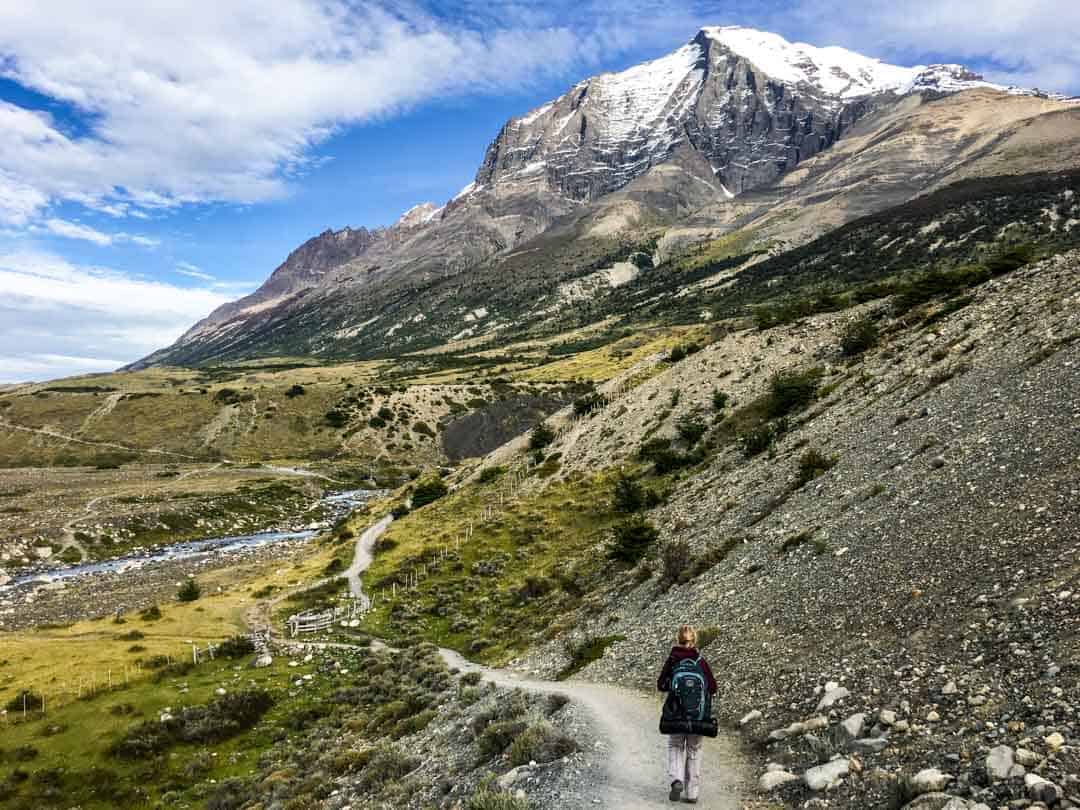
Hiking the W Trek Snapshot Location: Torres del Paine National Park, Chile Nearest town: Puerto Natales, Chile Getting to and from the park: Torres del Paine is easily accessible by bus from Puerto Natales. Park entry: Park entry tickets and overnight stays in the park (campsites and lodges) must be arranged before visiting the park. Start and finish: The W Trek traverses a roughly w-shaped route through Torres del Paine National Park between Refugio Las Torres in the east and Refugio Paine Grande in the west. For this itinerary, we start in the east and hike west. Distance: appx. 74 kilometres (46 miles) one-way Time: This itinerary is 5 days and 4 nights Difficulty: Moderately difficult, with some challenging stretches and steep climbs, plus highly changeable weather. We’re occasional hikers but with some preparation and a reasonable level of fitness, we found the W Trek very do-able (even if all our muscles were screaming for days afterwards!).
What’s in this post?
Preparing for hiking the W Trek Patagonia What time of year is best for hiking the W? Where to stay before and after the trek Entry to Torres del Paine National Park Booking Camping and Accommodation on the W Trail Bus tickets to and from Torres del Paine Packing for the W Trek Our Self-guided itinerary for hiking the W Trail Day 1 – Puerto Natales to Chileno via Las Torres Day 2 – Chileno to Francés Day 3 – Francés to Paine Grande via Francés Valley Day 4 – Paine Grande to Grey Day 5 – Grey to Paine Grande (and return to Puerto Natales)
This post contains affiliate links. If you find these links useful and you choose to purchase through these links we may receive a small commission, at no extra cost to you, which helps us to keep this website running. Your support is much appreciated!
Preparing for hiking the W Trek Patagonia
We aim to fully check and refresh this post for each trekking high season (October to April). Things can change without notice though, so we recommend also visiting the links below for information while you’re planning and before you go:
- For the latest updates on requirements for travel to Chile, visit the official Chile tourism website .
- Torres del Paine National Park is managed by the park agency CONAF. Visit the official national park website for park reports, park entry information and more.
- When you check-in at the park for your trek, you’ll receive an information guide with a map showing the park’s trails, services and accommodations. The current brochure can be found here .
What time of year is best for hiking the W?
Patagonian weather will keep you on your toes no matter when you visit Torres del Paine National Park. Be ready for everything. However, there are two distinct periods to be aware of when planning your trip.
High Season – October to April
These are the warmer months in the southern hemisphere, and December to March is the busiest time of year to trek in the park, with visitation peaking over January and February. During this period, you can choose to do a self-guided hike or go with a guide .
If you’re travelling in high season, and particularly if you’re planning to visit during the peak months, be sure to reserve your place in the lodges or campgrounds as far in advance as possible . Torres del Paine is now one of the most popular places to trek in Chile and overnight places book up very quickly.
We hiked the W trail towards the end of March, and while sections were busy, like the path to Las Torres, there were stretches where we wouldn’t see more than a handful of people in hours.
That said, despite making our campsite reservations months prior to our visit, we initially struggled to find availability and had to change our trekking dates to suit what we were able to book.
Low Season – May to September
Many people say winter is even more magical in Torres del Paine.
The park entry fee drops during the low season and you’ll find far fewer people in the park. But temps will also be lower, daylight hours are shorter, rain is frequent and there can be snow and ice. Many of the mountain trails are closed, as are a number of the mountain lodges and services. Trails that are open can also close suddenly due to weather (though that can happen at any time of the year).
Most importantly, to do the W Trek or hike to the base of Las Torres during the low season, you must have a qualified guide . This period typically runs from 1 May to the end of August, but check the official Torres del Paine website for more information if you’re planning to visit over this time.
The bottom line: No matter what time of year you visit Torres del Paine, given the changeability of the weather there, you should check in with park agency CONAF for latest updates and closures.
Where to stay before and after the trek
The nearest major population centre, and the main jump-off point for a Torres del Paine trek is Puerto Natales , a low-key Patagonian town hugging the shores of the picturesque Última Esperanza Sound.
The drawcard of Torres del Paine’s trails has seen Puerto Natales develop a buzzing trekker scene.
We suggest giving yourself a couple of days in Puerto Natales before your trek to get organised, shop, hire any gear you need, and sort out transport to and from Torres del Paine if you haven’t already (see our section on sorting out bus tickets further on).
Just about everyone staying in Puerto Natales is out and about doing the same thing, so having extra time in town means you can stress less if you don’t find what you’re looking for in the first place you visit.
Spending a couple of days here after your trek is also worthwhile – you can rest your weary bones and enjoy this charming little town.
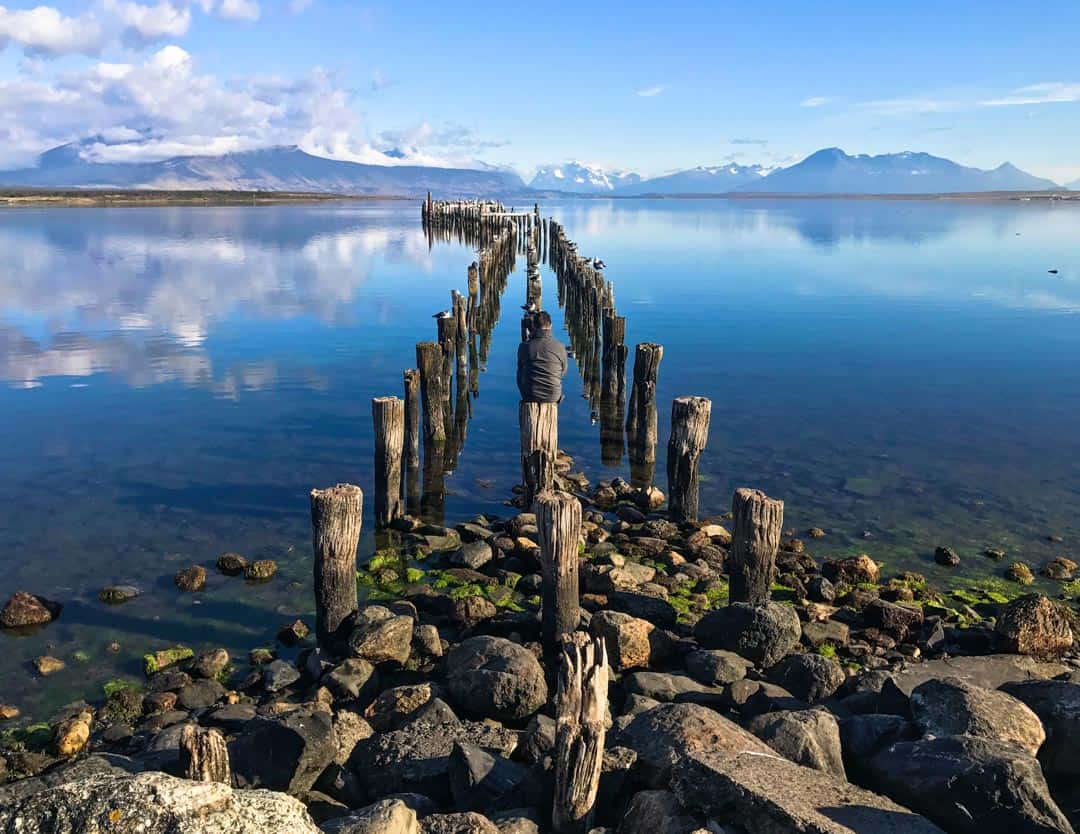
Accommodation in Puerto Natales
Puerto Natales isn’t a big place, but you’ll find everything from budget hostels through to five-star luxury in and around the town.
We stayed at the charming, centrally-located Hotel Aquaterra both before and after our trek. This is a great mid-range option and we really enjoyed our time here. They also stored our luggage for us while we were on the trail.
For more accommodation options like this in Puerto Natales, take a look at Booking.com . Or, if you’re after something more in the budget range, you’ll find various hostel options here .
One place we’ve definitely got our eye on for a future stay is this unique domed apartment . It’s about eight kilometres (five miles) out of town, but with the views this place has, we wouldn’t be moving from the window seats anyway. Perfect for a post-trek, legs-up retreat!
Entry to Torres del Paine National Park
Entry to Torres del Paine National Park is ticketed and there are capacity limits in the mountain lodges and campgrounds. This is for the long-term care and protection of this wild and remote place, and for the safety of visitors to the park. So whether you’re planning to hike the W, trek the O circuit or visit for the day, you will need a ticket to get into the park.
You must now buy your entrance ticket for Torres del Paine National Park at least 24 hours in advance of your visit to the park. You can no longer buy an entry ticket at the park itself. Visit the CONAF website to buy your park entry ticket .
Entry fees vary depending on whether you are Chilean or international, as well as your age, and whether you intend to stay in the park up to, or more than, three days. At last check, international adults 18 and over will pay CLP$31,200 (CLP is Chilean pesos) for up to three days in the park, and CLP$44,500 for more than three days.
Download your ticket to your phone before you head to the park (you won’t have reception there) and carry a printed copy just in case. You should also carry a copy of your passport as you may be asked to show your ID/nationality.
Booking Camping and Accommodation on the W Trail
There are various ways to stay overnight on the W trek in Torres del Paine National Park, but whether you’re planning a lodge stay, hiring camping equipment, or camping with all your own gear, you’ll need advance reservations to do so.
Overnight reservations are mandatory for Torres del Paine and, like park entry tickets, need to be made in advance . You cannot book camping or accommodation once you’re at the park, or camp outside the designated bookable camping zones.
You’ll also need to carry evidence of your overnight reservations as you may be asked to show proof at any time by a park ranger or when passing through checkpoints. We printed our reservation confirmations and carried these with us.
With trekking in Torres del Paine becoming ever more popular, limited accommodation spots and advance booking necessary, sorting out campsites or lodge accommodation is – in our experience – probably the trickiest part of planning a self guided W trek itinerary.
For this reason, we recommend booking your overnight stays as far in advance as possible , preferably as soon as bookings open for the season.
It also pays to be flexible about where you stay, as you may find you need to rework your trekking dates and approach based on what’s available.
Our final W trail hiking itinerary was the direct result of where and when we could get an overnight booking.
How to book your overnight stays in the park
There are a number of mountain lodges (refuges) and campsites in Torres del Paine, and you can only stay overnight in these designated zones.
Broadly speaking, the zones in the east are managed by Las Torres Patagonia (formerly Fantástico Sur) and those in the west are managed by Vertice Travel .
There are also a couple of free campgrounds in the park which are managed by the Chilean park agency CONAF. However, these campgrounds are closed for the 2023-24 season – visit the CONAF website for updates.
You can book direct via the Las Torres Patagonia and Vertice Travel websites, however we know from experience that trying to align availability and book spots for a workable W circuit itinerary across different websites can be complicated and time-consuming. Another reason to plan well ahead.
We’re now aware of a new website called Booking Patagonia , which offers an integrated booking system for travel, tickets and accommodation for Torres del Paine. Tours can also be booked through this site. We haven’t used it yet so we can’t personally vouch for it, but if you do use it, we’d love to know how you go (one of our readers has recently provided some feedback about their experience in the comments at the end of this post).
Bus tickets to and from Torres del Paine National Park
We based ourselves in Puerto Natales, the nearest town to Torres del Paine, before and after our trek and most travellers do the same. From Puerto Natales, it’s an easy bus trip to and from the park.
If you’re travelling by bus, we recommend organising your bus tickets to and from Torres del Paine well in advance . Don’t leave this until the day you head to the park or you may find the buses already full.
If you plan to buy your tickets when you arrive in Puerto Natales, aim to do so as soon as you arrive in town. You can buy bus tickets at the main bus station (Terminal Rodoviario), or through your hotel or hostel. We travelled to Puerto Natales by bus so we bought our tickets to Torres del Paine at the bus station the day we arrived. You can also search bus services and buy tickets online here .
It’s important to note that your bus drop-off/pick-up points at the park may vary depending on your final W trail itinerary, so keep this in mind when booking your bus ticket.
If you follow this itinerary and trek from east to west, you’ll start with the bus from Puerto Natales to Laguna Armaga . After your trek, you will board the bus at Pudeto for the return journey to Puerto Natales (this follows a catamaran ride across Lake Pehoe to Pudeto from Paine Grande). Vice versa if you’re hiking the W from west to east.
To ensure you’re on the trail in good time (and in line with this itinerary), we recommend booking one of the earliest buses out of Puerto Natales on Day 1.
Packing for the W Trek
Any hike, but especially a multi-day hike, can quickly lose its appeal if you’re carrying too much weight in your pack; something we can personally attest to. So we strongly recommend packing light and only carrying the clothes, gear and food you need for the trek.
If you’re travelling longer term and have more stuff with you – which was our situation – leave it in storage at your hotel. Your back will thank you for it.
You can find most of what you need to buy or rent in Puerto Natales for hiking into the surrounding landscapes, from sleeping bags, camping stoves and hiking poles to dried fruit and nuts for your trail mix.
That said, this is a small and relatively remote town and the local prices reflect it. We’re told there’s more choice and better prices at the supermarkets and shops in Punta Arenas, so if you’re coming from or via Punta Arenas, you might consider doing your trek shopping while in that town.
We’ve also read recent reports that it hasn’t been so easy to find dehydrated meals lately in Puerto Natales. If you’re planning your menu around these, you might think about sourcing them elsewhere.
It’s important to know that Chile has stringent rules around what foods you can and can’t bring into the country (fresh foods, fruits, honey, etc are a no-no). Be sure to declare any foodstuffs you do bring in and plan on buying most of what you need for trek meals and snacks once you’re in the country.
We had a tight meal plan for our spin on the W, but with hindsight, we would swap out some of the bulkier food stuffs we packed for lighter, more compact foods. Next visit, we’ll be looking to pack some dehydrated camping meals and light-weight but filling carbs like cous cous and oats.
The night before the trek, organise any food you’re carrying into daily packages of brekkie, lunch and dinner. Pre-bundling your meals saves scrabbling around in your pack for particular items on the trail). Then pack all the gear you’ll be taking with you in waterproof bags inside your backpack.
Cash, pesos or credit card? One question we get asked is whether to carry US dollars or Chilean pesos into the park, and whether the refuges accept credit cards. We carried all three. We paid for some things in pesos, like snacks and the shuttle to the trail head, and other things in USD, like the catamaran from Paine Grande to Pudeto. We also used our credit card at one of the refuges to buy beers. It’s our understanding that all of the refuges accept credit cards.
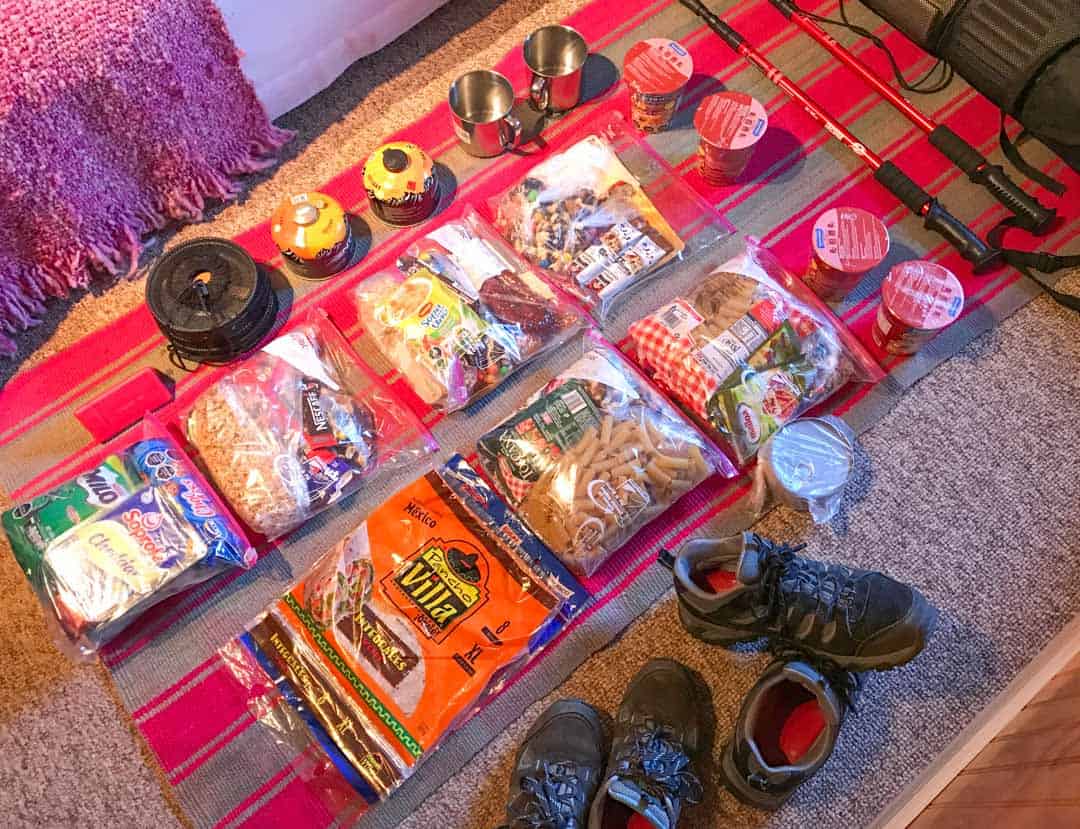
Our self-guided itinerary for hiking the W Trail
Day 1 – puerto natales to chileno via las torres, total distance: appx. 13.8 km (8.5 miles) total time: appx. 8 hours overnight: camping chileno.
Let’s get trekking! Hopefully you’ve secured your seat on one of the earliest buses out of Puerto Natales this morning (see above regarding buying your bus tickets in advance).
Buses making the run to Torres del Paine National Park generally depart from Terminal Rodoviario in town. Find your bus and load your pack, then kick back until it’s time to go. It’s around two hours to Laguna Amarga, the gateway to Torres del Paine National Park, so settle in, this is a perfect excuse to grab some extra sleep before starting the hike.
When you arrive at the Laguna Amarga Ranger Station, have your pre-purchased park entry ticket ready on your mobile phone or bring a printout. Here, you’ll check in and receive information about visiting the park, and its rules and regulations.
Don’t forget to buy your entrance ticket for Torres del Paine in advance, and at least 24 hours before you head to the park . It’s no longer possible to buy entry tickets on arrival at at the park. Head to the CONAF website for more information .
At Laguna Amarga, hikers split into two groups: those starting their journey here at the eastern end of the park, and those heading to the western starting point at Paine Grande, which involves a further bus trip to Pudeto and a catamaran ride across Lake Pehoé (even if you’re hiking west to east, you’ll get off the bus here to check-in before reboarding the bus for Pudeto).
If, like us, you’re hiking the W from east to west , your next step after check-in is to jump aboard the Hotel Las Torres public shuttle bus from Laguna Amarga to the Welcome Centre and the eastern starting point of the trek. This costs around US$5 per person and is paid in cash as you board (we paid this in pesos).
Alternatively, you can start your hike here from Laguna Amarga. The shuttle will just spare you a dusty 7 kilometre walk along the gravel road.
There’s a toilet at Laguna Amarga, and another at the Welcome Centre. This is a good chance to go before setting off into the mountains.
Trekking tip: We booked our first night’s accommodation at Camping Chileno, which is en route to today’s main destination – the towering granite peaks of Las Torres. We’ll be checking in at Chileno on the way and dropping off our packs ahead of the steep and challenging climb to the Las Torres mirador. If, however, you’ve booked your first night at Hotel Las Torres or Central Refuge and Camping, then we’d suggest dropping off your packs there first, and setting out on today’s hike to Las Torres with a lighter load.
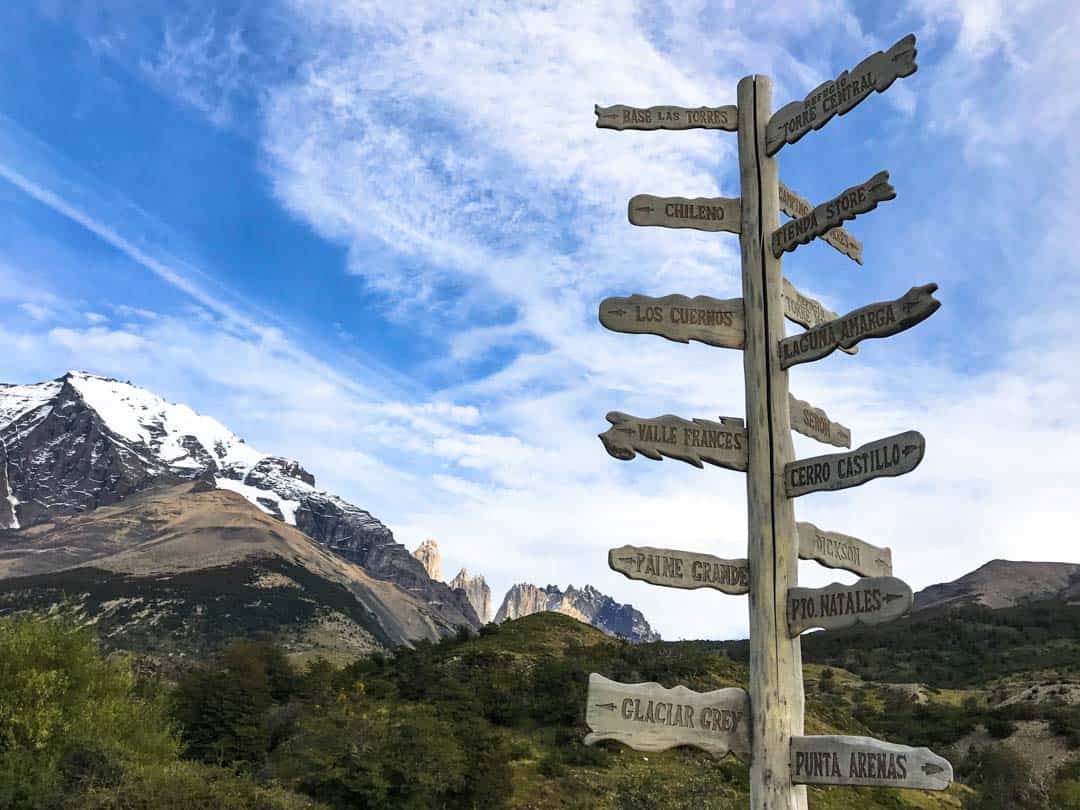
1st Leg: Hotel Las Torres to Chileno ( appx. 5 km / 3.1 miles, around 2 hours)
We’re officially underway on the W trail around 10.30am and from the word go, the views are eye-popping. After a flat kilometre or so, the path starts to climb: get used to it, it’s pretty much uphill from here.
The hike is moderately steep in some spots, until about a kilometre (0.6 miles) or so from Camping Chileno, where the trail flattens out a little before descending into the campground.
Despite feeling like our hearts might explode for much of this first stretch, we cover the distance in around two muscle-busting hours, with frequent stops to take in the views, rehydrate, and give our racing pulses a break.
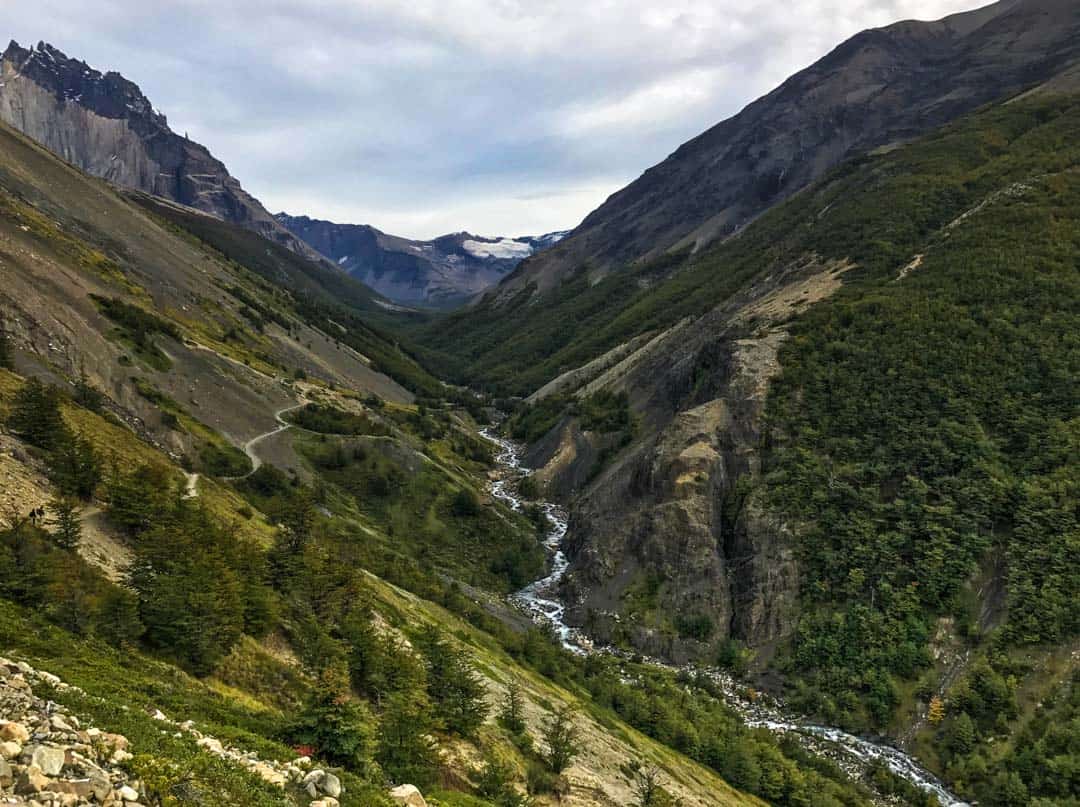
Drinking water There’s no need to lug extra water with you on the Torres del Paine circuit. You’ll pass pristine mountain streams regularly throughout your journey. Bring a water bottle, fill up at nature’s tap and enjoy some of the purest water you’ll ever drink. Just remember to top up well away from the camps and upstream of the trails.
We haul our packs into Chileno around 12.30pm . This campground is operated by Las Torres Patagonia (formerly Fantástico Sur), and is the closest camp you can stay at to the famous Las Torres hike and mirador (the CONAF-managed campground near the base of the Las Torres climb has been closed for some time).
The riverside setting at Chileno is truly stunning and the sheer peaks of the three granite towers – our ultimate goal today – rise tantalisingly above the forested mountains ahead.
The campground itself is a nice set-up of tiered camping platforms among the trees. There are shared bathrooms with hot showers, and a restaurant and bar with big windows, plus an outdoor terrace for soaking up the epic views.
Our tent is ready for us when we arrive at Chileno, so we check in, drop our bags in our tent, grab a smaller pack with snacks, water bottles and cameras, eat the lunch we prepared last night, and set out for Las Torres around 1.30pm . Timings here may vary depending on your check-in.
2nd Leg: Chileno to Las Torres (appx. 4.4 km / 2.7 miles, around 2 hours)
This is without doubt today’s toughest leg, so there’s a huge bonus in not having to tote your full pack up the mountain.
From Chileno, you’ll hike for around 3 kilometres (1.9 miles) or so along a meandering path through pretty woodland, across rushing rivers, and through a wonderfully moody stretch of fallen forest that we dub the ‘tree cemetery’. It’s a lovely, moderate walk, and we have no sense of what’s ahead when we reach the sign that tells us ’45 minutes to Mirador Las Torres’.
My notes from this point in our trek simply state: ‘hiking hell starteth here’. A touch dramatic maybe, but as irregular hikers, this was probably the hardest section of the entire W for us. Maybe you’ll breeze through it, just be ready for it.
Shortly after the sign, the climb to Las Torres begins in earnest. It’s a gritty, rocky terrain of steep, gravelly inclines and large boulders. The panoramas as you climb are absolutely breathtaking, but so is the hike itself. There are moments while we’re in the throes of it, looking up and spotting the tiny trekkers far above, that this stretch feels like it will never end.
It does end though, about an hour later, and the scene that awaits as we round a final boulder and face the towering granite pillars of Las Torres makes every single breath-wrenching step worth it.
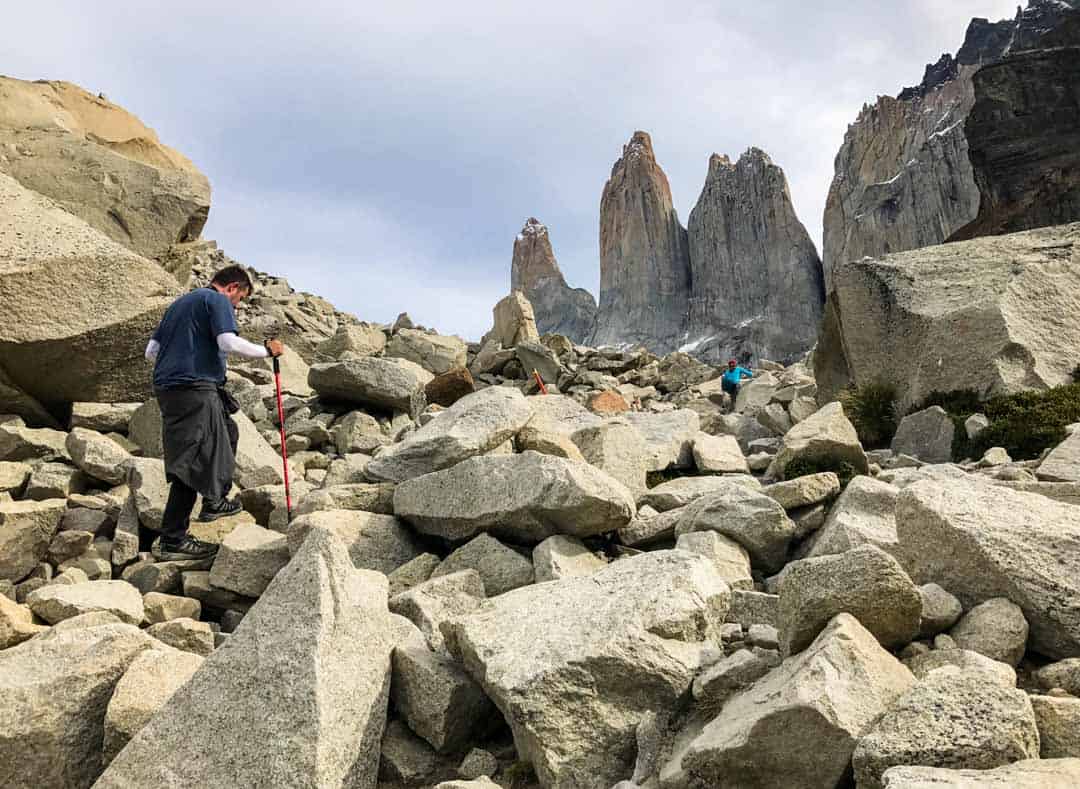
It’s buzzing at the top: hikers drape the rocks surrounding the glacier lake; a bushy-tailed Patagonian fox weaves its way between the boulders; there’s even a guy getting his hair cut at the water’s edge (one hairdresser’s quirky approach to memorialising his travels while promoting his business).
We spend some time taking pics before settling onto a boulder of our own to simply take in this awe-inspiring scene. Aim to spend around an hour at Las Torres .
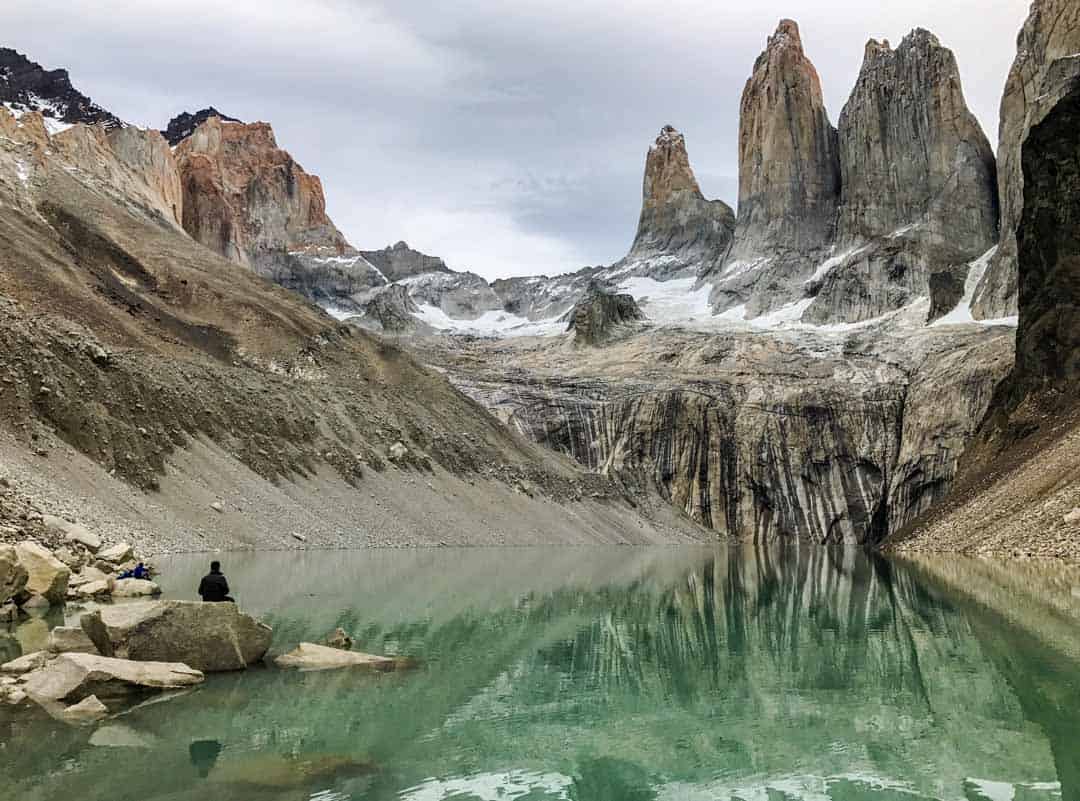
3rd Leg: Las Torres to Chileno (appx. 4.4 km /2.7 miles, around 2 hours)
The journey back down from Las Torres is in some respects even more challenging than the climb up. The constant down is tough on knees and the gravel makes the going slippery. We’re beyond grateful for our hiking poles, though we both still manage to pull off some memorable butt slides.
Trekking tip: Hiking poles made all the difference for us when we were trekking in Patagonia. We carried one each, which was ideal as it left us both with a hand free to grab branches and rocks, haul each other up and down, and catch our fall when we slipped. Which was often.
It takes us around two hours to get back to Chileno; we have time to shower, buy a couple of well-earned beers and watch the sunset burn the tips of Las Torres molten gold.
It was cloudy the entire time we were up at the base of the towers, so watching them all beautifully backlit now is a bit of a kicker, but if there’s one thing you’ll learn quickly hiking the W Patagonia, it’s that the weather doesn’t give a rats what you think.
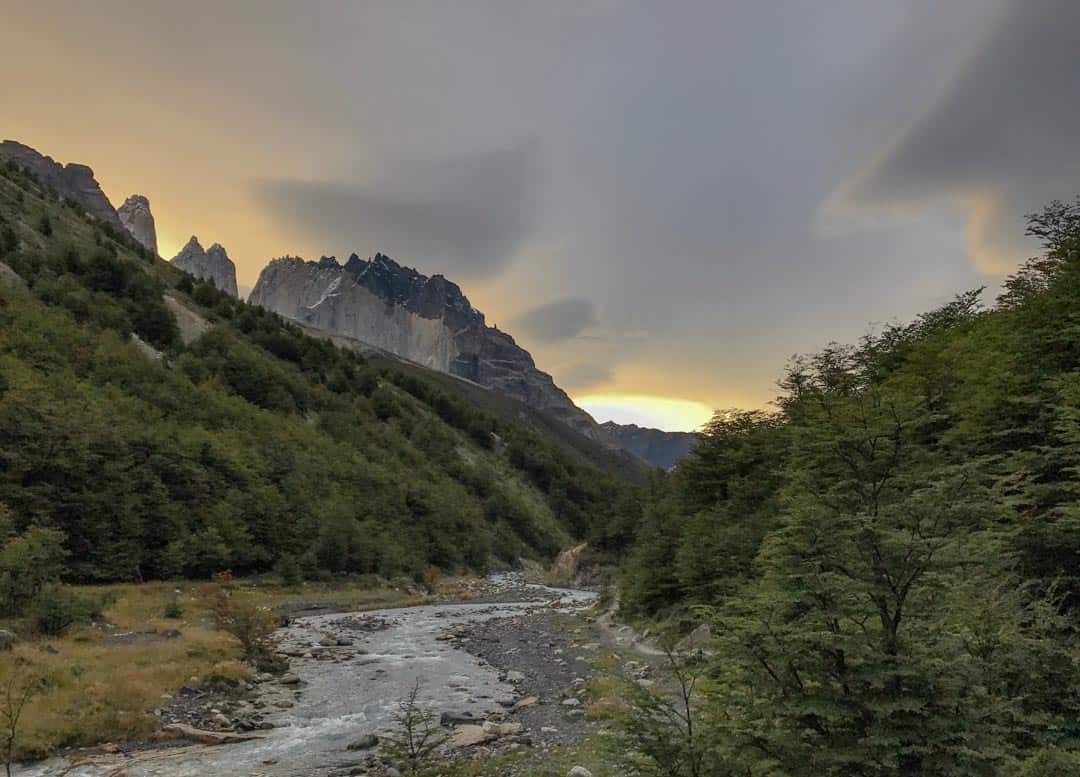
Preparing for Patagonian weather If there’s one constant about the weather in Patagonia, it’s that there’s nothing constant about it. We were particularly lucky on our five days in Torres del Paine, but you should be ready for four seasons in a day. Layer up, have a rain jacket handy, and wear quick-dry clothes. Skip a rain cover for your bag though. While we never experienced the legendary winds that tear through the park from time to time, we heard plenty of stories of pack covers being whipped off suddenly and disappearing into the wilds. Expect to get rained on, and pack your gear in bag liners or waterproof bags inside your backpack instead.
Cooking stoves are not allowed to be used in the Chileno zone, so we opted for the full board food package here, which includes dinner tonight, breakfast tomorrow and a packed lunch to take with us.
Later in the evening, we join a host of other hikers in the restaurant for a surprisingly tasty and filling three-course meal full of protein and carbs.
We’re absolutely wrecked by the end of dinner, and we’re tucked up in our sleeping bags by 9.30pm.
Sunrise at Las Torres When we originally planned our itinerary for hiking the W, we had every intention of doing a second trek to Las Torres for sunrise on Day 2. In late March, this would have entailed getting back on the track up the mountain by 5.30am . As we climbed into our sleeping bags that first night though, we decided to pull the pin: we were just too tired, and we were also a little wary of making the tricky climb in the poor dawn light.* It was a tough call at the time, and it didn’t help when we poked our heads out of our tent the next morning to see the torres erupting with golden light above the silhouetted foreground. As we watched though, the clouds rolled in and soon enough the peaks were shrouded in mist. There’s no accounting for Patagonian weather, or how your body may feel after a long day of hiking. The best you can do is plan, and be flexible on the day. *PS. For safety reasons, hiking in the dark isn’t actually allowed in Torres del Paine. Trail sections have opening and closing times, check the park brochure for more info.
Day 2 – Chileno to Francés
Total distance: appx. 18 km / 11.2 miles total time: appx. 6 hours 45 minutes overnight: camping francés.
Sunrise is around 8am when we do the W trek in late March, and as we haven’t made the dawn hike to Las Torres, we enjoy a more leisurely start to the morning on Day 2.
If you do decide to do the dawn hike up to Las Torres for sunrise, factor in around five hours this morning and adjust the following timings for today’s next legs accordingly.
As breakfast is part of our full board package at Camping Chileno, we pack up our gear and head to the dining room at 8.30am for a hearty kickstart to the day.
1st Leg: Chileno to Los Cuernos (appx. 15 km / 9.3 miles, around 4.5 hours)
We’re on the trail by 9.15am , heading back towards Hotel Las Torres. We won’t be going all the way to the hotel though as there’s a shortcut off to the right around half-an-hour after leaving Chileno. The shortcut is signposted and takes you along a mostly downward sloping path surrounded by undulating hills and lake views.
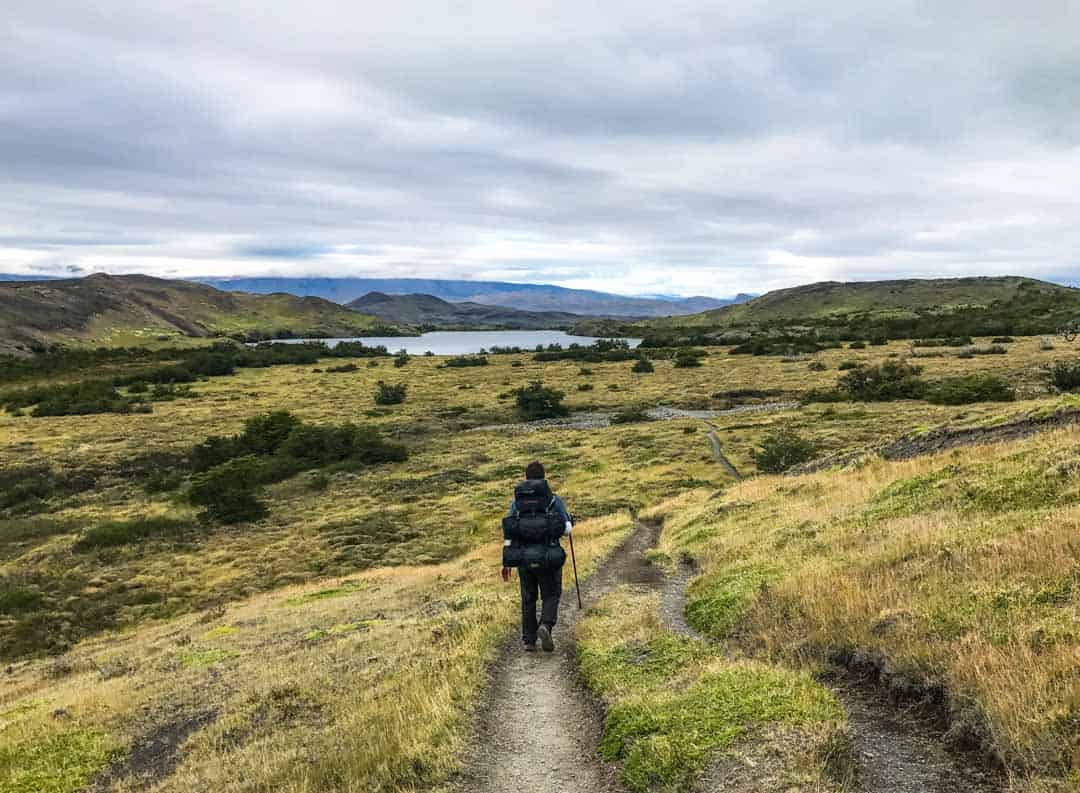
We reach the end of the shortcut and rejoin the main W route around 11am . At some point after this though, we suddenly find ourselves in what can only be described as the Patagonian Swamps of Mordor and we start to wonder whether we’ve veered off on to a secondary trail by mistake.
We can still glimpse the Nordernskjöld Lake off to left, and we know the official trail travels alongside it. To this day, we’re unsure if we did actually go off piste (though the number of bootprints in the mud suggests not).
Eventually, we seem to be back on track according to the map, just a little muddier for the experience (and even more grateful for our depth guage hiking poles).
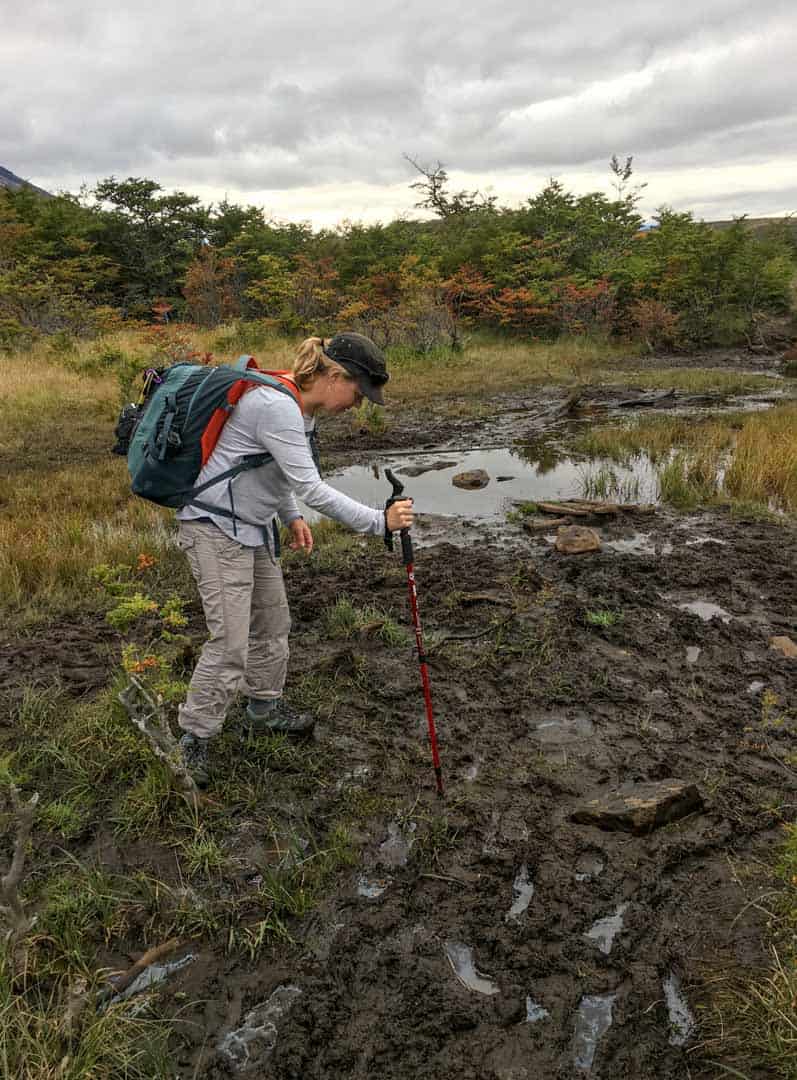
The next stretch travels up and down through very pretty lakeside country, with the occasional steep section, before passing down into the valley at Los Cuernos. We arrive at the Los Cuernos shelter and camping area around 1.45pm .
You could stop at any point along the stretch to Los Cuernos for a lunch break; we stop just past the shelter and find a nice rock with a view. We opted for the full board meal package with Camping Chileno so we’ve been provided with a packed lunch today as part of this.
We chill for around 45 minutes and then set off around 2.30pm for Camping Francés , where we’ll be staying tonight.
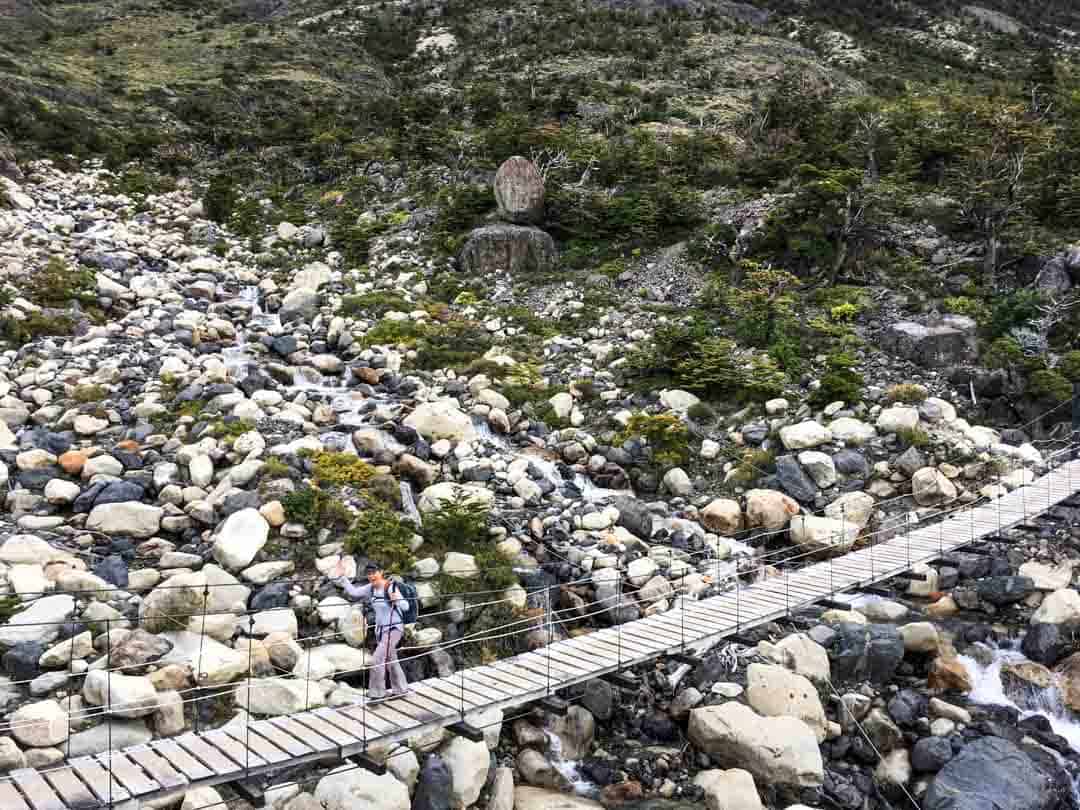
2nd Leg: Los Cuernos to Francés (appx. 3 km / 1.9 miles, around 1.5 hours)
The trail to the Francés campground is up and down and rubbly, with some steep sections, and a pretty pebbly beach crossing. Today’s walk has been positively sedate compared to yesterday’s heart-starter climbs, but never fear, a leg-burning rise awaits just before the descent into the camp.
We arrive at Camping Francés around 4.00pm . The campground here is run by Las Torres Patagonia (formerly Fantástico Sur).
The tent platforms are clustered between the trees and there’s a good shower and toilet block a short walk from the campsite. There’s also a small shop with basic amenities.
By 5.15pm we’re checked in and set up on our platform. We’ve arranged for a tent at Camping Frances but we’re cooking our own food tonight.
Sunset is close to 8pm in late March, and having made it through our second day on the W trail, we’re zipped up in our sleeping bags soon after.
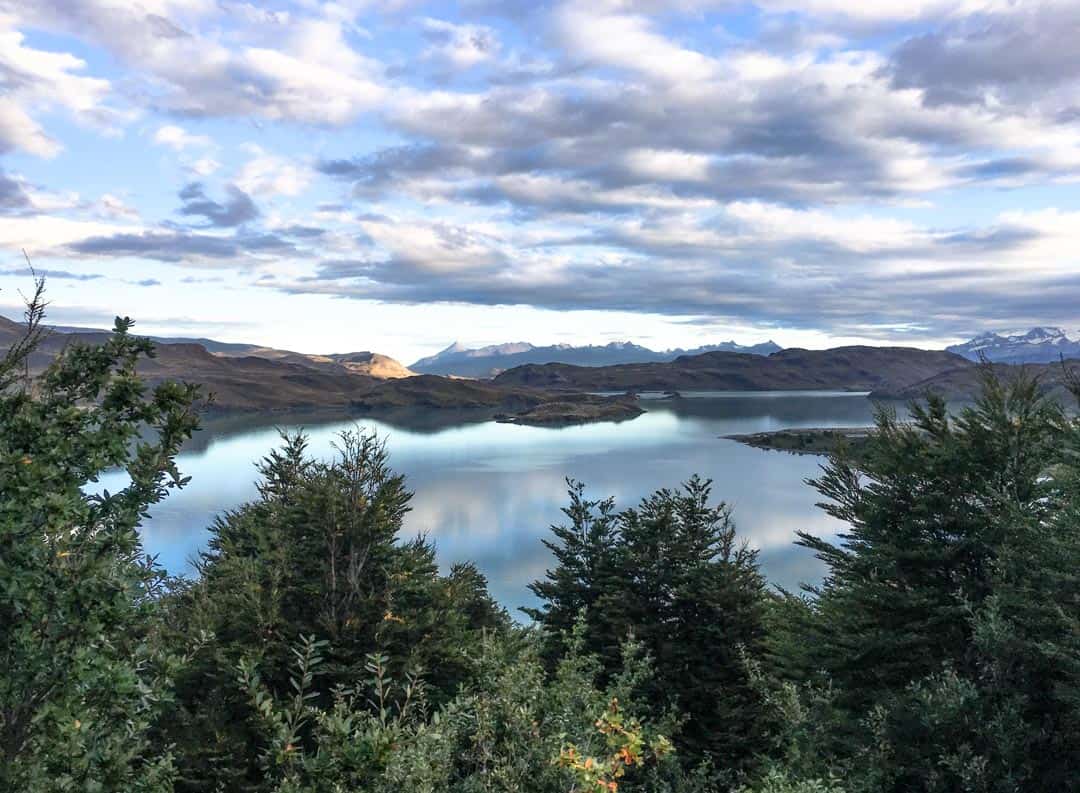
Day 3: Francés to Paine Grande via Francés Valley
Total distance: appx. 20.3 km / 12.6 miles t otal time: appx. 9 hours overnight: camping paine grande.
Despite our fatigue, neither of us sleeps particularly well on our second night and we’re both groggy when the alarm goes off at 7am.
Our restlessness is partly due to the strange soundtrack that has accompanied us throughout the night: sharp cracking sounds like distant shot gun blasts and deep, thunderous rumbles. It’s not until we set out on the trail through the Francés Valley today though, that the source of the unnerving noises becomes obvious.
On this itinerary, today is the longest day hiking the W, and based on our experience, we recommend getting on the trail by 8am at the latest to maximise your time in the Frances Valley. We departed later when we trekked, so we’ve adjusted the timings below to suit an earlier start.
1st Leg: Francés to Italiano Ranger Station (appx. 2 km / 1.2 miles, around 30 minutes)
The first leg this morning is a rejuvenating, 30-minute leg-stretcher to Italiano Ranger Station. Aim to pack up and set out from camp by 8am.
There’s a ranger at the Italiano Ranger Station when we arrive. He points to some racks opposite the office building; this is where we opt to leave our backpacks ahead of the challenging hike into Francés Valley.
We sort our valuables and lunch into a smaller daypack, lock up the big packs, and get going again. Look to be back on the trail by 8.45am .
2nd Leg: Italiano Ranger Station to Británico Lookout (appx. 5.4 km / 3.4 miles, around 3 hours)
The first kilometre (0.6 miles) out of Italiano is a flat trail through pleasant forest, after which the track starts to climb steeply through a rocky, rubbly stretch.
The scenery is seriously beautiful, serving up views of the ironically named Paine Grande Hill – 3,050 metres above sea level – and the Francés glacier that clings to it. This is the source of the crackshots and grumbles we’ve been hearing as the hanging ice shifts, melts and avalanches down the mountain.
Soon enough, you’ll reach the Francés mirador, a lookout offering spectacular panoramas over the ‘hill’ and its glacier; this is the perfect spot for a short break and a snack, as the next stretch is tough.
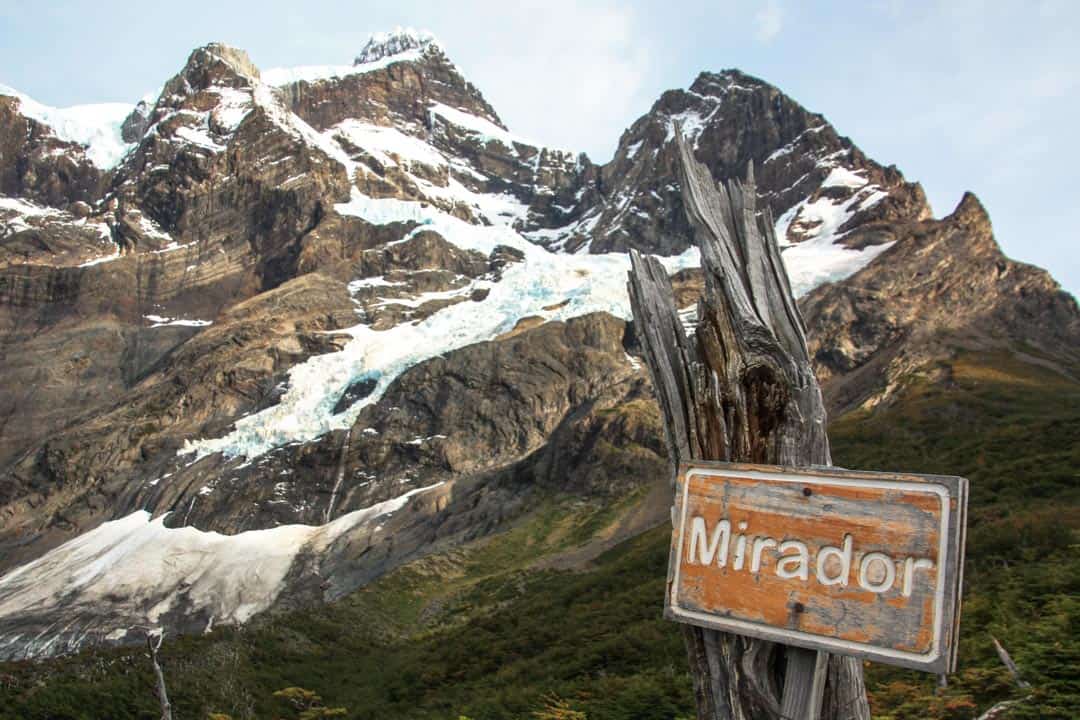
From here, the trail to Británico Lookout is a challenging, rubble-strewn boulder dash with lots of climbing.
A flat, rocky clearance scattered with the parched white trunks of dead trees and overshadowed by the jaw-dropping Cuernos massif, marks the final stretch before a steep, 10-minute climb to the mirador itself.
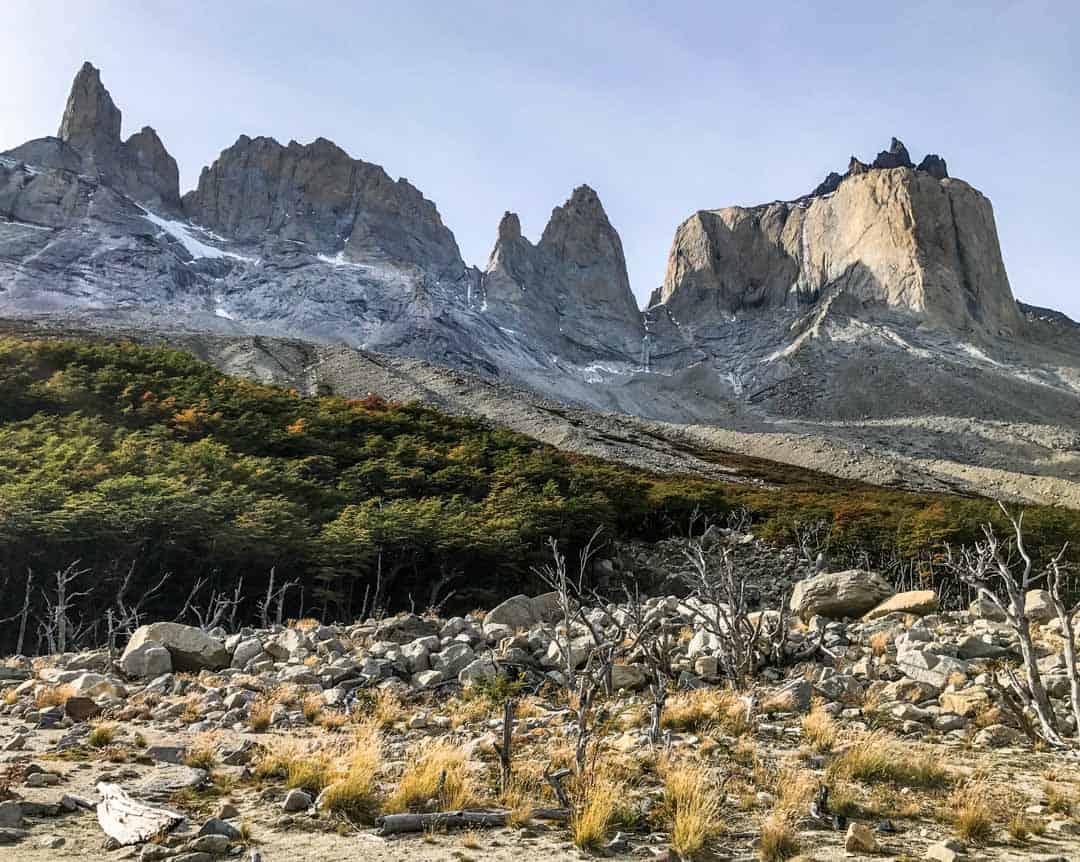
Summitting the boulders of the Británico Lookout around three hours after setting out , we cast our eyes over what will become our favourite panorama of this epic journey: the vast and spectacular Francés Valley. Find a rock to perch on and settle in for lunch with this glorious scene at your feet.
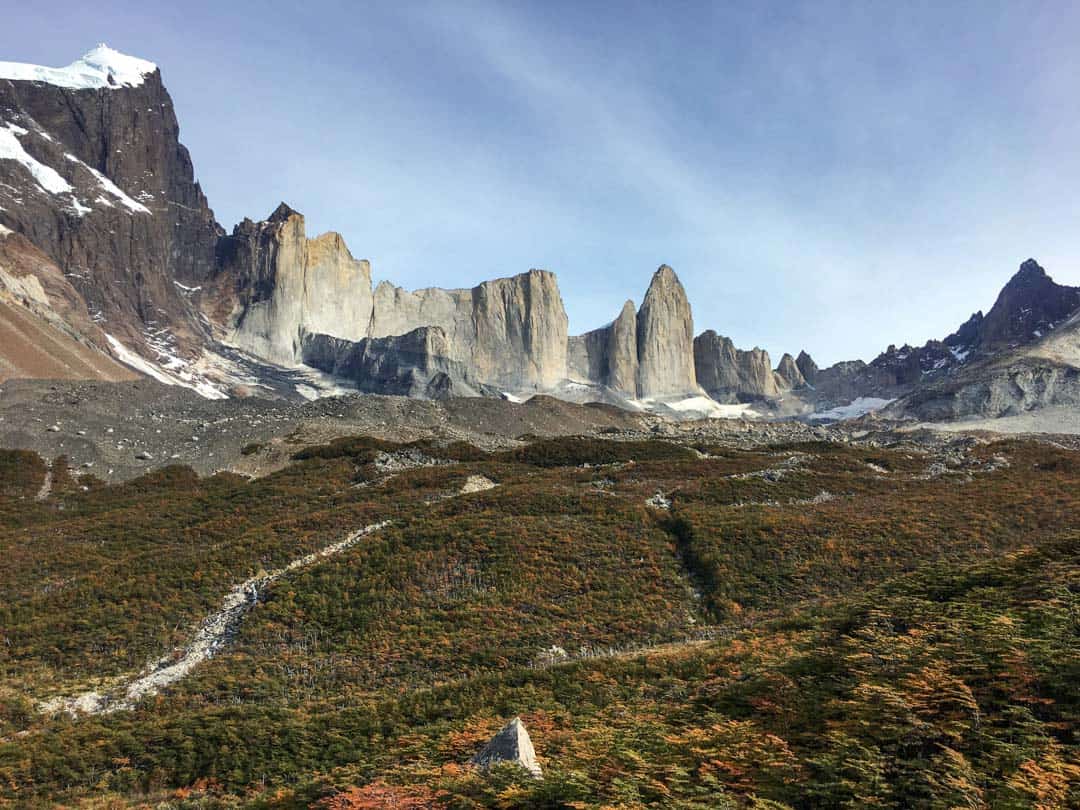
We’ve come a long way, but there’s still a huge day of hiking the W ahead. To our eternal regret, we were only able to linger here for half an hour as we left camp too late on this morning. That’s why we recommend getting on the trail no later than 8am today – trust us, you’ll want as much time at Britanico as possible and by arriving around 11.45am, you’ll have close to an hour here.
We’ve promised ourselves that next time, we’ll spend an extra day or two in this valley so we can take in this view at our leisure. For us, this remains one of the most magnificent vistas we’ve come across in all our world travels.
Trekking tip: Get on the trail by 8am at latest this morning so you can hang out for at least an hour at Britanico, or better yet, stay an extra day in the Francés Valley.
3rd Leg: Británico Lookout to Italiano Ranger Station (appx. 5.4 km / 3.4 miles, around 2 hours)
Aim to set off back down the trail to Italiano around 12.45pm . We find this a knee-buckling downward journey and our legs are screaming by the time we reach our packs back at the Italiano Ranger Station just over two hours later.
Once we’ve retrieved our packs (now four-deep in a giant bag pile), re-sorted them, and stopped for a quick breather, we set out for the Paine Grande refuge and camping area, starting with a bridge crossing out of Italiano. It’s around 3pm by this stage .
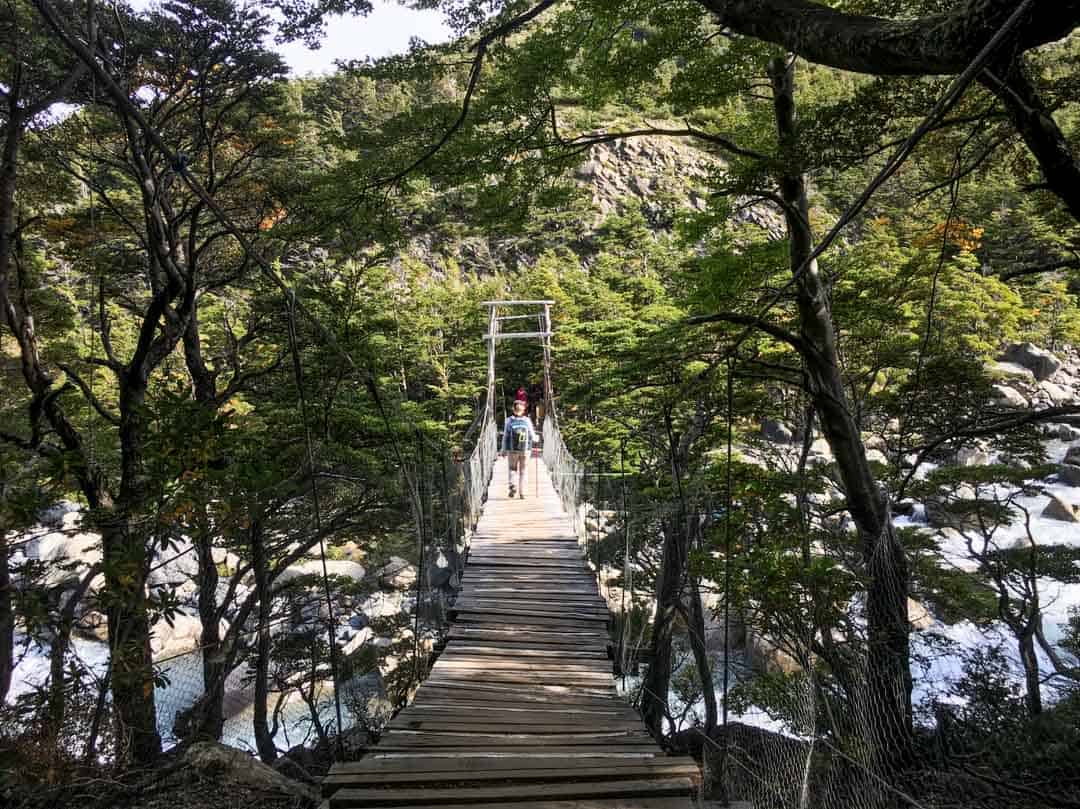
4th Leg: Italiano Ranger Station to Paine Grande (appx. 7.5 km / 4.6 miles, around 2.5 hours)
The final stretch of the W trail today is a journey of around 7.5 kilometres (4.6 miles) and it’s mostly flat with some sloping ups and downs.
Travelling out of the valley and along the raised walkway as you head towards Sköttsberg Lake, remember to turn around and take in the mountain scene back the other way: it is immense.
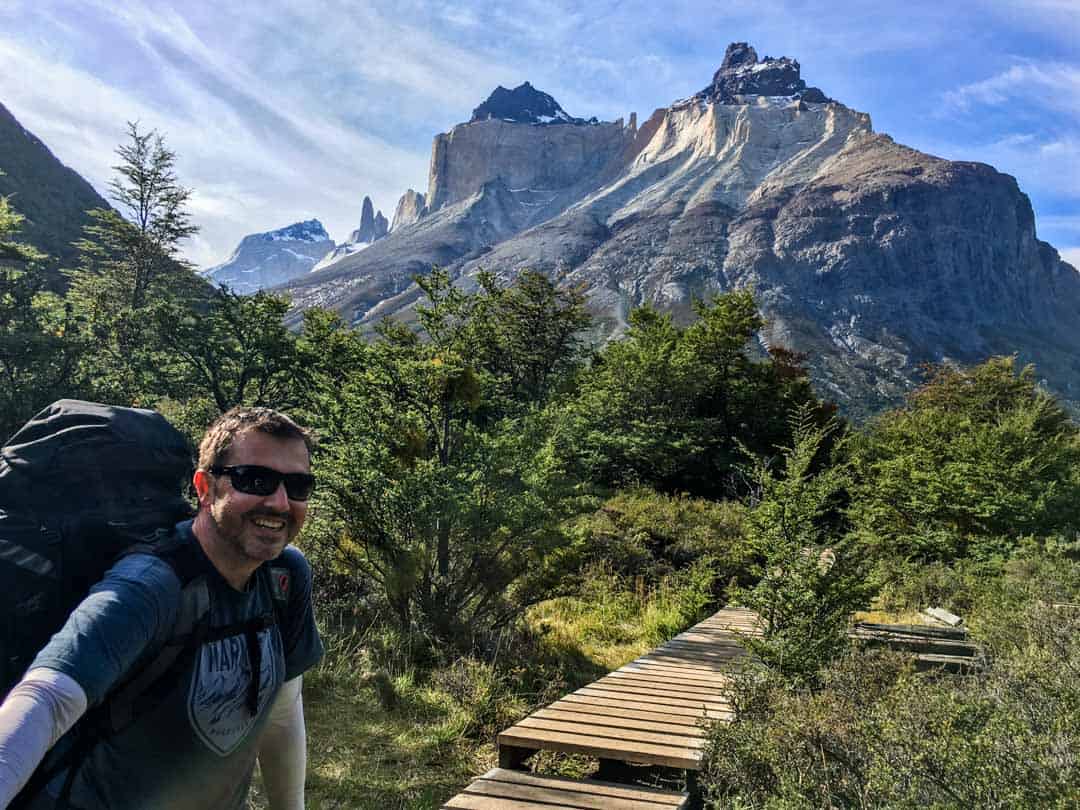
After some more steady rises, we make our final descent into Paine Grande Refuge and Camping around 5.30pm . By this stage, we’re seriously sore and tired and very ready for a beer from the lodge bar, which is the first thing we do once we’ve checked in and dropped our packs at our tent.
The campground at Paine Grande, which is managed by Vertice Travel, is large and separated into sections for campers carrying their own gear, and those like us who have booked a tent. A wooden walkway links the campgrounds with the lodge, the campers’ kitchen and bathrooms.
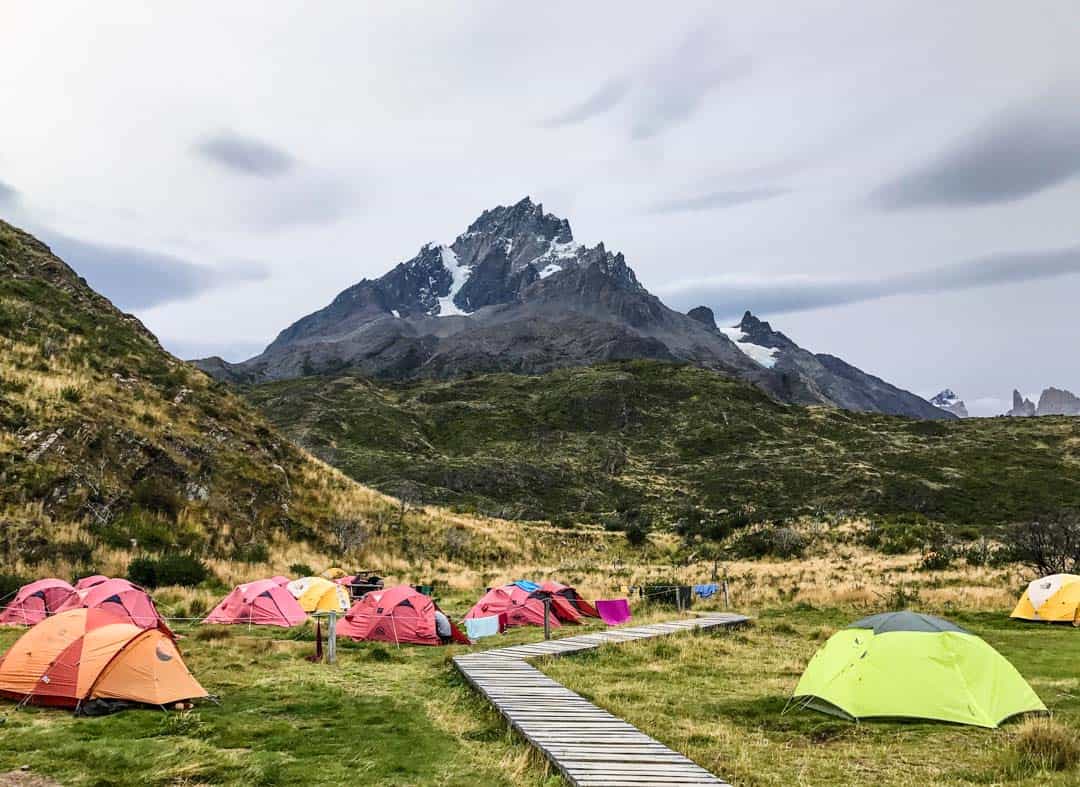
As Paine Grande is the western starting point for hiking the W and a transit point for O circuit trekkers, as well as for day trippers and short stay visitors, this is the largest and busiest lodge and campground in the park.
There’s a good-sized kitchen building, which is heaving with trekkers when we make our way in there to cook dinner around 7pm.
The camp shower and toilet facilities here are basic. We recommend getting your ablutions out of the way while everyone else is cooking dinner and before the post-meal rush. Paine Grande also has dorms, a restaurant and bar, and a mini-market.
We’re tucked up in our tent just as a light rain begins to fall around 8.30pm.
Day 4 – Paine Grande to Grey
Total distance: appx. 11 km / 6.8 miles total time: appx. 3 hours 45 minutes overnight: camping grey.
Today is our shortest day so far on the W trail, so we decide to set out a little later as we’re definitely starting to feel the past three days’ hiking, and a strange kind of exhilarated fatigue.
We’re up at 8am with plans to be on the trail by 9am. However the banshee-like screeches of a fox followed by the thrilling appearance of a large, tawny-coloured puma on the hill behind the camp has us – and everyone else – lingering for a while in hushed awe, until the sleek big cat disappears around a bend into the next valley. Which happens to be the same valley we’re about to trek into.
After checking in at the ranger station for advice on what to do if we see the puma again, we set off through the narrow, pretty dell at around 10am . We’re both relieved (and maybe a touch disappointed) to find no further sign of our feline friend.
The big cats of Patagonia Don’t let the thought of pumas roaming the forests of Torres del Paine put you off trekking there. The fact is, these magnificent creatures are extremely shy and actively avoid humans. Seeing a puma is incredibly rare. Spotting one near camp as we did is apparently almost unheard of. However, it’s important to be across what to do and how to act if you do encounter a puma; you’ll find advice on this in the guide that you receive when you register for your Torres del Paine trek.
The valley walk is flat at first but soon begins to climb, and continues to serve up steady inclines followed by some steep descents into the Grey refuge and camping area.
The scenery on this leg is still epic, but maybe a touch more serene than the high drama mountainscapes of the last couple of days. Grey Lake is flat and still on the day we hike the trail, and dotted with blueish lumps of ice from the vast Grey Glacier at its head.
About halfway along the trail, a rocky lookout reveals the first glimpses of this immense glacier, a sea of ice six kilometres (3.7 miles) wide and 30 metres (98 feet) high in places.
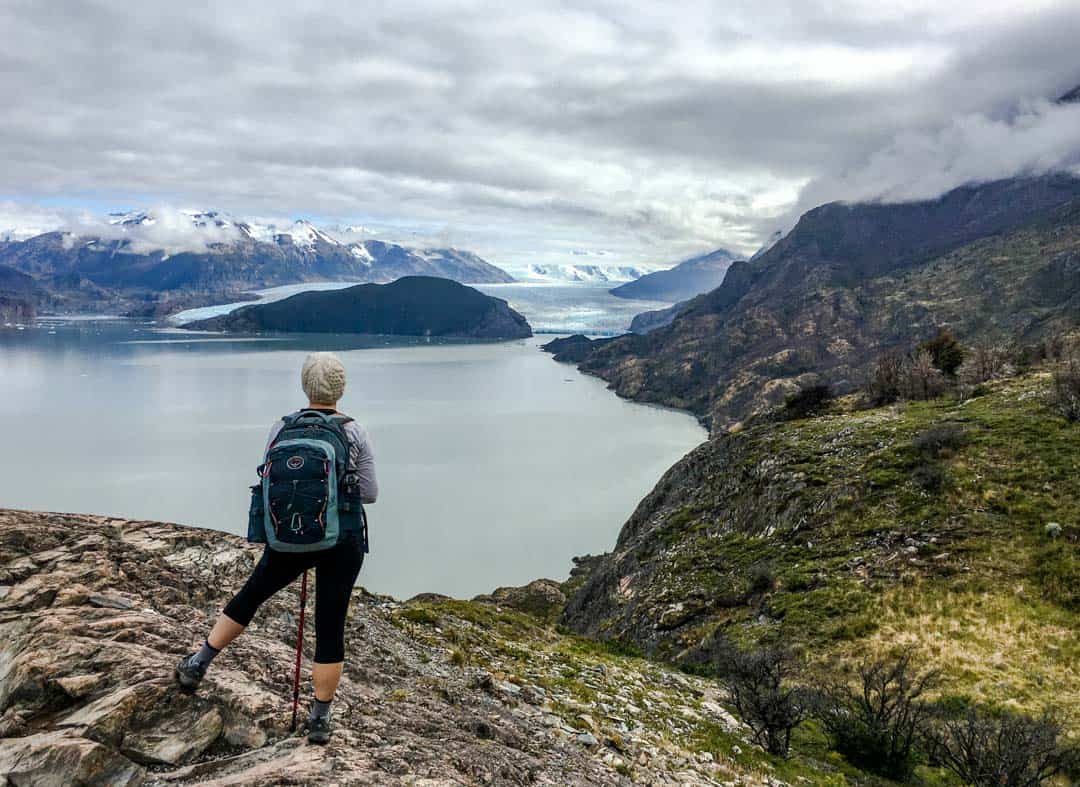
We arrive at the Grey Camping area around 1.45pm , a journey of 3 hours and 45 minutes, with plenty of photo and snack stops along the way.
Grey Refuge and Camping is also operated by Vertice Travel. The lodge has a lovely bar and lounge area in addition to its dorms, and the campground out front is overlooked by the stunning peaks of the Cordon Olguín. By the time we arrive, the clouds have cleared and the mountains burn golden as the sun drops.
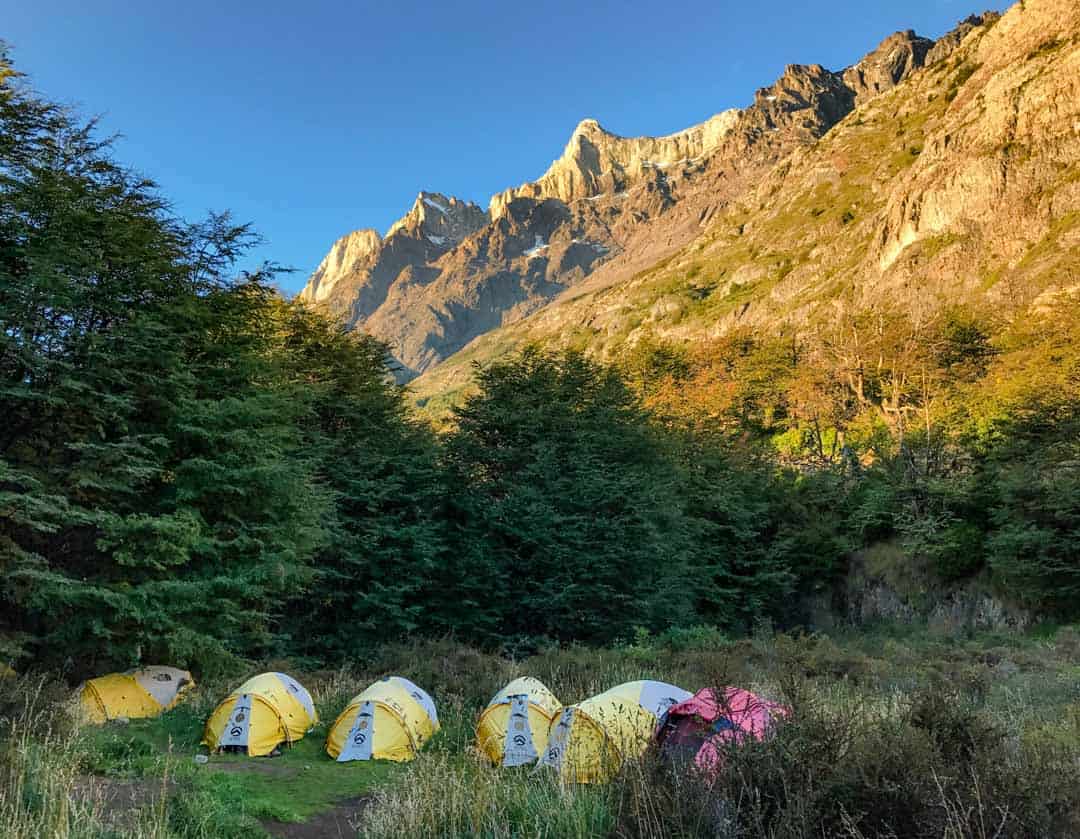
If you’ve got the energy, check in (or leave your pack with the office if check-in hasn’t opened yet), and then head back out to hike past the western tip of the W trail and on to the first leg of the O circuit towards Paso Ranger Station. This will bring you much closer to the glacier, but bear in mind, it’s a five hour, one-way hike to Paso itself.
Trekking tip: Leaving Paine Grande at 10am worked well for us, but if you do want to hike a stretch of the trail from Grey towards Paso and back to Grey today, consider starting out from Paine Grande earlier in the morning so you have more time to do this.
We opt to stop and enjoy our lunch with mountain views, then roll out our mats and nap in the sun until check-in opens.
After getting our tent sorted, we hike to a rocky outcrop on the lake just 15 minutes from camp. The views from here towards the glacier’s terminus are gorgeous and we spend time here just soaking up the scene.
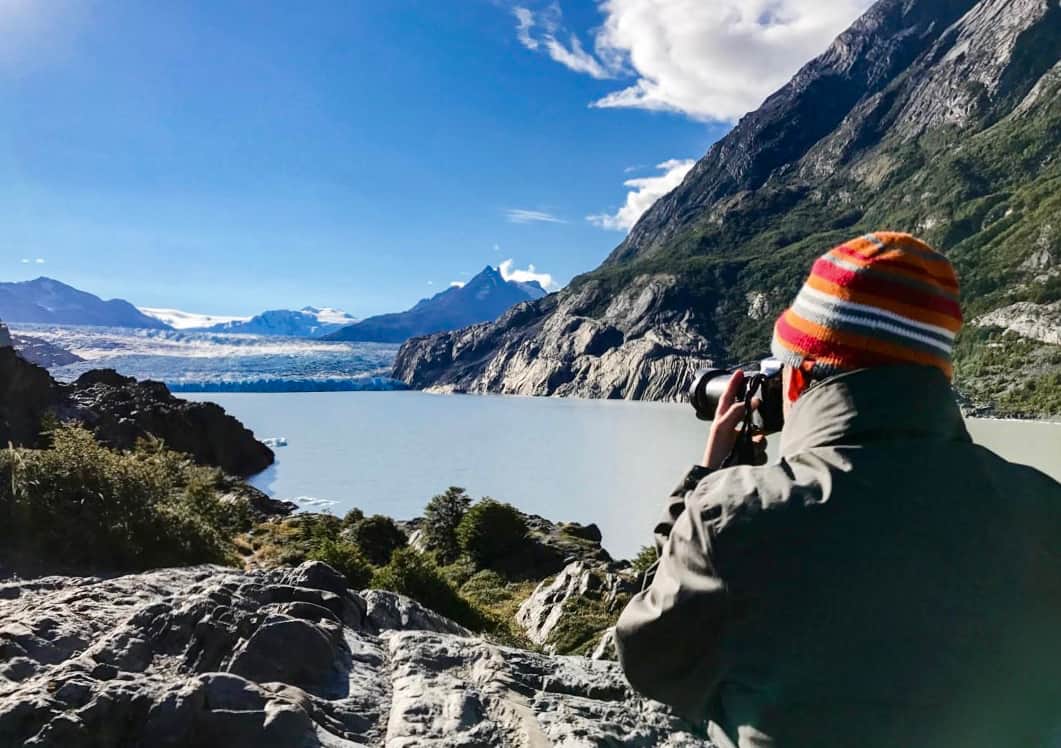
On our return to camp, we head to the lodge for a drink at the bar before making dinner on one of the picnic benches outside the buzzing campers’ cooking area.
In addition to the bar, there’s a restaurant at Grey, and a small shop selling grocery basics. There’s an equally small toilet and shower block for campers (the showers only have certain hours of operation but the water is hot).
We’re in bed by 9pm and prepped for a very early departure in the morning.
Day 5 – Grey to Paine Grande (and return to Puerto Natales)
Total distance: appx. 11 km / 6.8 miles total time: 3 hours 15 minutes.
It’s our last day on the W hike! We’re on the trail early so we can get back to Paine Grande in time for the late morning catamaran across Lake Pehoe to Pudeto, where we’ll pick up the bus back to Puerto Natales.
It shouldn’t take more than four hours to get back to Paine Grande from the Grey campground, but we’re feeling pretty exhausted by this stage and John has nurtured some nasty blisters, so we’re up and on the trail before sunrise .
It’s freezing when we set out at dawn but as the day lightens, we’re treated to a stunning peach-tinted sky reflecting off the lake, and we stop often to snap pics.
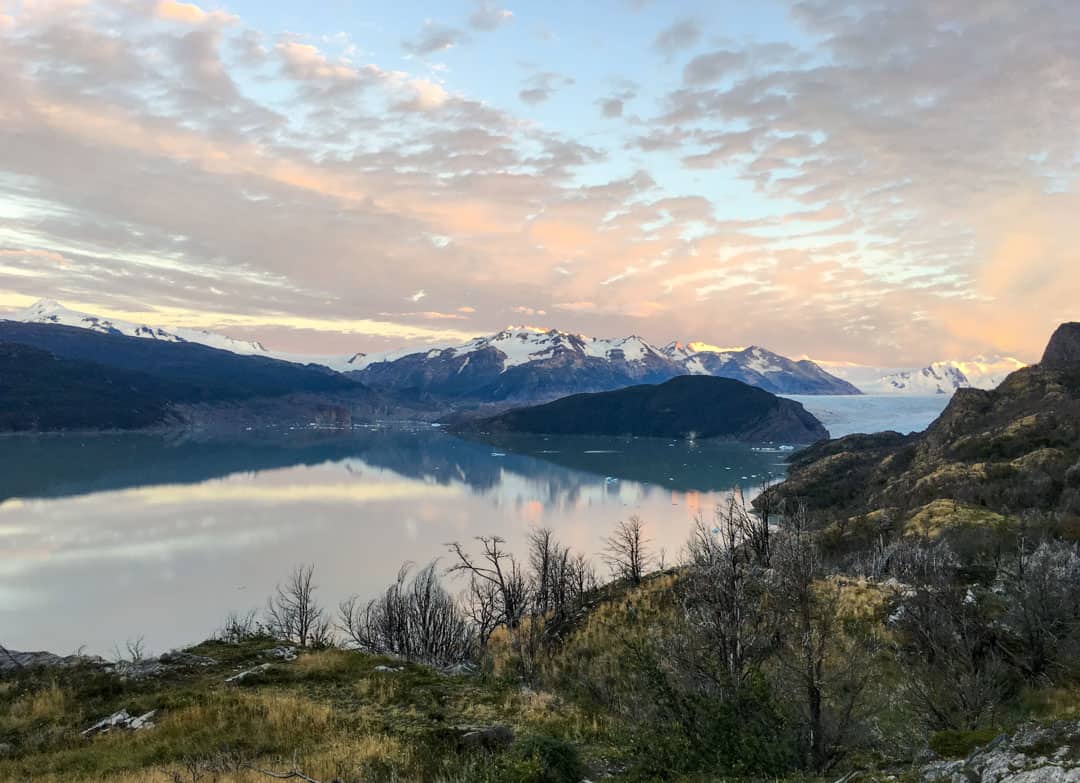
Despite John’s sore feet, we make good time on the return journey and while we’re climbing for much of the first half, it feels easier than the trek up from Paine Grande yesterday. Maybe it’s because we’re on the home run, even though the thought makes us sad.
Our journey back to Paine Grande takes us 3 hours and 15 minutes , 30 minutes less than yesterday’s hike in the opposite direction.
We haven’t eaten breakfast and we’re starving by the time we arrive. We were planning to grab something to eat at the restaurant at Paine Grande, but we discover it’s closed between breakfast and lunch.
We make do with our leftover trail mix instead, which is a bigger deal than you might think: we packed way too much of the bitty hiker’s snack and after five days we have a serious love/hate relationship with it.
Fortunately, there’s now a mini market at Paine Grande, which is apparently open from 7am. But if you’re setting out really early like us, perhaps have something you can eat on the go for this final morning.
Tickets and times for the ferry between Paine Grande and Pudeto Ferry departure times from Paine Grande and Pudeto change throughout the year so be sure to check the schedule when you’re planning your w trek itinerary, and adjust your final day hiking start time to ensure you arrive back at Paine Grande at least 30 minutes before the ferry departs. You don’t need to reserve a place on the boat, just hop aboard and buy your ticket with cash (at last check, it’s US$30 for internationals). The journey to Pudeto takes around 30 minutes.
We board the late morning catamaran for our return to the eastern side of the park. The boat trip across Lake Pehoé offers spectacular views of the entire mountainscape we’ve spent the last five days traversing. It’s an epic perspective of the W panorama and a mesmerising finale to our W trek itinerary.
If the weather is nice, we totally recommend taking a seat outside on the catamaran so you can properly admire the breathtaking scenery.
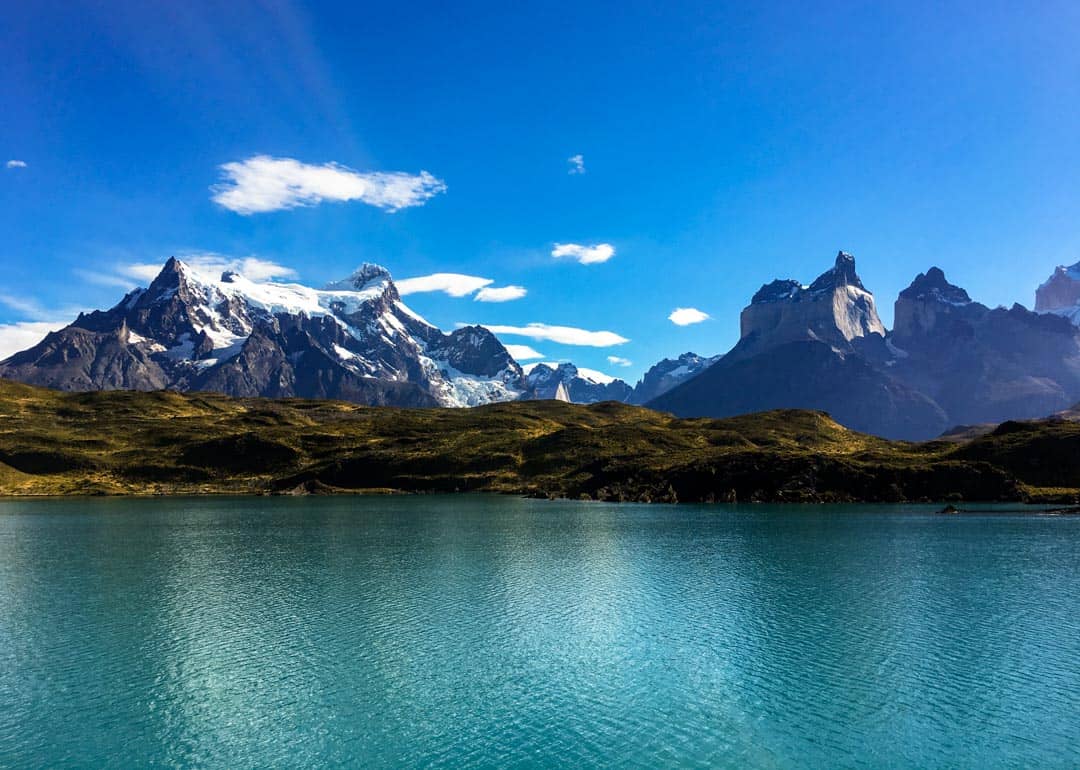
Disembarking the ferry at Pudeto, we grab a coffee from the lakeside café (open from October throughout the trekking season), take a seat in the sun, and enjoy our last moments in Torres del Paine while we wait for our bus.
Pudeto ferry and bus connections In addition to checking ferry times for the catamaran between Paine Grande and Pudeto when you’re organising your trek, it’s also worth checking the bus connections to and from Pudeto, so you can work out the best approach for your final day on the trail.
From Pudeto, the bus makes its way back to the Laguna Amarga Ranger Station to collect hikers finishing their trek at the eastern end of the park. From there, we settle in for the return two hour bus journey to Puerto Natales .
Tonight, back in Puerto Natales, after a good hot shower and a lamentation on the ridiculous amount of trail mix we’ve got left over, we head out for a celebratory drink.
Our legs might be seizing, our knees protesting and we’re beyond exhausted, but we’re buzzing with the sheer thrill of having completed this epic trek. We’re already talking about when we might come back and hike the W trail again, or better yet, take on the longer O circuit.
However we do it, trekking in Torres del Paine is one nature experience we’re keeping firmly on our bucket list.
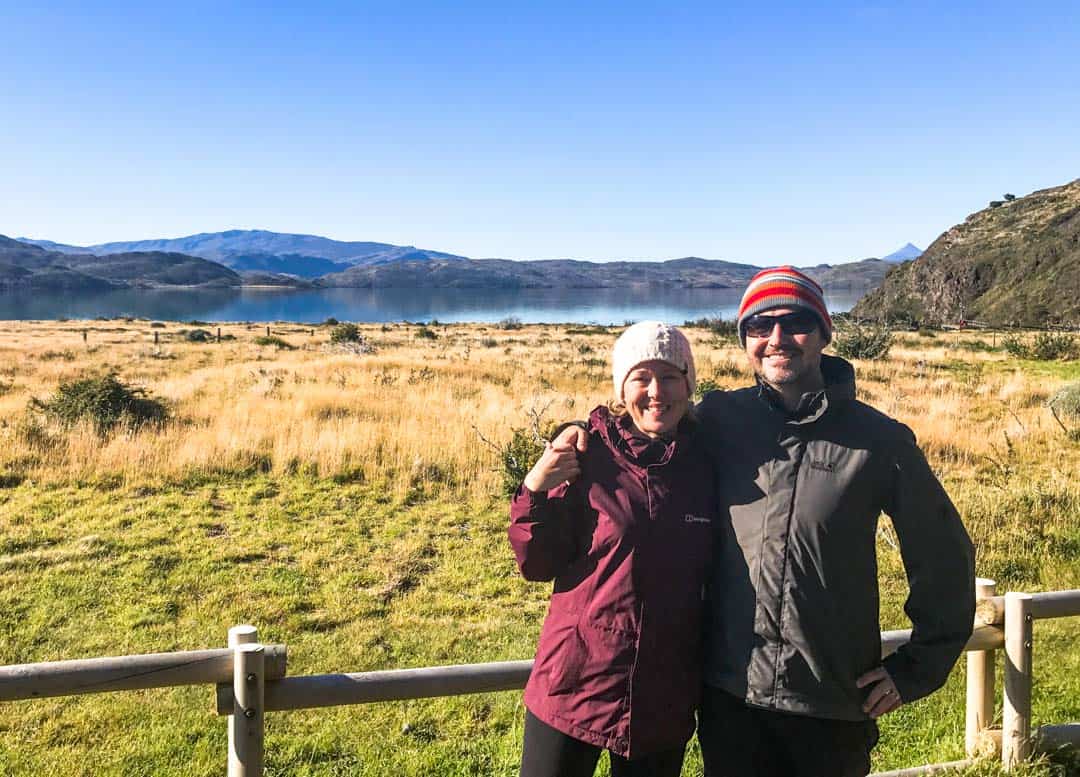
Got any questions? Have you trekked in Torres del Paine recently? We’d love to hear from you, drop us a message below.
For more exciting experiences and things to do in this incomparable part of the world, head to our Chile page or our South America section.
49 thoughts on “Hiking The W Trek In Patagonia: A Self-Guided Itinerary [2024]”
Great website! We’re hoping to do this February/March 2025, and are wondering how best to spend our time on either side of this hike. Did you travel to El Calafate and El Chalten while you were in the area? Or do you recommend other areas down there? Any advice greatly appreciated!
Hi Lisa, thanks for your message! Fantastic to hear you’re planning a trip to Patagonia! Besides the W Trek, there are various activities you can do in and around Puerto Natales and Torres del Paine, like boat trips on Grey Lake to Grey Glacier or horseback riding.
We most definitely did travel to El Calafate and El Chalten after our trek and absolutely recommend, especially if you’re keen to get out on some further hikes. We bussed from Puerto Natales to El Calafate and the next day did a day trip to the Perito Moreno Glacier, which is an absolute must. From El Calafate, we travelled by bus to El Chalten (the panoramas on the bus ride in are wow – try and get the front seats!) and spent a good couple of days exploring this gorgeous area and just hanging out. There are a range of hikes you can do out of El Chalten – the day hikes to Laguna de Los Tres and Cerro Torre are epic.
If you head south from Puerto Natales to Punta Arenas, you can do day trips to see King penguins, Magellan penguins, whales and dolphins, so that’s another option.
Have a wonderful time and happy trip planning! Cheers, Danielle
Thank you for sharing your Patagonia insights! I found it very thorough and incredibly helpful. I we are planning our trip for October 2024. I have a question. How did you book your meal plan? Thanks! Kim
Hi Kim, thanks for your feedback, we’re glad you’ve found our post helpful! When you go through the booking process for each accommodation (including camping) along the trail, you’ll have the opportunity to add meals as part of those bookings. Links to the accommodation providers are in the post. Good luck with your planning and happy trekking in October! Cheers, Danielle & John
Hi thank you so much for this detailed blog. It appears that one would have to stay at Frances camp if going east to west in order to shave hiking time on day 3. Is there a bus company through which we have to pre-book a bus ticket from Pudeto ferry to Las Amargo? Or is it a shuttle service? Do you have any idea if booking a guided tour via Las Torres means that they carry your heavy rucksacks?? Is the last day at Grey really worth it ? Or would you rather end the trek on day 4? Thank you!
Hi SK, thanks for your message. Until the CONAF Italiano camp reopens, Frances camp is the closest camp to the Frances Valley so yes, it is the best bet timing-wise for getting in and out of the Frances Valley and on to Paine Grande on Day 3 if travelling from east to west. You could also stay at Los Cuernos, but that would add around 1.5 hours to Day 3.
The buses running from Puerto Natales to Torres del Paine drop off and pick-up from Laguna Amarga and Pudeto. When you buy your bus ticket to Torres del Paine, you’ll note where you’ll be getting off and on again (it will depend on your itinerary, but for us, travelling from east to west, we got off at Laguna Amarga and boarded at Pudeto on our return. Check out the section in our post on bus tickets to and from the park for more info. There’s a shuttle that runs between the Laguna Amarga ranger station and Hotel Las Torres for a fee.
We would suggest contacting the tour company you’re interested in for advice about whether porter services are available on their guided tours. We left most of our luggage in one of our backpacks at our hotel in Puerto Natales and carried only what we needed for the trek to keep the weight down.
We personally feel that every leg of the W is absolutely worth it – the scenery is superb throughout. Five days gave us just the right amount of time to enjoy the whole trail without pushing too hard. To do the trek in four days, you’d likely need to compromise on either the full hike into Frances Valley or the Grey leg in order to reach camps before dark, and we wouldn’t want to skip either. But that’s us. If four days was all we had to trek, we would possibly leave Grey but we’d have to make sure we did a boat tour out to the glacier instead! 🙂
All the best with your planning! Cheers, Danielle & John
This is seriously one of the best breakdowns I’ve read. Patagonia is one of three “Someday” treks I have on my list to head off on once my son is a little bigger and can carry more of his own gear. We’re building up now with longer and longer trips around Central/Eastern Europe
Love this site!
Thanks for your message Brian, we really appreciate your feedback. So cool that you and your son are already hiking together, and what an awesome bucket list adventure to look forward to with him! Happy trekking and thanks again! Danielle & John
Do you have a map with the accommodations you booked or where you rented out tents/gears? Planning on doing this solo in June!
Hi Erika, thanks for your message! There’s a trail map available at the official Torres del Paine website: https://parquetorresdelpaine.cl/mapa-2023-2024/ – it shows all the accommodations/campsites along the trail. You can also find links in our post to the accommodation providers we booked our campsites and camping gear through.
As you’re considering a June trip, we’d also encourage you to check out the official Torres del Paine website for information about winter hiking regulations – https://parquetorresdelpaine.cl/permisos-especiales/ . Many of the accommodations and trails close over winter and while you can visit the park, we understand it’s mandatory to have a guide for the W Trek and the trek to the base of Las Torres between 1 May and 30 August (though the timeframes can change depending on weather). All the best with your planning! ~ Danielle
Hello Dan, What a great find this was. Thank you so much for writing it. I’m looking to mimic your trek with some modifications. I will very likely have a car rental when I arrive into Punta Arenas. My plan is to drive myself and 2 others into the park and leave the vehicle parked at the welcome center or hotel (unsure if this is allowed). At the end you mention that you ferry to Pudeto- then catch a bus that swings by Laguna Amarga into Puerto Natales. Is there a bus that goes directly back to the welcome center or hotel from Pudeto so we can get back in my rental? It looks like the Laguna Amarga ranger station is about 8.5 km from the welcome center. Or is it best to just shuttle from Puerto Natales for the whole thing and leave the rental somewhere in town?
Hi Bruce, thanks so much for your message and feedback! Very good question re. parking – based on our limited research into this, our understanding is that you can leave your car at Hotel Las Torres while you trek if you’re a guest there, otherwise, cars can be parked at the nearby Welcome Centre. We’ve also seen reference online to a small car parking area at Pudeto, so in theory you could arrange bus tickets from Pudeto to Laguna Amarga, and from there get the hotel shuttle to Hotel Las Torres/the Welcome Centre. I would suggest posting your question on Tripadvisor and hopefully someone has done something similar recently and can provide latest info. It might also be worth contacting Hotel Las Torres and asking their advice; no doubt they get questions like this frequently. All the very best for your trip planning and the trek itself – it’s an unforgettable experience! Cheers, Danielle & John
Thank you so much for the great information. I’m a long term planner and we’re looking to book for our family of four, Christmas 2024. I found this blog really really helpful in hiking cost effectively. Thanks Again!
Hi Melissa, thank you so much for your message, we’re really happy you’ve found our post helpful in your planning. Also very excited for you and your family – what a fantastic Christmas experience! We hope you have a really wonderful time hiking the W, it’s just such an incredible place! All the best and happy hiking! Danielle & John
Thanks for the article, I find it very useful. I have just booked the circuit trail for this April. About that: I looked into using Booking Patagonia for the reservations, and it works really well. Though, there is a downside: they charge an extra $90. You’ll notice this at the very and of the booking process, which I found quite frustrating. For me that was a reason to book directly at Vertice and Las Torres Patagonia, which works fine.
Hi Valentijn, thanks so much for this update, that’s really helpful to know! Thanks also for your feedback on our post, we’re pleased you’ve found it useful. All the best for your upcoming trip in April, have a sensational time and happy hiking! Cheers, Danielle & John
Thanks for the great write up. The details are useful and your descriptions are inspiring. I’m leaving for Chile in a couple days and your post just added to my excitement.
Hey Mike, thanks so much for your feedback, we hope you have a really fantastic trip. Chile is an incredible country, one of our faves!
Cheers, Danielle & John
Thank you for that informativ Blog! I have a question: are there any possibilities to heat up some water in the Refugiés without a stove?
All the best Sophie
Hi Sophie, thanks for your message!
As we had a cooking stove (and booked meals at Chileno where stoves can’t be used), we can’t personally say for sure whether hot water is currently available at all of the stops on the route. That said, we did find a trekker’s report online from late 2023 noting that they were able to access hot water (not boiling) through the coffee/tea dispensers at each of the refugios they stayed at, which they used for their dehydrated meals. Would suggest seeing if there are other trip reports from this season, or posting on a forum for latest updates. Or perhaps hire a stove in Puerto Natales and buy a gas canister just to be on the safe side! We’d love to know what you find out!
Have a magic time trekking the W!
Cheers, Dan & John
Hi guys. Thanks for all the detailed info. Just wondering if you could give an estimate of how much it cost for the W trek. I am being quoted $1180 per person for 4 nights and five days starting 12th February with this included:
• camping accommodation with all the equipment • all the meals • transportation from/to natales-park • park entrance • catamaran • welcome kit
Not sure if this price is really high or if it would work out as that much if I book everything myself separately anyway.
Many thanks
Thanks for your message and feedback – we’re really excited for your trek in Torres del Paine.
We were travelling long-term when we did the W Trek so we went out of our way to keep costs down by booking the campsites directly, carrying some of our own camping gear and bringing most of our own food. Travelling as a pair also helped as the single supplements can add quite a bit. We’d also note that, like everything, prices have hiked post-Covid.
We’ve included some costings in our post but not many as we’re conscious things can change quickly (plus there are so many potential cost combos for accommodation/food, it’s tricky to provide a general estimate). As the bulk of your costs will be in the camping, gear and food components, you might consider checking out the latest price lists for camping and food package options on the Vertice and Las Torres Patagonia websites; that would give you a sense of costs in the context of your quote. Given how quickly accomm/campsites book up for the season and the challenge of trying to coordinate an itinerary across multiple websites, having a third party making the arrangements, while costing more, would take the hassle out of that.
All the best with your planning and we hope you have a sensational time trekking!
Cheers Danielle & John
Your hikes sounded amazing. We are going in Feb and I wasn’t sure what to expect. Sounds like I should do some training! Do you recommend stiff hiking boots to navigate the big rocks or are light hikers enough support?
Thanks for sharing, Karen. Canada
Hi Karen, many thanks for your feedback! To be honest, if you’re a regular walker/hiker, you may find the W Trek a breeze – we met plenty of people who barely cracked a sweat, lol. As irregular hikers, we found some of the steeper sections a little more ‘breath-taking’ but still very do-able. We both wore regular lightweight hiking shoes and they were fine (apart from John developing blisters towards the end), but we also saw people in solid boots. I guess it depends on your preference. We did find having a hiking pole each was useful on some of the more uneven terrain like the rocky climb to Las Torres. We’d love to hear about your trek when you get back – have a fantastic time! Danielle
Going in February, cant wait. Did you know how anyone who did the kayak at Grey and talked about there experience?
Hi Efren, that’s so exciting! We don’t personally know anyone who has kayaked at Grey but we wish we’d had time for it – what an amazing experience! The lake is beautiful and the glacier is epic! If you do kayak, we’d love to hear about it! Have a fantastic time, Cheers, Danielle & John
Awesome Post!
I’m looking at doing this the same direction as you guys did around the same time in 2025.
You mentioned availibilty determined your campgrounds; that being said would you change any of your stays if you could in retrospect? Maybe saw some better campgrounds/lodges along the way that you wish you could have booked had there been availibilty?
Hi Chris, thanks for your message and good question! We were on a long travel stint when we did the W Trek so we opted for camping to keep our costs down, plus the campsites we ended up with proved to be very well located for a five-day itinerary. That said, all of the lodges and refuges looked quite nice so if we were to do it again (and we hope to!), we would consider adding some lodge/refuge stays, following the same itinerary. Location-wise, the Cuernos and French refuges would be good alternatives to camping (though these are beds in dorms, which is less appealing to us). We would definitely consider the Cuernos Cabins (2-3 people per cabin), especially if we were planning a longer stay in the French Valley! We’d also consider staying at the lodge at Grey next time as, of all the campgrounds, this was probably our least favourite (plus we were very ready for a bed by that stage!). Overall, the quality of the campgrounds/refuges throughout the park is very good and we were really happy with our camping experience and itinerary. Best of luck with your planning and we’d love to know how you go! Happy travels!
Wonderful description. We are going in Jan 2024! Looking forward to it.
Hi Kishore Joshi, thank you so much for your feedback, we hope you’ve found it helpful! Wishing you a fantastic W Trek, it really is the most incredible place! Happy travels!
Hi! How much cash would we need, knowing that the bus and entrance are paid for and also full board meal plan at the refugios is booked? So for snacks, water or other costs etc? Do they accept USD or should we have it exchanged? Thanks!
PS, did you also really use ‘poop bags’ for your used toilet paper along the way? 😅
Thanks for your message. We carried both USD and Chilean pesos with us just in case, and we were able to use credit cards at the refuges. We paid for the shuttle from Laguna Amarga and the catamaran from Paine Grande in pesos, though we have read that the catamaran operators may take USD in high season. It’s handy to have pesos for smaller purchases like snacks. We carried a refillable bottle and filled up in streams and at the refugios, so we didn’t purchase water.
We have packed degradable doggy bags for carrying out toilet paper on past hikes! 🙂 On the W Trek though, we carried a loo roll and some trusty Ziploc bags, but we mostly just made strategic use of the campground facilities!
Happy trekking!
Hi John and Dan Thanks for such good info. Is it safe doing it self guided ? Thanks
Hey Iris, thanks so much for your message, we hope you found the post helpful. We found going self-guided very easy – the trails are well trodden and during the peak season, there are plenty of other people hiking too (guides are mandatory in winter). Plus all trekkers have to stay in the designated camping and accomm areas so there are others around and you can stay in dorms if you’re not keen on camping. Conditions can vary dramatically though and it is the great outdoors, so having appropriate gear is essential and hiking with friends is good idea though we hear lots of people do it solo. Everyone we met en route were friendly, encouraging and helpful too. We absolutely loved the hiking the W and hope you get to experience it too! Happy travels! Dan & John
This is really helpful thank you so much. Did you have much hiking experience before you took this on? Would you recommend any training prior to going? What size backpack would you recommend taking?
Thank you so much
Hi Jo, thanks for your kind words, we’re glad you found the post useful! We’re casual hikers and while we’d done a bit of hiking before the W, it was certainly one of the ‘biggest’ hikes we’d done. We definitely tried to up our walking/hiking game before the W in preparation and glad we did as we personally found some of the steeper, sustained-climbing parts of the trek relatively tough – we just took our time and had lots of breaks; necessary anyway to take in the gorgeous views! I carried a 30L daypack and John carried a 50L backpack – between us we carried everything we needed for the five day hike, but I would note that we didn’t have to carry tents, sleeping bags or mats as we hired these. We hope you have the chance to hike the W trek, it remains at the very top of our hiking list! Happy travels!
Thank you all for this awesome breakdown and information! We followed it exactly to book our accommodations and plan to do the trek end of March. Thanks again!
Hi Kristen, thanks so much for your feedback! We’re stoked you found our post helpful and we’re very excited for your upcoming trip. Torres del Paine is sooooo spectacular, wishing you a fantastic trek – let us know how you go! ~ Danielle & John
Thanks Dan for the great details and info.
Hi Kristen. I am doing the trek around of march with a friend. We are travelling from Perth, Australia. Would be great to collaborate in planning.
Thanks Bikash
Hello! This page is fantastic, thank you so much. We are looking at November and can be flexible in terms of dates. Did you book your accommodation first? Are there any other considerations i.e. tickets or entry to the park? Or should we just arrange accommodation and go from there? Do you mind sharing how much you paid approximately for your camping accommodation? No worries if not. Thanks 🙂 Amie
Hi Amie, many thanks! We booked our accommodation first and a couple of months in advance. Site availability ended up driving our approach to the trek – so it’s good that you have flexibility! Would definitely get in as early as possible to book. Tickets for the park itself are arranged at the park entry office, but you will need to have the accomm bookings in place (and evidence of them) when you get to that point. So it’s important to book the accommodation and bus tickets to the park in advance. Bus tix you can buy when you get to Puerto Natales, but try and do that as soon as you arrive rather than on the day you intend to travel to the park. Prices for camping and cabins may have changed since we trekked, but if you head to the accomm links in our post, you’ll be able to find out the current prices as it’s all bookable online. Hope that helps and have a fantastic trek! Cheers, Dan & John
Thank you for the detailed information. We are trekking this exact route this March 2020!
Hi Jackie, thanks for your message, we’re really happy you’ve found it helpful for planning. Hope you have a sensational trek!
Thank you so much for the detailed guide! This is really helpful 🙂
Hi Katherine, thanks for getting in touch! We’re really pleased you found the guide useful – happy hiking!
How did you book the campsite ? I unable to locate the source to book just the campsite
Hey Rajesh, thanks for the message.
The Camping areas are run by three different operators in the park, and you can find links to all three operators in our post.
All three operators’ websites have information about their camp sites, and how to book.
Hope this helps.
John & Dan
Exactly what I’m looking for, thanks! Chileno and Los Torres always been there on my bucket list, now I know where and how to start.
Awesome, thanks Rika, we’re really pleased you’ve found it helpful. It is the most spectacular walk – even if you just did the one leg to Las Torres, you’d have photography opps galore! Happy travels!
Leave a comment Cancel reply
Save my name, email, and website in this browser for the next time I comment.

- Privacy Policy
- Puerto Rico
- Travel Tips
Hiking the W Trek in Patagonia Self-Guided: The Complete Details

When you think of Patagonia, it’s hard not to imagine the picture of its most famous pristine peaks. Many avid hikers and outdoor enthusiasts dream of one day visiting Chile and Argentina to explore the Patagonia region. One of the most famous hikes in Patagonia is the W Trek.
This is the smaller version of the O-trek, but even though it’s shorter, it still offers the adventure of a lifetime. These hikes are located in the Torres del Paine National Park in Chile.
My dream finally came true in December 2024 when I visited Patagonia for the first time. There were beautiful landscapes everywhere, and I couldn’t stop staring at them.
In this guide, I’ll go over everything you need to know (and there’s a lot) about hiking the W Trek in Patagonia self-guided.

What is the W Trek in Patagonia and Why You Should Hike it
What makes this hike unique is how well the trails are maintained, the excellent refugios, the people, and, of course, the views.
When traveling throughout Patagonia, it’s funny and cool to notice the same people repeatedly. Most people stick to a very similar itinerary.
There are options for individuals who want to camp and have gear, don’t have gear, or want to go all out and sleep in beds.
Where is the W Trek in Patagonia?
The W Trek is a four- to five-day hike in Torres del Paine National Park. Patagonia is located in Chile and Argentina , offering something different.
Most people who plan to visit Torres del Paine National Park stay in Puerto Natales . This town is easily accessible by bus if you’re coming from Calafate, where the famous Minitrekking on Perito Moreno Glacier is done.
We stopped by here shortly on our way south, where we decided to see Penguins in Punta Arenas before returning for the trek!

How to Get to Torres del Paines National Park
Getting to Torres del Paines National Park is relatively easy. We were one group of the many individuals who got to this park to do the W Trek alone, self-guided.
What does this mean? It means there’s a lot of bus options. I liked using Busbud to find bus times while traveling in Chile and Argentina.
This website didn’t have all the buses possible for every town, but it gave me a good idea of the times.
Bus From Puerto Natales to Torres del Paine National Park
Depending on your path, either East to West or West to East, will determine which bus ticket you need to buy.
No matter what, you’ll stop and get off the bus at Laguna Amarga . This is the Entrance to the park and you’ll have to show your entrance ticket. More on that later.
After finding the bus ticket on Busbud, I always visit the bus company’s website. In this case, it’s Bus Sur .
If you’re starting from West to East like us, you’ll first need a bus ticket from Puerto Natales to Puedeto . When we got to the entrance, we showed our tickets, grabbed our bags, and switched buses.
Our bus driver took a break before taking us another 25 minutes up the road to the Pudeto dock. Keep asking the drivers as everyone seemed confused about what was happening.
If you’re going from East to West, the first ticket you’ll need is one to Laguna Amarga . To find these tickets, go to Bus Sur’s website and type in the destination of Torres del Paine.
In the description will be either Laguna Amarga or Pudeto. You’ll need one of each, but you will determine which you need first and last, depending on where you start.
A side note : YOU MUST PRINT OR SCREENSHOT YOUR TICKETS
Wi-fi is scarce or non-existent inside the park.
Bus Schedule
This might be confusing at first but it’ll all become clear soon. I suggest starting a notes page on your phone with your itinerary and all the needed documents in there.
Below is the bus schedule for Torres del Paine National Park in Patagonia.
Puerto Natales to Laguna Amarga & Pudeto
Current Prices (one-way): ~12,000 Chilean Pesos
Laguna Amarga to Puerto Natales
Pudeto to puerto natales.
I get it if you don’t want to take a bus and would rather drive yourself! I suggest renting a car outside of Puerto Natales as the prices will be more expensive there.
I’m unsure about driving inside the park and to which miradors are possible, but there’s a parking lot behind the Welcome Center. This is next to Refugio Torre Norte.

Things to Know When Planning the W Trek in Patagonia
The W Trek in Patagonia is a long hike and Torres del Paine doesn’t make the information easy to find.
Below will be a plethora of extra details you need to complete the self-guided hike of the W Trek!
Overview: My Itinerary (West to East)
- Take the bus from Puerto Natales to the Park Entrance (Laguna Amarga)
- Switch buses to go to Puedeto
- Take the ferry to Paine Grande ($25,000)
- Hike to Grey (11km) and hike back to Paine Grande (11km)
- Hike from Paine Grande to Mirador Britanico (13km)
- From Mirador Britanico, hike to Cuernos (10km)
- Hike from Cuernos to Chileno
- Wake up early hike from Chileno to Mirador Torres del Paine
- After spending time at the mirador, hike down to Torres Central and the Welcome Center
- Purchase a ticket back to the park entrance ($5,000)
- Take the bus back to Puerto Natales

Things to Bring
Patagonia is known for its huge mood swings of weather, and I wouldn’t change that for the world. It’s what makes this area unique. But it’s a good idea to come prepared.
During the peak season, between December and February, there will be warm, cold, and rainy weather. Here are some things I suggest bringing.
- Hiking Boots
- Grayl Water Filter
- Insect Rep ellent
- Patagonia Down Sweater
Do I have to Purchase a Camping Spot in Torres Del Paine?
Unfortunately, you can’t simply show up in Torres del Paine and expect to camp for free if you have your own gear. I’ve heard many stories of other travelers not doing their research and showing up with no purchased camping spot.
A few companies own these camping spots on the W Trek in Patagonia.
- For tents/camping spots/beds at Paine Grande, you must book a spot through Vertice Travel .
- If you’re looking to stay the night at Cuernos, Torres Central/Norte, or Chileno, you must book through Las Torres .
How Far in Advance to Book?
Hiking in Torres del Paine National Park is one of Chile’s most popular activities. This might seem obvious to some but what isn’t so obvious is how early you must book your reservation.
From experience, my girlfriend and I tried booking in early October for late November. There were spots, but many were limited, and not everything was available in three straight days.
We ended up booking our reservations for the park for the middle of December. I’d suggest booking your reservations for Torres del Paine at least two months in advance, if not further.
You don’t need to purchase the ferry ticket in advance as this can only be bought in person with cash.

Entrance Fee
Unlike when doing hikes like Laguna de los Tres in El Chalten , there is an entrance fee for Torres del Paine National Park.
You can purchase the entrance tickets here . They are currently $12,000 for a 3-day or more pass.
You must download the QR code before getting on the bus, as there will be no signal once you get to the park.
How Many Days Does it Take to Hike the W Trek in Patagonia?
The days it takes to hike the W Trek in Patagonia will depend on your fitness level and if you want to take your time.
We did this trek in 3 nights and 4 days. This is the shortest time I’d ever suggest, even if you’re a fantastic hiker.
My suggestion would be to do 4 nights and 5 days. This will give you ample time to relax at the beautiful refugios and take it all in without feeling rushed.

Camping vs. Refugios
The amazing thing about this trek is that you have multiple options for your sleeping arrangements, depending on your budget.
We rented a tent and slept in the Refugio. On night one, we rented a tent with a mat, and it was honestly more comfortable than I thought it’d be!
For night two, we slept in a dorm room at the Refugio. This wasn’t too bad, but the price was almost triple that of renting a tent the previous night.
We were exhausted and wanted a good night’s sleep. We got that.
For the third night, we slept in another tent but it was large and elevated. I loved these! These were at Chileno Refuge next to Mirador Torres.
The main pros & cons for renting a tent or sleeping in the Refugio are money and if you can’t sleep well in a tent.
I’ll go over the prices of everything next.

How Much Does the W Trek Cost?
Hiking the W Trek in Torres del Paine is expensive. Especially when compared to other places in Patagonia like Bariloche and El Chalten .
But there’s ways to make this experience cheaper like bringing our own food and camping gear.
Overview (per person) : Our Costs
- This price includes mats & sleeping pads for both nights we camped.
- This price is mainly from buying dinner on nights 2 & 3. We packed our food for every breakfast and lunch.
- Tickets (Bus + Ferry + Entrance) : 61,000 Chilean Pesos or $62 USD
- Total Cost Per Person : $537 USD
Food Costs :
- Breakfast = $25
- Lunch/Box Lunch = $25
- Dinner = $40
- Full Board = $80
- Breakfast = $28
- Box Lunch = $30
- Lunch = $50
- Dinner = $50
- Full Board (Breakfast/Box Lunch/Dinner) = $100
- Half Board (Breakfast & Dinner) = $70
- Same price as Cuernos because they are the same company.
Campsite/Refugio
- Campsite (with own equipment) = $13
- Simple Bed = $65
- Bed w/ Bedding = $100
- Premium Campsite w/ Everything = $190 single/$220 double
- Single Bed = $144
- Premium Tent = $200 single/$288 double

Which Direction is the Best for the W Trek?
This is one of the most asked questions about the W Trek in Patagonia. For me, it was quite simple.
I wanted to end this amazing adventure at the best view in the park, Mirador Torres.
Going from East to West might make more sense if you want to explore Lago Grey and do activities such as kayaking and ice trekking.
I personally loved going from West to East, and I’ll tell everyone to do this same route every time.
W Trek Patagonia Map

Credit goes to the Torres del Paine Website . There’s a lot of maps out there if you want something better.
How to Make Campsite/Refugio Bookings in Torres del Paine
I mentioned this earlier, but there are two separate websites you must book your accommodation through before arriving.
If you plan on taking the same route we did and going from West to East, you’ll stay at Paine Grande, Cuernos, and finally, Chileno.
Below are the websites to book each night’s stay.
- Paine Gr a nde
W Trek vs O-Trek in Patagonia
You will hear many people humbly bragging about completing the O-trek, and as they should. It’s definitely difficult, even compared to the W Trek!
The O-trek is much longer and less commercialized in the upper sections. You create a strong bond with everyone who completes it with you.
We did the W Trek because we were short on time and didn’t have our own gear. This meant the trip would be more expensive than we could budget.

Is the W Trek Difficult?
Some might not agree, but the W Trek is difficult. You should only attempt it if you’re in decent hiking shape.
If you’re flying into Santiago first before completing this, there’s a hike called Cerro Manquehue . It’s one of the best views in all of Santiago!
W Trek in Patagonia Hiking Details
- Distance: This hike is a 45.5-mile point-to-point.
- Duration: On average, it will take people 4 days to go up and back down. This depends on your fitness level and which route you take.
- Difficulty: I’d rank this hike as hard because of the amount of time it takes and the elevation gain.
- Incline : The elevation for this hike is around 9,917 feet or 3022 meters.
- Hiking Guide: A guide is not needed for this hike and is easily accessible by the public
Best Places to Stay in Puerto Natales
- Yogan House : This is the hostel we stayed at but it felt more like a really nice B&B. The rooms were amazing and it was by far the best breakfast I’ve ever had in South America.
- Vinnhaus : If you’re looking for a stunning, centrally located hotel, this is it. There’s nothing bad I can say about this place. It honestly should cost more.
- Hostal Boutique Factoria Patagonia : Looking for a cabin like experience in Puerto Natales? Then look no further than this spectacular Boutique hotel!

My Experience Hiking the W Trek in Patagonia
Hiking the W Trek was unlike anything I’ve ever experienced. I met new people and made new friends, all while taking in some of the most beautiful scenery in the world. It was priceless.
The first day was honestly one of the longest, if not the longest. We started by waking up at 6 a.m. and getting a ride to the bus station.
We took the earliest bus because we knew the day would be long. It was quite relaxing, actually, and most of the people on the bus slept.
Things started getting confusing when we arrived at the entrance two hours later. We were told to switch buses but different people kept telling us different buses.
Eventually, we found the right bus, and we were headed another 30 minutes to Pudeto.
We arrived at the dock, bought a cafe late, and waited for the ferry to arrive. You’ll pay the ferry in cash (25,000 CLP).
Once we arrived at Paine Grande, we unpacked, ate lunch and headed to see Lago Grey! We should have stayed the night here and then hiked in the morning because it was already late and we’ve been moving for quite some time now.
You can stop in different spots; you don’t have to go the entire way.
When we finally returned to Paine Grande, we cooked our dinner and immediately went to sleep.

The next day was another long one. All of these days were going to be quite long but the first two were the longest.
We woke up, ate breakfast and hit the trail. Our first goal was to reach Mirador Britanico and then end at Cuernos.
The hike up to this mirador is steep and adds on a lot of mileage. I don’t think going all the way to the top is worth it. Instead, you can go halfway where the views are better and go back down. It’s stunning.
There’s a refugio here, and you can leave your bags at the bottom to hike up since you’ll be coming back down.
From here, we headed to Cuernos, where we then enjoyed a nice salmon meal and a couple of beers and relaxed.
Along this trail to Cuernos, you’ll go along a beach with black and white pebbles. It was raining and the feeling was surreal.

This was the shorter day and I was excited for that. We woke up, ate breakfast, and once again got on the trail early.
The trail was relatively flat for the early section until you met back up with the trail to Chileno from Torres Central.
This part became very steep but once we reached the top, you could see the refugio. We arrived early enough to have a couple beers, take a nap, shower, all before dinner.
After dinner, we washed up and went to bed early because the next day was going to be the best of them all.

Day 4: The Final Day
This was it. This is what we’ve been waiting for. We woke up around 6am, ate a quick breakfast, and got on the trail.
We were actually late to the party as a lot of people who stay at Chileno end up going there for sunrise. I think there was more people there for sunrise then when we arrived around 9am.
The trail was easy at first but became steep and sometimes hard to follow. But once you make it, you’ll know.
I couldn’t stop staring at her. Torres was something from a storytale, and I didn’t want to leave.
We spent around an hour here taking photos and eating snacks before we headed down. As we started to descend, large groups were going up.
After resting at Chileno, we headed back towards Torres Central and the Welcome Center. We bought a shuttle ticket back to the entrance and that was it.
Just like that, it was over.

Final Thoughts
I’ll be back. I told myself I needed to complete the O-trek, and I will. This hike wasn’t only about reaching Torres but everything in between, from making new friends to exploring a totally different part of the world. Patagonia is magical, and everyone should be able to explore this area one day.
Previous post

Minitrekking on Perito Moreno Glacier Review: Complete Guide

How Many Days in El Chalten: My Complete Itinerary
Related posts.

Cerro Manquehue Hike: The Best Viewpoint in Santiago, Chile
Leave a reply cancel reply.
Save my name, email, and website in this browser for the next time I comment.

Recent Posts
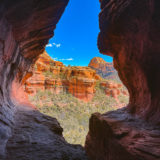
The Subway Cave Hike in Sedona: Everything You Need to Know
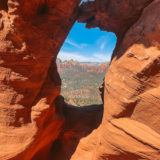
The Schnebly Hill Windows Hike in Sedona: The Complete Guide
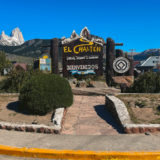

How to hike the W in Torres del Paine, Chile (Trekking Guide)

The W in Torres del Paine is the most popular multi-day hike as you come to see most of the highlights of the park. If you have a look at the map of the trail you'll quickly realize why it is called the W trek. (updated: August 2018)
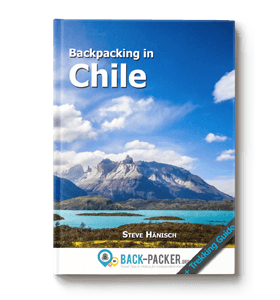
I'll first explain the standard route and then give examples of longer & shorter itineraries. Please plan your trips always regarding to your physical ability and your experience. If you have no or just a bit of hiking experience keep it low and plan more time for each trek. [divider] How to hike the W in Torres del Paine – Quick Links (use the anchor links to jump to the section, use „Top“ to get back to this menu)
- Preparation for the hike
- The W in 5 days, 4 nights
- The W in 4 days, 3 nights
- The W in 6 days, 5 nights
- Guided Trekking Tours
- Video of my experience
1) Preparation
To prepare for trekking in Torres del Paine checkout my other post named ‘How to prepare for hiking in Torres del Paine' with information about transport, accommodation in Pto. Natales, Gear and prices. Moreover I recommend a good health & travel insurance: the one I used from WorldNomads is perfect for this trekking trip as it covers also adventure activities! Please make sure to reserve all camping spots in advance as this trek is the most popular one and visitor numbers increased during the last 3 years. Reservations for Campamento Torres, Italiano and Chileno are mandatory during the official high season from October – April. Please be aware that Campamento Torres is closed due to reconstruction works for the whole 2018-2019 season! If you are too late and not able to make reservations your only chance is to take part in a guided trekking tour or explore the park with day hikes .
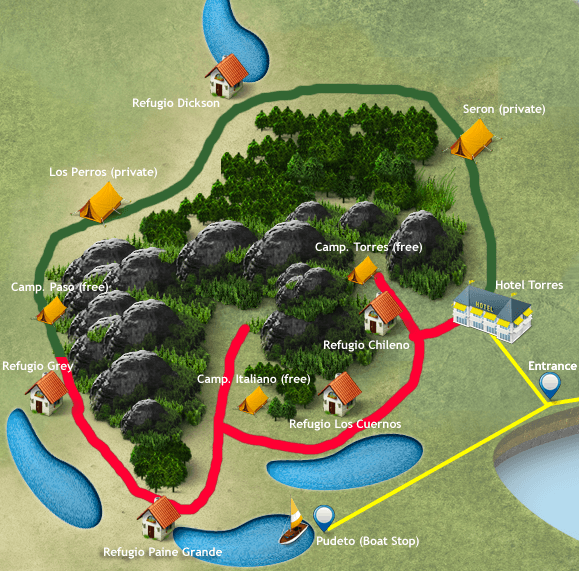
2) The W in 5 days, 4 nights (100 km, 139.800 CLP)
This is the perfect schedule for a relaxed time in the park starting with a nice boat trip and the Glacier Grey, finishing with the sunrise at the Torres in the morning of the last day.
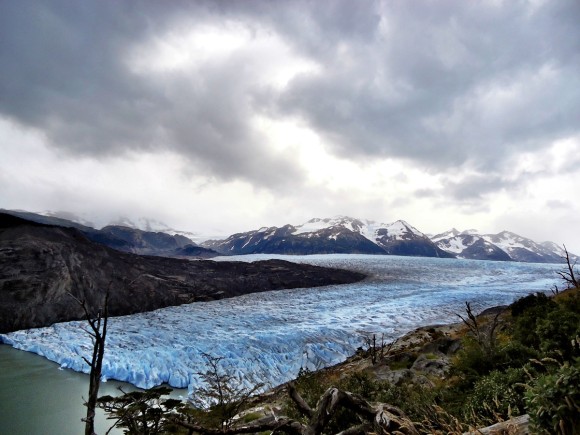
After your arrival in Paine Grande start walking to the Refugio Grey – the path goes uphill, along the Lago Grey with some lookouts on the way. The whole trek will take around 3-4 hours so you'll arrive in the afternoon, can setup your tent (5.000 CLP) and have dinner. If you have some time left you can go down to the beach and maybe touch some icebergs.
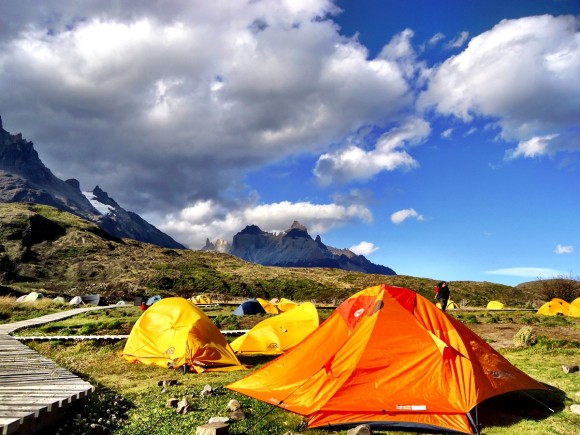
Get up early, leave your stuff at the camp and just take a daypack to hike up to Paso (at 8:00 a.m.). After around 1-1,5hours you'll reach a former campsite (signs with “no camping”) with a lookout nearby (you can see a small path which leads to the platform, hard to find!) – time to enjoy the view to the Glacier for a while (9:30 a.m. – 10:00 a.m.). Now you can decide if you want to continue a bit more into the direction of Paso or keep it shorter. The good thing about the way to Paso: you'll have great views to the Glacier and see a bit more of the massive southern icefield. The downside: it's uphill and adds more km to your trek today (on top of the mentioned 19 km). Do not make all the way up to Paso as it is a pretty long walk (you have to get back to Paine Grande today on time to be fit for the next day).
After your return to Refugio Grey at around lunchtime (12 / 1 p.m.) pack your stuff and head back down (at around 1 / 2 p.m.) to Paine Grande where you spent the night (6.000 CLP), it will take around 3-4 hours – make sure to find a nice place next to the little hill to avoid a bit of the massive winds down there.
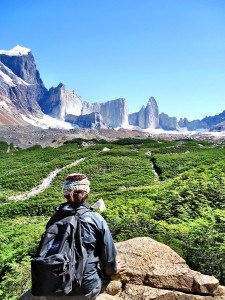
Today is a long & tough day, so get up early again and walk (start at 8:00 a.m.) to Campamento Italiano (around 2 hours = 10 a.m.), leave your big backpack at the camp and head to the Mirador Frances with your daypack (take lunch, water, suncream). After 2,5 hours you'll reach the Mirador and have lunch (12:30 pm.m.). Go back down to Italiano, grab your backpack and keep going to Los Cuernos (03:00 / 3:30 p.m.). After another 2 hours you should reach the campsite (at 5:00/5:30 p.m. – 70000 CLP). Alternatively you make it a short (and much cheaper) day by spending the night at Campamento Francés (13.000 CLP).
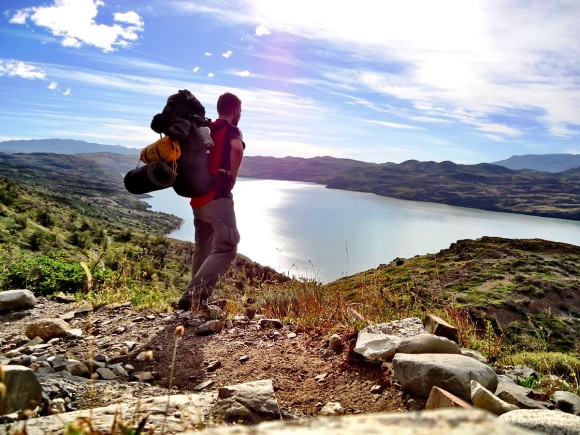
On your last full day you have a nice hike ahead – starting flat and going up at the end to the base of the Torres. Start your walk around 9 a.m. to Campamento Chileno. The trail goes along the Lago Nordernskjöld, after around 3,5 hours you'll reach the shortcut to Chileno (it's hard to miss as there is a big sign saying “shortcut to Chileno”). Another 2 hours later you'll arrive at the Refugio Chileno (around 2:30 p.m. / 3 p.m.) you can make a short break and afterwards head uphill to the free campsite Campamento Torres, this will take around 1 hour. After setting up your tent use the chance to visit the Torres for the first time – it's a 45 min walk uphill. Remember that you can only stay there if you made a reservation beforehand!
Note: Unfortunately Campamento Torres will be closed for the 2018-2019 season due to maintenance work – therefore you need to switch plans to camp at Chileno (pretty pricey) or down at Campamento Las Torres (next to Hotel Las Torres). You should consider doing the sunrise hike only if you stay at Chileno and calculate 2,5 – 3h to reach the towers.
Go to bed early today as you have to get up very early tomorrow to see the sunrise at the towers. Depending on the time of the sunrise (ask the rangers) set your alarm 1 – 1,5hours before and prepare a daypack with mat, sleeping bag and breakfast as well as rain jacket)
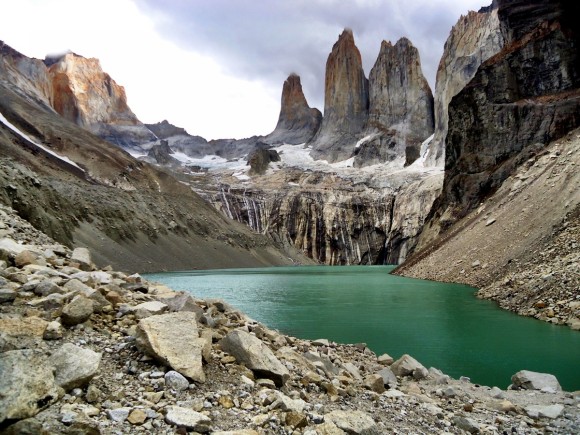
In summer the sunrise is around 6 a.m., therefore leave the camp with your daypack at 5 a.m. to arrive at the Mirador of the Towers on time. Set up your little picnic and enjoy – if you are lucky you'll see amazing colors with a clear view, having the best breakfast ever. If you are not lucky like me you'll have rain and clouds – in that case you'll love the fact that you've been up here the day before. Don't make the fault to skip the way up when it is raining in the camp – the weather changes really quick and you might regret it later. Go for it anyway as it is your last day and it doesn't matter if your sleeping bag gets wet up there 😉
After your return take down your tent, pack your stuff and leave the camp at around 9 a.m. Head down to the Hotel Las Torres – it'll take around 3 hours to arrive there. Depending on the time you arrive (should be 12 p.m.) you can decide if you want to walk from the Hotel to the entrance (1 hour, 7,5km along the road) or pay 2.800 CLP extra to take the minibus which leaves around 2 p.m. The Bus back to Puerto Natales leaves at 2:30 p.m. from the entrance as already described in the preparation Guide .
Congratulations! You've done the W in Torres del Paine and with that around 100 km by foot.
3) The W in 4 days, 3 nights (100 km, around 134.800 CLP)
If you are short on time but good in shape you can also do the whole ‘W' in one day less. For this you simply make Day 1 and Day 2 in one day. With this you have a real challenging program right at the start.
Day 1: Puerto Natales – Refugio Grey – Paine Grande (28 -30 km, 15.000 CLP + 21.000 CLP + 20.000 CLP + 6.000 CLP) Leave Puerto Natales with the early bus (15.000 CLP return ticket) and get off at Pudeto (next stop after the park entrance – fee: 21.000 CLP) where you catch the catamaran to Paine Grande (20.000 CLP). Use the waiting time to visit the waterfall nearby (ask for the time of the boat before leaving). After your arrival in Paine Grande leave your stuff at the camp and just take a daypack to hike up to the Refugio Grey – the path goes uphill, along the Lago Grey with some lookouts on the way. The whole trek will take around 3-4 hours so you'll arrive in the afternoon (4 p.m.). Keep walking in the direction of Paso.
After around 1-1,5hours you'll reach a former campsite with a lookout nearby – time to enjoy the view to the Glacier for a while (5 p.m.). Do not continue the way up to Paso as it is a pretty long walk (you have to get back to Paine Grande today to be fit for the next day). After your return to Refugio Grey (6 p.m.) head back down to Paine Grande where you spent the night (6.000 CLP), it will take around 3 hours – make sure to find a nice place next to the little hill for your tent to avoid a bit of the massive winds down there.
Continue with Day 3 of the previous itinerary
4) The W in 6 days, 5 nights (100 km, around 137.000 CLP) – not in 2018/19!
Day 4: Campamento Italiano – Refugio Chileno (19 km, 139.800 CLP) Again you can take it easy. Start your walk around 10 a.m. to Campamento Chileno. The trail goes along the Lago Nordernskjöld, after around 5,5 hours you’ll reach the shortcut to Chileno (it’s hard to miss as there is a big sign saying “shortcut to Chileno”). Another 2 hours later you’ll arrive at the Refugio Chileno (around 5:30 p.m.). Remember that you can only stay here if you made a reservation beforehand!
Day 5: Refugio Chileno – Campamento Torres (8 km, free) As you see you have the most relaxed day ahead because you just move from one campsite to another. Have a slow start and head uphill, set up your tent and use the huge amount of time to spend some hours at the Torres in the afternoon. Also here you mostly need a reservation to camp.
For Day 6 continue with Day 5 of the standard itinerary.
Consider: The free campsite Torres is very popular, therefore you can stay mostly only for one night there.
5) Essentials
Get my chile guide incl. tdp itineraries.

6) Guided Trekking Tours
Another option is to book a complete tour – this way you can leave the organization, gear rental, transportation, food and booking of campsites to local experts. Though you pay more you'll get the full package this way including porters and a knowledgable guide. After working with them in Peru I highly recommend the tours offered by G Adventures as their philosophy and focus on sustainable travel are in line with my personal values. With many years of expertise you can expect a well organized, fun trips in small groups with like-minded travelers:
- W-Trek with G Adventures – 6 day trek including meals, guide, camps, tents/hotel, transport and porters
- “O” Circuit-Trek with G Adventures – 11 day full circuit trek (includes the ‘W') including meals, guide, camps, tents/hotel, transport and porters
- Hike Patagonia in depth – active 14 day tour covering the highlights of Patagonia, including the Torres del Paine W trek, El Chaltén (Fitz Roy, Cerro Torre) and El Calafate (Perito Moreno glacier) including meals, guide, camps & tents, hotels, transport and porters
- Patagonia & Tierra del Fuego – active 14 day tour covering the highlights of Patagonia, including the Torres del Paine W trek, El Chaltén (Fitz Roy, Cerro Torre), El Calafate (Perito Moreno glacier) and Ushuaia. This also includes meals, guide, camps & tents, hotels, transport and porters.
7) Video of my experience
In 2016 I revisited Torres del Paine and spent around 2 weeks inside the National Park: first I hiked the full circuit (which includes the “W”), next I stayed at the Hotel Las Torres inside the park for a few more days to explore the several day tour options.
[divider] Info: During my time in Patagonia, I hiked the W, the circuit and the Q. I hiked the “Q” in 2013 and did the circuit again in 2016, altogether I spent 3 weeks in the park. All times here are based on my experience (i hiked all the trails I'm writing about) – I would say I'm a bit faster in hiking than the average hikers but I made some stops in between for taking photographs and filming. The prices mentioned are for camping and per Person. A good hiking map will be provided for free once you enter the park, you should consider getting a waterproof map beforehand for planning purposes. This article is part of a whole series of free guides for Backpacking in South America . [divider]
You hiked the W in Torres del Paine as well? Tell us more!
If you have any tips or hints feel free to join the conversation – post a comment below and share your experience of hiking the W in Torres del Paine! Moreover you can share this article with your friends on Twitter, Facebook or Google Plus by using the related buttons on the left. [divider]
Helpful? Pin Me!
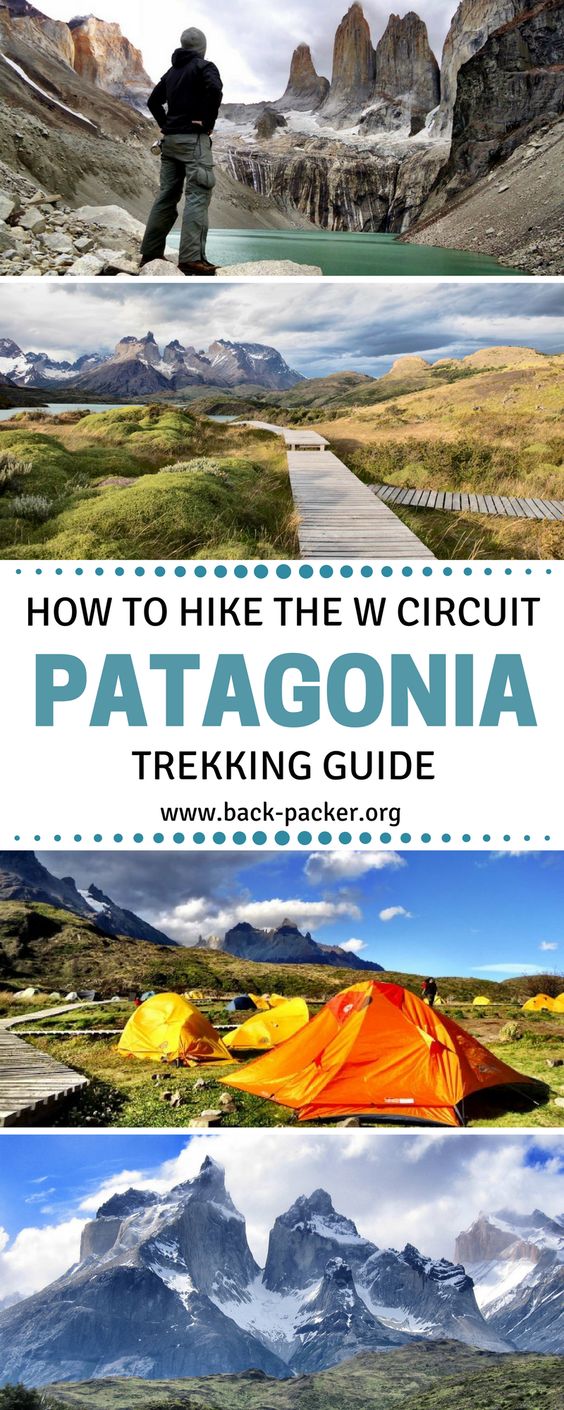
About The Author
Steve Hänisch
Verwandte beiträge.
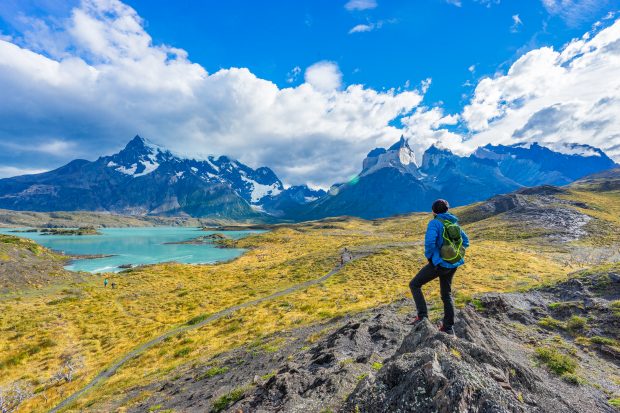
Best Day Tours & Day Hikes in Torres del Paine, Chile (Patagonia)
In this article I introduce you to the best day tours & day hikes in Torres del Paine. In contrast to the popular multi-day treks…
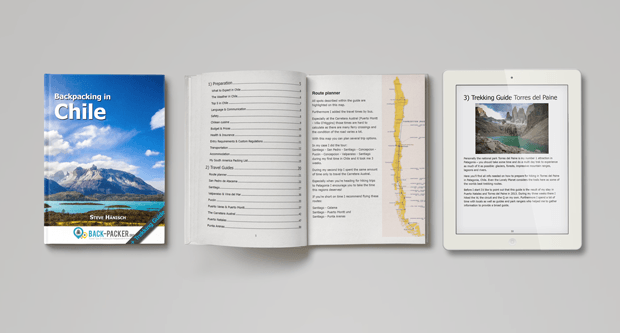
Backpacking in Chile (Book) – all Links & Accommodation recommendations
Thanks again for purchasing my travel guide – as promised you can find all related links in this article, sorted by chapter. Each URL will…
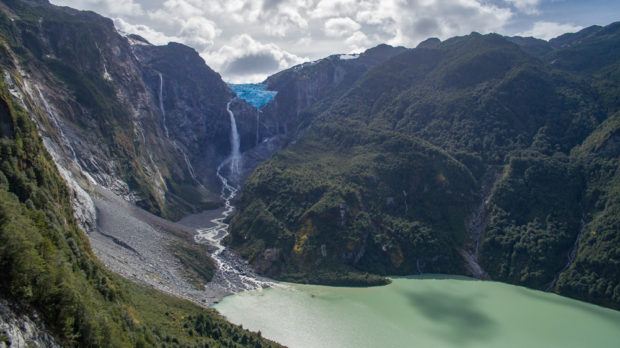
Top 10 Places to visit along the Carretera Austral in Chile
The Carretera Austral in Chile is definitely the highlight of Patagonia as this 1,200 km long road takes you to the most impressive corners of…
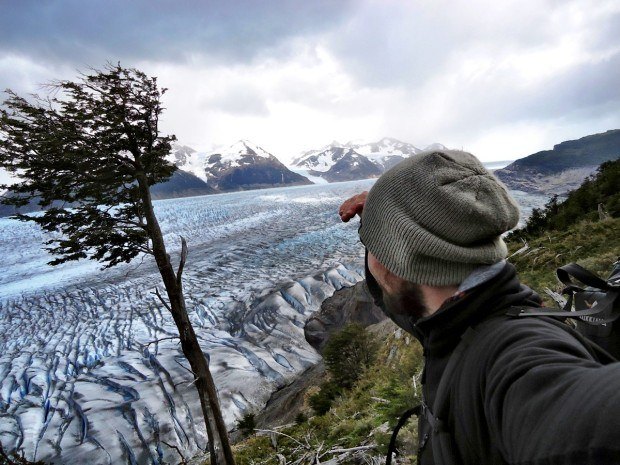
Trekking Guide: How to hike the Circuit in Torres del Paine, Patagonia (Chile)
If you are in Patagonia you should spent as much time as possible out there in the nature. Therefore the Circuit Trail in Torres del…
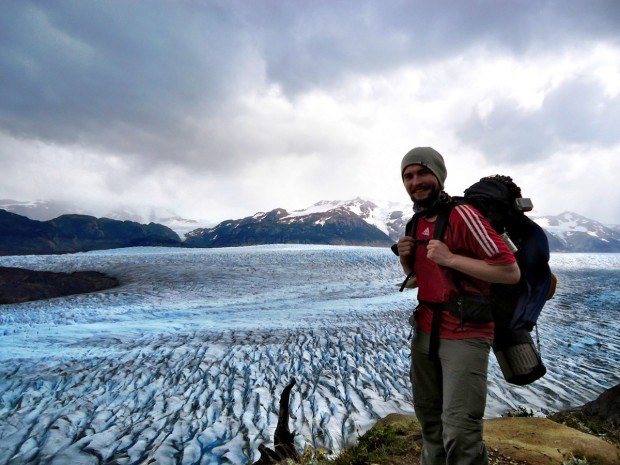
Trekking Guide: How to prepare for hiking in Torres del Paine, Patagonia (Chile)
Here you’ll find all info needed on how to prepare for hiking in Torres del Paine in Patagonia, Chile. Even the Lonely Planet considers the…
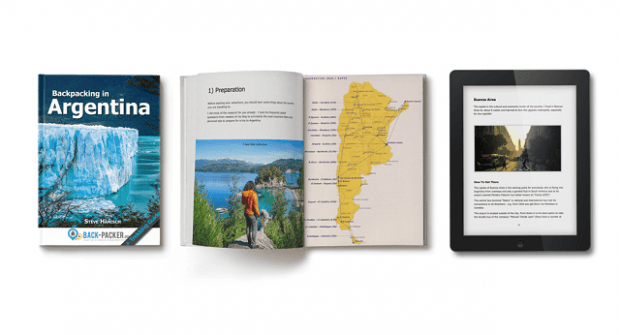
Backpacking in Argentina – my Argentina Travel Guide
My Argentina Travel Guide helps you to plan your trip to Argentina and explore the most incredible places this country has to offer from Salta…
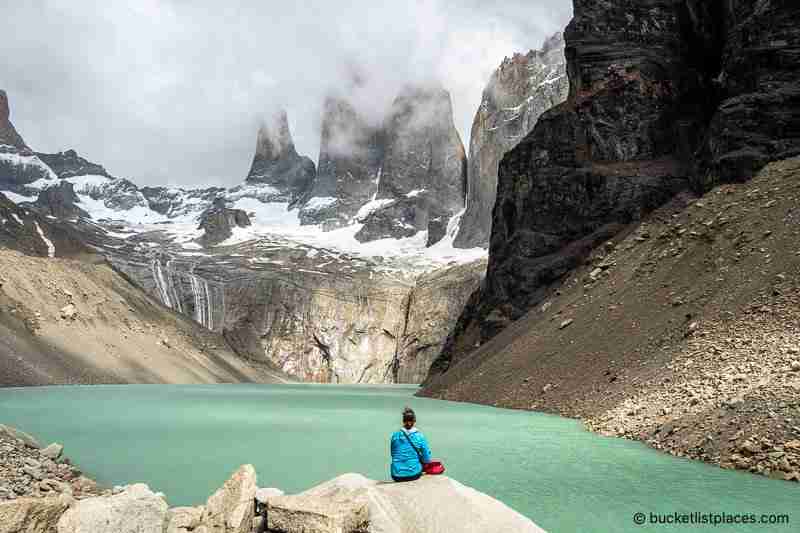
Ultimate Guide to Hiking the W Trek in Patagonia
Situated in the southern realms of South America , Patagonia is one of the world’s last untouched wildernesses. Chilean Patagonia is a land of towering peaks, crystal-clear rivers, blue-hazed glaciers and treeless steppe, it offers vistas like nowhere else on Earth.

Often at the top of hiker’s bucket list, the region’s most celebrated trekking route, the W Trek, takes a ‘W-shaped’ path through Chile’s Torres del Paine National Park in Patagonia. There’s perhaps no better way to explore the region’s dramatic landscapes than on foot, so we’ve created a comprehensive guide with everything you need to know about hiking Patagonia’s famed W Trek.
Travel Guide to Hiking the W Trek in Patagonia
Hiking the w trek basics.

While scenic, hiking the W Trek is no gentle stroll in the park. Demanding in places, it requires a good level of basic fitness to cover its 50-mile length successfully. This is not least because altitude is a significant factor on the route, topping out at more than 3,500 feet above sea level. After all, the W Trek lies deep within the southern reaches of the mighty Andes mountain range. Located within Chile’s Torres del Paine National Park , the W trek can usually be hiked in four or five days.
There are a number of options available for those looking to hike the W trek. Some choose to pre-plan the lodging, purchase a pass and do it on their own. While this is certainly an option, the lodges fill up months in advance. Another option for those that don’t want to hike the W trek alone or are booking closer to your hike date and the lodges are full, is to book a guided hike.
Guided hikes can be private or you can book a small group hike to go with a guide and some other people.
Accommodation on the W Trek
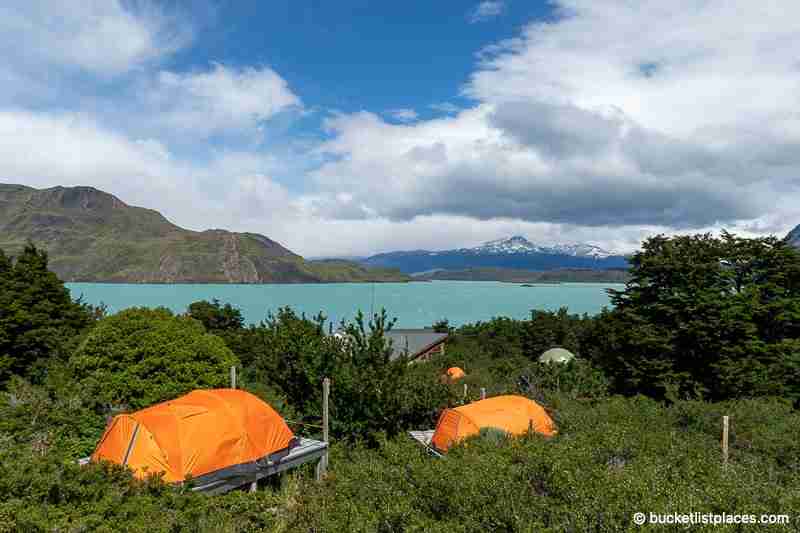
Most of this multi-day hike will require overnight camping in tents or at a designated lodge, with hostels and hotels accessible at the start and end of the trek. Camping is only permitted with designated refuges, or refugios at Torres del Paine National Park. Keep in mind that these often get booked up a year in advance so make sure to plan ahead to get the best spots at your favorite refugio.
Lodging at the refugios are either tent camping or a shared room inside the lodge. Tents provided at the refuge are meant for the colder weather, rain and wind so they are warmer than tents you may be used to. Still, if you require the comfort of your own bed inside a warm, cozy lodge then make sure to book even further out because those rooms book up the fastest.
The upside of this arrangement is that you’ll have access to shared bathroom facilities, which generally include hot showers ideal for soothing sore muscles after a day’s walk. Refuges also have heating and electric lighting, and a communal dining room for eating meals sheltered from the elements. Most contain a small shop selling basic items.
Many of the refugios even have wifi so you can catch up on communication with loved ones. Keep in mind that the cost is much higher because it is satellite internet. You will not have cell service while hiking the W trek so make sure your loved ones are aware.
HOT TIP : If you find that individual reservations are booked up in all of the refugios, there may still be availability through a guided tour . You can join a guided hiking tour that is organized by the companies that own the shelters and this comes with a guide for your hike as well as lodging at the shelters along the way. It will be slightly more expensive than hiking and booking everything solo and you will be restricted to one company of shelters versus being able to pick and choose but the upside is your dates will be more likely to be available when planning closer to your travel date.
When to Tackle the W Trek

Hiking the W Trek is open right throughout the year, but if you’re planning on heading along it independent of guides and tour groups you’re limited to the period between October and April. This coincides with the southern hemisphere’s summer months and is also great to combine with a visit to the beautiful Atacama desert .
Independent hiking is complicated by the fact that places at refugios need to be reserved ahead of time, and can be fully booked months in advance. This is particularly true for the high season, which lasts from December to February. The route is also at its busiest during these months, which some trekkers find takes away from the overall experience of solitude and isolation Patagonia is renowned for.
Getting Started : Where to Fly Into and How to Get There
The standard gateway to the W Trek is the town of Puerto Natales , Chile. It lies more than 1800 miles south of the Chilean capital, Santiago. Limited flights connect the airport at Puerto Natales with Santiago, and it’s often easier to fly to either Punta Arenas further south in Chile, or even to El Calafate, just across the border in Argentina.
From either of these latter airports, you’ll then have to head to Puerto Natales by road. Long distance buses cover the distance from Punta Arenas in around three hours, or around 7 hours from El Calafate including border formalities. There is also an opportunity to rent a car and drive yourself .
If coming from Argentinian Patagonia, you should arrange your visa for Chile ahead of time. However, most European, North American and Australian passport holders require nothing more than six months validity on their passport for tourist visits of less than 60 or 90 days (dependent on nationality).
Puerto Natales – The Gateway to Torres del Paine National Park

Puerto Natales has a good cluster of hostels and hotels that are well used to welcoming those starting or finishing hiking the W Trek. Perhaps even more helpfully, this once small fishing village has a number of stores where hikers can rent any equipment they may need. Most stay open until 8 or 9 pm, allowing you to organize any kit requirements even if you arrive later in the day.
It’s also possible to securely store gear you won’t need during the trek. Ideally, your backpack won’t weigh more than around 30 lbs.
Storage can be arranged with your guiding service if you hire a guide, with your hostel/hotel depending on where you are staying or you can rent storage at the bus station. Ask your hotel or hostel if it is possible to store some of your items while you do the W trek. If they don’t have storage available, you can store your items at the bus station. Be aware of the opening hours if you choose this option as you will only be able to drop off or pick up your items during specific hours.
Getting to the W Trek from Puerto Natales, Chile
It’s possible to walk the W Trek in either west to east or east to west directions. That said, the vast majority of trekkers start the trail at the end closest to the entry gates into Torres del Paine National Park, which means they tackle the route from west to east. In turn, starting the trek in this direction means you’re not thrown into the deep end on day one.
Several trustworthy companies run buses that drop off and pick-up hikers from the park entrances. The trip takes between two and four hours depending on which entrance is used. They all have departures in the morning from Puerto Natales, usually around 7 am. If you’re struggling to get a seat, less popular services also operate in the early afternoon, leaving Puerto Natales around 2.30 pm.
You should buy your ticket ahead of time at the company offices inside Terminal Rodoviario , where the buses depart from. You’ll find the terminus on Avenida Espana. Round trip tickets (around $20) permit a ride on any of that company’s returning buses.
Buses generally have stops at Laguna Amarga, Pudeto, and Administrativa. The stop at Laguna Amarga is primarily used by those heading along the W Trek from east to west as it connects with the minibus to Las Torres base camp.
If you’re following the majority of trekkers in starting the W Trek at its western end, you’re better off buying a ticket to either Pudeto or Administrativa. From Pudeto, a catamaran crosses Lake Pehoé in around half an hour. Its destination is Paine Grande. As it lies midway along the W Trek route, arriving via Pudeto means repeating your day one walk on day two.
A way of avoiding this is to head instead to Administrativa and then catch the three-hour ferry that travels the length of Lago (Lake) Grey towards the stunning Grey Glacier where there is a campsite.
Fees for entering the park are the equivalent of roughly $30, and can be paid in Chilean pesos, US dollars or euros. If you pay in dollars or euros try and have the exact amount and don’t rely on there being change available. There are numerous currency exchanges in Puerto Natales. Tickets last as long as you stay within the park, or for five consecutive days of entry.
W Trek Itinerary

For those crossing Lake Grey, day one of hiking the W Trek will be mostly taken up by arrival at Grey Campsite, situated between the lake and montane forest. However, there’s still a chance to give your hiking boots a little action, with a trail leading to a viewpoint of Grey Glacier. Approximately one mile in either direction, it has an ascent and descent of around 1,200 feet in total.
If you get lucky with the weather you will have incredible views of the glacier and the glacial lake with icebergs swimming in it. The day we went was cloudy, windy and rainy making it very difficult to complete the hike. While you can’t predict the weather, be aware that the glacier creates a micro climate so just because it is sunny in other parts of the park does not mean that it will be the same nice weather near the glacier. Pack a hat and a warm jacket as it can get very cold, windy and wet.

Day two is usually the first full day of hiking the W Trek, with the path following the eastern shore of Grey Lake for the first third of the day’s route before moving inland.
The path is relatively gentle, and the scenery simply extraordinary from early on. The campsite of choice is called Refugio Italiano, which sits at the southern end of French Valley. In all, hikers usually take around eight hours to reach this point, covering around 13 miles and a further 1,000 feet in altitude.

Day three is normally dedicated to hiking French Valley which is the favorite part of hiking the W trek for many.
Following streams and rivers much of the way north, the valley offers spectacular views of glaciers towards the lookout at Britanicos Camp, although it’s uphill all the way. After taking in the majestic scene, you then complete the central part of the ‘W’ by returning to your previous night’s camp, having covered around ten miles and another 1,000 feet in altitude.
The day’s trek usually lasts around seven hours. Just like with the previous treks, the glaciers here can create microclimates which means that the weather could be unpredictable. Parts of this trek can be especially windy so hold on to your hats!

Day four of the W Trek sees hikers take on the second ‘V’ of the W-shaped route, along the Sendero Paso Los Cuernos trail. Much of the day’s path follows the shores of Lago Nordenskjöld, which are typified by alpine grasslands crisscrossed by small streams. You’ll more than likely end the day at Chileno Camp, after seven hours and 12 miles of walking.

Day five is normally the last day of hiking the W Trek, although it’s possible to cover shorter distances each day thanks to a chain of intermediate campsites along the way.
For most though, day five means the journey to the base of Los Torres mountains, which rise to a height of 9,500 feet. Heading towards their granite towers you’ll follow the sound of the River Asencio. The trek ends with a scramble over loose moraine, so be sure to save some energy.
In all, you’ll cover around nine miles in six hours, allowing plenty of time to meet the bus back to Puerto Natales.
What to Pack when Hiking the W Trek
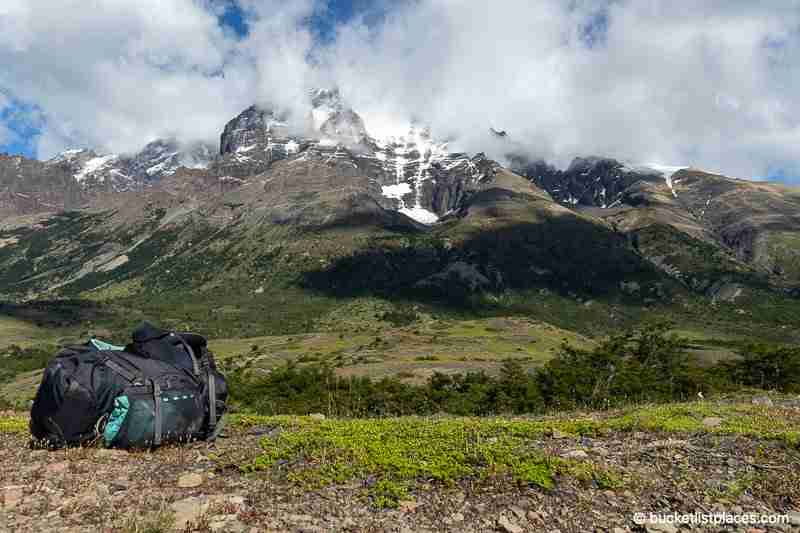
Camping equipment can be rented at refugios, but this will add to your costs. If you’re completing the W Trek as part of a tour , tents and meals will be prepared for you. Even so, you’ll still need some specialty equipment to finish hiking the W Trek. In addition to cold weather gear, you should take waterproof clothing, as well as a battery-operated head torch for nights in camp and early morning starts.
Weather can really vary in the summer so you will need both warm clothing on the cold days and nights and light clothing for hotter days.
Below is a brief checklist of the must have things to pack along with you so you are prepared for the elements when hiking the W trek.
While there are many tours and ways to visit Torres del Paine National park , The W Trek in Torres del Paine National Park is an ultimate bucket list experience for anyone visiting Patagonia in Chile. Taking in incredible mountain, lake and glacier views there’s really nothing else like it. Follow the recommendations in our guide to hiking the W Trek in Patagonia, and you’ll be well on your way to being able to tick off this bucket list.
Looking for more epic bucket list destinations in South America? Check out our content for Ecuador for some incredible places to explore.
Bucket List Places Contributors
Roatán travel guide: best things to do, where to stay, eat, drink, galapagos luxury cruise review: aboard quasar evolution 8 days/7 nights, you may also like, kenya safari travel guide: the best parks to..., san juan islands travel guide and ultimate 10-day..., a guide to thailand’s remarkable temples, 10 day alaska road trip itinerary: ultimate alaska..., atacama desert travel guide: things to do, where..., most beautiful places in ethiopia: ultimate travel guide, 10 most beautiful places in laos to visit, diving in galapagos: one of the best places..., galapagos luxury cruise review: aboard quasar evolution 8..., roatán travel guide: best things to do, where....
This website uses cookies to improve your experience. We'll assume you're ok with this, but you can opt-out if you wish. Accept Read More

Solo Hiking the W Trek in Torres del Paine: A Comprehensive Guide to Trekking without a Guide in Chilean Patagonia
Are you ready to embark on an epic solo hiking adventure? Look no further than the W Trek in Torres Del Paine, Chile. This comprehensive guide will equip you with everything you need to conquer the one of the best hikes in Patagonia . Whether you’re a seasoned hiker or new to the trail, we’ll ensure you have all the information you need for solo hiking the W Trek. From crafting your perfect itinerary to packing the essentials and navigating the logistics, let’s prepare you for the journey of a lifetime.
This article contains affiliate links from the Amazon Associate and Travelpayouts programs. Wild Travel Tales will earn from qualifying purchases, at no extra cost to you .
Key Takeaways
- Day 1: Puerto Natales to Grey (bus, ferry, 11km walk)
- Day 2: Grey to Paine Grande (11km), plus optional glacier hike
- Day 3: Paine Grande to Francés/Los Cuernos (21km)
- Day 4: Francés/Los Cuernos to El Chileno/Central (18km)
- Day 5: El Chileno/Central to Mirador Las Torres to Puerto Natales (9km)
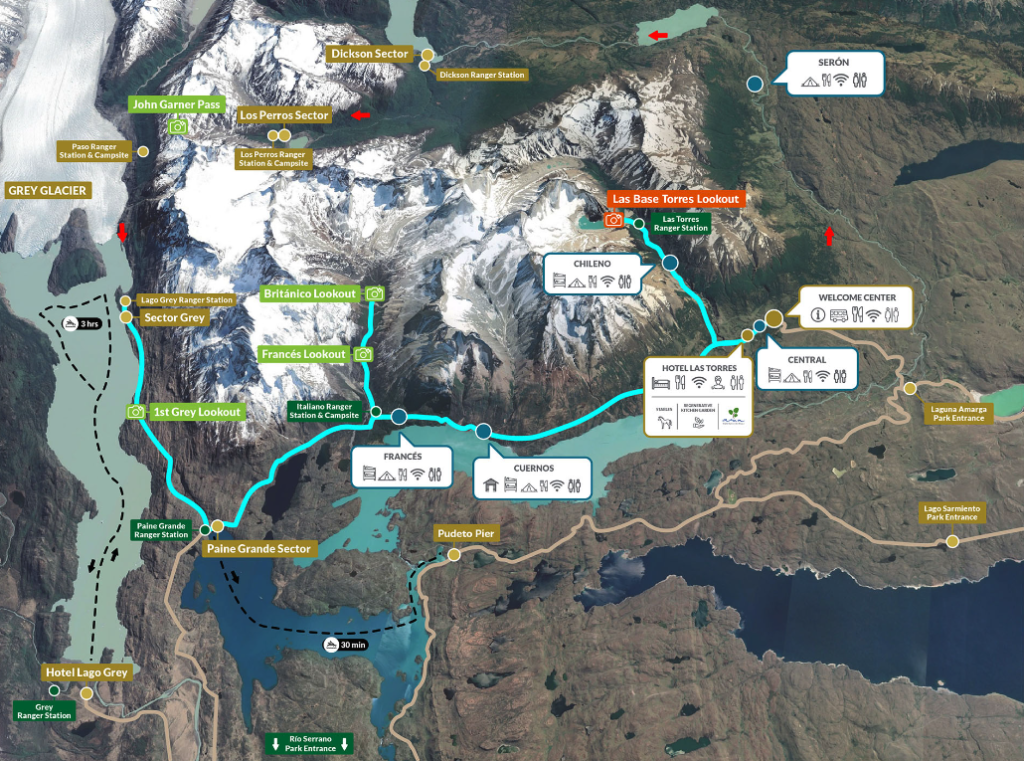
Checklist to Hike the W Trek without a Guide
This post explains everything you need to do to plan your W Trek adventure in detail. Before we get started, here is a simple checklist you will need to check-off.
- Book your accommodation via Torres Hike , or directly via Vertice and Las Torres – you need to book as early as possible, as it it can book out!
- Book your entrance ticket to Torres del Paine National Park online
- Pack proper equipment and food
- Book your return bus ticket from Puerto Natales to Torres del Paine National Park
- Ensure you have at least $28,000 pesos in cash ($25,000 pesos for the ferry, $3,000 pesos for the shuttle bus) as well as extra for any additional purchases you may want to make while in the park (e.g., snacks, drinks, meals, etc) – you should definitely bring extra money, just in case!
Where is the W Trek Located?
The famous W Trek is located in Torres Del Paine National Park, nestled in the southern reaches of Chilean Patagonia. This UNESCO Biosphere Reserve boasts pristine landscapes, dramatic peaks, and crystal-clear lakes, making it a dream destination for adventurers like you. The name “W Trek” originates from the distinct W-shaped path you’ll follow through the park, which offers a curated experience of Patagonia’s finest offerings.
When is the Best Time to Do the W Trek?
Planning your visit to Torres Del Paine is a crucial first step. While the park is open year-round, selecting the best time to hike the W Trek can greatly impact your experience. This will mostly come down to your preferences and desired experience.
Here’s a breakdown of your options:
- Shoulder Seasons: For milder weather and fewer crowds, consider hiking during late October to early November or late March to early April.
- Peak Season: If you crave the vibrant colours of Patagonian spring or the lushness of summer, be prepared for larger crowds during the peak season from November to March.
Where to Stay on the W Trek?
The W Trek offers a range of accommodation options to suit various preferences and budgets:
- Camping: Experience the wild by camping under the stars. This is a budget-friendly option for adventurous backpackers.
- Refugios: For a more comfortable stay, opt for refugios, which are similar to hostels. They offer a warm and cozy atmosphere after a long day of hiking and often provide shared facilities.
Camping vs Refugios on the W Trek
For those with an adventurous spirit and a desire to be as close to nature as possible, camping is an excellent choice. It is also substantially cheaper than staying in a refugio, which is a great way to bring down the cost of hiking the W Trek.
Many campsites are strategically located right outside the doors of refugios, granting you easy access to their facilities. This means you can enjoy the perks of refugios, such as meals and hot showers, while still savouring the authenticity of sleeping under Patagonia’s star-studded skies. It’s worth noting that you’ll need to carry your camping gear, including a suitable tent, sleeping bag, and cooking equipment, to ensure a comfortable stay. However, there are premium campsite options available with a pre-erected tent provided!
On the other hand, if you prefer a bit more comfort and convenience, the refugios are ready to welcome you. These cozy mountain lodges provide dormitory-style accommodation and shared facilities, including dining areas and hot showers. Staying in a refugio means you don’t have to lug heavy camping gear with you, allowing for a lighter backpack. However, it will make hiking the W Trek more expensive.
Booking Campsites & Refugios for the W Trek
As one of Patagonia’s most sought-after hikes, it can be difficult to secure campsites or refugio beds for the days you want. It is essential that you book your accommodation in advance (as early as possible), especially during the peak season. It is not uncommon for campsites and refugios to book out.
The campsites and refugios at different points along the W Trek are operated by two different companies, Vertice and Las Torres (formerly Fantastico Sur) . You have two different options to book these sites:
- Book via Torres Hike , a platform which aggregates availability from both Vertice and Las Torres. All you need to do is enter your planned dates, the direction of your hike and which type of accommodation you want, and the website will allow you to make one single booking (instead of coordinating separate bookings via both Vertice and Las Torres). This will save you lots of time compared to the second option…
- Make reservations with Vertice and Las Torres directly, via their websites. This option requires you to ensure the availability of campsites offered by both providers aligns with your planned itinerary in the correct order of your hike, then booking each night of accommodation on each company’s separate website. Meticulous planning is necessary.
Why would anyone book through separate websites when it is all collated in one platform via Torres Hike? Good question. Unfortunately, Vertice and Las Torres only allocate a limited number of campsites for purchase via Torres Hike. And because Torres Hike is a far easier process, these sites will book out more quickly than direct bookings. So, if Torres Hike does not show any availability for the dates you want to hike the W Trek, you may be able to book under your original itinerary if you book via Vertice and Las Torres.
There are often different options you could book for each night, depending on the distance you plan to cover each day. Below are the campgrounds along the W Trek in order.
- Refugio and Camping Paine Grande (Vertice Patagonia)
- Refugio and Camping Grey (Vertice Patagonia)
- Domes and Camping Francés (Las Torres)
- Refugio and Camping Los Cuernos (Las Torres)
- Refugio and Camping Torres Central (Las Torres)
- Refugio and Camping El Chileno (Las Torres)
You will only stay at 3 or 4 of the campsites, depending on how many days you plan in your itinerary. Plan ahead, consider your preferences for camping or staying in refugios, and make those reservations promptly to guarantee a smooth and enjoyable W Trek experience.

How Difficult is the W Trek?
The difficulty of the W Trek can vary along its route. Understanding its challenges is paramount for a successful journey. Here’s an in-depth look at what you can anticipate.
Physical Fitness: The W Trek is considered moderately strenuous, making it accessible to hikers with a range of fitness levels. While it doesn’t require you to be an elite athlete, it’s essential to have a reasonable level of physical fitness. This includes the ability to hike for several hours a day, navigate uneven terrain, and endure uphill climbs and descents. Prior conditioning and cardiovascular endurance can significantly enhance your experience.
Changing Trail Conditions: Patagonia’s weather is notorious for its unpredictability. Be prepared for rapidly changing conditions that can range from sunny and pleasant to windy, rainy, or even snowy. Proper clothing and gear are crucial to adapt to these changes and ensure your safety and comfort.
Route Options: The W Trek offers flexibility in choosing your direction, whether east-to-west or west-to-east, each with its own highlights. Starting from the east provides a dramatic introduction to the famous Torres Del Paine, while the west-to-east route saves the iconic towers for a breathtaking finale. Your choice can influence the level of challenge and the order in which you encounter terrain difficulties.
Mental Preparedness: Apart from physical stamina, mental preparedness is equally vital. The W Trek can be mentally demanding due to its length and the ever-changing Patagonian weather. Staying positive, focused, and patient in adverse conditions or challenging moments will contribute significantly to your overall experience.
Trail Easing Tips: To make your hike more manageable, consider using hiking poles for stability, wear appropriate footwear with ankle support, and break in your hiking boots before the trip. Additionally, packing smartly, including essential items, such as moleskin for blisters, sunscreen, and extra layers, can help ease your journey.
Prepare mentally and physically for the challenges that await you, and you’ll conquer the trek with confidence.
What Should I Pack for the W Trek?
The key to a successful W Trek is packing the right gear. Here’s a list of essentials.
Camping Gear:
- Sleeping bag (rated for 20 degrees or less)
- Sleeping mat
- Gas stove /jet boil
- Gas canister
- Lightweight bowl/plate /utensils
- Travel towel
- Layers are essential. Pack a handful of lightweight shirts/base layers.
- Fleece jacket
- Waterproof jacket
- Waterproof gloves
- Water-resistant pants
- Several pairs of socks
- Hiking boots
- Camp/refugio slippers
- Comfortable camp clothing
Hiking Gear:
- Consider hiking poles for stability
- Moleskin for blisters
- Refillable water bottle
- First-aid kit
With the right gear in your backpack, you’ll be prepared for whatever Patagonia throws your way.
How Long Does it Take to Hike the W Trek?
The W Trek offers flexibility in both duration and direction. You can choose to complete it in 4, 5, or 6 days, depending on your pace and preferences. A fit hiker can complete the route in 4 days with careful planning. Choosing a 5-day itinerary can provide some extra time to explore side trails and enjoy the scenery, without rushing to meet longer distances. If you are new to hiking and want to take it easy, make it a 6-day adventure.
How Do I Get to the W Trek?
The best way to get to Torres del Paine National Park is from Puerto Natales, a charming town that serves as the main entry point to the national park. Wherever you are, you need to get here!
Travellers can now enjoy the convenience of direct flights from Santiago to Puerto Natales, thanks to the Teniente Julio Gallardo Airport (PNT), with a flight duration of approximately 3 hours. After landing, a short 10-minute taxi ride will swiftly transport you from the compact airport to the heart of downtown Natales, where the majority of hotels and accommodations are thoughtfully situated for your ease and comfort.
If you need other options, you can also catch a flight to Punta Arenas and take a bus to Puerto Natale. We recommend booking your bus tickets in advance, especially if you’re aiming for early morning departures, as they can fill up quickly.
Stay overnight in Puerto Natales to rest and prepare for your adventure. The town offers various accommodation options , and it’s an excellent opportunity to stock up on supplies, including any last-minute gear or provisions you might need for your trek. After a peaceful night’s rest and final preparations, you can embark on the short journey from Puerto Natales to the enchanting wilderness of Torres Del Paine National Park, where the W Trek awaits, ready to unveil its natural wonders.
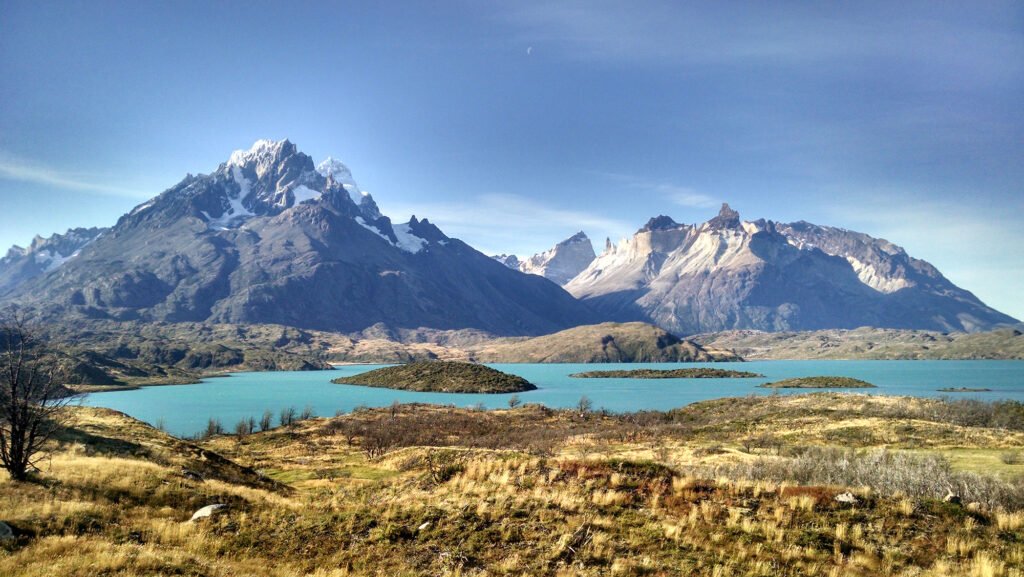
Food & Water for the W Trek
You will be able to buy food and drink at each of the refugios along the W Trek. However, this can get very expensive. We recommend that you try to be fully self-sufficient – and bring some extra cash to treat yourself on difficult days!
Food: You can stock up on food supplies from a supermarket in Puerto Natales, before departing to Torres del Paine National Park. Make sure to take a high-quality gas stove , gas canister, and mess kit .
Water: All campsites have access to fresh water sources to cook and refill your bottles. To avoid waterborne illness, we suggest that you use a water purification filter or water purification tablets before drinking this water.
5-Day Itinerary for Hiking the W Trek without a Guide
You will hike the W Trek one-way – meaning, it’s not a loop! You can choose to trek from either direction, east-to-west or west-to-easy. Each offers its own unique highlights:
- East-to-West: If you start from the east, your journey begins with a dramatic encounter with the famous Torres Del Paine, leaving you with diverse landscapes to explore.
- West-to-East: Opting for this direction allows you to save the magnificent towers for your grand finale while hiking through stunning valleys and forests.
The choice is yours, so customise your adventure to match your desires. The itinerary below is a sample 5-day itinerary for solo hiking the W Trek, from west-to-east. You can follow the plan below in reverse to do the trek from east-to-west, or make amendments to shorten or extend your total hike.
Please note that this itinerary provides an overview of the daily routes, but actual hiking times may vary based on your pace and trail conditions. Additionally, availability at refugios and campsites should be confirmed and booked in advance, especially during the peak trekking season. Enjoy your unforgettable journey through the stunning landscapes of Torres Del Paine!
Day 1 (Puerto Natales –> Refugio Grey)
- Total Kilometers: Approximately 11 km
- Estimated Time: 3-4 hours
- Start Point: Puerto Natales
- Finish Point: Grey
Begin your journey by catching the 7 am bus from Puerto Natales to Torres Del Paine National Park. This service will get you to the Leaving early will ensure you have enough time to hike and explore, without stressing about daylight.
Most buses that leave from Puerto Natales will stop:
- First at Laguna Amarga, where you get off if you plan on hiking the W Trek from east-to-west
- Second at Pudeto, where you get off if you plan on hiking the W Trek from west-to-east

Everyone will get off the bus at Laguna Amarga to show your entrance ticket for the park. You need to book your National Park permit online in advance. It is also advisable to download a copy of your ticket to your phone, as you are unlikely to have cell service in the park. If you are hiking the west-to-east route, you will then get back onto the bus to continue to Pudeto and Lake Pehoé.
When you get off the bus and Pudeto, stroll to the wharf. A catamaran service operated by Hipsur departs Pudeto for Paine Grande, transporting you for 30 minutes across Lake Pehoé to the start of your hike. The service departs at 9:30am, 10:30am, 4:15pm and 6:00pm over December to March. You should check their website for up-to-date operating times. The catamaran costs $25,000 pesos or $30 USD one-way, cash only. Tickets cannot be reserved in advance.
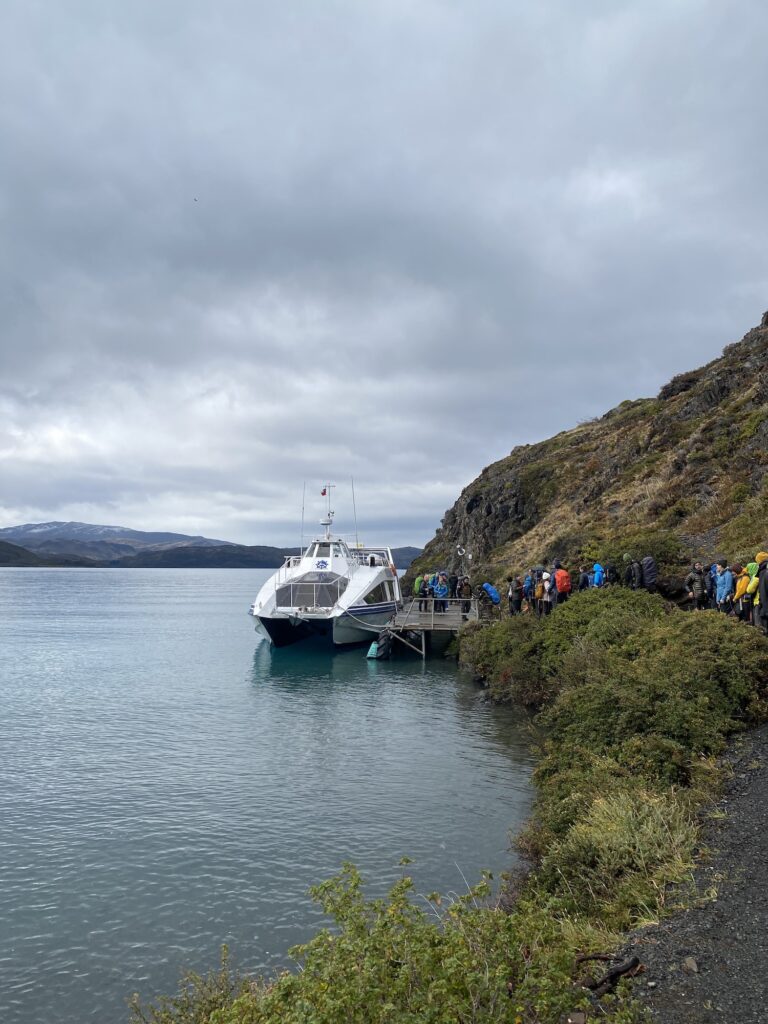
The hike to Grey Lodge is approximately 11 km and offers spectacular views of Lake Pehoé and the surrounding mountains. You’ll pass through enchanting forests and possibly catch a glimpse of local wildlife. Refugio Grey or Camping Grey is your destination for the night, offering stunning lakefront views. You should arrive in the early afternoon, so pitch your tent, meet some other hikers and cook dinner.
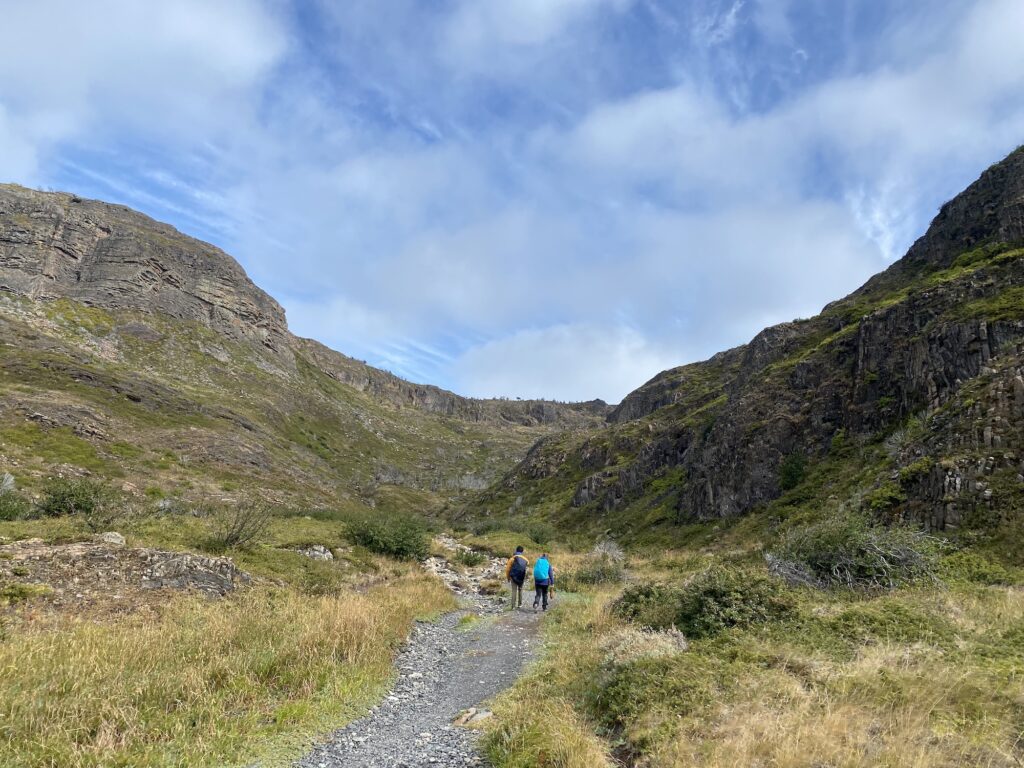
You can also choose to take an optional side trek, by continuing further north past the campsite. An extra 1 km through the forest will bring you to the snout of Grey Glacier, where you will have views of the enormous ice field. A further 2.5km along the path by the edge of the glacier will take you over a series of rope bridges with amazing views. This is about a 1hr round trip.
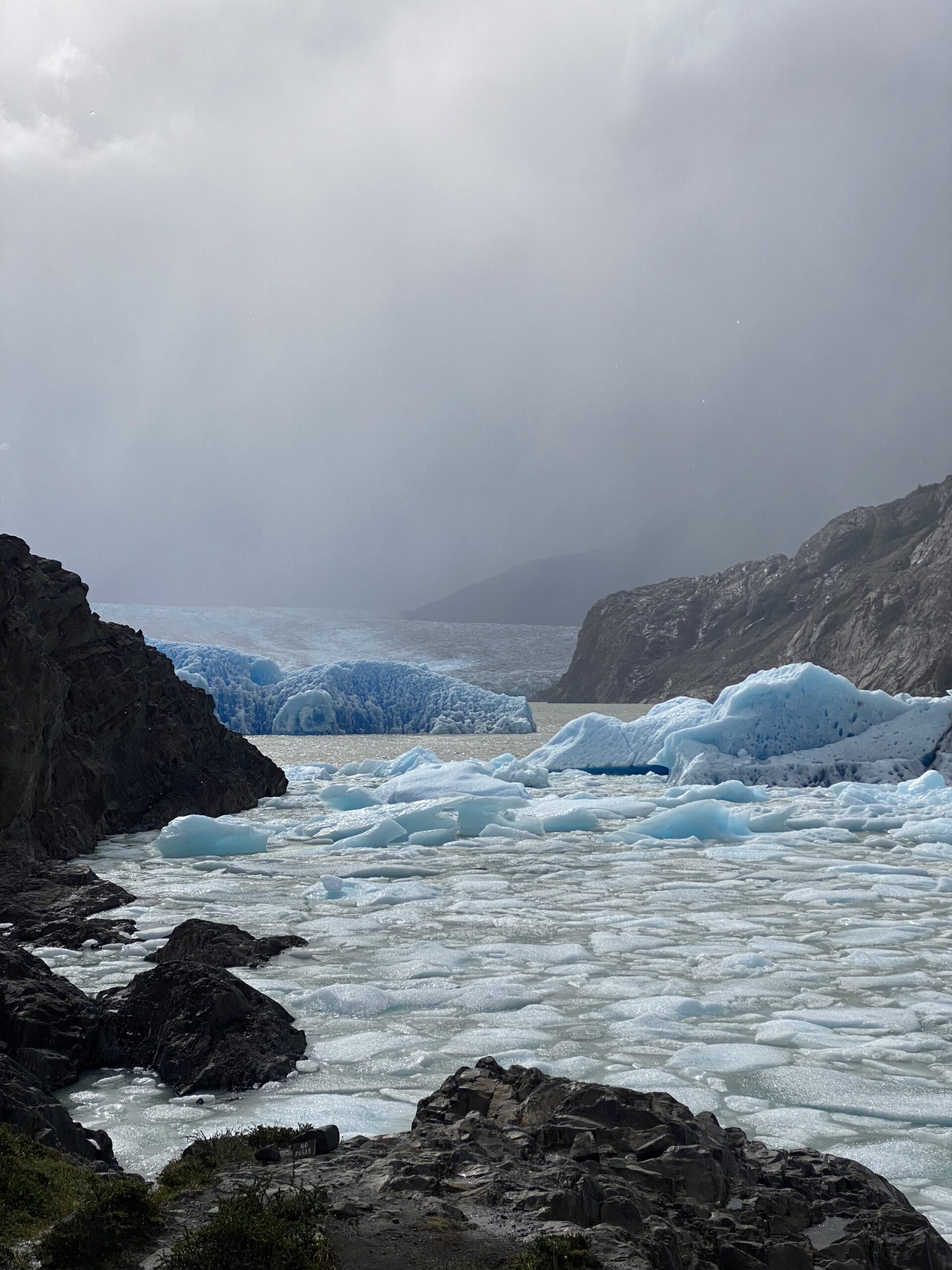
Day 2 (Grey –> Paine Grande)
- Start Point: Grey
- Finish Point: Paine Grande
Today, you’ll retrace your steps back to Paine Grande. The trail is mostly flat or downhill, making for a more relaxed walk. Along the way, you can choose to hike to the hanging bridges for an extra adventure.
Optional Add-On: Grey Glacier Ice Hike
One optional adventure you can undertake on the morning of Day 2 of the W Trek is an ice hike on Grey Glacier . Equipped with crampons and guided by experts, you can venture onto the glacier’s surface, exploring its captivating formations, deep blue crevasses, and surreal ice caves. This excursion provides an up-close encounter with the mesmerising world of glacial ice and a chance to witness the park’s natural wonders from a whole new perspective. It’s an unforgettable addition to your W Trek adventure for those seeking an extra dose of excitement and natural beauty.
Cost: The cost for the ice hike on Grey Glacier can vary, but it’s typically around $150 to $200 USD per person. This fee includes the necessary equipment such as crampons and the guidance of expert glacier guides.
Company: The ice hike on Grey Glacier is organised by Bigfoot Patagonia . This experienced tour provider ensures your safety and provides guidance throughout the excursion.
Duration: The ice hike adventure can take approximately 3 to 4 hours. This allows you to explore the glacier’s stunning features and take in the awe-inspiring surroundings.
Overnight Stay: To partake in the ice hike, it’s recommended to stay overnight at the Grey Lodge or campsite. This is because the ice hike usually takes place early in the morning to ensure the best ice conditions.
Adding the ice hike to your W Trek itinerary can be a memorable and thrilling way to connect with the glacial beauty of Torres Del Paine National Park.
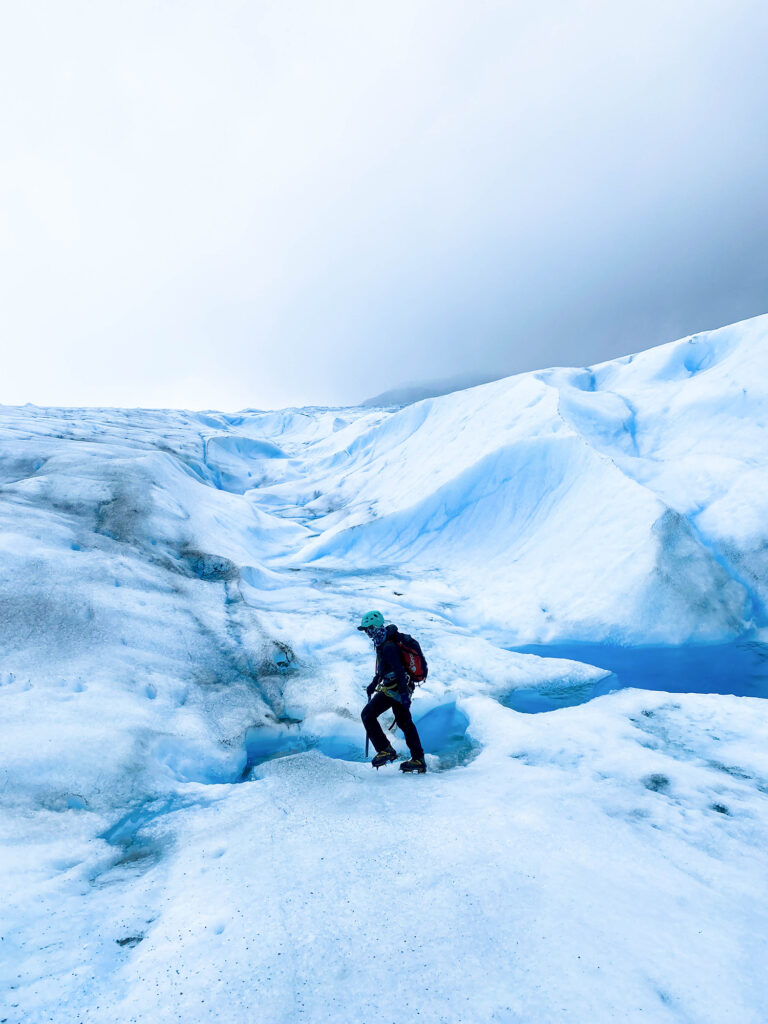
Day 3 (Paine Grande –> Francés/Los Cuernos)
- Total Kilometers: Approximately 21 km
- Estimated Time: 8-9 hours
- Start Point: Paine Grande
- Finish Point: Francés or Los Cuernos
This is a challenging day involving significant elevation gain, but it rewards you with some of the trek’s most stunning vistas. The trail takes you through valleys, along the shores of Lake Nordenskjöld to Guardería Italiano. You can leave your bags here with the ranger before hiking into the Francés Valley.
Hiking through the Francés Valley can vary greatly depending on the ever-changing Patagonian weather. This stretch of the hike marks the central segment of the W, and it’s a relentless uphill journey. After an hour of navigating steep and rocky terrain on a sometimes slippery trail, you’ll arrive at Mirador Francés, where you can catch sight of Glaciar Francés clinging to the western mountainside.
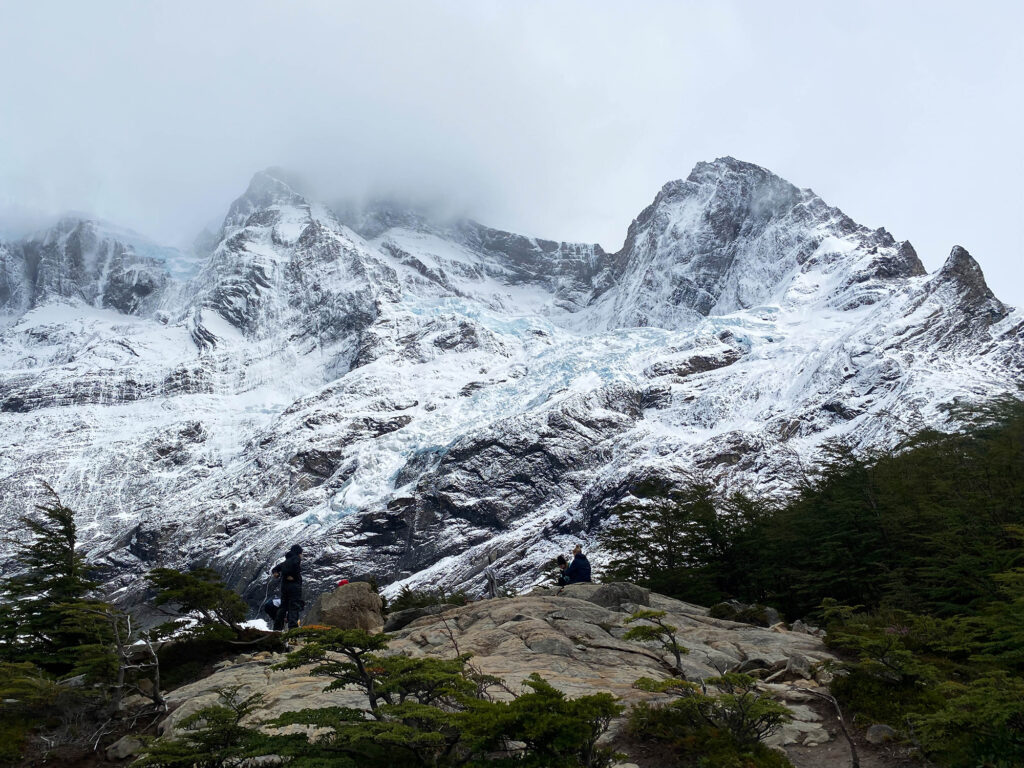
For those feeling especially adventurous and blessed with fair weather, there’s the option to continue ascending to Mirador Británico, adding an extra 3.5 kms each way, roughly three hours for the round trip. At Mirador Británico, you’ll be rewarded with panoramic views of a circle of jagged granite peaks, including the park’s second most famous landmark, the three-horned Cuernos del Paine. This spot ranks among the park’s most breathtaking viewpoints, particularly when the sky is clear. Keep a sharp eye out, as you might even spot the endangered Southern Andean huemul, a rare deer species, in this area.
Thankfully, the return journey is downhill as you make your way back to Campamento Italiano, where you can retrieve your backpack. Continue on for about 30 minutes to stay at Francés. If there is no availability at Francés, you can instead book to stay at Los Cuernos, which is a further 1 hour from Francés.

Day 4 (Francés/Los Cuernos –> El Chileno/Central)
- Total Kilometers: Approximately 15 km
- Estimated Time: 6-7 hours
- Start Point: Francés or Los Cuernos
- Finish Point: El Chileno or Central
The trail from Los Cuernos to El Chileno includes a steady elevation gain throughout the day. You’ll be treated to beautiful river and lake views along the way. As you approach El Chileno, you’ll be surrounded by lush Patagonian forests. Camping and refugio options are available for your overnight stay.

El Chileno is the ideal campsite for Day 4, as it is 4 kms from the Torres del Paine towers. This is important if you want to catch the sunrise at the viewpoint, so you don’t need to wake up so early! If you can’t get a booking at El Chileno, it is possible to hike from Central, but it is an additional 1hr and 45 minutes to reach the towers.
Day 5 (El Chileno/Central –> Torres del Paine –> Puerto Natales)
- Total Kilometers: Approximately 9 km (round trip to Mirador las Torres)
- Estimated Time: 5-6 hours (including time at the viewpoint)
- Start Point: Camping El Chileno or Refugio El Chileno
- Finish Point: Puerto Natales
Rise early to hike the trail to the famous Torres del Paine viewpoint. This is about 4km from El Chileno, meaning you should leave camp about 2hrs before dawn. If you are staying at Central, the hike is about 9km and you should leave camp about 4hrs before sunrise. Make sure you bring a head torch, as the rocky trail will be difficult in the dark. Expect the sun to rise around 7am – but be sure to check with the campground the night before your ascent.
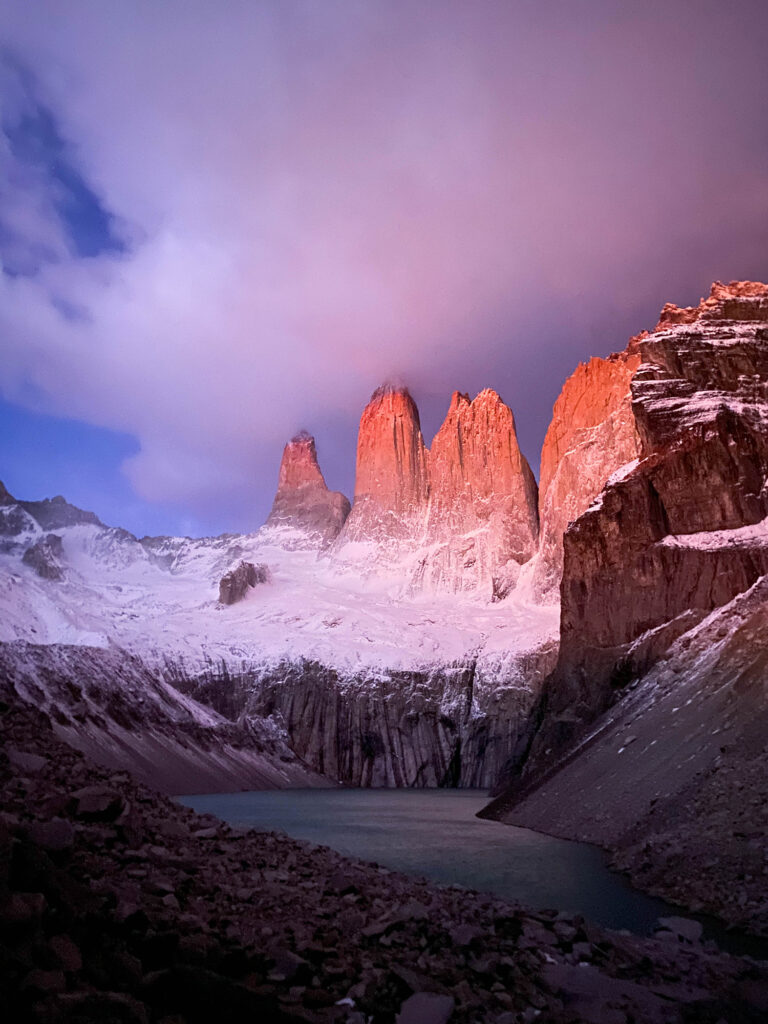
This challenging ascent is rewarded with breathtaking views of the iconic towers. After visiting the towers, descend to Hotel Las Torres. From here, you can take a shuttle bus back to Laguna Amarga for $3,000 pesos, cash only. This is where you get on a bus back to Puerto Natales, completing your W Trek adventure.
How Much Does it Cost to Hike the W Trek Without a Guide?
Before embarking on the W Trek in Torres Del Paine, it’s essential to have a clear understanding of the costs involved. This detailed cost breakdown will help you budget for your adventure effectively:
1. Park Entrance Fee – the park entrance fee for Torres Del Paine National Park varies depending on the season:
- High Season (November to March): Approximately $40 to $50 USD per person.
- Shoulder Season (Late October to early November, late March to early April): Around $20 to $30 USD per person.
- Low Season (April to September): Roughly $10 to $15 USD per person.
2. Transportation:
- Flights: The cost of flights to reach Teniente Julio Gallardo Airport (PNT) in Puerto Natales can vary widely based on your departure location. On average, round-trip flights from Santiago to PNT range from $150 to $300 USD.
- Buses: Bus tickets from Puerto Natales to the park entrance or various points within the park can cost approximately $20 to $50 USD round-trip. You can book tickets from the companies’ offices at the Puerto Natales bus station.
- Pudeto to Paine Grande Ferry: This ferry route is commonly used for the W Trek, and it crosses Lake Pehoé. The cost of the ferry ride can vary, but it was typically around $30 to $40 USD for a one-way ticket. The duration of the ferry ride is relatively short, approximately 30 minutes.
3. Accommodation:
- Camping: Camping fees at the park’s designated campsites typically range from $10 to $20 USD per person per night. These campsites are equipped with facilities such as bathrooms, showers, and cooking areas.
- Refugios: Staying in refugios offers more comfort but comes at a higher cost. The price per night in a refugio can vary between $60 and $150 USD per person, depending on the level of luxury and the time of year. This often includes meals.
- Self-Cooking: If you opt to prepare your meals, you can expect to spend approximately $10 to $20 USD per day on food. This estimate includes purchasing supplies in Puerto Natales before your trek.
- Meals at Refugios: Dining at refugios can be convenient, but it’s also more expensive. An average meal at a refugio restaurant can cost anywhere from $15 to $30 USD. Keep in mind that some refugio packages include meals.
5. Gear Rental:
- If you need to rent gear such as tents, sleeping bags, or hiking equipment, budget an additional $20 to $40 USD per day, depending on the items you require.
Please note that these cost estimates can vary based on individual preferences, the exchange rate, and any special promotions or discounts available at the time of booking. It’s advisable to check current prices and plan your budget accordingly to ensure a worry-free W Trek experience. Additionally, consider carrying some extra cash for unexpected expenses or emergencies during your journey.
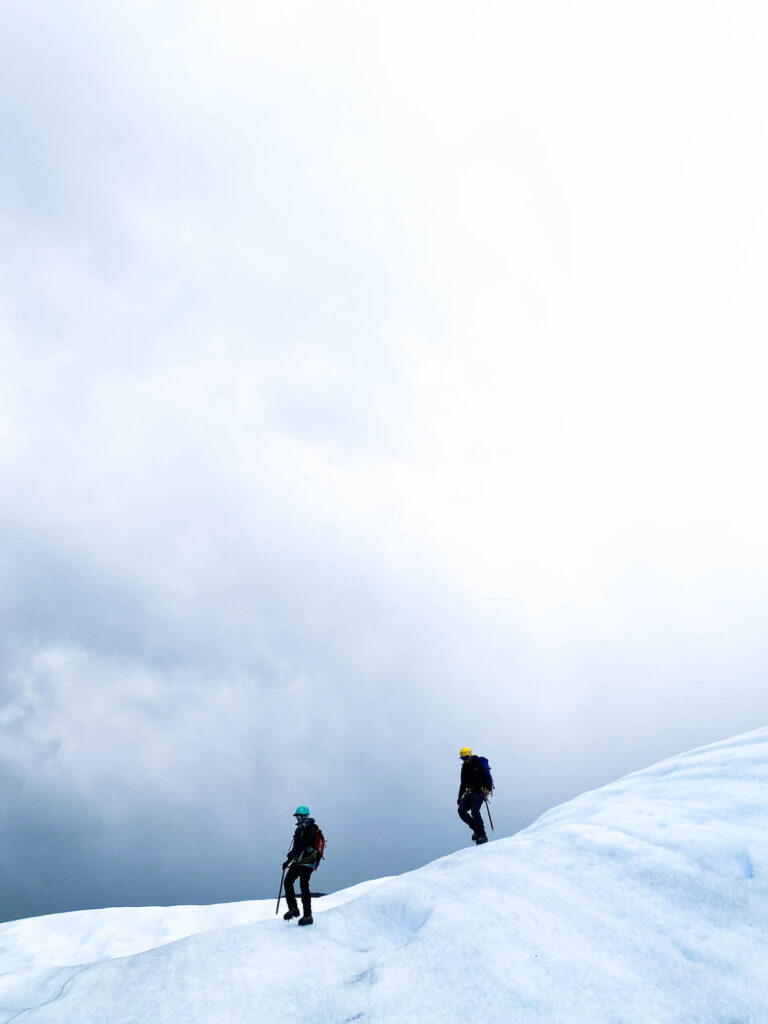
Hiking the W Trek Independently vs With a Guide
Deciding whether to embark on the W Trek independently or with a guide is a significant choice, and it largely depends on your preferences, experience, and what kind of adventure you seek. Below, we delve into the pros and cons of both options to assist you in making an informed decision:
Hiking Independently:
- Flexibility: Independence grants you the freedom to set your pace, choose your daily itinerary, and make spontaneous decisions along the way. You have full control over your adventure.
- Cost-Effective: Independent trekkers often find it more budget-friendly, especially when it comes to accommodations. You can opt for camping and self-cooked meals to save money.
- Personal Connection with Nature: Solitude in the wilderness can provide a deeper connection with the natural surroundings and a more profound sense of adventure.
- Adventure of Self-Reliance: Successfully navigating the W Trek independently can be immensely rewarding, boosting your self-confidence and outdoor skills.
- Logistical Challenges: Planning and booking accommodations, transportation, and permits can be time-consuming and occasionally frustrating, especially during peak seasons.
- Navigation: You must rely on your navigation skills and research to stay on the right path, which can be challenging in the ever-changing Patagonian weather.
- Safety Considerations: Solo travellers should be well-prepared for emergencies and have basic wilderness first aid knowledge.
Hiking the W Trek with a Guide
- Expert Guidance: Guides are experienced and knowledgeable about the trail, local wildlife, and weather patterns. They can enhance your understanding and appreciation of the environment.
- Safety Assurance: With a guide, you have a safety net. They can provide assistance in emergencies, navigation, and first aid.
- Group Camaraderie: Joining a guided tour allows you to meet like-minded adventurers and share the experience, making it a social and potentially less solitary journey.
- Simplified Logistics: Many logistical aspects, such as accommodations and permits, are often handled by the guiding company, reducing your planning burden.
- Cost: Guided tours can be more expensive due to the added services and expertise provided.
- Less Independence: Your schedule and daily activities are often predefined, leaving less room for spontaneity.
- Group Dynamics: Group tours may vary in size and composition, and you might not always have full control over the pace or itinerary.
In conclusion, the choice between hiking the W Trek independently or with a guide is a matter of personal preference and what aligns with your goals for the journey. Consider your budget, level of outdoor experience, desire for flexibility, and your comfort with navigating the trail. Both options offer unique advantages, and the W Trek promises an unforgettable adventure, regardless of the path you choose.

Trek Highlights and Scenic Spots
The W Trek in Torres Del Paine National Park is a visual symphony of natural wonders. Each leg of the journey unveils a new chapter in this captivating wilderness narrative. Here, we delve into the breathtaking highlights and scenic spots that await you:
1. Torres Del Paine – The Crown Jewels:
- Iconic Towers: No visit to Torres Del Paine is complete without witnessing the park’s namesake – the monumental Torres Del Paine. These three towering granite peaks, sculpted by the forces of nature, rise majestically against the Patagonian sky. The sight of the Torres, especially during sunrise or sunset, is a moment that etches itself into your memory forever.
2. Spectacular Valleys:
- French Valley (Valle del Francés): This emerald green valley enchants with its hanging glaciers, colossal rock faces, and panoramic vistas. Hiking through the French Valley feels like stepping into a postcard, surrounded by nature’s grandeur from every angle.
3. Lush Forests:
- Patagonian Wilderness: The W Trek meanders through pristine Patagonian forests, where moss-covered trees, vibrant lichens, and unique flora create a rich tapestry of greens. Walking amidst these ancient trees evokes a sense of timelessness.
4. Azure Lakes:
- Lago Pehoé and Lago Nordenskjöld: These crystal-clear lakes reflect the azure sky and surrounding peaks like mirrors. Their beauty is not only in the vibrant blue hues but also in the tranquility they offer. Pause by their shores and feel the serenity wash over you.
5. Glacier Grey:
- Glacial Majesty: Glacier Grey is a spectacle of ice and light. As you approach its shimmering blue face, you’ll be captivated by the sheer size and beauty of this ancient ice giant. The viewpoint offers an up-close encounter with one of Patagonia’s most remarkable glaciers.
6. Flora and Fauna Encounters:
- Wildlife: Keep a watchful eye for the diverse Patagonian wildlife. Guanacos, foxes, condors, and even the elusive puma inhabit these lands. Birdwatchers will be delighted by the variety of avian species that call this region home.
7. Mirador Cuernos:
- Cuernos Lookout: This viewpoint provides a mesmerising panorama of the iconic Cuernos del Paine, the horn-like peaks that define the landscape. It’s a place to pause, take in the surroundings, and appreciate the rugged beauty of Patagonia.
8. Southern Patagonian Ice Field:
- Distant Giants: While not part of the W Trek itself, the view of the Southern Patagonian Ice Field from certain points along the trail is awe-inspiring. Witness this vast expanse of ice, where countless glaciers originate, and feel the enormity of the natural forces at play.
The W Trek is a mesmerising journey through a pristine wilderness that will leave you humbled by nature’s artistry. Each of these highlights adds a unique stroke to the masterpiece that is Torres Del Paine National Park. Whether you’re an avid photographer, a nature enthusiast, or simply seeking serenity in the wild, the W Trek has something extraordinary to offer at every turn.
Booking the W Trek and Practical Information
Embarking on the W Trek adventure requires meticulous planning, from securing permits to arranging transportation. Here, we delve into the practical details you need to know to ensure a seamless journey through Torres Del Paine National Park:
1. Permits and Excursions:
- Booking Your Trek: The W Trek is in high demand, especially during the peak season (November to March). You must secure your accommodations and camping permits in advance. Remember that the campsites and refugios are operated by two different companies, Vertice and Fantastico Sur. Each has its own booking system, so it’s crucial to book dates that align with your itinerary. Start the booking process as early as possible, as securing the exact dates you need can be challenging.
- Excursions: If you’re interested in guided excursions or activities within the park, such as glacier hikes or boat trips, it’s advisable to book these in advance as well. This ensures you don’t miss out on the experiences that enhance your W Trek adventure.
2. Timetables for Buses and Park Entrance Tickets:
- Getting to Puerto Natales: To reach the starting point of the W Trek, you’ll likely fly into Santiago and then take a flight to Teniente Julio Gallardo Airport (PNT) in Puerto Natales. A 10-minute taxi ride will transport you from the airport to the downtown area, where most accommodations are situated. It’s recommended to spend a night in Puerto Natales to stock up on supplies before heading to the national park.
- Buses to the Park: From Puerto Natales, you’ll need to take a bus to Torres Del Paine. Various bus companies, such as Buses Fernandez, operate this route. Ensure you purchase your bus tickets in advance, particularly if you plan to catch an early morning departure. Timetables can vary, so check the schedules well in advance to align them with your trekking itinerary.
- Park Entrance Tickets: You’ll need to pay an entrance fee to access Torres Del Paine National Park. These tickets can be purchased at the park entrance or online. Having your entrance tickets ready in advance will save you time and streamline the process when you arrive.
3. Equipment and Supplies:
- Gear Checklist: Ensure you have all the necessary gear for your trek, including camping equipment, clothing layers, hiking boots, and more. Refer to the packing essentials section for a comprehensive checklist to make sure you’re well-prepared.
4. Safety and Emergency Contacts:
- Emergency Preparedness: While the W Trek is a stunning adventure, it’s essential to prioritise safety. Familiarise yourself with emergency contacts and park regulations before setting out. Have a plan for communication and emergency situations.
5. Accommodation Flexibility:
- Last-Minute Options: While booking accommodations in advance is wise, some refugios may have last-minute availability for hikers. Keep this in mind if your plans are flexible, but don’t rely on it entirely, especially during peak seasons.
Navigating the logistics of the W Trek ensures that your adventure unfolds smoothly, allowing you to focus on the awe-inspiring landscapes and experiences that await you. By planning ahead, you’ll maximise your enjoyment and make the most of your journey through the pristine wilderness of Torres Del Paine.
In conclusion, embarking on a solo adventure along the W Trek in Torres Del Paine, Chile, is a remarkable experience that will leave you with memories to last a lifetime. By planning carefully, packing smartly, and embracing the breathtaking beauty of Patagonia, you’ll embark on an unforgettable journey that showcases the very best of nature’s wonders.
To hike the W in Torres del Paine, plan your itinerary, book accommodations, and obtain permits in advance. Start from either the east or west side, following well-marked trails and taking in the breathtaking landscapes along the way.
Yes, you can definitely hike the W Trek without a guide. Many solo hikers and groups explore the trail independently. The trail is well marked and sign-posted the whole route. Just be sure to plan and prepare well, including booking accommodations and permits in advance. If you are new to hiking and camping, consider hiking the W Trek with a guide or group.
No. Camping in Torres del Paine is restricted to designated campgrounds. This means there is no free camping. The purpose is to minimise the environmental impact and reduce the risk of fires, which have previously ravaged significant portions of the park, covering approximately 17,000 hectares (41,000 acres) or 7% of its total area.
The duration of the W Trek can vary depending on your pace and itinerary. On average, hikers complete the W circuit in 4 to 6 days. It’s a flexible trek that allows you to choose your route and pace.
While it’s technically possible to complete the W Trek in 4 days, it would be a very strenuous and rushed experience. Most hikers opt for a 5-day itinerary to fully enjoy the trek and its stunning landscapes. A 4-day trek would require covering significant distances each day.
The difficulty of the W Trek varies, but it’s generally considered a moderate hike. It involves steep ascents and descents, variable weather conditions, and covering significant distances. Being physically prepared and having the right gear is essential.
To start the W Trek, you’ll typically fly to Santiago, then catch a flight to Puerto Natales, the gateway to Torres Del Paine National Park. Spend a night in Puerto Natales to stock up on supplies before heading to the park.
Charging facilities are available at some refugios and campsites along the W Trek, but they may be limited. It’s advisable to bring a portable power bank to ensure you can keep your devices charged throughout the trek.
The best months to hike Torres del Paine are during the shoulder seasons of late October to early November and late March to early April. These periods offer milder weather and fewer crowds. However, if you prefer vibrant spring or summer landscapes, consider the peak season from November to March.
Absolutely! The W Trek is worth it for its stunning natural beauty, iconic landmarks like Torres Del Paine, and the sense of adventure it offers. It’s a memorable experience for nature enthusiasts and hikers.
Yes, you can find water sources along the W Trek route. It’s essential to bring a water purification filter or water purification tablets to ensure the water is safe to drink from streams and rivers.
For the W Trek, it’s essential to bring lightweight, high-energy, and non-perishable foods. Consider items like energy bars, nuts, dried fruits, instant oats, pasta, dehydrated meals, and freeze-dried options. Make sure to pack foods that are easy to prepare on camping stoves and provide the necessary nutrition for your journey. Additionally, you can purchase some supplies at refugios along the trail if needed.
While some places in Torres del Paine accept credit cards, it’s advisable to carry some cash. Cash can be useful in case you encounter places that don’t have card payment facilities, or when reception in the park is not working. You will also need cash for the boat from Pudeto to Paine Grande.
Yes. There are well-maintained toilets at each campsite along the W Trek.
Torres del Paine can be relatively expensive due to park entrance fees, accommodation costs (especially in refugios), and dining options. However, there are ways to manage costs, such as camping and preparing your own meals if you’re on a budget.
Some of the best parts of the W Trek include witnessing the iconic Torres Del Paine towers, exploring spectacular valleys, hiking through lush forests, and marveling at crystal-clear lakes that dot the landscape.

Lucas is a travel writer with deep experience exploring South America. He enjoys hiking through mountain ranges, cycling across deserts and paddling down rivers.
Best Food in Puerto Natales: 17 Top Restaurants & Cafes
Backpacking packing list: what to pack for a backpacking trip in 2023, get our best tips direct to your inbox.

The W Trek in Torres del Paine National Park- How to Do the W Trek as Day Hikes
Purchases made through links earn us a small commission, at no extra cost to you.
Torres del Paine National Park, in Chilean Patagonia, is an incredible destination for day hiking and overnight treks. One of the park’s most famous routes is the W Trek, a 4-5 day hike that visits three stunning valleys with overnight stays in refugios or campsites.
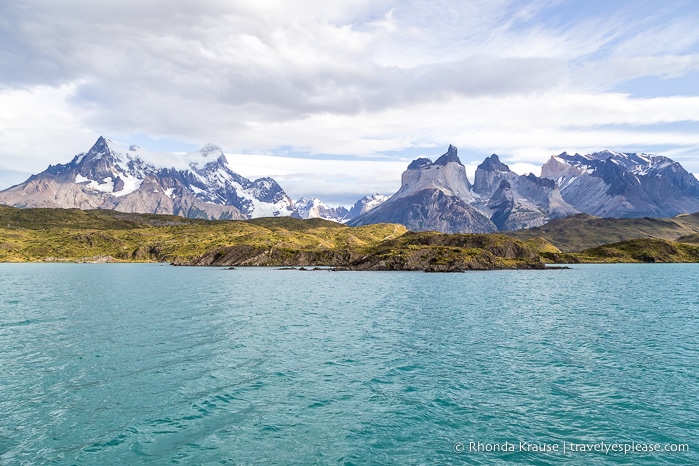
If a multi-day backpacking trip doesn’t appeal to you, the good news is that you can do most of the W Trek as day hikes and still see all the main highlights.
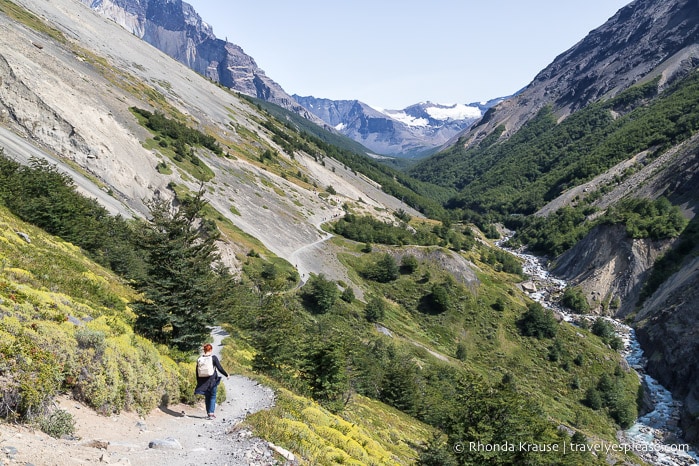
Why Do the Torres del Paine W Trek as Day Hikes?
The main reasons to do the W Trek as day hikes is to save time, save money on a tour, and avoid some of the headaches that come with planning and embarking on a multi-day trek, namely having to carry more gear and figure out trail accommodations in advance.
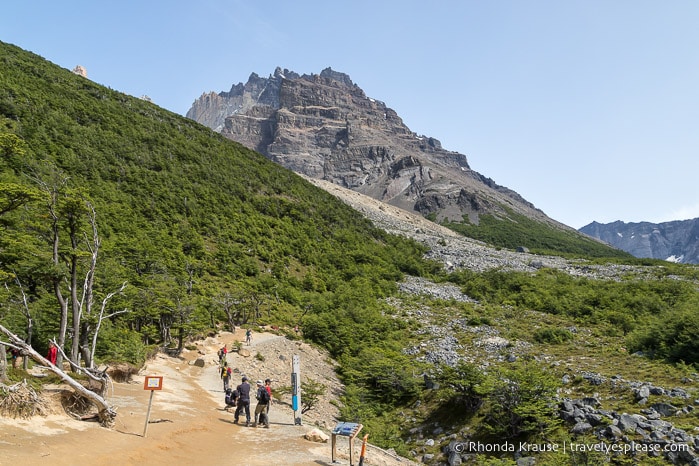
We really wanted to hike the W in Torres del Paine, but I quickly realized during the planning phase that the classic route wasn’t going to work for us.
First of all, we didn’t have 4 or 5 days to dedicate to the hike since we wanted to visit other places during our Patagonia trip . By doing day hikes in Torres del Paine National Park, we could explore all the arms of the W and one of the connecting trails in 3 days.
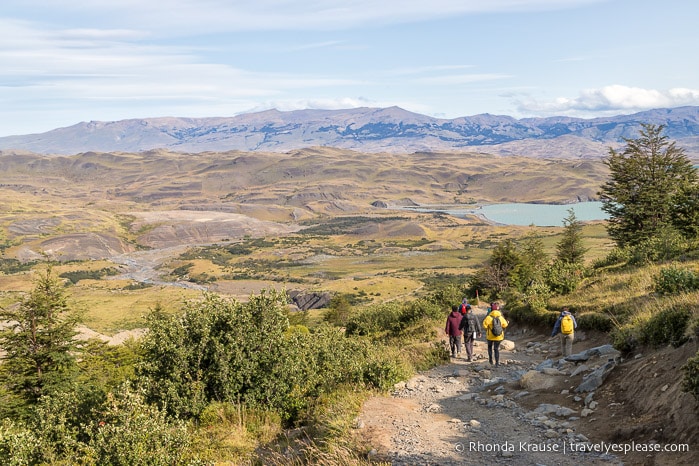
Second, to do a self-guided W Trek we would need to carry more gear, plus reserve all our campsites or shelters months in advance. These were logistics I just didn’t want to deal with.
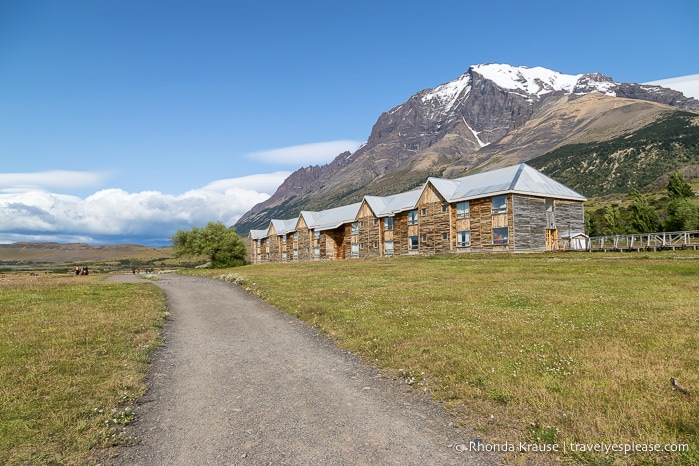
Our last option was to book a guided tour, but we didn’t have the budget for that since we had just returned from a cruise to Antarctica and South Georgia .
So as an alternative, I figured out a way to experience all the best parts of the W Trek on day hikes, returning to our accommodations at the southern edge of the park each night.
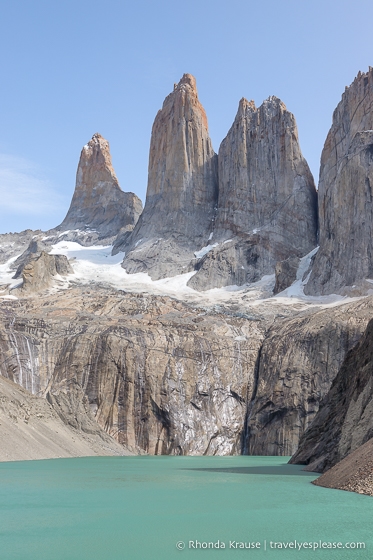
About the W Trek- The Classic Route vs Day Hikes
Just like the name suggests, the W Trek forms a round-bottomed W when looking at the route on a map.
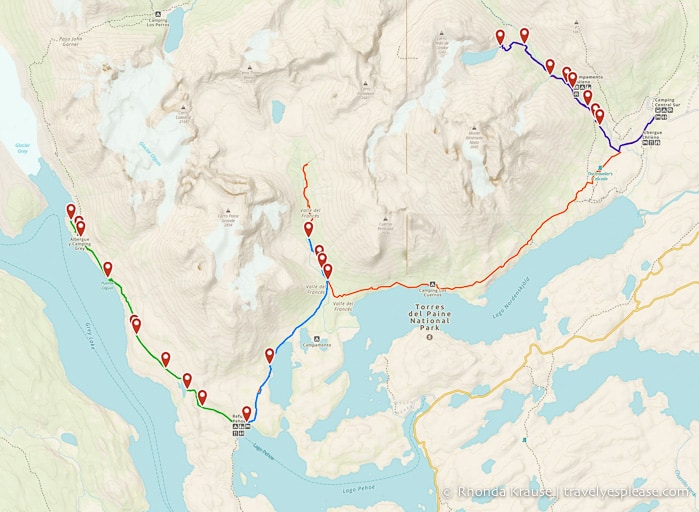
The eastern arm of the W is formed by a trail that leads through the Ascencio Valley to Mirador Base de las Torres, a lookout at the park’s iconic granite peaks. This segment is an out and back hike regardless if you’re doing the full W Trek or the day hike option.
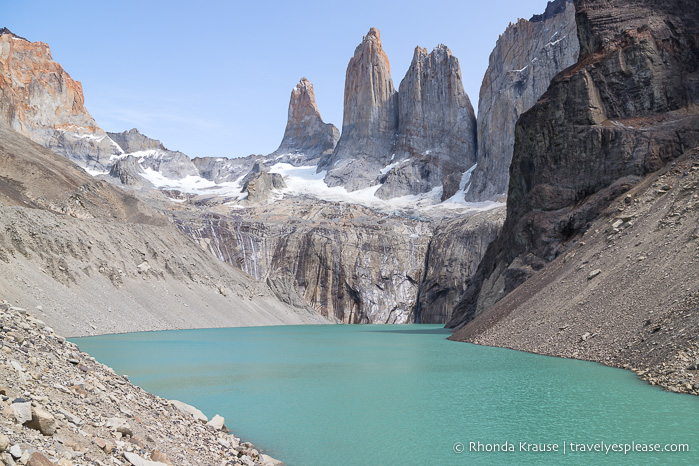
The trail that connects to the middle arm of the W follows along the shoreline of Lago Nordenskjold until it reaches the entrance to the French Valley. On the classic W Trek this segment is a one-way hike, but if you’re doing the W Trek day hikes it would be a very long out and back to go the full length of the trail (at least 11- 12 hours).
Since we only had 3 days to do day hikes in Torres del Paine National Park, and the Lago Nordenskjold trail didn’t offer anything unique that we couldn’t experience on the other legs of the W, we cut out this section entirely.
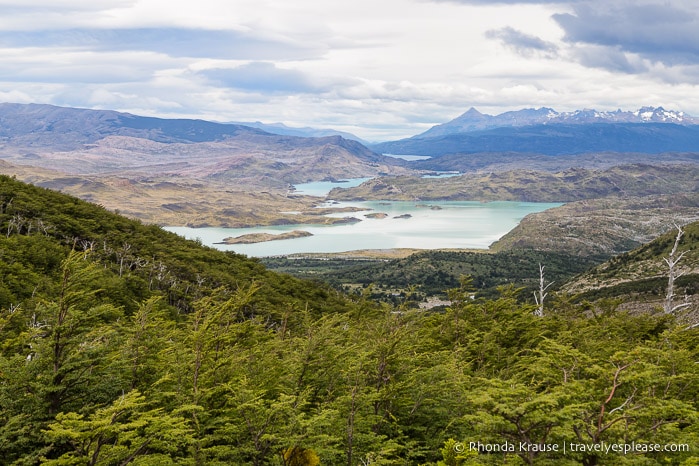
The middle arm of the W consists of the French Valley and offers great views of the French Glacier on route to Mirador Britanico. On the classic W Trek you would have enough time to hike the whole out and back trail to Mirador Britanico, but if doing the W Trek day hikes you will have to turn around at the glacier.
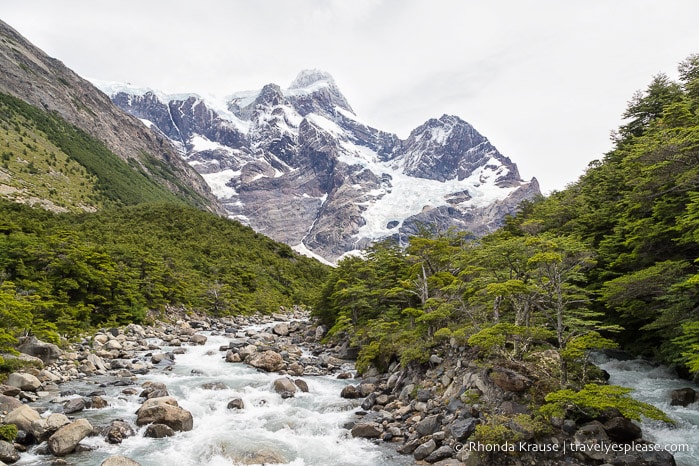
The trail that connects the French Valley to the western arm of the W runs alongside Lago Skottsberg. On the W Trek this is a one-way hike, but for a day trip it would be an out and back. Since the W is typically hiked from east to west, the best views of Cuernos del Paine (Paine Horns) would be at your back during this section, but on the day trip this distinctive mountain is in your line of sight.
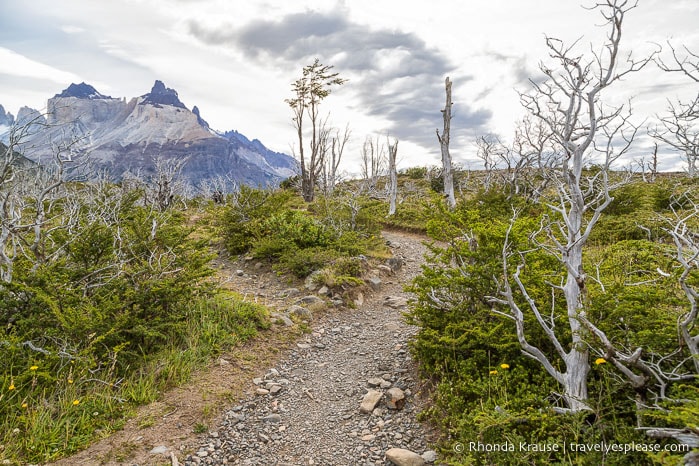
The western arm of the W leads from Lago Pehoe to Grey Glacier, roughly following the shoreline of Lago Grey. On the self-guided W Trek this is commonly done as an out and back route, but on guided hikes/tour packages it’s usually a one-way journey (returning via ferry on Lago Grey). For the day hike option, it’s best done as an out and back due to a lack of public transportation from the Lago Grey ferry to the hike’s starting point.
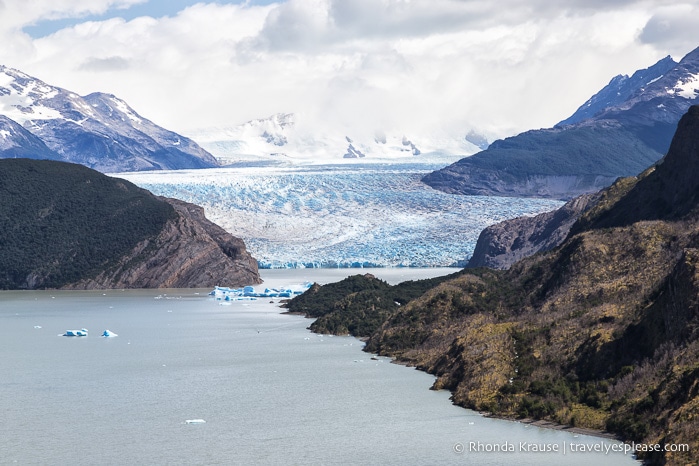
How to Do the W Trek as Day Hikes- 3 Amazing Day Hikes in Torres Del Paine National Park
We did 3 day hikes in Torres del Paine National Park that visited all the most iconic landmarks of the W Trek.
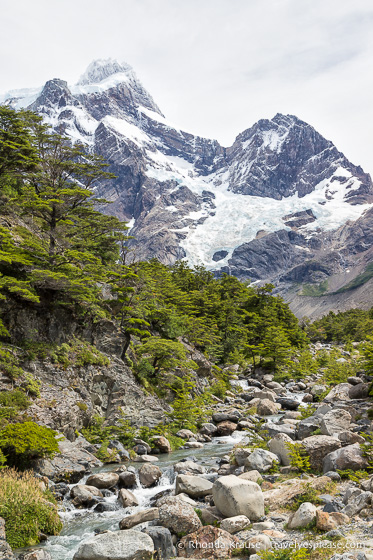
In order to accomplish this, you have to be staying in or near the park and have a vehicle. A lot of people travel to Torres del Paine by bus from Puerto Natales, but this adds 2-3 hours of travel time each way and you wouldn’t catch the first ferry across Lago Pehoe, which takes you to the trailhead for two of the hikes. Without getting on that first ferry, completing the full hikes in time for the last return ferry would be very challenging, if not impossible.
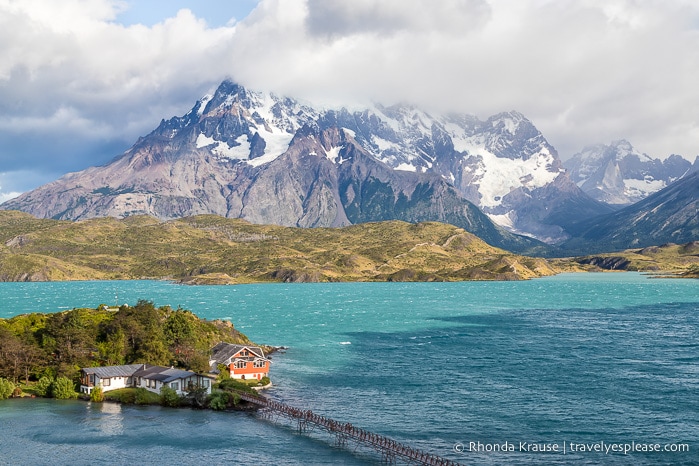
Since the W Trek is normally walked from east to west, we did our day hikes the same way. Starting with the eastern arm of the W means you’ll do the most difficult hike of the trek first. However, you’ll want to keep weather in mind when deciding the order of your day hikes. Definitely plan to hike to Mirador Base de las Torres on a clear day otherwise you might not get a complete view of the famous towers.
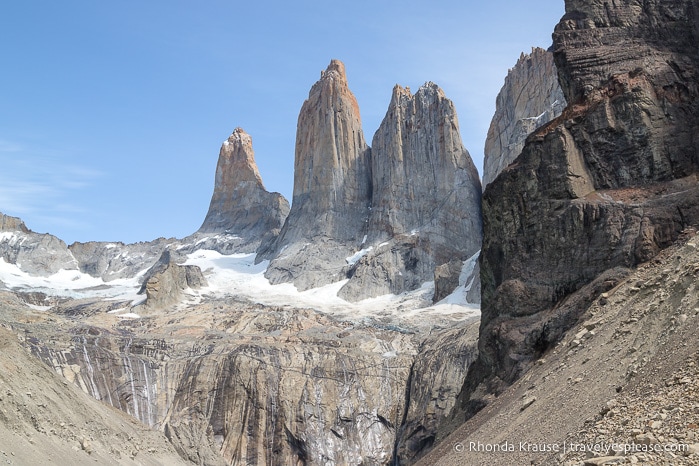
Here’s a brief description of the segments of the W Trek we did as day hikes, our recorded distances, and links to our more detailed trail guides/trip reports.
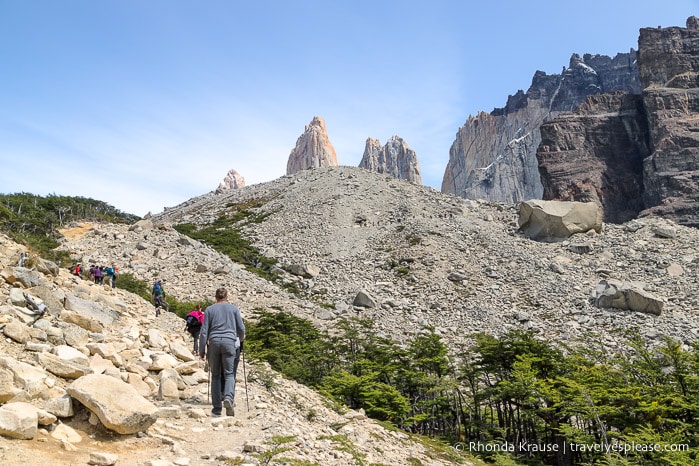
Day Hike #1: The Towers
Distance : 20.7 km/12.86 mi
Time Required : 8- 10 hrs
Trail Guide: Mirador las Torres- Hiking to the Base of the Towers in Torres del Paine National Park
The hike to Mirador Base de las Torres is the most popular hike in Torres del Paine National Park and most grueling leg of the W Trek.
The hike starts at the Torres del Paine Welcome Centre and follows a trail through a valley and up some very steep terrain to a teal coloured lake at the base of Torres del Paine, the towers from which the park takes its name.
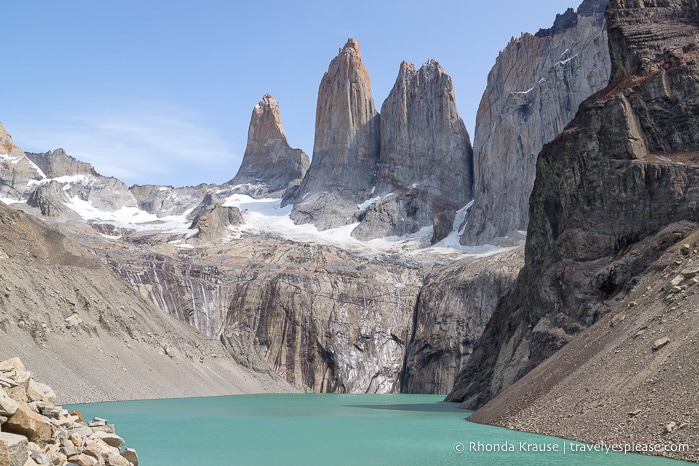
After leaving the Welcome Centre and passing by Hotel Las Torres, the trail descends towards a river then begins climbing into the scenic Ascencio Valley. During the hike through the valley you’re surrounded by mountains and overlooking the Ascencio River.
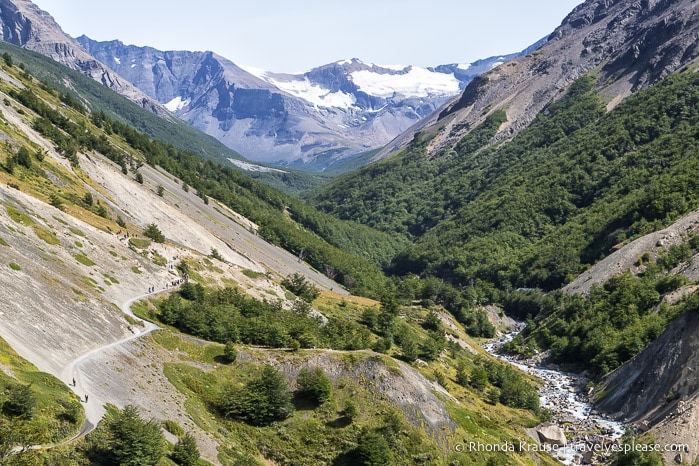
At the bottom of the valley you’ll reach refugio Chileno where you can take a break, fill up with water, and use the toilets.
The trail then proceeds through the forest before arriving at a steep pile of boulders that you have to climb to reach the lookout.
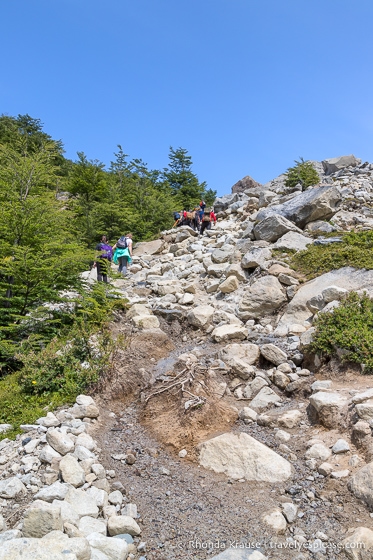
This last section can be very windy and hazardous because of the rocky trail you have to navigate.
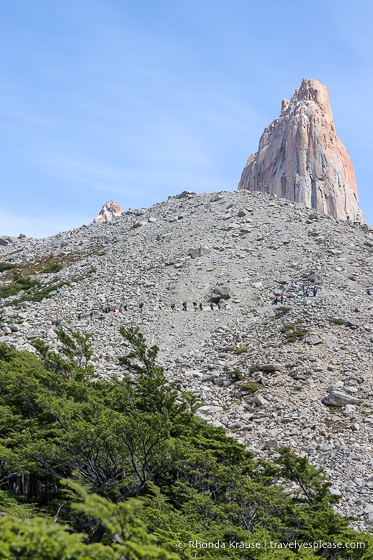
Once you reach the top of the rock pile you’ll see the three distinctive towers overlooking a small, mountain-framed lake. Take some time to relax and enjoy the views from the boulder-covered shoreline before returning the way you came.
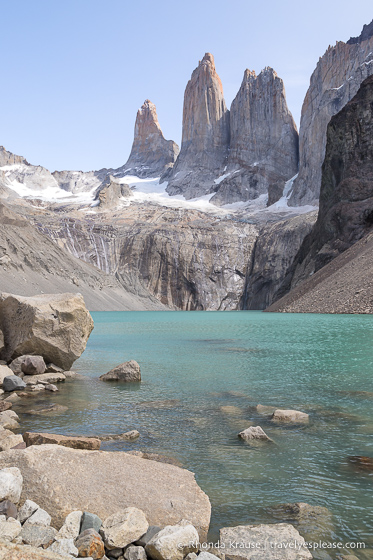
Day Hike #2: The French Valley
Distance : 18.5 km/11.5 mi
Time Required : 7- 8 hrs
Trail Guide: French Valley Day Hike- Hiking to Mirador Frances in Torres del Paine National Park
The hike to the French Valley was our favourite leg of the W Trek because it’s packed with beautiful scenery and is only moderately difficult.
The trail begins at the Paine Grande refugio and passes by two pretty lakes on route to the French Valley, where it then ascends to a viewpoint across from the French Glacier.
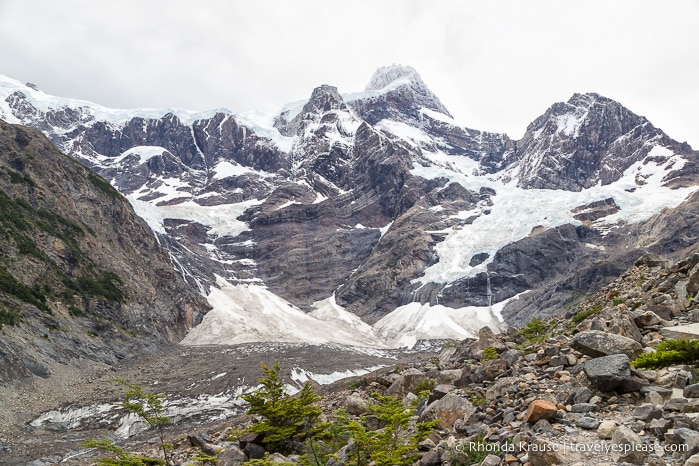
To reach the French Valley on a day hike, you first have to take a ferry across Lago Pehoe from Cafeteria Pudeto to the Paine Grande refugio.
After leaving the refugio, the trail follows alongside the shoreline of Lago Pehoe then changes course to traverse an area of shrub-covered rolling hills. Once you reach Lago Skottsberg there’s a nice viewpoint overlooking the lake where you can admire Cuernos del Paine.
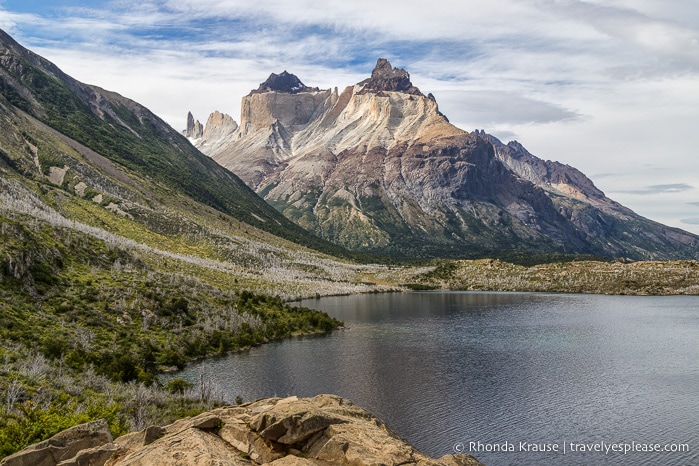
The trail continues beside Lago Skottsberg then eventually arrives at a small suspension bridge crossing Rio Frances. On the other side of the bridge is the Italian Camp at the entrance to the French Valley.
The last part of the hike follows a rocky trail to Mirador Glaciar del Frances then climbs through the forest to Mirador Frances, across from the French Glacier.
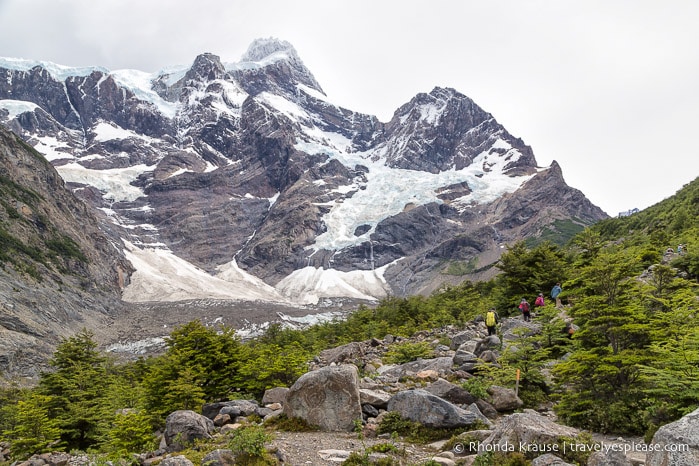
Both the lower and upper lookouts offer stunning views of the French Glacier, so even if you only hike to the first viewpoint you’ll still get to experience the beauty of the glacier.
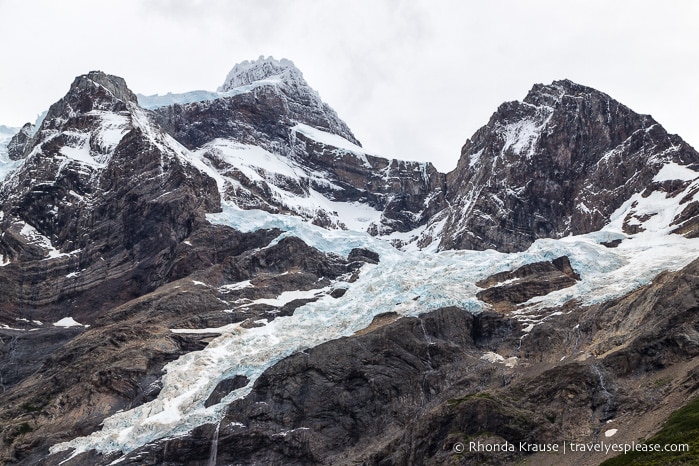
In order to catch the last return ferry of the day, you won’t be able to hike to the end of the trail at Mirador Britanico. Instead, turn around at Mirador Frances and retrace your steps back to the trailhead at Lago Pehoe.
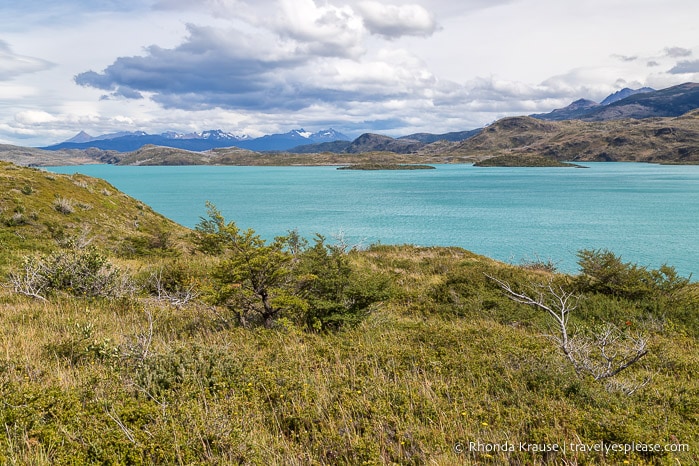
Day Hike #3: Grey Glacier
Distance : 22.9 km/14.2 mi
Trail Guide: Grey Glacier Day Hike- Hiking to Grey Glacier in Torres del Paine National Park
The hike to Grey Glacier is the least trafficked trail by day hikers, perhaps because it’s the most ambitious, in terms of distance, of the W Trek day hikes.
The hike starts at the Paine Grande refugio and follows a trail through a valley to Lago Grey, then Grey Glacier at the far end of the lake.
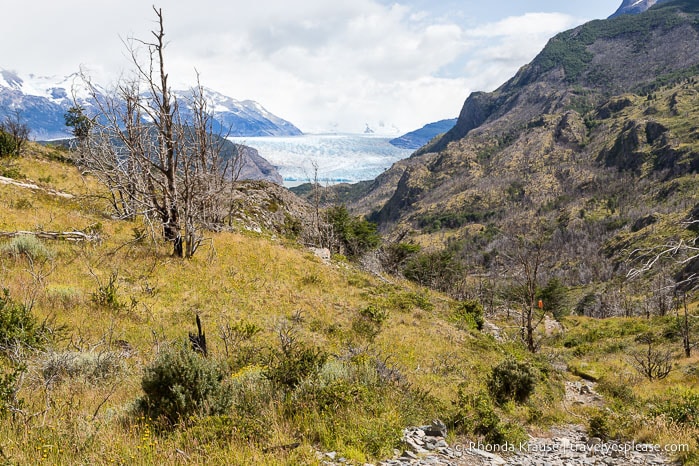
To reach the trailhead, you again have to take the Lago Pehoe ferry from Pudeto to the Paine Grande refugio.
The first portion of this hike passes through a valley, gradually gaining elevation until the trail arrives at Laguna Los Patos. The path then follows the lakeshore before travelling through an open area of land that overlooks Lago Grey. You’ll be able to see small icebergs floating in the lake below.
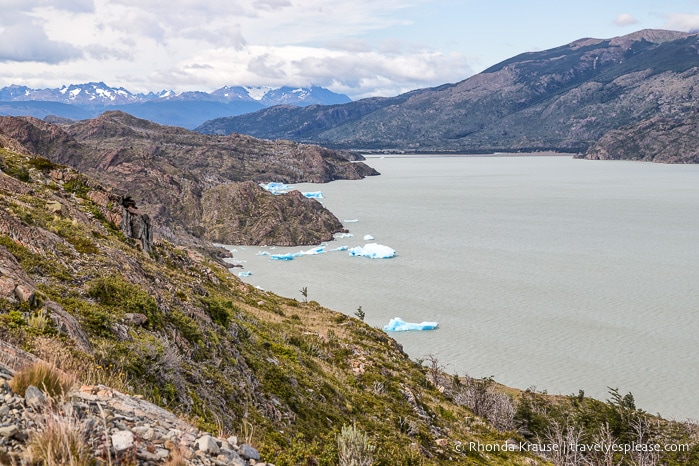
Continuing to hike above the lake, the trail eventually starts climbing up towards Mirador Lago Grey. The top of the hill is a great place to stop and rest because there’s a wonderful view of Grey Glacier in the distance. This is also the point where you need to assess if you’ll have enough time and energy to get to the end of the trail and back in time for the last ferry to Pudeto.
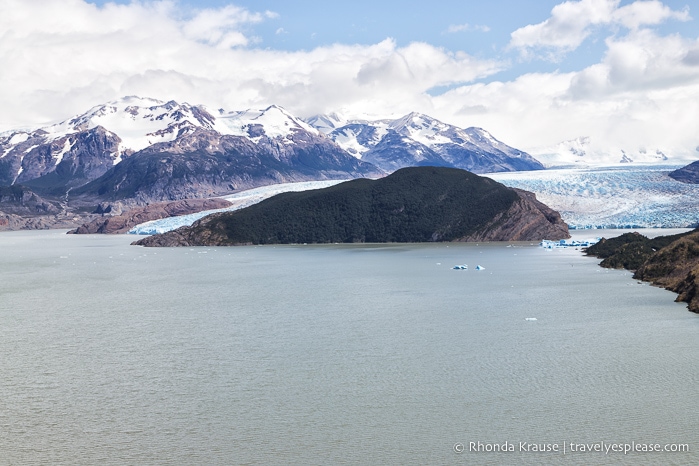
Beyond the viewpoint the trail makes a long, steep descent towards the glacier. After some time hiking in the trees, you’ll pass by Refugio Grey and then arrive at a viewpoint near Grey Glacier. After enjoying the scenery, head back on the same trail to return to the ferry dock.
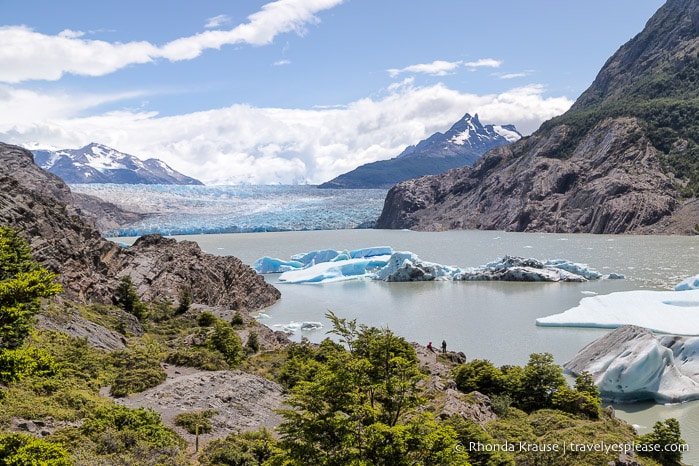
Final Thoughts About the Torres del Paine W Trek Day Hikes
We loved day hiking in Torres del Paine National Park and didn’t feel like we missed out on anything by not doing the full W Trek. Since we were more interested in the hiking and sights than the camping or hostel experience, the way we chose to explore the W gave us the adventure we were hoping for.
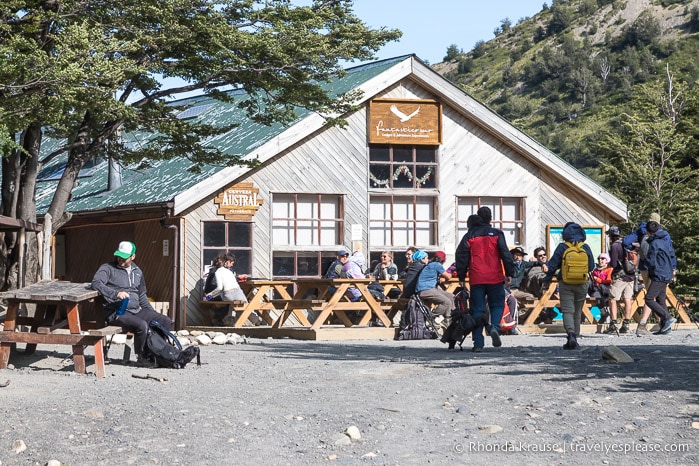
By doing the W Trek as day hikes, we got to see all the most significant landmarks without having to carry a huge pack. Every time I passed a tired looking backpacker I was thankful we weren’t burdened by a lot of gear. The only stress we had was making sure not to miss the last ferry of the day, which was really only a concern on the hike to Grey Glacier.
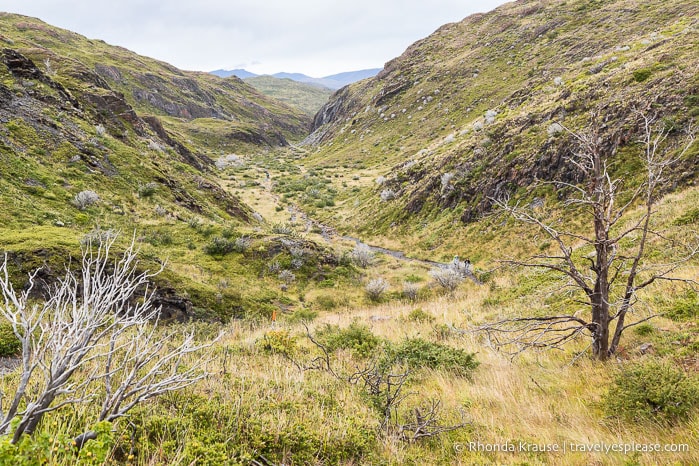
The one downside to doing the W Trek as day hikes was that the Lago Pehoe ferry tickets were expensive. We each had to buy 4 tickets (2 per day x 2 days), and at $35 US or $23,000 CLP a ticket, it added up!
Regardless of the ferry price, we still had an unforgettable experience and wouldn’t change a thing. There’s no doubt that the W is made up of three of the best day hikes in Torres del Paine National Park!
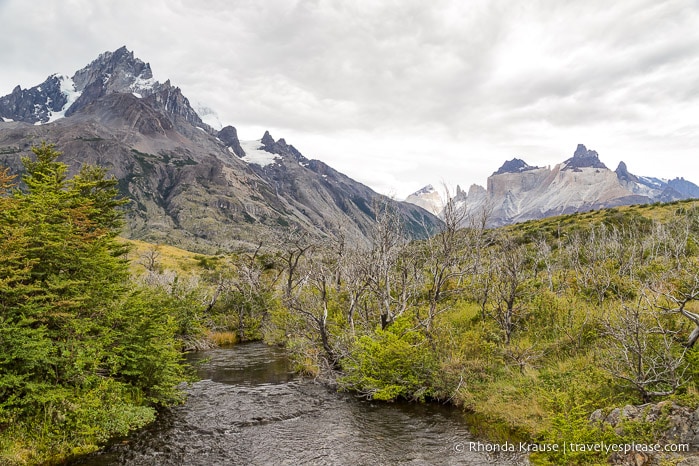
Tips for Doing the W Trek Day Hikes in Torres del Paine National Park
Time Required and Distance: To do the W Trek as day hikes you need at least 3 days to visit each arm of the W and see all the most iconic sites- Torres del Paine (the towers), Cuernos del Paine (the horns), the French Glacier, and Grey Glacier.
- The total distance for the three day hikes, as recorded by my GPS, was 62.1 km/38.6 mi. We could have walked a little closer to Grey Glacier, but were worried about not having enough time to get back to the ferry.
- If you have a fourth day, you could complete all sections of the W by adding in a day hike along Lago Nordenskjold (leaving from the Torres del Paine Welcome Centre near Hotel Las Torres).
Best Time to Hike: The best time to hike in Torres del Paine National Park is in summer (December to February) because of the warmer temperatures and long daylight hours.
Park Pass: You must have a park pass to go hiking in Torres del Paine National Park and there are ranger stations where you could be asked to show it. Buy your park pass at one of the park gates and bring it with you on your hikes.
Facilities: Along the trail there are shelters/refugios where you can buy food and drinks and use the washrooms (some you have to pay). At the campsites there are outhouses.
Gear/What to Bring: Wear supportive, sturdy hiking shoes and bring hiking poles. Dress in layers because the weather can change quickly. The park is known for its strong winds, so keep that in mind when deciding what clothing to bring.
Lago Pehoe Ferry: The ferry ride across Lago Pehoe takes 30 minutes. The boat leaves from the dock behind Cafeteria Pudeto. The ferry schedule changes throughout the year and an up to date itinerary and rates can be found here. Plan to catch the earliest ferry leaving Pudeto in the morning (9:00 am in high season) and the latest one leaving Paine Grande in the evening (6:35 pm in high season).
- Ferry tickets are paid for with cash once you’re on the boat. The ferry’s website gives prices in U.S. dollars for foreigners but we were able to pay in Chilean pesos. I suggest bringing both currencies, just in case.
- The first and last ferries of the day are the most popular and people start lining up before the departure time, so it’s best to arrive early.
Information was correct at the time of publishing, but can change without notice. Please confirm directly with service providers.
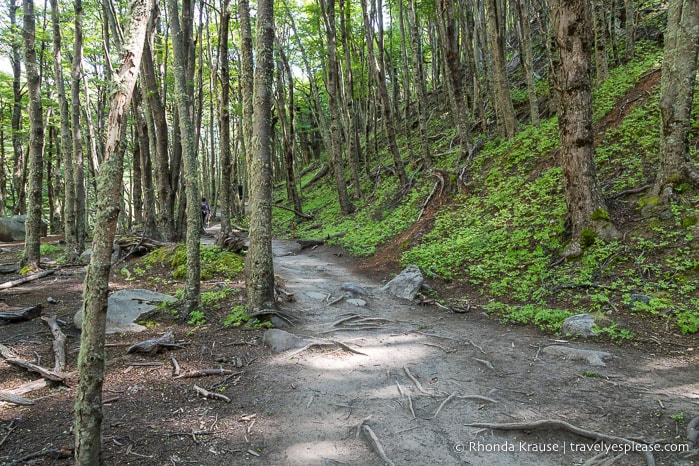
Accommodations in Torres del Paine National Park
For your convenience, here is a list of HOTELS IN TORRES DEL PAINE NATIONAL PARK and PUERTO NATALES . Please consider booking your accommodations through the included link. It costs nothing extra and helps support this website. Thank you!
More Patagonia Destinations and Travel Guides
- MOUNT FITZ ROY HIKE- HIKING TO FITZ ROY AND LAGUNA DE LOS TRES IN EL CHALTEN
- Visiting Perito Moreno Glacier- A Spectacular Glacier in Los Glaciares National Park
- HIKING IN TIERRA DEL FUEGO NATIONAL PARK- HOW TO SEE THE PARK ON FOOT
Follow Us On Social Media
Facebook | Instagram | X | Pinterest
Join the Facebook Group
Create an account
Start your adventure today.
Already a member? Login
Happiness Promise
There are hundreds of thousands of guides and tour operators around the world. Figuring out who to trust is stressful and hard.
That’s why we started 10Adventures Tours, we’re here to make it easy to find a great guide or tour operator. We handpick the best local guides and tour operators for 10Adventures, working to ensure you have great guides and a great trip.
We know it sucks to show up in a different country and find out the tents are junk, the guide incompetent or the route different from what we thought we were getting.
We want to give our users peace of mind that you’ll have a great trip and offer a guarantee that we will work with you to make it right.
How does this work? Well, if you feel that something about your trip didn’t’ meet your expectations, let us know. We will then work to gather the details and figure out where things went wrong. If something indeed wasn’t as described, or went wrong with your trip, and the problem was within the control of either oursleves, the guide or the tour company, we will then work out a refund with you that’s proportional to the scale of the problem.
Obviously the best way to make a great trip is to tell your local guide or tour operator and give them the chance to fix the solution while you are on your trip. Most things can be solved by telling your guide when the issue develops. If that doesn’t solve it, then email us right away. Please don’t wait to voice your concerns until the trip is over, as it’s much harder to solve issues after the fact.
We work hard to make sure you have a great trip. If something isn’t right, please email [email protected] and we will get to work right away.
Group Trips
Group travel can be chaotic and messy, which is why going on a trip with family or friends is the fun part and planning the trip, well… isn’t. But what if the group travel experience of your dreams could be organized without the hassle of you needing to plan every detail?
With 10Adventures group tours, you’ll be the mastermind behind an unforgettable trip without the need to worry about logistics, payments, or who can get time off for a holiday.
The VIP-level service of our Travel Advisors allows you to organize the adventure of your dreams, customize it exactly how you want to, and watch the savings roll in as more of your friends and family sign up for the once in a lifetime experience you created. It’s that simple!
Take the first step on your next group adventure by contacting one of our Travel Advisors today.
The window to travel as a family only narrows with time. Make the most of it by exploring the world together and creating memories that will last a lifetime.
Why share a travel experience with people you don’t know? Spend your hard-earned vacation surrounded by close friends on the adventure of a lifetime.
Shared travel experiences strengthen bonds and are the perfect way to come together as colleagues to solve challenges in a way that just can’t be done in an office environment.
Connect with members of your club or social circle over shared interests like food, culture, and the outdoors.
- VIP Service: Have a dedicated Travel Advisor who is always a call or a click away.
- Cost Savings: More people mean a lower cost per person. And there are additional discounts for children and shared rooms.
- Customizable: You are in charge and choose the start date, length, itinerary, accommodations, and other services.
- Easy Payment: Flexible payment schedule, and most importantly separate invoices so you aren’t left paying for other people.
- Private: Just you and your group making memories that will last your lifetime.
- Quality Time: There’s no better way to travel than alongside family and or friends. Enjoy quality time exploring the world with those you love most.
W Trek in 3 Days
Chat with us on our contact page or fill out the form below!
Enjoy a highlights-only experience on the W Trek in Torres del Paine

Take the first step towards a private travel experience, customized just for you.
About this tour:
What travellers are saying about 10Adventures
Jennifer W.
Why travellers choose this tour
At 10Adventures, we take care of the details so that our guests can focus on making memories. Enjoy these key features on this tour.
We're Canadian
Book with a Canadian company whose mission is to help you travel the world.
Accommodations
Accommodations for 2 nights are included (fully-equipped premium camping).
Don't worry about meals. 2 breakfasts, 3 box lunches, and 3 dinners are included.
Check out the 'What's Included' tab for more info on personal transfers during your tour.
Local Support
Travel stress-free knowing in-country local support is available by regular phone or WhatsApp to support you during your tour.
Payments Made Easy
Enjoy the flexibility and ease of staggered payments in your own currency using your choice of credit card.
Route Resources
Route notes, maps, and/or a trail app make navigation on this tour a breeze.
Park Entrance Fees
Included where possible! Check the 'What's Included' tab for more info on park entrance fees during your tour.
Luggage transfers
Take a load off, with optional or included luggage transfers. Check inclusions for further details.
Accommodation for W Trek in 3 Days
This tour is based at a riverside camp on the Serrano River where you’ll sleep in 4-season lotus belle tents. The camp features comfortable deluxe tents with 2 inflatable mattresses and shared mens/womens bathrooms. Towels, bedding & fresh linens are also included.
Tents are offered on a queen or double twin basis.
Single Rooms and Solo Travellers Hotel rooms are double occupancy. You can pay a supplement of $140 USD to have a private room in a hotel where possible. You can also pay a supplement of $79 USD for your own private tent at the campsites. Single rooms are not available in refuges.

Riverside Camp, Serrano River
This exclusive riverside camp invites you to experience your own slice of paradise on the quiet shores of the Rio Serrano River. Made up of just 10 deluxe lotus belle tents, you’ll enjoy a unique outdoor experience at this fully supported bas camp.
Hotels on Standard Tour
Planning a group trip?
Learn how we help group of friends, outdoor clubs and families get the tour they’ve been dreaming about.
W Trek in 3 Days Tour Details
Overview for w trek in 3 days.
The 3-Day Guided W Trek in 3 Days is the perfect solution to those with big adventure dreams and limited time. This trekking tour in Chilean Patagonia incorporates the top highlights of the famous W Trek including the Three Towers, the French Valley and mighty Grey Glacier.
On this short but sweet trip, you’ll take in the beauty of wild Patagonia as you explore its surreal landscapes on land and on water. Each day is jam-packed with the best highlights of Torres del Paine, allowing you to soak up the endless panoramic views of turquoise lakes and hanging glaciers.
Enjoy this epic short break in Patagonia as part of a group, led by a professional guide who will help you get the most out of Torres del Paine in just 3 days. Each evening of the tour, you’ll cozy down in deluxe lotus tents at the exclusive Riverside Camp, a fully supported base camp nestled on the peaceful shoreline of the Serrano River. Here, you’ll escape the hustle and bustle of the refugios in Torres del Paine and can enjoy a slice of paradise away from the crowds.
Short on time but eager to experience an adventure in Chilean Patagonia? Book the W Trek in 3 Days today!
Itinerary for W Trek in 3 Days
Transfer to torres del paine and hike the french valley.
The adventure begins right away this morning as you meet your group and guide at 7:00 am in Puerto Natales. From here, you’ll whiz past peaceful landscapes covered in flat pampas and dotted with authentic estancias as you transfer by vehicle to Torres del Paine National Park (2 hours).
On arrival in the park, you’ll hop on a catamaran to cross Pehoe Lake to reach the trailhead for the French Valley hike. First up you’ll head for the French River, reaching the entrance to the French Valley soon after. Some light scrambling across a boulder field will be rewarded with views of the hanging glacier perched atop the valley as you make your way to the “Plateau” (viewpoint). From here you’ll spot the French Glacier and Paine Grande (3050m) off to one side and the horns of Los Cuernos rising on the other. You’ll then descend through evergreen beech forests to reach Lake Pehoe, known for its crystalline waters.
Transfer by catamaran back across Lake Pehoe and then private transfer to the Riverside Camp where you’ll enjoy a delicious welcome dinner alongside your group and guide.
Hike the Pingo Valley and Grey Glacier Boat Navigation
Rise this morning ready to bear witness to a sky painted in the pastel colours of a Patagonian dawn. Fuel up with breakfast and then set out with your group and guide on a transfer to the trailhead.
Today’s hike to the Pingo Valley has 3 hours of breathtaking scenery in store, with incredible viewpoints dotting the trail each step of the way. You’ll enjoy a hearty picnic lunch on the peaceful shores of the Pingo River before hopping onboard a navigation boat to explore beautiful Grey Lake, sprinkled with blue-hued icebergs for the next 3 hours.
After spending some time experiencing the face of Grey Glacier up close, you’ll return to land and transfer back to camp for another fun evening alongside new friends.

Hike to the Three Towers Lookout and Transfer to Puerto Natales
Today the adventure begins with a transfer across Torres del Paine to reach the starting point for the Three Towers Lookout hike. Tracing the Ascencio River and heading down into the valley, you’ll hike through rich beech forests to finally ascend the impressive moraine which leads to the world-famous look out point.
Stand in awe as you look out over the towers from 900 m above sea level. Enjoy lunch here and of course lots of photos before descending the same path. Where the path ends, a private transfer awaits to whisk you back to Puerto Natales where this short break in Torres del Paine comes to an end.
Tour Highlights
Highlights for w trek in 3 days.
Discover the surreal landscapes of wild Patagonia as you hike surrounded by jaw dropping peaks and hanging glaciers.
Cover the top highlights of the W Trek including the Three Towers Lookout, the French Valley, and Grey Glacier.
Kick back each night in a secluded riverside camp where you’ll sleep beneath the stars in deluxe lotus tents.
Cruise past blue-hued icebergs as you navigate Grey Lake by boat, taking in the wonders of Grey Glacier up close.
What's Included
What's included for w trek in 3 days.
2 breakfasts, 3 box lunches, and 3 dinners are included.
Transportation during the Tour
All Private Transportation according to the itinerary including boat navigation on Grey Lake and the catamaran to cross Lake Pehoe (return)
Also Included
- Guide/Driver
- Entrance Fee to Torres del Paine National Park
- Welcome Drink at Riverside Camp
Not included
- Travel insurance
- Visas if required
- Accommodations before and after the trip in Puerto Natales
- Ice Hike or kayak activity on days 4 and/or 5
- Any alcoholic & non-alcoholic drinks at camp
- Gratuities for guide and driver (optional)
Optional Extras
- Hotel accommodation in Puerto Natales pre/post trek
Dates & Prices
Dates and prices for w trek in 3 days.
This guided trekking tour is mostly run as a group departure where you would be joining a mixed group, however, private departures are also available upon request.
Important: This tour is a subject to non-standard payment and cancellation terms. Payment Terms:
- Full payment will be required 90 days before the departure
Cancellation Terms:
- 75+ Days: Total trip cost minus a $200 USD booking fee per person for regular programs, $500 USD booking fee per person for tailor-made and private programs will be refunded
- 74 – 56 Days: 50% of total trip cost will be refunded
- 55 Days or Less: No Refund
Private tour
- Group of 2: $2,295 USD per person
- Group of 3: $1,995 USD per person
- Group of 4+: $1,695 USD per person
Dates and Prices to join a group:
Prices below are per person. Please note that the standard price applies when the group size is 4 or more. If the group size ends up being smaller, then a supplement may be required.
Accommodation
Reviews (51), reviews for w trek in 3 days.
There are no written reviews yet.
Add a comment
You must be logged in to post a comment.
Thank you for submitting your review!
If you enjoyed your tour please consider leaving a Google review for 10Adventures to help others discover the world of custom adventure travel.
Tour Booking Process
Booking process for w trek in 3 days.
Submit Booking
Confirm Availability
Pay Deposit
Trip Confirmed!
Frequently asked questions for W Trek in 3 Days
How hard is the W Trek in 3 Days Tour?
We rate this tour as a 3 out of 5 in terms of difficulty. Activities range from 4-6 hours per day at a moderate physical level.
Are meals included on the W Trek in 3 Days Tour?
2 breakfasts, 3 box lunches, and 2 dinners are included.
Is the W Trek in 3 Days Tour in English?
Yes, this trip is guided in English.
Do I need insurance?
Yes, it is mandatory to have health and medical insurance to join this trip, and your insurance should cover hiking. Get your travel insurance .
Do I need a visa to travel to Chile?
Check with your local country about visa requirements. You could also try this website , though you should verify with your government.
How do I get to Puerto Natales to start this tour?
Fly into Teniente Julio Gallardo Airport (PNT) in Puerto Natales to start this tour. A driver will greet you at the airport to take you to your hotel.
Where does the W Trek in Torres del Paine Tour end?
The tour ends upon your return to Puerto Natales where you can book overnight accommodations or continue your journey with onward travel.
Do I need special vaccines to travel to Chile?
Check with your family doctor.
Are there any travel restrictions for Chile?
Please check with your local government about travel restrictions before you book your tour. This map from the US Department of State provides an overview of the current status in countries around the globe. The UK‘s Foreign Office and Government of Canada also provide advice on foreign travel. Note that the travel advice may change depending on your nationality.
Tour Difficulty
Difficulty for w trek in 3 days.
Read about our scale for Tour Difficulty Ratings.
This tour was made for you!
Start filling out your booking details. Once you submit your request, we'll review availability for this tour and contact you within 24 hours to further customize your perfect adventure.
Why book with 10 Adventures?
Your trip. your way..
Make lifelong memories with the people you care about most. We specialize in custom & private active travel experiences.
Travel made easy.
Spend your time making memories, not planning them. Enjoy a stress-free vacation and leave the trip logistics to us.
You matter to us.
No bots here. A real human is always a click or a call away to ensure you get the adventure of your dreams.
Travel authentically.
Immerse yourself in the destination with highly-vetted, local tour operators who love to showcase where they live.
We make it easy for travellers to book private travel experiences, so they can make memories exploring the world with the people that matter most.
— Richard Campbell, CEO
Tours in South America by Country
Tours in chile by region, hiking tours in chile by region, torres del paine tours by activity, get travel inspiration and discounts.
Join our weekly travel newsletter

The Ultimate Guide to Hiking the ‘W’ Trek in Torres del Paine Without A Tour
By Author Steph Dyson
Posted on Last updated: 12th December 2023
Hiking the W in Chilean Patagonia’s Torres del Paine National Park is one of the absolute highlights of a visit to Patagonia – I should know, I’ve done it twice!
Back in March 2016, I walked the Torres del Paine W trek as part of a tour around Patagonia and was so struck by the park that I returned in March 2017 to hike the Full O Circuit .
In September 2022, I returned on a third occasion, this time to explore the other attractions of Torres del Paine National Park beyond these two, multi-day hikes.
It’s fair to say that on all occasions I have fallen head over heels in love with this part of Chilean Patagonia.
The problem is, the first time I hiked the W trek in Patagonia, I did so as part of a guided tour. We were dropped off at the Pudeto ferry port on Lake Pehoé and from that point onwards barely even had to think for ourselves.
We hiked the W during the day led along the one path by our guides and arrived at night to pre-pitched tents and pre-paid food.
However, it didn’t take more than five minutes of being in the park to realize that a tour was utterly unnecessary and that trekking in Torres del Paine solo and self-guided is easy and will also save you a whole stash of money.
Click to navigate this article:
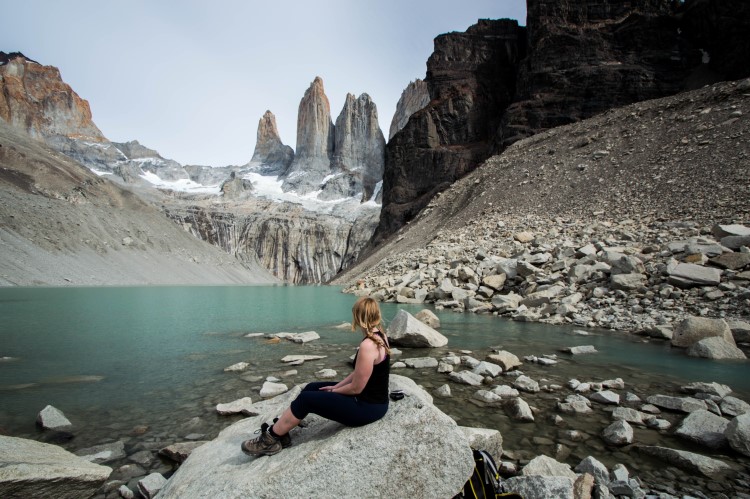
Know-before-you-go facts about the Torres del Paine W Trek
- How long is the W trek in Torres del Paine? It’s an 80-kilometer (50-mile) hike that most do over four or five days.
- When can you hike the W trek? The park is open year-round, however, for self-guided trekking, you can only hike between October and the end of April. If you want to hike during the winter months (May through September), you’ll need to arrange a guide. Our local partner, Chile Nativo, lead winter tours of the W trek and offer a 5% discount to Worldly Adventurer readers (use “Worldly Adventurer” in the referral discount box when you book!).
- Do you need to reserve camping spots/dormitory accommodation in advance of hiking the W? Yes, you must have reservations at each of the campgrounds or dormitories in which you plan to stay during the hike. You might be required to show your reservations when you enter the park, too.
- What about food? You can reserve full board at the campgrounds, which will include an evening meal, breakfast the day after your stay, and a packed lunch for you to take to the next campground. This typically needs to be booked in advance, although if you get to the campground early enough, you can sometimes do it on the day. Some campgrounds offer buffet dining (Grey and Paine Grande), so can be a good place to stock up on some snacks for the following day.
- Are reservations open for the campgrounds and dormitories along the W trek for the 2023/2024 season? Yes, reservations opened in July.
- How fit do you need to be to hike the W trek? While previous backpacking experience is not necessary, you do need a reasonable level of fitness to be able to climb up into the Frances Valley and up to the towers themselves. It’s helpful to have done a couple of practice walks, with a backpack weighing around 10 kilograms (22 pounds), in preparation for the trail.
- Do you need to book your park entrance ticket in advance? You must book online as they are no longer accept payments at the park entrance. Book your ticket online here . You need to download the QR code in Puerto Natales while you have internet (there is no signal in the park) and may need to show a copy of your passport to prove you do not live in Chile.
- How much does it cost to enter Torres del Paine National Park? The cost of entering the park varies according to how long you plan on staying. For up to three days in the national park, it costs $31,200 CLP ($34 USD) for adults and $16,000 CLP ($17 USD) for children aged 12 to 17. For over three days in the park, the cost is $44,500 CLP ($48 USD) for both adults and children.
- What is the altitude of Torres del Paine National Park? The highest point in the park is the John Gardner Pass at an altitude of 1,200 meters (3,900 feet) above sea level. However, only those trekking the O Circuit are required to reach this height; all of the W trek is at altitudes below this.
Firstly though, what actually is the W? The W is a four- or five-day hike in Chilean Patagonia’s Torres del Paine National Park. It’s named the W because it follows a W-shaped route and can be hiked either from west to east (my preferred route) or from east to west.
Along the way, you stay overnight in official campgrounds, which also have indoor dormitories, covered cooking areas for campers, and restaurants where you can eat pre-ordered meals.
Is the W worth it, though? It’s one of Patagonia’s easiest multi-day hikes and, while hiking for five days might not be at the top of everyone’s to-do list, the scenery in Torres del Paine National Park makes up for the hard work! Every day has spellbinding views: whether of Grey Glacier on day one, the French Valley on day two or three, or the eponymous towers on the final day of the hike.
You’ll finish tired but truly fulfilled by the experience – and proud of yourself for having completed it! Bear in mind that the W trek is a moderately challenging hike. If you’re able to walk up to 18 kilometers (11 miles) per day (and feel like you would be able to do that over multiple days), then you will find this hike perfectly doable.
That said, the hike up to the towers on the final day of the W (or the first, if you’re hiking east to west), is classed as a difficult hike due to the elevation gain of 900 meters (2,956 ft).
Bear in mind that you will be trekking with a backpack; the contents will depend on whether you’re carrying your tent and meals or planning on renting camping equipment and paying for meals at the campgrounds en route. Before hiking up the French Valley and up to the towers, you can also leave your backpacks at the rangers’ station or campsite, which means you won’t have to carry them up much elevation.
I highly recommend that, before heading to Patagonia, you go on a couple of hikes of around 18 kilometers (11 miles) with a backpack that will mimic the weight you’ll be carrying in the park – this will also help you to break in any hiking boots you might have bought for the trek and find out if they give you blisters!
How much does it cost to hike the W?
I’ve hiked the W twice: once as part of a tour and another time independently as part of hiking the O Circuit (which is a nine- or ten-day hike circumnavigating the national park and whose final five days are the W).
On my second visit to the national park, it became clear that I really didn’t need to hike the trails using a tour company. Not only is it expensive (it costs from $1,500 USD per person), but it’s unnecessary; all of the trails are clearly marked and busy with people and it’s easy enough to make camping reservations yourself.
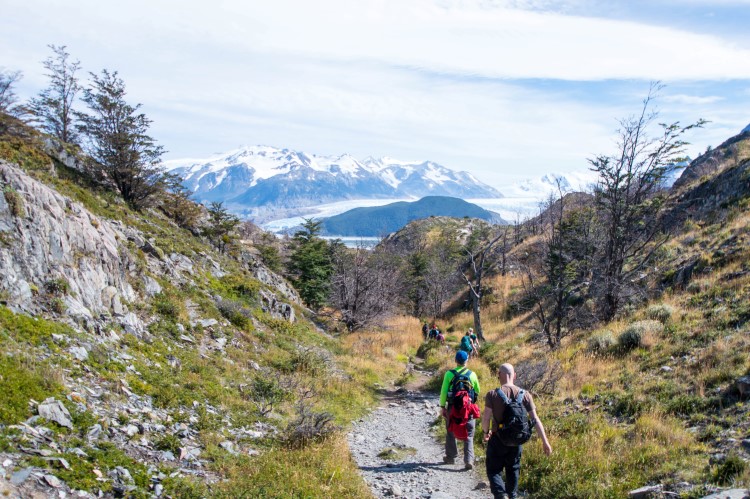
Hiking the W independently costs $157,000 CLP per person ($173 USD – check here for the most up-to-date conversion), plus the cost of food .
Camping and Transport cost breakdown*
- Return bus from Puerto Natales to Torres del Paine National Park: $13.323 CLP ($15 USD)
- Adult entrance fee into the park: $44,000 CLP ($49 USD)
- One-way ferry from Pudeto de Paine Grande Ranger Station: $30,000 CLP ($40 USD)
- Grey Campsite: $11,000 CLP (per person) ($12 USD)
- Paine Grande Campsite: $11,000 CLP (per person) ($12 USD)
- Francés Campsite: $31,000 CLP (per person) ($35 USD)**
- El Chileno Campsite: $31,000 CLP (per person) ($35 USD)***
* these figures are all updated for the 2023/2024 season.
**based on two people sharing a tent
***Torres Ranger Station (the free camping closest to the towers) is closed for the foreseeable future.
Food breakdown
- When we hiked the Full Circuit, we paid $68,620 CLP ($95 USD) between four people for all of our food. That’s $17,155 CLP ($20,5 USD) per person. No kidding.
- So for your food budget, expect to spend no more than $10,000 CLP ($12 USD) (read this full outline of exactly what we took with us in terms of food when we walked the Circuit)
If you want to save time, the website Torres Hike can show you the availability of accommodation and allows you to book it directly through them , rather than having to go via the Vertice Patagonia and Las Torres (previously known as Fantastico Sur) websites. All you need to do is plug in your dates and it’ll show you which campgrounds and refugios are available – saving you LOTS of time. You can then book directly with them, rather than having to try and book through the other websites!
How do you make campsite and refugio bookings for Torres del Paine?
The system for making refugio and camping reservations has changed dramatically over the past couple of years and a lot of the information you find online about the subject is out of date.
I also put together this epic, 5,000-word post about securing camping reservations in Torres del Paine that literally walks you through the process. However, I highly recommend just using Torres Hike . Yes, they charge you a small fee, but it honestly saves you so much time.
The reason it’s so challenging to make reservations independently is because there are two different companies who offer campgrounds and dorms in the park and you will have to reserve some campgrounds with one on their website and some with another on their website; trust me, it’s a painful process. Save yourself the stress and hassle of doing this by using Torres Hike instead.
Reservations are now open for the 2023/2024 season. If you’re struggling to find spots for the coming season, you should also read my article about alternative ways to hike the W if you can’t get camping reservations .
You can also check out this ultimate guide to Torres del Paine National Park , covering everything from the best time to visit, to where to stay and what to do beyond the W trek.
If you’re completely baffled by the process and just want someone else to deal with it, you can book with my partner in the region, Chile Nativo , who organise, guided, self-guided and fast-track (three-day) W treks. They give a 5% discount to Worldly Adventurer readers (use “Worldly Adventurer” in the referral discount box when you book!).
What equipment do you need to hike the W without a tour?
To pay as little as possible trekking Torres del Paine solo, it does require that you have the following pieces of equipment:
- A tent: I strongly recommend the lightweight Big Agnes Copper Spur HV UL2 tent ( REI | Backcountry | Amazon ), the North Face Stormbreak 2 (buy it on REI | Amazon ), or, for more room, the North Face Stormbreak 3 (buy it on ( REI ).
- A sleeping bag: I recommend the Nemo Disco 15 for women (buy it on REI ) and for men (buy it on REI ).
- A sleeping pad: Get a cheap foam pad ( REI | Backcountry | Amazon ) or a more comfortable Therm-a-rest Prolite (buy it on REI | Backcountry | Amazon ).
- A headlamp : Useful for midnight toilet visits and the hike up to the towers (buy one on REI | Black Diamond | Backcountry ).
- A cooking stove and gas: The affordable MSR PocketRocket 2 (buy it on REI | Backcountry | Amazon ) is great value for those on more of a budget, and is super lightweight.
- Cooking pots: I recommend the MSR pots set (buy them on Backcountry | Amazon ) as they’re good quality and food will stick less, which will make them easier to clean.
- Plates, a mug, and cutlery : A collapsible bowl is a great space saver (check out Sea to Summit on REI | Backcountry | Amazon ); I recommend a reasonably cheap, plastic mug (buy it on REI | Backcountry | Amazon ) and for cutlery, a multipurpose spork is a good choice (check them out on REI | Backcountry | Amazon ).
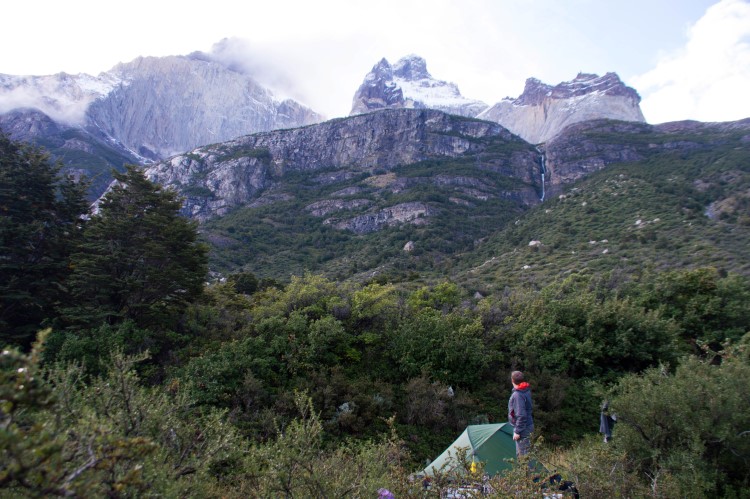
I’ve detailed exactly the items that I packed for the O Circuit in Torres del Paine (and which are still relevant to the W trek) and also what I pack in my rucksack on a trip to Patagonia in this packing checklist . Both have a free packing checklist download, too.
I recommend you take a look if you’re thinking of investing in camping equipment before you head over to Patagonia (something I would strongly advise if you plan on doing any other hikes or wild camping or if you’re looking at exploring the Carretera Austral ).
Planning Your Trip to Patagonia?
Save time, stress & money with a customized travel itinerary planned for you by a Patagonia expert
What previous clients have said:
Steph’s help laying out an itinerary for Chile was huge toward us having a great trip. She listened to our interests and compiled a framework that we could follow to make our plans. She included many practical tips as well as numerous options. She truly saved us many, many hours of research.
If you’re already traveling around Patagonia, what can you do to get your hands on this camping equipment for Torres del Paine?
You have three options:
Buy equipment in Punta Arenas or Puerto Natales
There is a wide range of hiking and camping equipment shops in these two towns. Punta Arenas is a tax-free zone so prices here are cheaper than you will find in Puerto Natales, although Calle Manuel Bulnes in the latter has some gear shops.
I actually found a pair of waterproof trousers for only $15,000 CLP ($18 USD) in one of the shops there, which is a lot cheaper than I thought they would be.
If you’re looking to buy equipment for camping and hiking in Torres del Paine National Park, you should be able to find everything that you need in these shops, but you will pay an elevated price for good-quality gear.
Estimated additional cost: $360,000 CLP+ ($400 USD+) per person
Rent equipment from Puerto Natales
Your second option is to rent all of your camping and cooking equipment from Rental Natales (you can book online) in Puerto Natales. However, they are very expensive.
There are other places in Puerto Natales to rent equipment too, so I suggest having a wander around and looking out for signs for rental equipment. Yaghan House (O’Higgins 584) and Lili Patagonico’s (Arturo Prat 479) have much cheaper, good-quality rental gear.
Remember to check the equipment thoroughly before committing as it does get a lot of wear and tear on the trail and you want something without holes and with zips that close to keep you warm and dry!
Estimated additional cost: $147,000 CLP ($162 USD) per person (based on two sharing) for five days’ rental
Rent equipment at each campsite in Torres del Paine National Park
Your final option is by far the most expensive. Each of the main camping grounds in Torres del Paine rents out tents, sleeping bags, and sleeping mats – but at a very high cost.
For example, in Grey campground, you can hire a two-man tent for $29,000 CLP ($32 USD), a sleeping bag for $21,000 CLP ($23 USD), and a sleeping mat for $8,000 CLP ($9 USD), bringing up your overnight cost (including the cost of the camping site) to $53,000 CLP ($58 USD) per person per night (based on two sharing).
Bear in mind, this doesn’t include the cost of hiring cooking equipment (which you can’t do at the campsites), so you will also need to pay for meals at each – an additional cost of between $55,000 CLP ($61 USD) and $80,000 CLP ($88 USD).
Estimated additional cost: $232,000 CLP ($256 USD) per person for equipment and $256,000 CLP ($282 USD) per person for full board for five days hiking the W circuit (based on two sharing).
How do you get from Torres del Paine National Park to Puerto Natales ?
It’s easy enough to get to Torres del Paine National Park with public transport.
Four companies travel from Puerto Natales to Torres del Paine each morning and all cost around $22,000 CLP ($25 USD) for a return ticket (which can be used on any of the company’s buses back from the park).
You can buy tickets online for Bus Sur (who have lots of departures); other companies do run this route, however you need to buy tickets from their offices, which are inside the Terminal Rodoviario (Av. España 1455) in Puerto Natales.
If there are a few of you, consider negotiating a group price like we did, which got us a few thousand pesos off per ticket.
It’s advisable to book your bus ticket at least a week in advance when visiting the park in high season (December through February).
Timetables for buses from Puerto Natales to Torres del Paine (east to south: Laguna Amarga, Pudeto and Administración)*
Conventionally, buses have departed from Puerto Natales and entered the park via the northeastern entrance at Laguna Amarga (for the minibus to the eastern starting point for the W), before continuing to Pudeto (for the catamaran to the western starting point for the W) and finally to Administración (not a destination along the W trek).
These now continue along to Hotel Lago Grey and stop at Camping Pehoé en route, too.
These bus timetables are below and can be booked online in advance via Bus Sur’s website:
Pre-pandemic, the following companies also offered services. However, their websites are no longer active and I can’t find them on any local booking sites.
That doesn’t mean they don’t have buses, however; if you can’t get a reservation with Bus Sur then it’s still worth going to the bus terminal in Puerto Natales as some will likely still be in operation and with similar departure times:
- Transport Maria José (tel. 61/2410 951)
- Buses Gómez (tel. 61/2415700)
- JB Buses Patagonia (tel. 61/2410 242)
- Buses Juan Ojeda (tel. 9/8943 7808)
*Service available November through April
Timetables for buses from Torres del Paine to Puerto Natales (Administración, Pudeto, Laguna Amarga)*
The following timetables are when buses can return you to Puerto Natales from the four different stops in the park. They can also be booked online and in advance via Bus Sur’s website.
Note that you have to return with the same bus company you entered the park with – you won’t be allowed on a different company’s buses. You don’t have to book a particular bus time; you will be able to turn up and get onto whichever bus you choose.
As above, there should be other companies offering buses to and from Puerto Natales into the park; visit the Terminal Rodovario in Puerto Natales to find out if you can’t make a reservation with Bus Sur.
Where do you buy your Torres del Paine entrance ticket?
The cost of entering the park varies according to how long you plan on staying. For up to three days in the park, it costs $31,200 CLP ($34 USD) for adults and $16,000 CLP ($17 USD) for children aged 12 to 17. For over three days in the park, the cost is $44,500 CLP ($48 USD) for both adults and children.
It’s no longer possible to buy your ticket at the Laguna Amarga entrance to the national park (the first stop on the bus if entering via that entrance) or at the Administración entrance (if entering via that entrance).
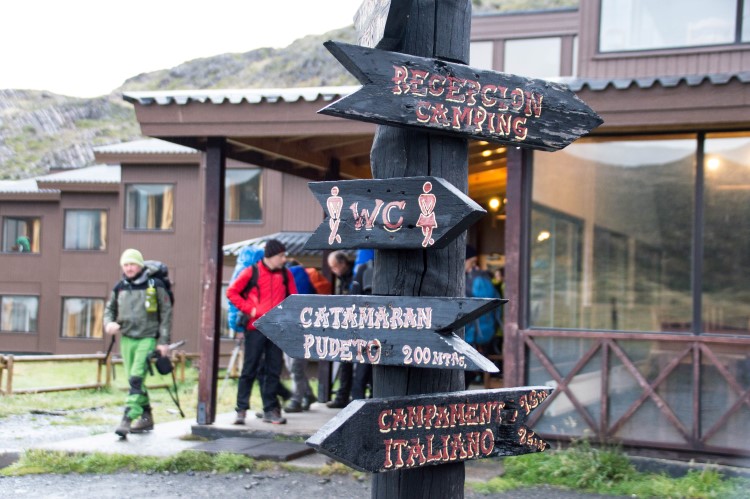
You must buy it in advance online here . You must download the QR code to your phone before you enter the park (as you won’t have signal when you get there!) and bring your passport to show that you’re not a Chilean resident.
Torres del Paine W trek itineraries
Hiking in Torres del Paine National Park is significantly cheaper if you go self-guided.
There is also absolutely no chance that you’ll get lost. Believe me, the W trek is now so busy that (unfortunately) you see people all the time.
If you want to trek Torres del Paine solo, you can either hike from west to east (my preference, as I’ll go into below) or east to west.
When you enter the park and pay your fee, you will be provided with a Torres del Paine W trek map to be used when you’re walking.
Unfortunately, the map that you get from CONAF doesn’t include distances. I would strongly recommend you download Maps.me, a free app that has all the trails marked and you can use it to work out distances if required.
Itinerary one: W trek in five days with sunrise at Mirador Las Torres (west to east route)
Why hike this route:
- This trail builds up to the most exciting part of the trek, the Mirador Las Torres viewpoint on the final day.
- It also starts with a short first day, giving you time to get into your stride.
Want to know how to book the campsites mentioned in this itinerary? Head over to this comprehensive article about booking Torres del Paine camping or hostel accommodation .
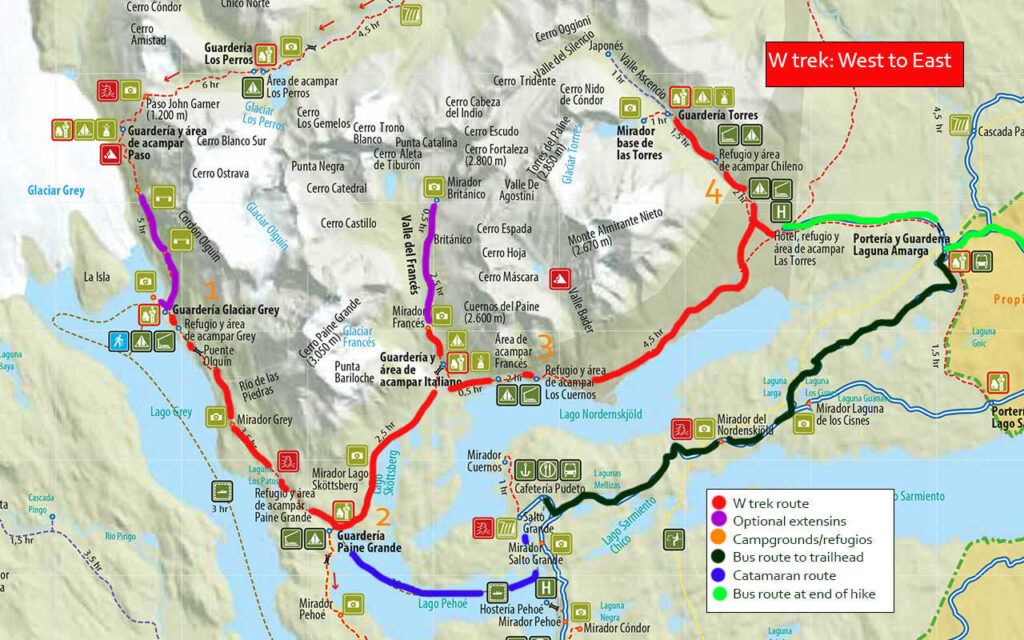
Day One: Puerto Natales to Grey
- Distance: 11 kilometers (6.8 miles)
- Duration: 3-4 hours hiking
6:50am Take a bus from Puerto Natales to the Pudeto (the catamaran ferry stop). You will stop at the park entrance when you first get into Torres del Paine to show your entrance ticket.
You must have bought this in advance online here and downloaded the QR code to your phone (there isn’t internet cell service at Laguna Amarga!).
9:50am Arrive at Pudeto. Queue up for the catamaran ferry across the lake.
10:30am Take the ferry across to Paine Grande*. This service is operated by Hielos Patagonicos ($25,000 ($30 USD) single, cash only). Tickets cannot be reserved in advance; you buy them at the ferry port.
Ferry schedules do sometimes change; you can check up-to-date ones here .
11:40am Arrive at Paine Grande and trek to Grey. The trail starts to go uphill but soon levels off and has great views of Lago Grey to keep your spirits up!
16:00pm The hike from Paine Grande takes between three and four hours so expect to arrive late afternoon at Grey to pitch your tent, meet some other hikers, and cook dinner.
Day Two: Grey to Paine Grande
- Distance: 18 kilometers (11 miles)
- Duration: 6-7 hours hiking
8:00am Wake up and have breakfast.
9:00am Leave your stuff at the campsite and return a few hours later to pack everything up. From the campsite, an additional one kilometre north through the forest brings you go two viewpoints lying over a kilometre from the glacier’s snout. From here, look out for enormous chunks of ice in the water.
Continue a further 2.5 kilometres (around a one-hour hike) along the path along the edge of the glacier to reach a series of two rope bridges hanging over ravines.
From here you get the best views of the glacier and, if you’re lucky and it’s a clear day, the Southern Patagonian Ice Field beyond.
Return to Grey along the same path and back to Paine Grande.
16:00pm You’ll arrive at Paine Grande at around 4pm, which is where you’ll spend the night. The facilities are great here, with a covered dining area for campers.
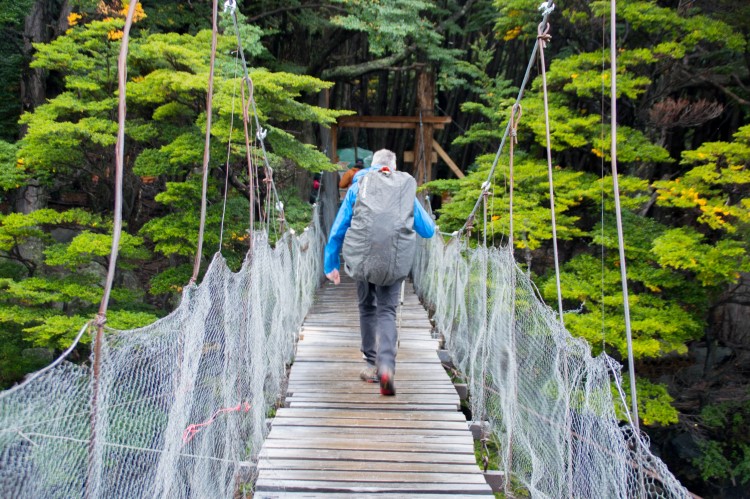
Day Three: Paine Grande to Francés
- Distance: 11.5 kilometers (6.8 miles) plus 9 kilometers (5.6 miles) for the extension to Mirador Británico)
- Duration: 4 hours hiking (7.5 hours with extension to Mirador Británico)
8:00am Get up, have breakfast and pack up your tent.
9:00am Today begins with a flattish trek around Lake Nordernskjold to Guardería Italiano. You can leave your bags here with the ranger before hiking up into the Francés Valley.
Note that there’s a new trail that begins about one km (15 mins) after you leave Paine Grande. It’s a little longer – 9 km (5.6 miles) rather than 7 km (4.3 miles) – and so takes around 30 minutes longer, but it has fewer hikers on it and is really pretty.
11:00am The hike up the Francés Valley may be long or painfully short – all depending on the weather. Both times I’ve walked Torres del Paine W hike I’ve experienced dreadful weather in the Francés Valley.
This part of the hike marks the central section of the W and it’s all uphill. After an hour’s steep gradient up a rocky, slippery trail to Mirador Francés, look for Glaciar Francés as it clings to the mountainside in the west.
If you’re feeling energetic, and the weather’s playing fair, you can continue climbing to Mirador Británico (an additional 3.5 km (2 miles) each way; around three hours’ return), where you’ll view a ring of toothy granite peaks, including the park’s second most famous landmark, the three-horned Cuernos del Paine.
It’s one of the park’s most stunning viewpoints—when the sky is clear. You may even see an endangered Southern Andean huemul (a type of deer) around here.
Luckily, the hike back is downhill to return to Campamento Italiano, where you pick up your rucksack and hike the 30 minutes to reach Francés.
13:00pm-16:00pm Arrive at Francés*, pitch up and enjoy the views across the lake.
*If there is no availability at Francés when you go to make your refugio or campsite reservations , you can instead book to stay at Los Cuernos, which is a further 3.5 kilometers (one hour) from Francés.
Day Four: Francés to El Chileno*
- Distance: 17 kilometers (10.5 miles)
- Duration: 4-5 hours hiking
9:00am Leave the campsite and begin the trek to El Chileno, situated about two hours from the bottom of the towers.
This trek meanders alongside the lake, gaining and losing altitude as it goes, until you reach the start of the valley where it becomes all uphill. The views are incredible but if it’s sunny, it will be hot!
16:00pm Arrive at El Chileno* and pitch your tent. Get everything organised for the morning as you’ll be leaving early. Check with the staff what time sunrise will be the next morning.
*For the 2023-2024 season, and for the foreseeable future, Torres Ranger Station is not open to the public. It’s no longer as easy to get to the towers for dawn as the distance is now around four kilometres, rather than one kilometre; however, it is still possible to do it.
If you can’t get a pitch at Chileno, it is possible to hike from Torres Central/Norte ($25 USD camping pitch per person). Although you’re not officially supposed to hike from here up to the towers, you can: leave four hours ahead of sunrise. It’s an additional one-hour 45 minutes if starting from Torres Central/Norte to reach the towers.
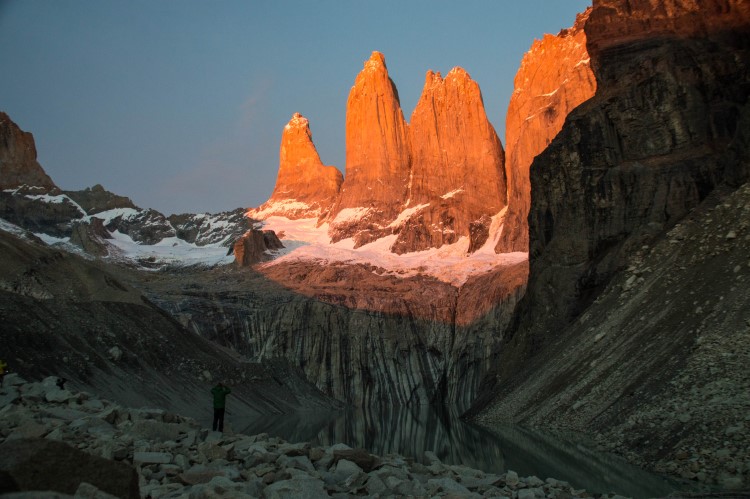
Day Five: El Chileno* to Laguna Amarga and Puerto Natales
- Distance: 13 kilometers (8 miles) plus 8 kilometers (5 miles) for the hike from the Centro de Bienvenida to Laguna Amarga)
- Duration: 6 hours hiking (add an extra 1.5-2 hours for the hike to Laguna Amarga)
4:30am Wake up and take a small bag (including warm clothes and a snack) to see the torres at dawn. Don’t forget your torch as the route is over rocks and can be treacherous.
4:45am Start hiking up to the torres . For us at the very start of March, dawn was at about 7:15am.
8:00am Leave the torres and return to the campsite. Pack up, have breakfast start the long walk down.
12.30pm When you get to Las Torres Hotel car park, there is a shop selling ice creams. To get the shuttle minibus to take you to Laguna Amarga, you need to hike one kilometre down the road towards Torres Central/Norte to reach the Centro de Bienvenida /Welcome Centre.
Shuttles ($4,000 CLP ($6 USD) – you must pay in cash at the shuttle) leave throughout the day to take you to Laguna Amarga. Departures leave the Welcome Centre at 8am, 2pm, 4pm and 7pm daily , and take about 30 mins.
If you can face the walk, it’s about another one and a half hours to the Laguna Amarga Ranger Station where buses are waiting to pick you up.
Hiking there, you can get good views of the towers as they rise out of the Cordillera Paine if the weather is clear.
14:30pm Take the bus from Laguna Amarga back to Puerto Natales.
17:00pm Arrive in Puerto Natales bus station and go and enjoy a pint at Cerveza Baguales on the Plaza de Armas to celebrate!
If time allows, consider spending a night in Puerto Natales to explore all the town has to offer before your onward journey. Our guide to the best hotels in Puerto Natales caters for all budgets, styles and preferences.
*If you can’t get a pitch at Chileno, it is possible to hike from Torres Central/Norte ($21 USD camping pitch per person). Although you’re not officially supposed to hike from here up to the towers, you can: leave four hours ahead of sunrise. It’s an additional one-hour 45 minutes if starting from Torres Central/Norte to reach the towers.
Make sure you bring a headtorch for climbing in the dark (it will get lighter as you reach the more difficult stretch of hiking just below the towers), plus warm clothing (even including a sleeping bag) to use at the top and keep you cozy as you enjoy the sunrise.
Itinerary two: Torres del Paine W trek in four days with sunrise at Mirador Las Torres (west to east route)
Why hike this route?
- It’s a good option if you don’t have much time
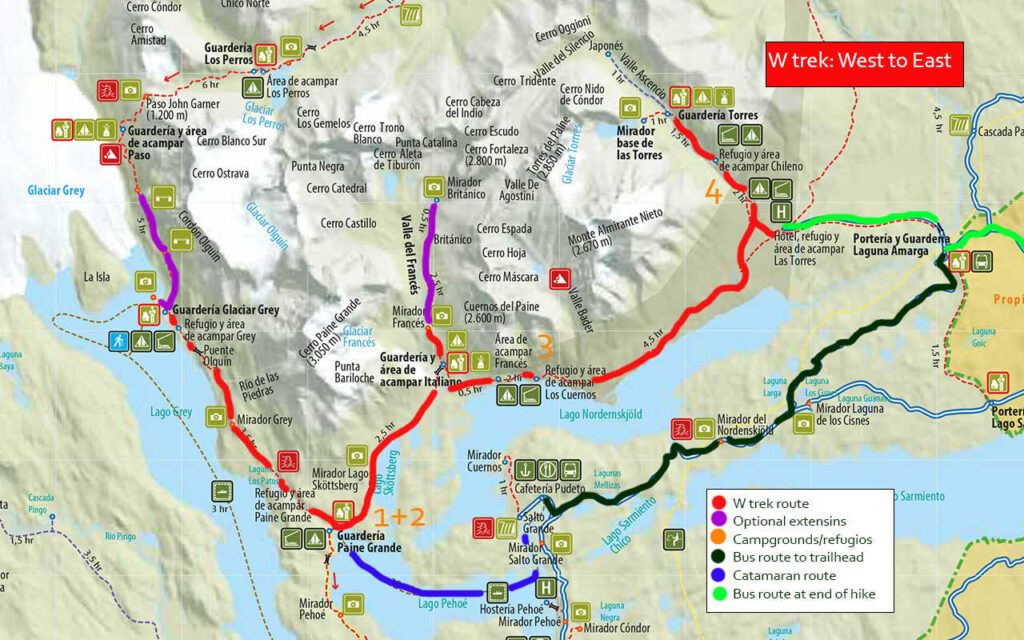
Day Zero – Puerto Natales to Paine Grande
- Distance: nil
- Duration: nil
2.30pm Catch the Bus Sur bus from Puerto Natales.
You will stop at the park entrance at Laguna Amarga when you first get into Torres del Paine to pay your entrance fee.
You must have paid for your ticket in advance online here AND downloaded the QR code; you will not find cell service or WIFI at the entrance.
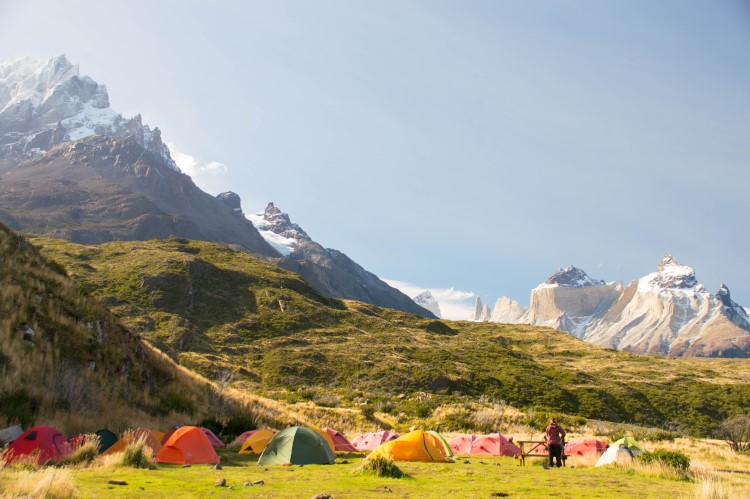
5.15pm Arrive at Pudeto take the ferry across to Paine Grande at 6pm. This service is operated by Hielos Patagonicos ($25,000 ($30 USD) single, cash only).
Tickets cannot be reserved in advance; you buy them at the ferry port. Ferry schedules and prices do sometimes change; you can check up-to-date ones here and the 9am ferry only runs November through the end of March.
6.30pm Pitch up at Paine Grande, have some dinner and then have an early night in preparation for a long day’s hiking tomorrow.
Day One – Paine Grande to Paine Grande
- Distance: 22 kilometers (14 miles) plus 7 kilometers (4.3 miles) if you hike to the last viewpoint)
- Duration: 7-9 hours hiking
7:00am Get up, have breakfast, and pack up your tent.
08:00am Take the trail towards Grey; it starts uphill but soon levels off and has great views of Lago Grey to keep your spirits up!
If you’re fit, you can hike an additional one kilometre north through the forest brings you go two viewpoints lying over a kilometre from the glacier’s snout. From here, look out for enormous chunks of ice in the water.
Turn back and return the way you came, past Grey and then back to Paine Grande.
17:00pm Arrive late afternoon back at Paine Grande to meet some other hikers and cook dinner.
Day Two – Paine Grande to Frances
9:00am Hike to the ranger station, Guardaria Italiano (around two hours), where you leave your rucksack with the ranger. You’ll pick it up on your way back down from the Francés Valley.
The hike up the Francés Valley may be long or painfully short – all depending on the weather. Both times I’ve walked Torres del Paine W hike I’ve experienced dreadful weather in the Francés Valley.
If you’re feeling energetic, and the weather’s playing fair, you can continue climbing to Mirador Británico (an additional 3.5 km each way; around three hours’ return), where you’ll view a ring of toothy granite peaks, including the park’s second most famous landmark, the three-horned Cuernos del Paine.
Luckily, the hike back is downhill to return to Italiano, where you pick up your rucksack and hike the 30 minutes to reach Francés.
*If there is no availability at Francés when you go to make your refugio or campsite reservations , you can instead book to stay at Los Cuernos, which is a further 3.5 kilometres (one hour) from Francés.
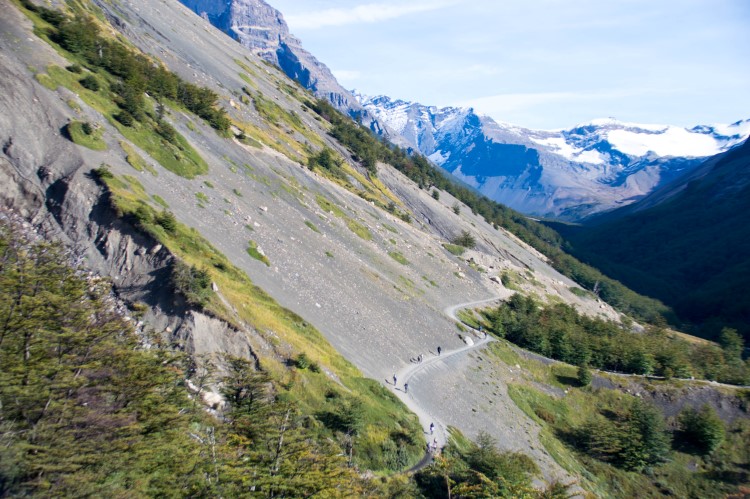
Day Three: Francés to El Chileno*
9:00am Leave the campsite and begin the trek to El Chileno, situated about two hours from the bottom of the towers. This trek meanders alongside the lake, gaining and losing altitude as it goes, until you reach the start of the valley where it becomes all uphill.
The views are incredible but if it’s sunny, it will be hot!
*For the 2023-2024 season and for the foreseeable future, Campamento Torres, the campground just below the towers, is not open to the public. It’s no longer as easy to get to the towers for dawn as the distance is now around four kilometres, rather than one kilometre; however, it is still possible to do it.
Day Four: El Chileno* to Laguna Amarga and Puerto Natales
Shuttles ($4,000 CLP ($6 USD) – you must pay with cash in the shuttle) leave throughout the day to take you to Laguna Amarga. Departures are at 8am, 2pm, 4pm, 7pm and takes about 30 minutes.
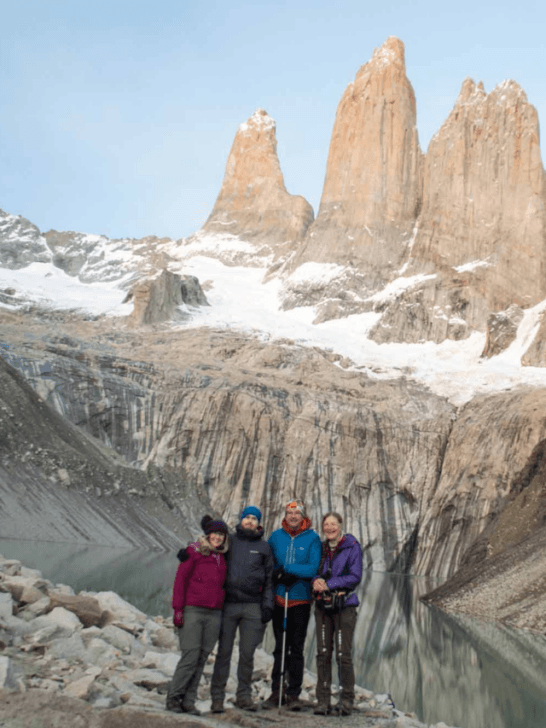
*If you can’t get a pitch at El Chileno, it is possible to hike from Torres Central/Norte ($25 USD camping pitch per person). Although you’re not officially supposed to hike from here up to the towers, you can: leave four hours ahead of sunrise.
Make sure you bring a headtorch for climbing in the dark (it will get lighter as you reach the more difficult stretch of hiking just below the towers), plus warm clothing (even including a sleeping bag) to use at the top and keep you cosy as you enjoy the sunrise.
Itinerary three: Torres del Paine W hike in five days (east to west route)
Why hike this route:
- Not only do you get to complete the W, it gives you time for a bonus extra hike to the Los Cuernos or Salto Grande viewpoints.
Want to know how to book the campsites mentioned in this itinerary? Head over to this comprehensive article about booking Torres del Paine camping or hostel accommodation .
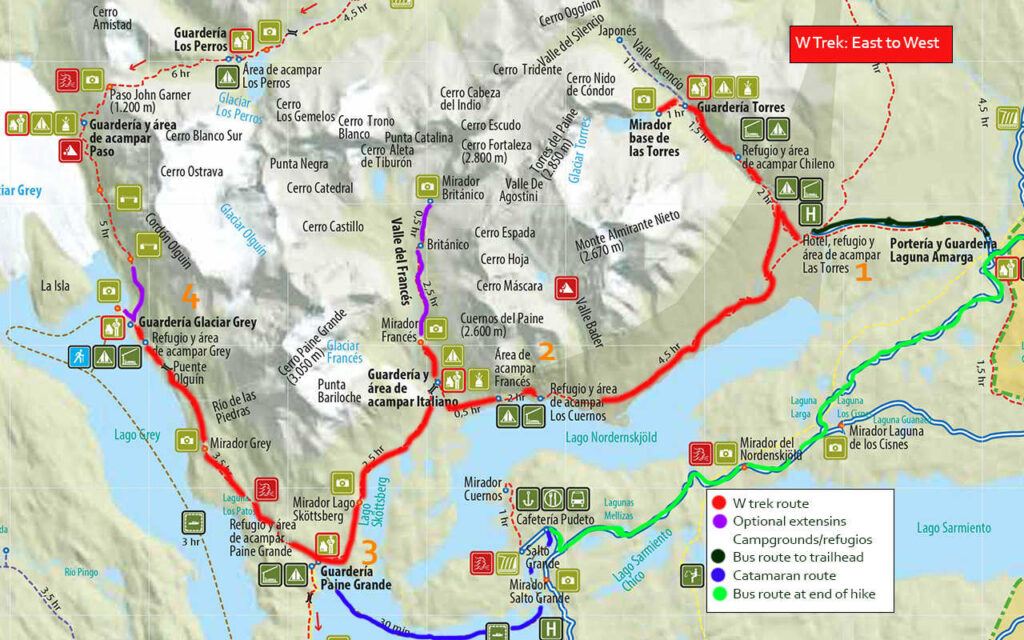
Day One: Puerto Natales to Mirador Las Torres & Torres Central/Norte
- Distance: 18.4 kilometers (11.4 miles)
- Duration: 6-7 hours hiking
6:45am Take a bus from Puerto Natales to Laguna Amarga. You can book tickets online with Bus Sur or go to the bus station in Puerto Natales the day before you start hiking and book with them or one of the other companies there.
8:45am Arrive at Laguna Amarga. Show your entrance ticket at the ranger’s station.
9:00am To get to the start of the W, you need to take a shuttle bus ($4,000 CLP ($6 USD) – you must pay in cash at the shuttle) to the Centro de Bienvenida (Welcome Centre).
Departures theoretically leave from Laguna Amarga at 9am, 3pm, 5pm and 8pm daily , and take about 30 mins. However, Las Torres (who run the shuttle service) have assured me that the shuttle bus awaits the arrival of the bus from Puerto Natales and will take all passengers that are waiting to board – sending for a second shuttle if there are more passengers than seats.
9.30am You’ll be staying overnight at the Torres Central/Norte campground, so check in and leave your big bags and take warm layers, food, and plenty of water for the hike up to the towers.
Start hiking up to the torres . It’s all uphill and it can be quite steep at points, but it’s worth the effort! All in all, you gain around 800m (2,620 feet).
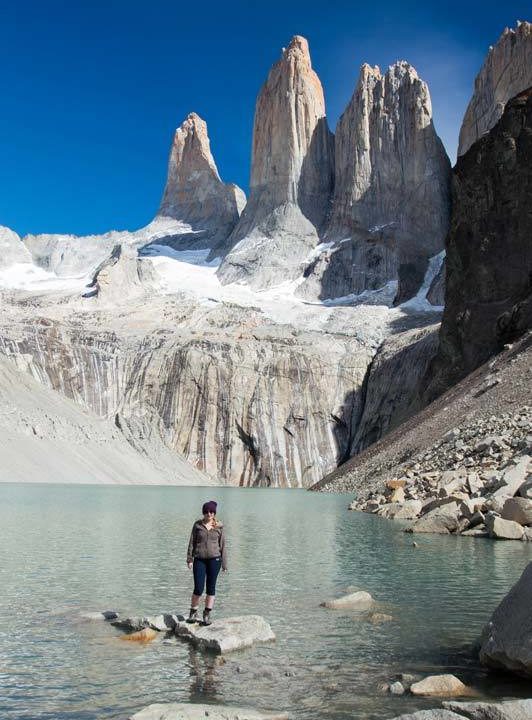
Take your time, drink plenty of water, and relax when you get to the top.
13:30pm Arrive at Mirador Las Torres and enjoy the views.
15.00pm Start hiking back to the campsite; you’re trekking back the way you came.
17.00pm Pitch your tent, have dinner, and relax!
Day Two: Torres Central/Norte to Francés
- Distance: 14.5 kilometers (9 miles)
- Duration: 5.5 hours hiking
9:00am Get up, have breakfast and pack up your tent.
10:00am You leave Torres Central heading west and reach Lago Nordernskjold. The trail meanders alongside the lake, gaining and losing altitude as it goes. The views are incredible but if it’s sunny, it will be hot!
15:30pm Reach Francés campground, where you’ll stay tonight. Pitch up and enjoy views across the lake. Bear in mind that check-in at Francés doesn’t start until 2.30pm and hot showers aren’t available until 5pm, so take your time on the hike.
Day Three: Francés to Mirador Británico & Paine Grande
- Distance: 14 kilometers (8.6 miles) from Francés to Mirador Británico and 7 kilometers (4.3 miles) from Guardería Italiano to Paine Grande
- Duration: 5.5 hours hiking from Francés to Mirador Británico and 2.5 hours from Guardería Italiano to Paine Grande
9:00am If the weather is good, today is going to be a long day as you climb up into the Francés Valley. Both times I’ve walked Torres del Paine W hike I’ve experienced dreadful weather in the Francés Valley.
From Francés, head west along the path beside the lake to reach Guardería Italiano, a rangers’ station and former (now defunct) campground. Here, you can drop your big rucksacks; just take warm clothing and food for the hike up to the Mirador Británico* (British Viewpoint). This part of the hike marks the central section of the W and it’s all uphill. After an hour’s steep gradient up a rocky, slippery trail to Mirador Francés, look for Glaciar Francés as it clings to the mountainside in the west.
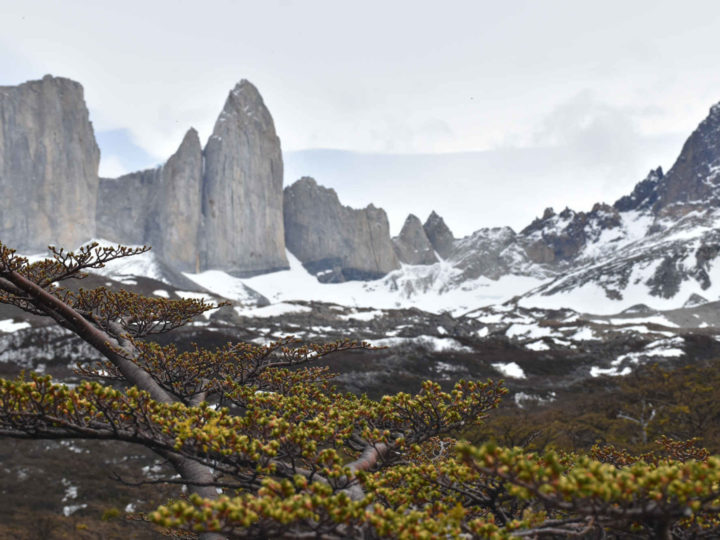
Luckily, the hike back is downhill to return to Guardería Italiano. Pick up your bags and take the new trail that begins just after the rangers’ station; take the lefthand fork that follows closer along the lake. It’s a little longer – 9 kilometers (5.6 miles) rather than 7 kilometers (4.3 miles) – and so takes around 30 minutes longer, but it has fewer hikers on it and is really pretty.
18:30pm Arrive at Paine Grande, pitch your tent and enjoy a hot shower!
*You’re only allowed to start hiking up to the viewpoint until midday, so don’t delay getting to the rangers’ station – although this rule isn’t always enforced!
Day Four: Paine Grande to Grey & Puerto Natales
- Distance: 11 kilometers (6.8 miles) plus six kilometers (3.7 miles) to reach rope bridges
- Duration: 4 hours hiking plus 1.5 hours to reach rope bridges
10:00am Take the trail heading north to Grey. It starts by going uphill but soon levels off and has great views of Lago Grey to keep your spirits up! It takes between three and four hours.
14:00pm Arrive at Grey, where you can leave your big bags. From the campsite, an additional one kilometre north through the forest brings you to two viewpoints lying over a kilometre from the glacier’s snout. From here, look out for enormous chunks of ice in the water.
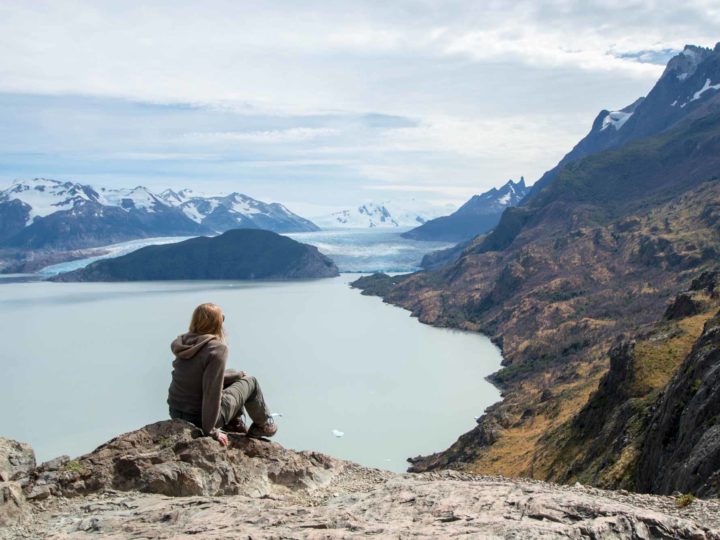
From here you get the best views of the glacier and, if you’re lucky and it’s a clear day, the Southern Patagonian Ice Field beyond. Return back to Grey.
16:00pm Arrive at Grey, pitch up and relax – you’ve almost finished the hike!
Day Five: Grey to Paine Grande and Puerto Natales
- Distance: 11 kilometers (6.8 miles) plus 2.3 kilometers (1.4 miles) to the Cuernos Viewpoint
- Duration: 4 hours hiking
7:00am Get up, pack up your tent, and have breakfast. Return to Paine Grande along the same path.
10:30am Join the queue for the ferry to Pudeto.
11:00am Take the ferry to Pudeto. This service is operated by Hielos Patagonicos ($25,000 ($30 USD) single, cash only). Tickets cannot be reserved in advance; you buy them at the ferry port.
11:30am Arrive at Pudeto. From here, you can either have lunch in the tiny cafeteria at the ferry dock or you can hike from Pudeto to the Cuernos Viewpoint, a 2.3-kilometer (1.4-mile) one-way hike from the ferry dock; it should take you around an hour each way and grants you incredible views west and east along the Paine Massif range.
A shorter option is the 600-meter (0.3-mile) trail to the Salto Grande Waterfall, which has stunning views of Los Cuernos behind it.,
2:30pm Take the bus from Pudeto back to Puerto Natales. You should arrive around 5.05pm.
Itinerary four: W trek in five days with sunrise at Mirador Las Torres (east to west route)
- You get to see the sunrise at Mirador Las Torres and hiking to it on your first day means your legs won’t be as tired.
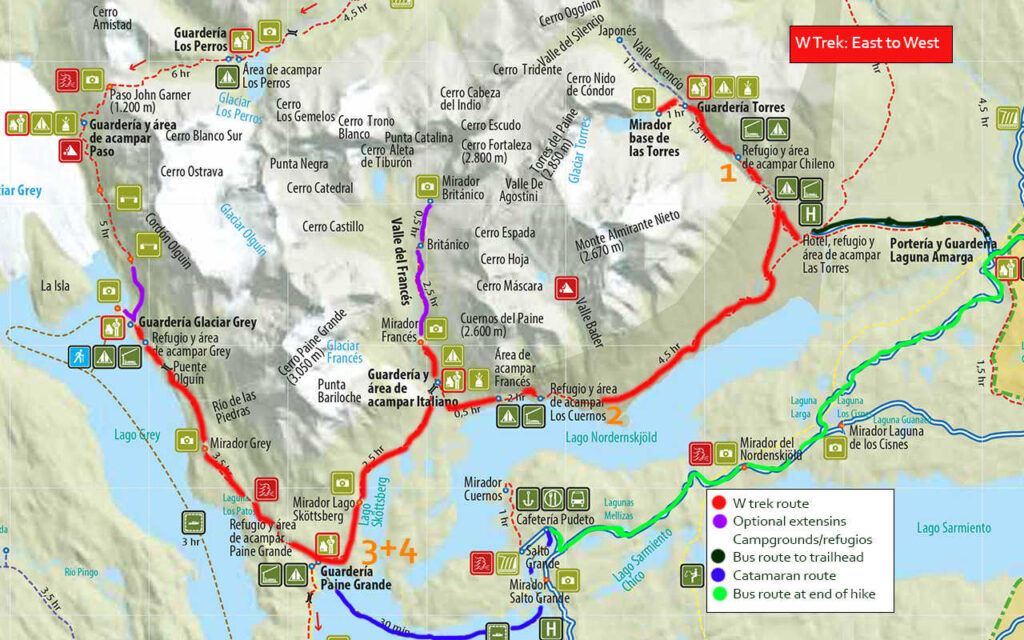
Day Zero: Puerto Natales to El Chileno
- Distance: 5 kilometers (3miles)
- Duration: 2 hours hiking
12:00pm Take a bus from Puerto Natales to Laguna Amarga.
2.00pm Arrive at Laguna Amarga. Show your entrance ticket at the ranger’s station.
2.30pm To get to the start of the W, you need to take the shuttle bus ($4,000 CLP ($6 USD) – you must pay in cash at the shuttle) to the Centro de Bienvenida (Welcome Centre).
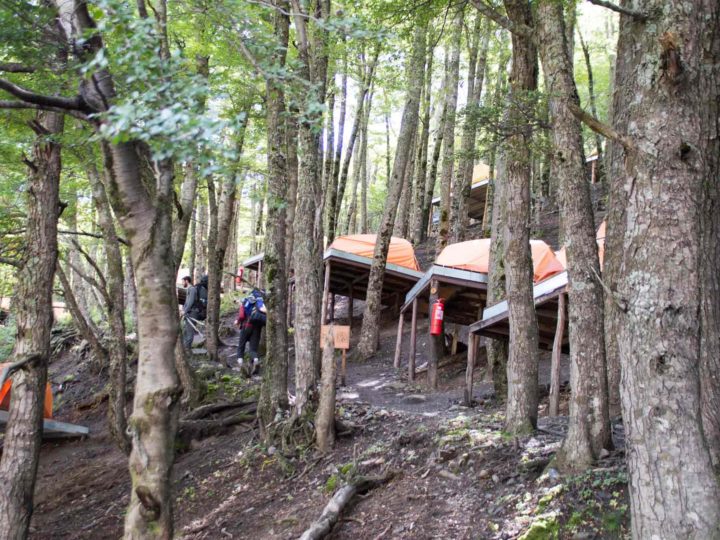
3pm Start hiking up to El Chileno, the closest campground to Mirador Las Torres, the famed viewpoint of the towers. This is the smallest campground, so sells out fast.
If you can’t get a spot here, you’ll need to camp at Torres Norte/Central and hike four hours tomorrow to reach the viewpoint.
5pm Arrive at El Chileno. Set up your tent, have dinner and relax.
Day One: El Chileno to Mirador Las Torres and then Los Cuernos
- Distance: 19.4 kilometers (12 miles)
- Duration: 6.5 hours hiking
4:30am Wake up and take a small bag (including warm clothes, a sleeping bag, and a snack) to see the torres at dawn. Don’t forget your torch as the route is over rocks and can be treacherous.
8:00am Leave the mirador and return to the campsite. Pack up, have breakfast start the walk down. When the trail splits, you’ll need to take the righthand path that goes alongside Lago Nordenskjöld.
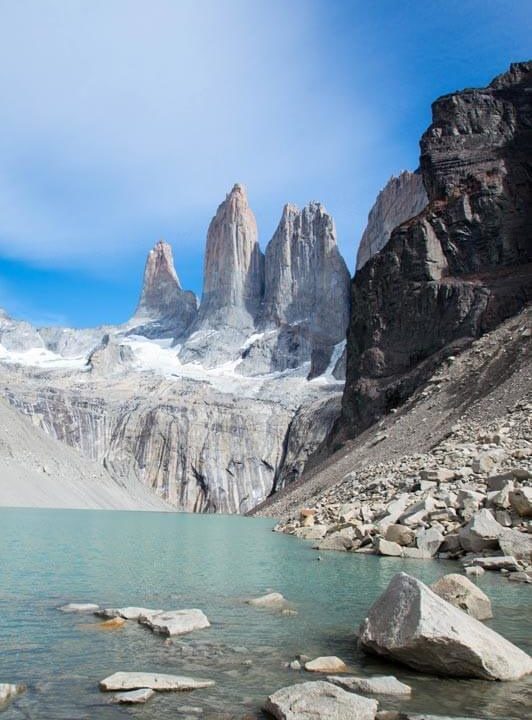
This trek meanders alongside the lake, gaining and losing altitude as it goes. The views are incredible but if it’s sunny, it will be hot!
3:00pm Arrive at Los Cuernos*, pitch up and relax.
*If there is no availability at Los Cuernos, when you go to make your refugio or campsite reservations , you can instead book to stay at Francés, which is a further 3.5 kilometers (one hour) beyond Los Cuernos.
Day Two: Los Cuernos to Paine Grande
- Distance: 17.5 kilometers (10.8 miles) from Los Cuernos to Mirador Británico and 7 kilometers (4.3 miles) from Guardería Italiano to Paine Grande
- Duration: 6.5 hours hiking from Francés to Mirador Británico and 2.5 hours from Guardería Italiano to Paine Grande
7:00am Get up, have breakfast and pack up your tent.
8:00am Today begins with the path alongside Lake Nordernskjold to Guardería Italiano. You can leave your bags here with the ranger before hiking up into the Francés Valley to Mirador Británico*.
10:30am The hike up the Francés Valley may be long or painfully short – all depending on the weather. Both times I’ve walked Torres del Paine W hike I’ve experienced dreadful weather in the Francés Valley.
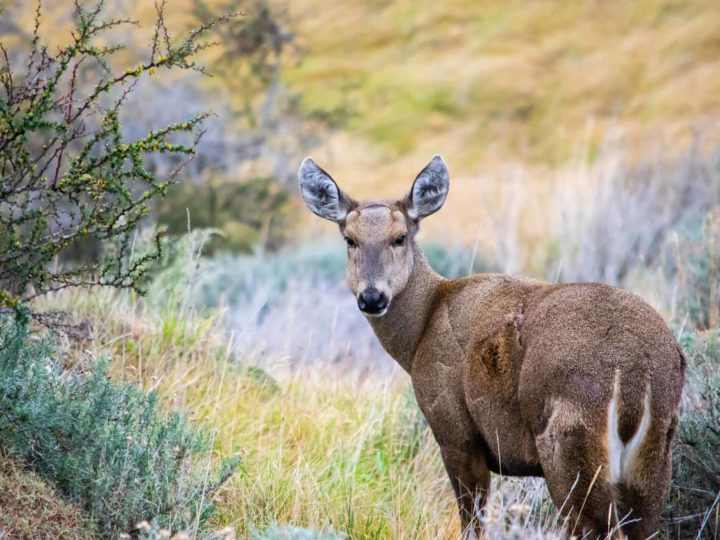
Luckily, the hike back is downhill to return to Campamento Italiano. From there, pick up your rucksack and hike the two remaining hours to reach Paine Grande.
Note that there’s a new trail that begins just after Campamento Italiano; take the lefthand fork that follows closer along the lake. It’s a little longer – 9 km (5.6 miles) rather than 7 km (4.3 miles) – and so takes around 30 minutes longer, but it has fewer hikers on it and is really pretty.
17:00pm-18:00pm Arrive at Paine Grande, pitch up and enjoy the views across the lake.
Day Three: Paine Grande to Grey and back to Paine Grande
9:00am Hike from Paine Grande to Grey; you can leave everything in your tent, except the items you need for today. The trail starts to go uphill but soon levels off and has great views of Lago Grey to keep your spirits up!
13:00pm Arrive at Grey. From the campsite, an additional one kilometre north through the forest brings you to two viewpoints lying over a kilometre from the glacier’s snout. From here, look out for enormous chunks of ice in the water.
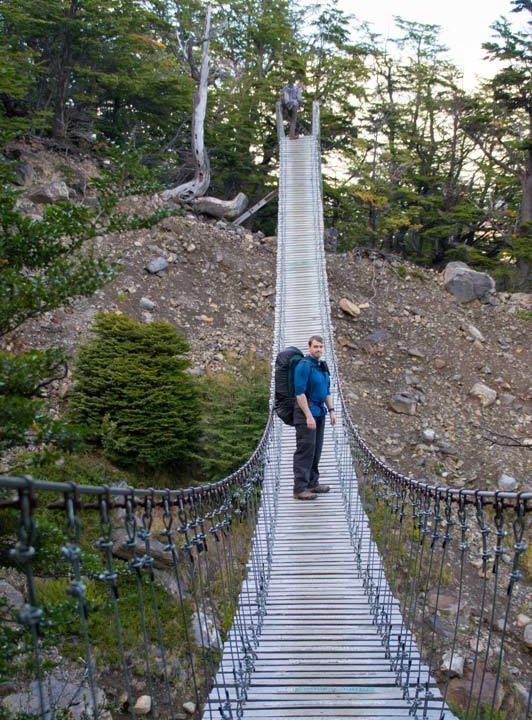
15:00pm Return to Grey along the same path and back to Paine Grande.
19:00pm Arrive at the campground, relax, have dinner and enjoy the feeling of finishing the trek!
Day Four: Paine Grande to Puerto Natales
- Distance: N/A
- Duration: N/A
9.00am Join the queue for the ferry to Pudeto.
9:30am Take the ferry to Pudeto. This service is operated by Hielos Patagonicos ($25,000 ($30 USD) single, cash only). Tickets cannot be reserved in advance; you buy them at the ferry port.
10:00am Arrive at Pudeto.
10.30am Take the bus from Pudeto to Puerto Natales and celebrate your successful completion of the W!
Top tips for hiking the Torres del Paine W Trek self-guided
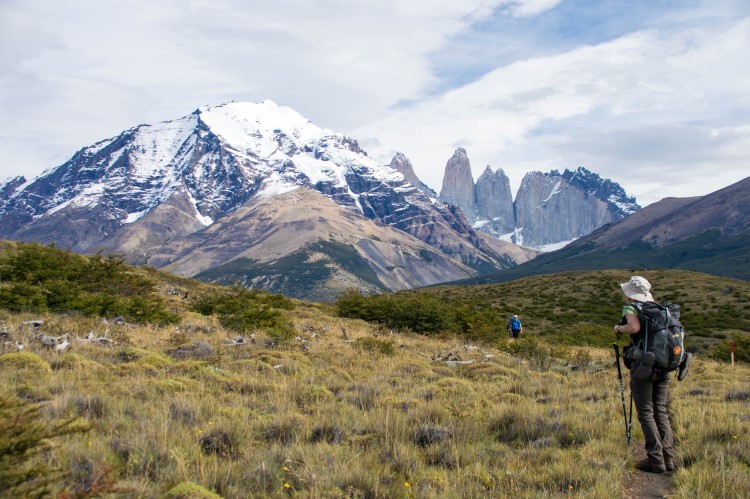
Having now been hiking in Torres del Paine National Park twice, I’ve learned a few important tips that have kept me happy, sane and comfortable en route :
Top equipment tips
- Camping in Torres del Paine at Francés, Los Cuernos, and El Chileno is on wooden platforms. If you plan to stay at any of these campsites, you will need extra cord or string to help you attach your tent without using pegs.
- Bring a range of warm and wet weather clothing. Check out my packing list for hiking the Circuit in Torres del Paine for the full guide to the clothing that I packed for the trip (and which is also a good guide to what to pack for the W). It also includes a free, downloadable checklist.
- Bring a book or some cards for the evenings as you tend to finish hiking quite early and if it’s cold and wet, you’ll want to retire to the shelters with something to do.
- Having a lightweight tent really does make a difference camping on this trek. Have a look at my review of the Big Agnes HVUL2 , the really lightweight backpacking tent that we used for the O Circuit.
- If you’re carrying all of your own equipment, a 60-litre rucksack should be big enough.
- Pack all of your clothes into dry bags (better than a bin bag which can easily rip). The weather changes rapidly and on days when it’s pissing it down, you’ll welcome the fact that your sleeping bag and clothes are dry. I recommend the Sea to Summit dry bags (buy them on REI | Amazon ).
- Bring a rucksack cover. I’ve heard mixed advice on this one, but a rucksack cover kept our bags dry (and so lighter) when we were hiking in Torres del Paine National Park and no, they didn’t blow away in the wind. If your rucksack doesn’t come with its own, you can find them in various sizes on | Osprey | Amazon (make sure it’s the correct size for your bag – otherwise it will blow away!).
Top food tips
- There is a much wider (and cheaper) selection of food in the supermarkets in Punta Arenas than in the one Unimarc supermarket in Puerto Natales. I recommend doing your food shop there before you take the bus to Puerto Natales. We left the stuff we didn’t need in our hostel in Punta Arenas.
- You can also buy trekking food and bring it with you , but it’s heavier and far more expensive than organising your food when you get to Puerto Natales.
- Pack everything into zip-lock plastic bags and bin all the original packaging that you can to save on carrying any extra weight. Also, don’t bring the full pack of rice if you’re only going to eat half of it – every bit of weight counts!
- You can buy basic staples (pasta, biscuits, tomato puree etc.) from the shops at Paine Grande, Grey, Francés and El Chileno to stock up on supplies. It’s pretty expensive, but totally worth it. They also all stock beer – an additional expense that I didn’t include in the costings for the W trek!
- You don’t need to bring water with you as it’s available from all the glacier meltwater streams that you’ll run into along the W and is drinkable from the taps at each of the campsites. If you’re nervous about drinking the water, you can also bring a Steripen (read my review of the Steripen Adventurer or buy one from Amazon or buy a newer Steripen UV Ultra from REI ) to zap anything that might be nasty or a Grayl ( REI | Backcountry | Amazon ) – find out why I recommend these water filters for South American travel .
- My dad is a pro at packing food for multi-day treks. Read what food we took with us for the O Circuit (and which you can use as a guide for the W too).
- You will need Chilean pesos on you for the park as nowhere accepts cards. You’ll need $25,000 CLP ($35 USD) for the catamaran ferry and then extras for additional food, beer, and anything else you want to buy.
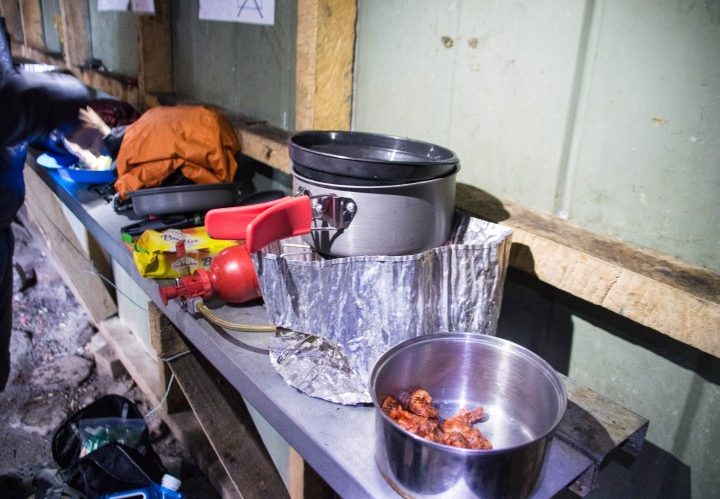
Camping in Torres del Paine
The following summarises some of the main points about booking campsites and refugios in Torres del Paine for the W trek, but you can get a full overview of how to book campsites in Torres del Paine with this article updated for the 2023/2024 season.
Reservations with Las Torres and Vertice Patagonia
You will need to book your campsites in Torres del Paine in advance. For example, in August 2022, many of the campsites and refugios were fully booked for December through February 2023, which just shows how far in advance it gets booked up.
Before you start panicking, what happens each year is that reservations free up again in September/October, probably due to the fact that tour agencies in Puerto Natales make mass reservations for the high season, and then cancel them when they don’t fill the bookings.
If you need anything planned well in advance, then this isn’t going to suit your plans. If your plans are a little more open and you can wait until closer until the time (and keep checking back to see if any spots have opened up), then you should still be able to hike the W during these months.
My recommendation would be to hike outside of these months anyway (November or March) to avoid the crowds as much as possible, but either way, you still MUST SECURE YOUR RESERVATIONS with Las Torres (Francés, Los Cuernos, El Chileno) and Vertice Patagonia (Paine Grande and Grey).
If you’re trying to get a space last-minute, you can always pop into either of their offices in Puerto Natales and see if they can book you in. I’ve heard of people having success with this with only a day or two’s notice.
Reservations with CONAF
For the 2023/2024 season, and for the foreseeable future, all of the CONAF campsites remain closed.
Upgrade your solo Torres del Paine W trek, Patagonia with these changes
If you’re not so bothered about hiking the W in Torres del Paine National Park on a complete budget, consider making the following small tweaks to your itinerary.
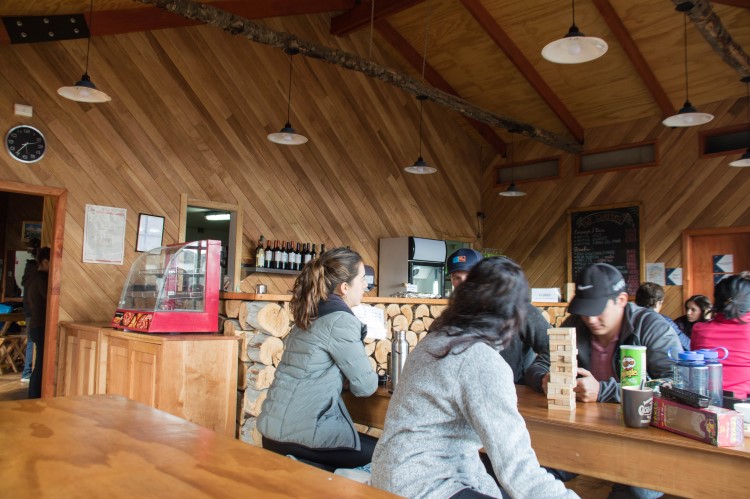
Stay overnight at Los Cuernos ($80,000 CLP ($88 USD) per person full board) instead of Francés
Again, this is only really possible if you stay overnight on Day Two in Paine Grande. When we hiked the Full Circuit, we decided to treat ourselves to an all-inclusive night at Los Cuernos.
This meant we still pitched our own tent on a wooden platform, but we had a three-course dinner, breakfast, and packed lunch for the next morning, which reduced the amount we had to pack in our rucksacks for the hike.
The food from Las Torres (previously known as Fantastico Sur) is much better than Vertigo Patagonia too, so I would recommend this instead of eating in the big canteen at Paine Grande.
Los Cuernos now offers camping sites without full board (previously you had to pay for full board at this campsite).
This means that for $25 USD per person you can pitch up your own tent here. They also offer half-board options priced at $62 USD per person, which include dinner and breakfast.
Book full board and a tent or bed at each campsite
You can rent gear and get food at all campgrounds, so if you don’t want to carry anything, then you can also book this way!
Bear in mind that full board at Los Cuernos comes in at $158 USD per person for a fully-equipped tent and full board – so it certainly won’t come cheap!
Did you find this guide to the Torres del Paine W hike useful? Pin it!
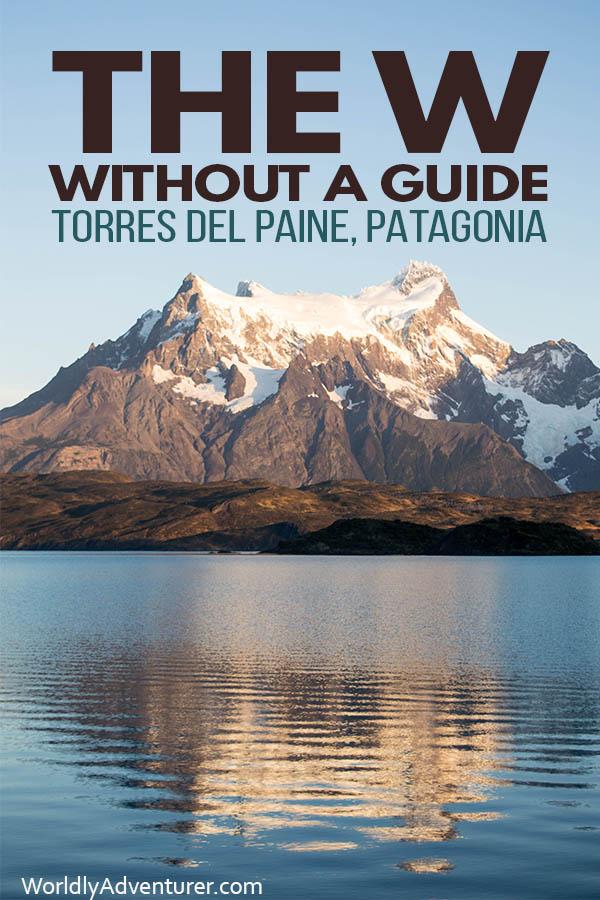
Helen Turner
Sunday 4th of February 2024
Excellent article. Plenty of food for thought. Thankyou
Steph Dyson
Friday 9th of February 2024
Thanks Helen! Steph
Sunday 26th of November 2023
We were hoping to hike to Refugio Grey, then take the Navigation boat toward Hotel Grey, then take a shuttle to our car at Pudeto. But I'm not sure how the timing works out. If we take the 14:00 navigation from Refugio Grey, is there time to make the last shuttle from Hotel Grey?
Tuesday 28th of November 2023
Hi Karen, I'm not sure. You would need to go off the timings on the Hotel Grey website or reach out to them directly. Steph
Jonny Collins
Tuesday 24th of October 2023
Thank you for your brilliant blog posts on all things South America - they're perfect for someone like me that loves knowing the logistics of our upcoming trips! My wife and I were meant to visit Patagonia for the first time in 2020 as part of a wider trip that was cut short due to COVID - we read your blog posts at the time whilst planning. We're finally planning to visit in 2024!
Unfortunately due to work commitments we are not able to take more than two weeks off and it is making our itinerary from the UK quite tight (we want to get to El Calafete and El Chalten in the same trip).
Whilst I appreciate you recommend doing the W Trek in 4 or 5 days, we are considering doing it in 3 days (we are experienced hikers and have done multi day hikes before). We had always planned hiking West to East. For the most even split on distance it seems that staying at Paine Grande and Los Cuernos would work best. We're really keen to see the towers at sunrise but appreciate that staying at Paine Grande and Torre Norte to do this would result in a very big second day. We have thought of two alternatives:
Option 1 (West to East): Night 1: Campo Italiano Night 2: Torre Norte
Option 2 (East to West): Night 1: Refugio Chileno Night 2: Campo Italiano
We've not considered yet if these options work with bus and ferry timetables. Do you think either of the above options are feasible to do the hike in 3 days and get to see the towers at sunrise? If not is there an alternative that might work, or if we do the trek in 3 days do we need to accept that we would not be able to see the towers at sunrise?
Any advice on the 'best' way to do the W trek in 3 days would be much appreciated. Apologies if anyone has asked this before! Thanks in advance :)
Sunday 28th of January 2024
Hi Steph, Thank you for your reply. In the end we decided to find an extra day from elsewhere in the trip so that we could do the W Trek and not miss out on anything! Thanks again for your help and for keeping this brilliant blog post up to date!
Thursday 23rd of November 2023
Hi Jonny, Italiano isn't open any more unfortunately. I would recommend just doing day hikes rather than the W. That way, you can actually enjoy your day hikes and not worrying about trying to cover the ground quickly. Steph
Tuesday 10th of October 2023
Great post, thank you! A group of five of us is heading to TDP to do the W-trek in January 2024. Very excited! We're flying from Santiago (SCL); is Puerto Natales a great option to fly into? I heard the drive to TDP from P. Natales is shorter than when coming from P. Arenas? It seems SKY airline has some flights during our time frame. Any great spot to hang out or visit at in P. Natales?
Hi LuAnn, yes you can fly directly into Puerto Natales. Steph
Wednesday 22nd of March 2023
Hi Steph! Can you please provide link where it is stated that a guide is required for hiking in May in Torres del Paine? I had not come across this requirement yet. Thank you!
Thursday 23rd of March 2023
Hi Megan, it's something I was told in a conversation with CONAF, the national parks office. You can reach out to them https://www.conaf.cl/parques/parque-nacional-torres-del-paine/ Steph
Book your 2024 & 2025 adventures Risk free.
- Fly Fishing Tours
- Latest Stories
- Our Commitment
- Customer Reviews
- W Trek Express 3 Days Details
W Trek Express 3 Days
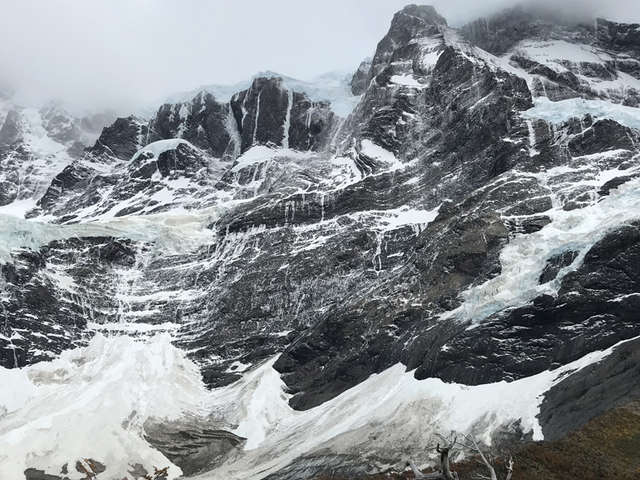
Mount Paine Grande
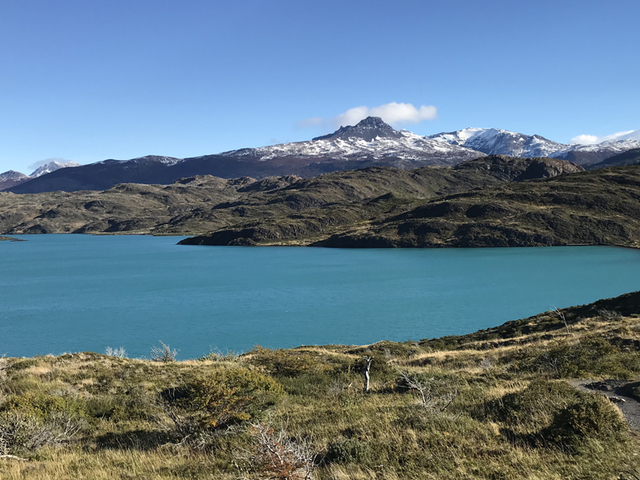
Approaching The French Valeey
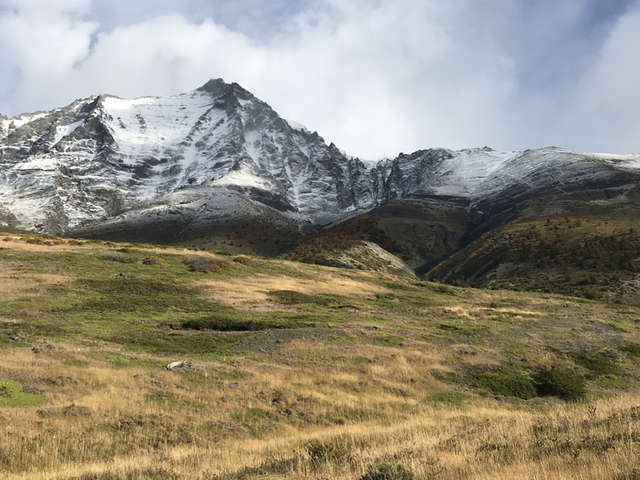
Admiral Nieto Mountain
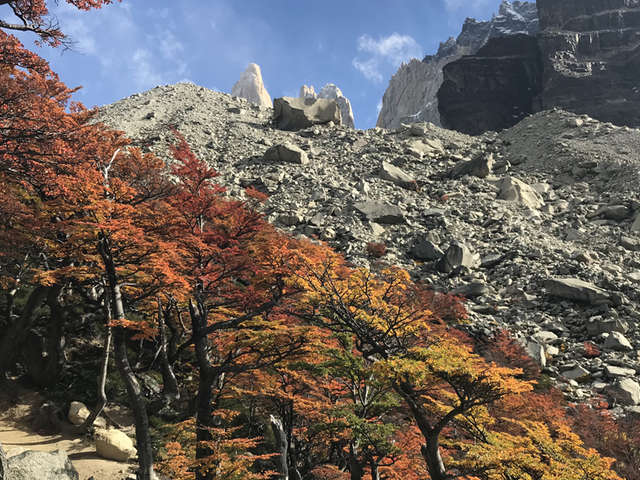
Approaching The Base Of The Towers

Share this via
- StumbleUpon
Grab the Webpage Link:
- Full Itinerary
- Equipment List
What's Included?
- All ground transportation by local bus (Private option available)
- Entrance fee to Torres del Paine National Park
- Two nights in Torres del Paine National Park (camping/lodges
- Catamaran ticket Pehoe Lake
- Meals as mentioned on the itinerary
- English speaking guide (Self-Guided option available)
- Local taxes
- Patagonia Hero T-shirt
Day 1: Puerto Natales to Refugio Chileno
Day 2: refugio chileno to refugio los cuernos, day 3: refugio los cuernos - paine grande and puerto natales.
- Internet at the Refugios
- International flights
- Alcoholic drinks
- Travel Insurance
- Accommodation in Puerto Natales
- Porters ($125 per day)
On the Trail Daypack
- Extra layers
- Windbreaker
- Lip Balm with Sunscreen
- Broad brimmed hat or bandana (for sun protection)
- Iodine Water Tablets (personal preference)
- Water Bottles or Camel Back
- Headlamp with extra batteries Favorite Snacks
- Waterproof bags to protect electronics or paperwork
- Camera with extra batteries and memory cards
- Umbrella (works great in a light rain or to protect from the sun)
- Toilet Paper
- Thermos (optional for hot beverages)
- Small Lock(s) for day pack
- Waterproof cover for daypack
Clothing: Base, Middle, and Outer Layers
- Moisture-wicking long sleeve tee-shirts (1) Moisture wicking tee-shirts (1)
- Long underwear pants (1)
- Underwear (3 to 4)
- Heavy Fleece or Down Jacket
- Long sleeve shirts (2)
- Sweatshirt (optional)
- Fleece Pants (Winter Treks)
- Trekking Pants (2)
- Shorts (optional)
- Gortex or Waterproof Jacket with hood Rain Poncho that covers your daypack Waterproof Pants
- Wide-brimmed hat
- Wool hat (Should cover ears) or Balaclava
- Lightweight Gloves
- Insulated Wool or Down Mittens (Winter Treks)
- Gaiters (optional)
Footwear: Shoes and Socks
- Hiking boots with ankle support
- Camp shoes or Tennis Shoes
- Plastic bag to carry spare shoes Hiking socks (6)
- Sock Liners (optional)
First Aid Kit and Toiletries
- Advil or Ibuprofen
- Personal Prescriptions
- Medical Tape (for preventing treating blisters)
- Antibiotics (Cipro for travelers' diarrhea)
- Diaper Rash Cream (Can treat rashes or chaffing)
- Basic toiletries (Soap, Deodorant...)
- Panty Liners and Tampons
- Face lotion
- Hand warmers
- Ear plugs for sleeping
- Lip Balm with sunscreen
- Toilet paper
Paperwork and Money
- Passport (needed at entry gate for registration) Spending Money around $200
Other Items
- Portable Solar Charger Journal, pen and paper
- Stuff sacks for dirty clothes/shoes
- Have a big group? We can help.
- We can customize the trip as per your need.
- We can help you make it fit your budget.

- Best Price & Value
- Comfortable Accommodation
- Have a Big Group? We can help.
- Top Notch Customer Service
- Trip designed for Your Family
Why book with us?
Getting the best price is great, getting the best value is even better. We have local office in Chile to provide the support and service you expect.
We handle all sorts of group requests and can help you customize the perfect trek whatever your group size or needs.
Our team is standing by 24/7 to assist from the time you inquire about a trek until the last day. Our goal is to ensure everyone has a great trekking experience.
- Privacy Policy
- Terms & Conditions

Tour details
- What to bring
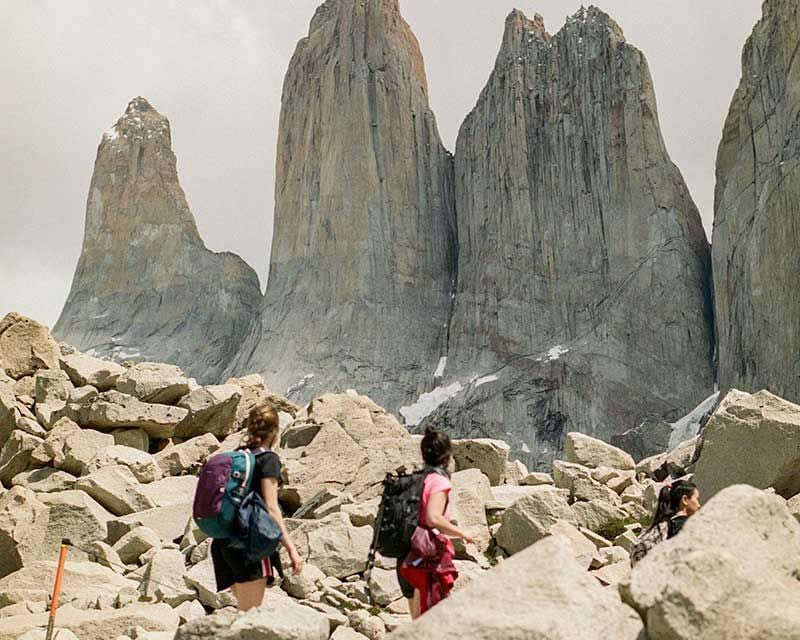
W Trek in 3 Days
The shortest and cheapest way to walk the W trek in 3 Days
Travel the W Circuit from the Central Sector to Paine Grande or to the first viewpoint of the Grey Glacier in only 3 days with this self-guided tour.
The W Circuit Torres del Paine 3 Days includes all the necessary services to enjoy the route: transfers from Puerto Natales, entrance to the Park, full board accommodation and even a welcome kit.
Lodging can be in a camping site (ready to use, with all the equipment) or in a shared room in a refugio (mountain hostel). The first night you will stay in the Central Sector and the second in the French Sector .
If your visit to Puerto Natales is short, this tour is what you need to get to know the Torres del Paine National Park and to cover almost the entire famous W Circuit in only 3 days. With this short version of the W Circuit you will not be able to walk the entire route, so on the third day you will have to decide whether to go to the French and British viewpoints or to the first viewpoint of the Grey Glacier . If you want to book a tour that covers the entire W route you can see all the tours in Torres del Paine .
- Park access ticket
- Transfer by bus from Puerto Natales to Torres del Paine (round trip).
- Catamaran ticket (Paine Grande - Pudeto)
- 1 night of lodging in Central Sector
- 1 night of lodging in Francés Sector
- Full board (2 breakfasts, 2 lunches, 2 dinners)
- Welcome Kit (towel + liner + refillable bottle + notebook + map)
Not included
- Lunch day 1
- Breakfast day 1
- Dinner day 3
- Guide (available as extra)
- Luggage porter (available as extra)
Important information
Lodging options:
Camping: includes all camping equipment: sleeping bag, sleeping pad, tent already set up. They are tents with capacity for 2 people and you will be assigned a tent just for you in case you are a single person.
Refugio: these are shared rooms with 4 or 6 beds and include sheets and blankets or sleeping bags, depending on the refugio.
Cancellation policy
Free cancellation!
If you cancel at least 60 days before the start of the tour, you will receive a 100% refund of the amount paid. If you cancel between 59 and 45 days before the start of the tour, you will receive a 50% refund of the amount paid. After this time or in case of not doing the activity, no refund will be made and it will not be possible to modify the reservation.
Reservation modifications are subject to the cancellation policies indicated, applying the corresponding penalty in each case depending on how far in advance the cancellation is requested.
Tour itinerary
Welcome W Trek in 3 Days
We know that a 3-day mountain route needs a good planning, that's why a briefing (explanation of the tour) is done in person or online.
In addition, a few days before your arrival in Puerto Natales you will receive an email with instructions to pick up your welcome kit (which includes tickets, map, metal bottle...) and solve any last minute doubts you may have.
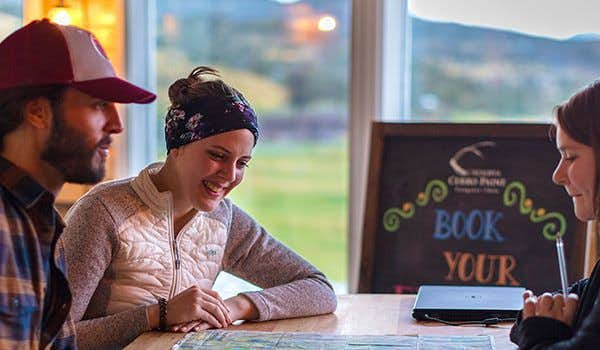
DAY 1 Puerto Natales - Trekking Base Torres del Paine
Difficulty: High
Distance: 13,67 mi. (22 km)
Total approximate time: 9:00 hours
Positive elevation gain: 3517,06 ft. (1.072m)
Lodging: Central Sector
✨ Highlights: Base Torres Lookout Point
Access to Torres del Paine National Park
The first day of the 3-day W Torres del Paine trek starts early. You will have to go to the bus station in Puerto Natales , where you will take the bus to the park departing at 07:00 in the morning.
The bus will take you to the Laguna Amarga welcome center. There you will register as a visitor and enter the park.
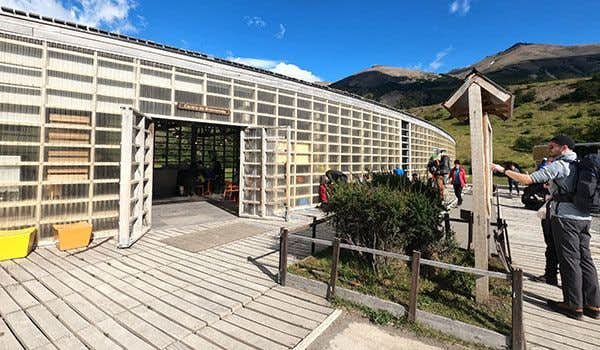
Torres del Paine Base Trekking
Once inside the park, you will take a minibus to the Welcome Center, and from there you will start the Base Torres del Paine trekking.
The route of the first day will be the iconic ascent to the Base Torres viewpoint. 13.67 mi (22 km) of the route is divided into 3 parts: initial slope, descent, and final ascent.
The trail will start flat for 1.24 mi (2 km). You will cross the Ascencio Valley until you reach the first steep stretch. This will be followed by a 1.86 mi (3 km) of trail until you reach the Paso de los Vientos.
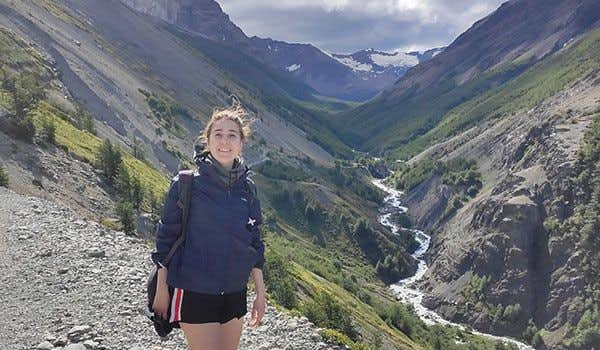
Lenga Forest - La Morrena - Base Torres Viewpoint
You will continue along a flat stretch of 2.48 mi (4 km.) that passes through the area of the Chileno Sector. You will enter an entirely different ecosystem when the trail crosses a lenga forest and ends at the beginning of the third section. We recommend you stop here and refill your water before facing the final stretch.
For almost 1.25 mi (2 km) you will find your own path between big rocks. The slope is hard but the reward is even better: you will reach the viewpoint Base Torres del Paine.
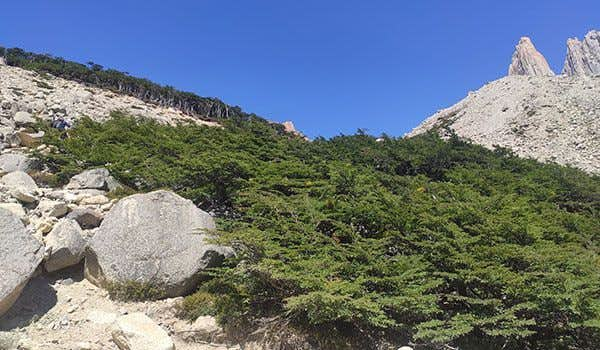
Torres del Paine Base Viewpoint
From this viewpoint you can enjoy views of the famous granite towers that give the national park its name and the Torres del Paine Lake.
Central Sector
After the break, you will start your way back along the same trail, until you reach the Central Sector, where you will have to check in at the reception of the refuge and you will be assigned your time for dinner and breakfast the next day. Afterward, you will have free time to rest, shower, have a drink at the bar, and have dinner.
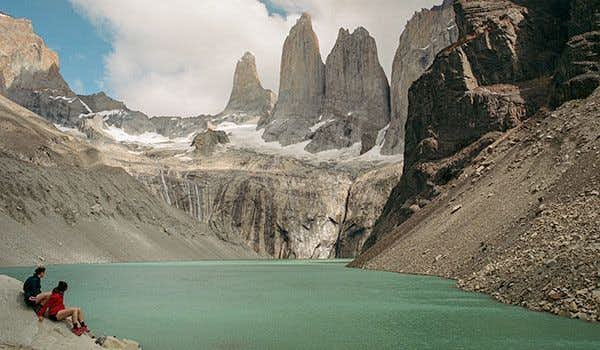
DAY 2 Francés Sector Trekking
Difficulty: Medium
Distance: 10,5 mi. (17 km)
Total approximate time: 6:30 hours.
Positive elevation gain: 1706 ft. (520 m.)
Lodging: Francés Sector
✨ Highlights: Lake Nordenskjöld
Breakfast Central Sector
If you are staying in CAMPING or REFUGIO, you will have breakfast at Refugio Central at the time assigned at check-in (between 7:30 AM and 8:30 AM). At the end, you will pick up your lunch box.
After breakfast, you will start the second day's trek, one of the least demanding of the 3-day W circuit.
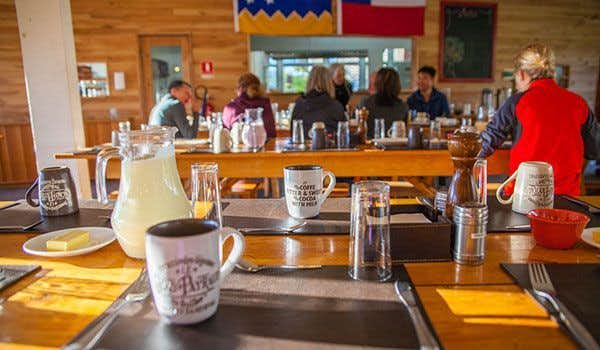
Lake Nordenskjöld
After breakfast, the second day of the express version of the Torres del Paine W trek begins. This will be the least demanding day. You will encounter very little elevation gain and the trail is in very good condition. You will walk along the Nordenskjöld Lake, cross a small river, and walk some stretches along the beaches that form next to the lake.
Almirante Nieto Mountain - Cuernos del Paine
During most of the day the background scenery will be Cerro Almirante Nieto and the Cuernos del Paine.
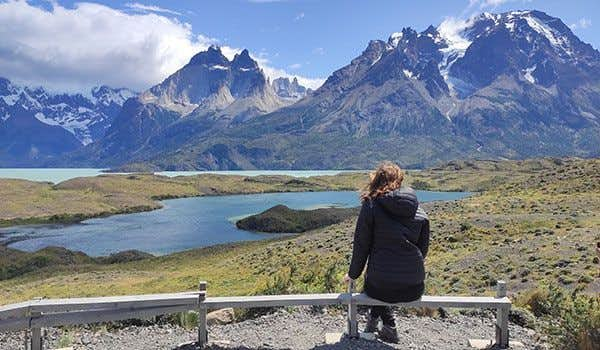
Francés Sector in Torres del Paine
When you arrive at the Francés Sector of Torres del Paine National Park, you will find yourself in one of the most welcoming refuges of the W route through Chilean Patagonia.
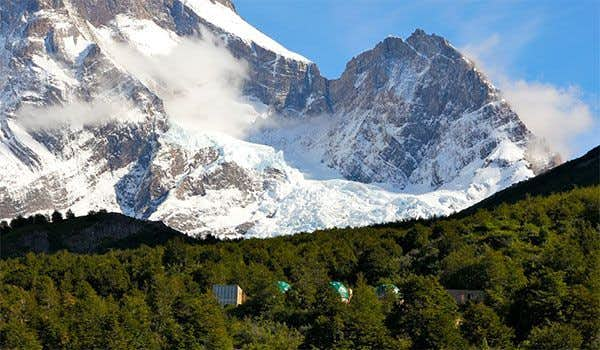
DAY 3 👆💬 To be noted
🔴OPTION 1: Trekking French & British Lookout Point
🔵OPTION 2: Trekking 1st Grey Glacier Viewpoint
The third and last day of the W Trek in 3 Days you will have to choose between one of the two treks proposed below. Being a reduced version of the W route, it is not possible to reach both viewpoints due to lack of time.
Leaving from the Francés Sector, OPTION 1 will be the French Valley Trek to the British Viewpoint. From here, you will start your way down to Paine Grande, where you will take the catamaran that will take you to Pudeto.
With OPTION 2, you will leave the Francés Sector, and passing through Paine Grande, you will reach the first viewpoint of the Grey Glacier. Then you will return to Paine Grande to take the catamaran.
⭐ If you want to do both treks and reach both viewpoints it is necessary to take a longer tour. Here you can see all the available options.
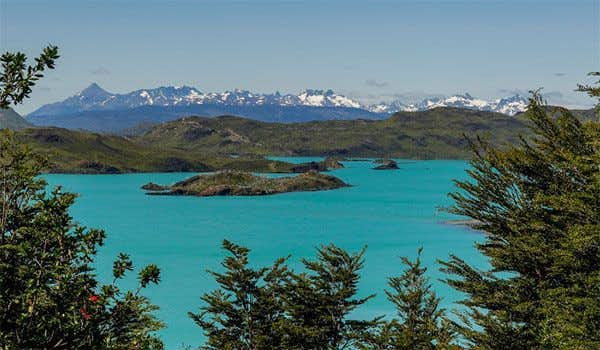
DAY 3 🔴 OPTION 1 Trekking French & British Lookout Point
Difficulty: Medium-High
Distance: 14 mi (23 km)
Total approximate time: 8 hours.
Positive elevation gain: 2624 ft. (800 m.)
✨ Highlights: French Lookout + British Lookout.
Italian Camp → British Lookout
After breakfast, the day begins with a gentle hike from the Francés Sector to the Italian Camp. From the Francés Sector, you will take a 0.87 mi (1.4 km.) trail that will take you to the intersection where the trail splits, one trail ascends to the French and British viewpoint and the other continues to Paine Grande.
You will take the ascent to the viewpoints, and walk 0.62 mi (1 km.) to the "Campamento Italiano". This camp is for the exclusive use of CONAF park rangers and offers a "nursery" service, where many travelers leave their large backpacks so as not to carry them during the hike up to the viewpoints.
From there, the hike to the French lookout begins, a 1.55 mi (2.5 km) walk with 984 ft (300 m) of elevation gain.
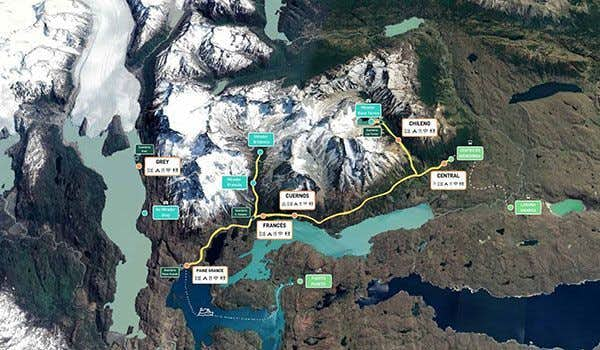
Torres del Paine British Lookout
When you reach the French viewpoint, you can continue to the British viewpoint. The route is 1.86 mi (3 km) long with 920 (280 m) of elevation gain. When you reach the viewpoint, you will find a rocky area where you can climb to take the best picture of the British viewpoint and enjoy the best views.
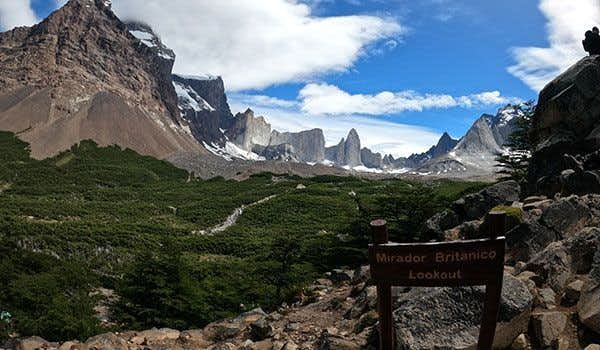
Skottsberg Lake
To finish the route of the fourth day of the circuit, you will return by the same path and pick up the backpack from the "nursery". Afterwards, you will continue walking the remaining 9 km to the Paine Grande refuge with a slight negative slope that your legs will appreciate. You will cross a sector that suffered a fire a few years ago where the tree trunks create a somewhat gloomy landscape.
Paine Grande Refuge
You will skirt part of the lake until you finally reach the Paine Grande Sector.
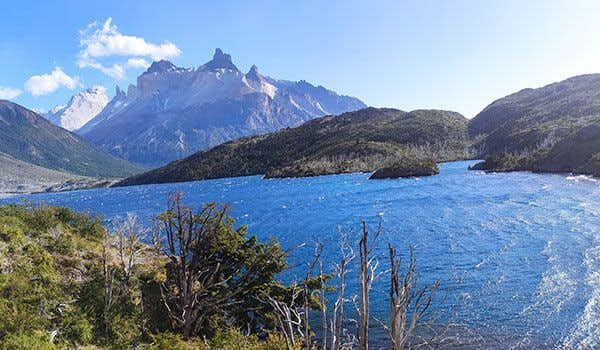
Paine Grande 🚢 Pudeto 🚌 Puerto Natales
Once in Paine Grande you will have to go to the pier to take the catamaran that will take you to Pudeto (the catamaran ticket is included in the tour price). In Pudeto, you will board the bus that will take you back to Puerto Natales, where you will arrive at 21:30.
It is important that you calculate your walking time well and that you arrive at the pier at least 20 minutes before the departure of the catamaran. The exact departure time will be confirmed at the briefing.
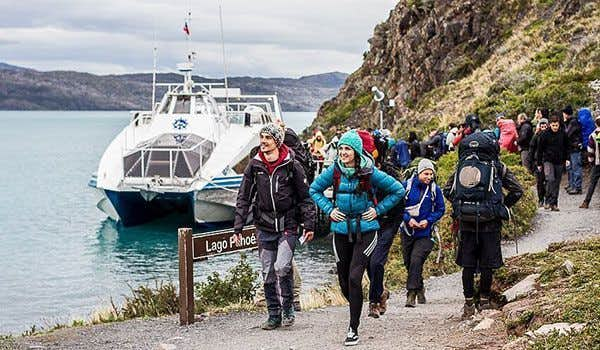
DAY 3 🔵 OPTION 2 Trekking 1st Mirador Grey
Distance: 19,57 mi. (31.5 km.)
Approximate total time: 8-10 hours.
Positive elevation gain: 885,82 ft. (270 m.)
✨ Highlights: 1st Mirador Grey
Francés Sector → Paine Grande Sector
After breakfast in the dining room of the Refugio Francés and picking up your lunch box, you will start the route along the Skottsberg Lake until you reach the Paine Grande Sector.
This first stretch will be calmer, as you will hardly find any slope. Upon arrival at the Paine Grande Refuge, the real challenge will begin: climbing up to the first Grey Glacier viewpoint.
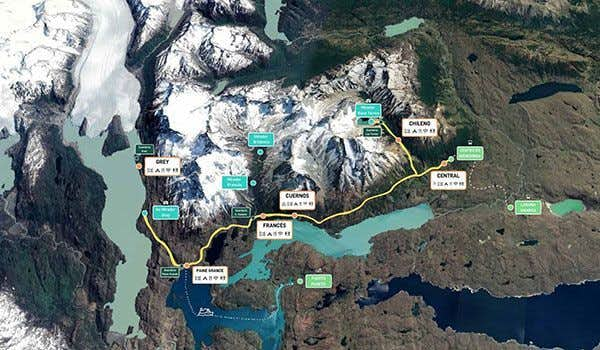
1st Grey Viewpoint
You will skirt around Cerro Paine Grande, enjoying the spectacular hanging glaciers. You will walk among Nirres, Coigües and Notros. When you leave the grove, you will reach the end of your path: the first viewpoint over Grey Lake. From here you will be able to admire the magnitude of this glacier and see its ice floes floating on Lake Grey.
Take advantage of this idyllic location to enjoy your lunch box, and after the break, you will start your way back to Paine Grande.
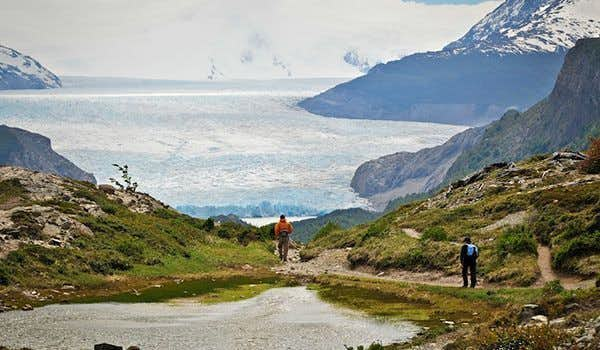
Once in Paine Grande, you will have to go to the pier to take the catamaran that will take you to Pudeto (the catamaran ticket is included in the tour price). In Pudeto, you will board the bus that will take you back to Puerto Natales, where you will arrive at 21:30.
It is important that you calculate your walking time well and that you arrive at the pier at least 20 minutes before the departure of the catamaran.
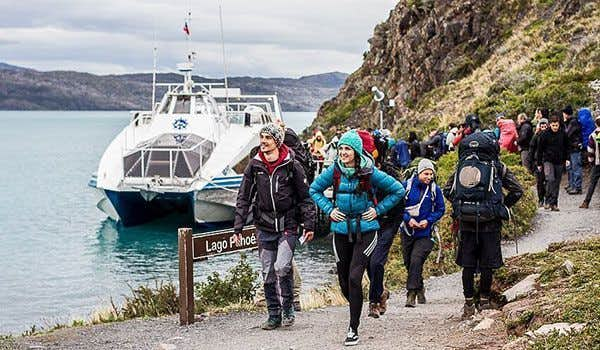
What to bring to W Trek in 3 Days
- PDI: Migratory card (foreign travelers not residing in Chile)
- Accommodation reservation ticket
- Hiking pants: thin or short.
- Long hiking pants for extra warmth
- First layer: thermal T-shirt
- Middle layer: polar fleece or similar
- Outer layer: waterproof jacket
- Warm jacket or fleece
- Mountain footwear (waterproof boots if possible)
- Resting slippers
- Sandals (for showers)
- Personal hygiene products
- Flashlight and battery (especially useful in campgrounds)
- Walking sticks
- Cash (USD or CLP)
- Medium trekking backpack (40 liters approx.)
- Small trekking backpack (15 liters) for use in the sections with return to the same sector.
- Long/short sleeve T-shirts
Where does the tour W Trek in 3 Days start
The tour starts in the city of Puerto Natales. If you are traveling from Santiago de Chile the best option is to take a flight to Punta Arenas, and from there you can take a bus that in only 3:15 hours will take you to the bus station in Puerto Natales or hire a private transportation service with us .
If you are traveling from El Calafate (Argentina), there are buses that connect directly to Puerto Natales in a 5 hour trip or you can book with us the transfer from El Calafate to Puerto Natales or the direct transfer between El Calafate and Torres del Paine .
Questions & Answers
My dates are not available, is there an alternative, can i do the 3-day w circuit tour in the opposite direction, what are the lodges in torres del paine national park like, do i have a private room in the lodges, how are the campsites in torres del paine national park, is lunch included and where do you eat at lunchtime, what food is included in the lunch box, what documentation do i need to bring to access torres del paine national park, do i have to carry all my luggage to torres del paine, do i have to carry my backpack for the entire tour, where do i leave my luggage in that case, can i do the w circuit 3 days with a guide or porter, is the porter service only offered for 2 days, what is a self-guided tour, where does the bus to torres del paine national park leave from, do i have to carry a lot of water, do i have to carry my camping equipment during the tour, w trek in 3 days tour reviews with howlanders, other tours that might interest you from chile.
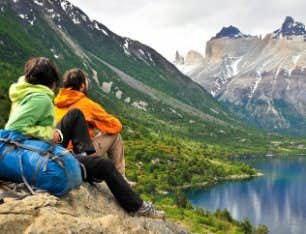
W trek circuit in Torres del Paine (short version)
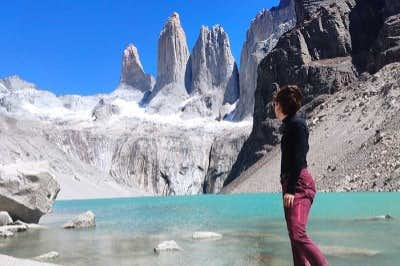
Torres del Paine W Trek
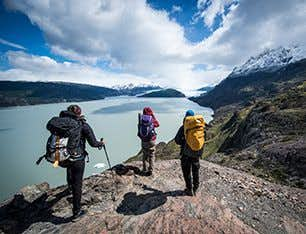
Torres del Paine W Trek 6-Day Tour
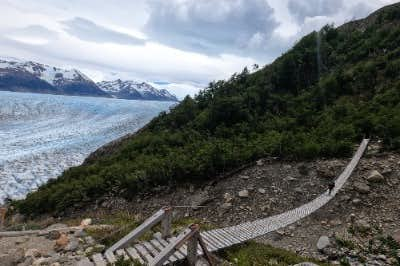
O Circuit Torres del Paine
Other travelers also booked.
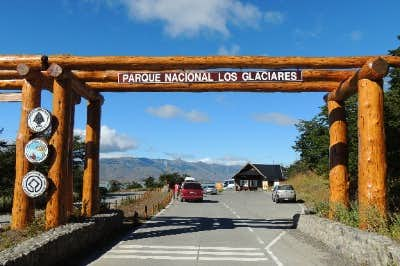
Full Day Perito Moreno Puerto Natales
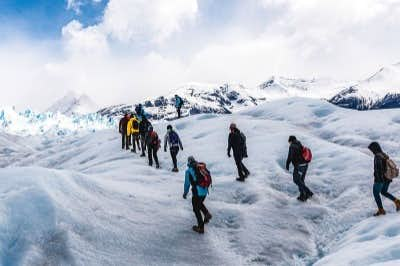
Minitrekking Perito Moreno
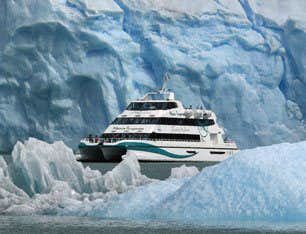
Glaciares Gourmet boat tour
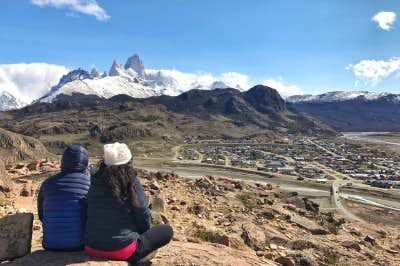
El Chaltén Day Trip
- USA/Canada 1-888-232-3813
- Walking & Hiking
- Wildlife and Nature
- Multiactivity
- Photo Safari
- Excepcional Journey
- Water Adventures
- Food & Wine
- City Escapes
- Winter Adventures
- EcoCamp Patagonia
- Argentine Patagonia
- Chilean Patagonia
- Atacama Desert
- Santiago and Central Valley
- Easter Island
- Lake District
- Multidestination
- Northwest Argentina
- Uyuni Salt Flats, Bolivia
- For Families
- For Couples
- For Friends
- For Solo Travelers
- Central Valley
- Wildlife & Nature
- News & Awards
- Sustainability
- Outdoor Sports
- Yoga & Wellness

All You Need to Know Before Hiking the W Trek in Patagonia (2023 Upd.)
Posts by tag.
- Patagonia (74)
- Inspire (50)
- Wildlife & Nature (28)
- News & Awards (25)
- Food & Wine (20)
- Outdoor Sports (20)
- Central Valley (16)
- Culture (14)
- Atacama Desert (13)
- Sustainability (8)
- Lake District (5)
- Yoga & Wellness (5)
- Easter Island (3)
- Bolivia (1)
Looking for the most complete information on the W Trek in Patagonia, the most famous multiday hike in Chile? You’ve found the right place!
1. Where is the W Trek located?
2. When is the best time to hike the W Trek?
3. Where to stay on the W Trek?
4. how difficult is the w trek, 5. what should i pack for the w trek.
6. How long does it take to hike the W Trek?
7. What are the highlights of the W Trek?
8. should i do the w trek with a guide, 9. w trek vs o trek : which should i choose, 10. how to book the w trek.
The W Trek in Torres del Paine is undoubtedly one of the best treks in Patagonia. This “W” shaped hiking trail highlights the best of Torres del Paine National Park, including Grey glacier, the French Valley and the Towers’ Base Viewpoint. Here, you will spend up to 8 hours a day hiking in the wild, but with some of the world’s most stunning viewpoints, there is no way you’ll get bored.
And while the surreal beauty of Torres del Paine made it a popular destination amongst hikers (and non-hikers!) Patagonia's finest national park still offers plenty of opportunities to disconnect from civilization and reconnect with wilderness, in landscapes more dramatic than Mordor and Westeros combined.
.jpg?width=2048&name=48449554592_2b21f8035d_k%20(1).jpg)
Yet more and more travelers suffer a lack of preparation that can potentially ruin the experience. It is not (so) unusual to see hikers going up the mountain wearing a blue jean, or people with only a T-Shirt to protect themselves in a snowstorm. And because we don’t want anything like it to happen, we designed the most complete article to answer your most common questions, so you have a blast on your W Trek!
Ready for a hike of a lifetime?
The trails of the W Trek are located in Torres del Paine National Park in Chilean Patagonia . The park – an area of 1,814 km2 (700 sq.mi.) - encompasses blue lakes, glaciers, lakes and rivers in the Magallanes Region. It is the southernmost region in Chile, which means the trip to get there is rather long.
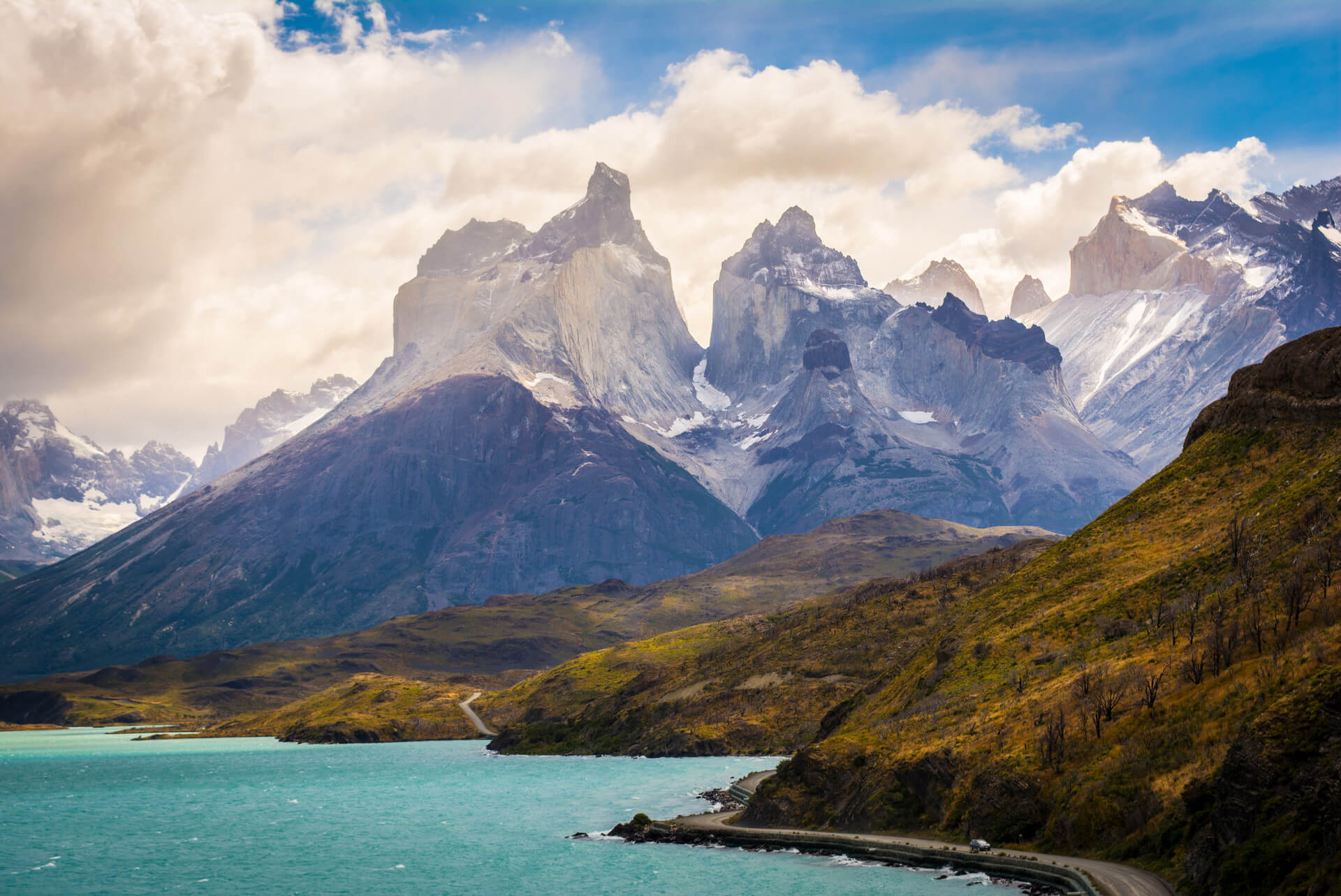
Now, how do I get there?
Good question! The trip to get to Torres del Paine is indeed long, but connectivity has improved a lot within the last few years. Most travelers fly from Santiago de Chile to Punta Arenas, a 3-hour flight. From there it’s a 5-hour drive to reach Torres del Paine. There is also the option to fly to Puerto Natales, from which you will only need a 2-hour drive, but this option is mainly available in high season (November to March).
If you come from El Calafate in Argentina, you can cross the border by driving through Cerro Castillo or Paso Dorotea (near Puerto Natales), an overall 4 to 5-hour trip.
2. When is the best time to do the W Trek?
The best time to visit Torres del Paine is incredibly hard to define. The region’s notorious weather can change in the blink of an eye and each season has its advantage and drawbacks. With that in mind, it is useful to understand the meaning of “season” here.
Peak season goes from December to February, with the greatest amount of tourists on the trails. The viewpoints are more crowded which can impact the experience negatively, but it’s also a great time to socialize with longer days (there are up to 17 hours of daylight in summer). It is also more expensive and hotels and refuges tend to be (very) busy.
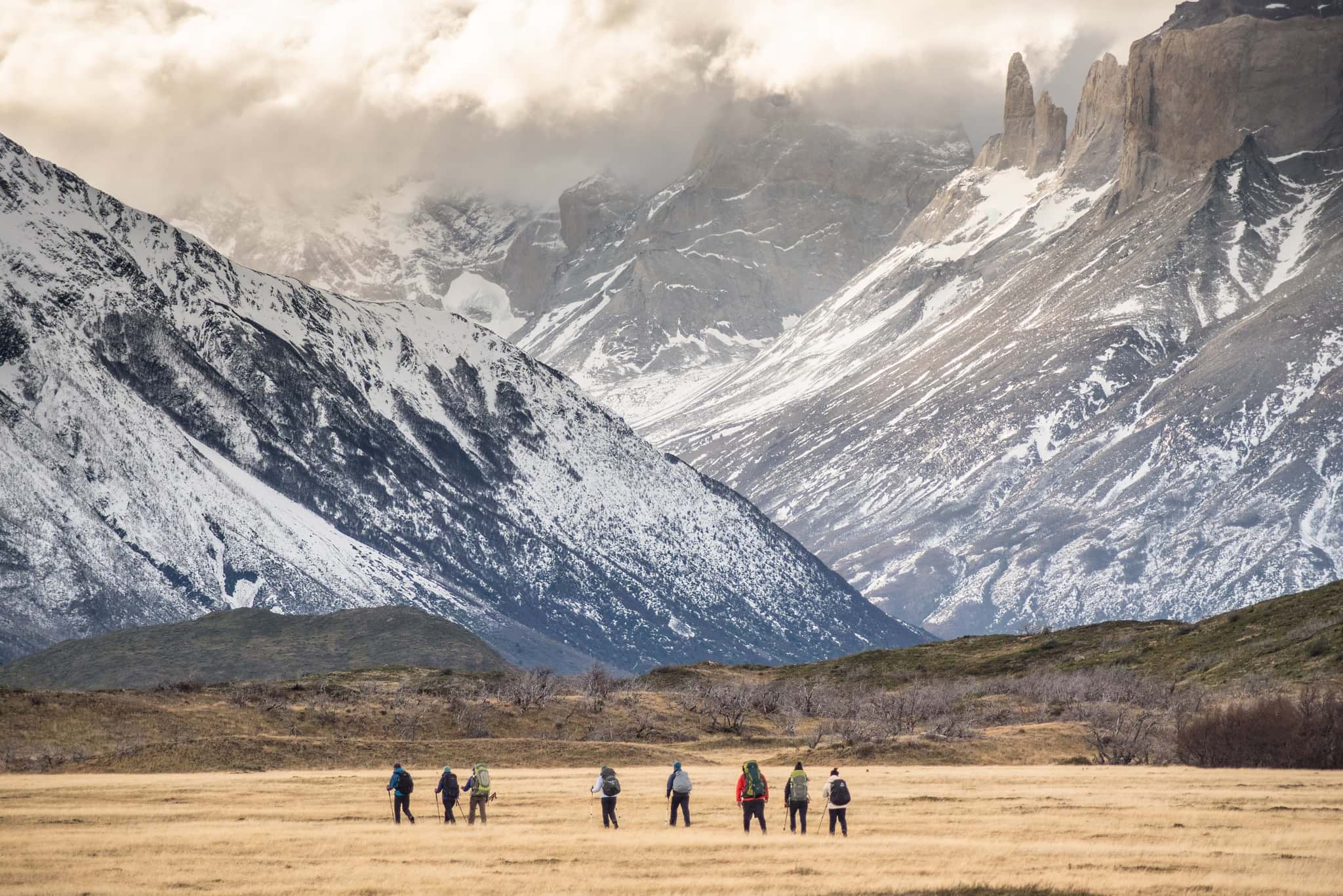
November and March are still relatively busy and considered high season. As for the low season, it includes the months of September, October, April and May. Most hotels - like EcoCamp - are still open and you will find tranquility on the trails. Off-Season (late May to August) is Winter, with most hotels closed but there is still the option to do a Winter W Trek, if you’re looking for the wildest experience in Patagonia.
As for the weather, there is not one truth but a few trends. Summer is the warmest time of the year with the least precipitations, but has the strongest winds (winds of up to 150km/h / 95mi/h are usual). Autumn ( April /May) is fresh but also incredibly colorful, with less wind and less crowds. Same for the months of September and October (late Winter/early Spring), where you’ll also get more wildlife sighting opportunities.
Check out our article featuring the details on the best time to visit Torres del Paine to be fully informed!
The coziest way to experience the W Trek is to stay in a hotel in the national park, and we can only recommend EcoCamp Patagonia , the world’s first geodesic dome hotel. Here, you’ll spend the night in a dome with a view of the spectacular granite spires that gave the national park its name. You’ll also socialize with fellow travelers in the community domes and minimize your impact on the area as EcoCamp is a sustainable hotel.
.jpg?width=860&name=49305888691_16782575ba_k%20(1).jpg)
However, you can’t spend every night in a hotel on the W Trek. Luckily, there are some nice places to stay along the way, namely campsites and refuges . Both options are in the same spots (for every refuge, there is a campsite nearby).
Refuges – locally called “refugios” – are basically mountain huts, but in Torres del Paine they are more like guest houses. They are rustic in a certain way yet they offer plenty of comfort with warm beds and nice communal areas, where you can buy dinner (a good one) and relax near the wood stove. Accommodation is in shared dorms, but there is the possibility to upgrade to private alternatives. There are five refuges/campsites on the W Trek: Grey, Paine Grande, Frances, Cuernos and Central.
Take a look at our post that features everything you need to know about refugios .
The W Trek is not a difficult or technical trek. Hiking the W Trek doesn’t require you to be a pro, but some hiking experience is highly recommended. Compared to lots of other hiking destinations in South America – especially in the Andes mountains – Patagonia is low altitude.
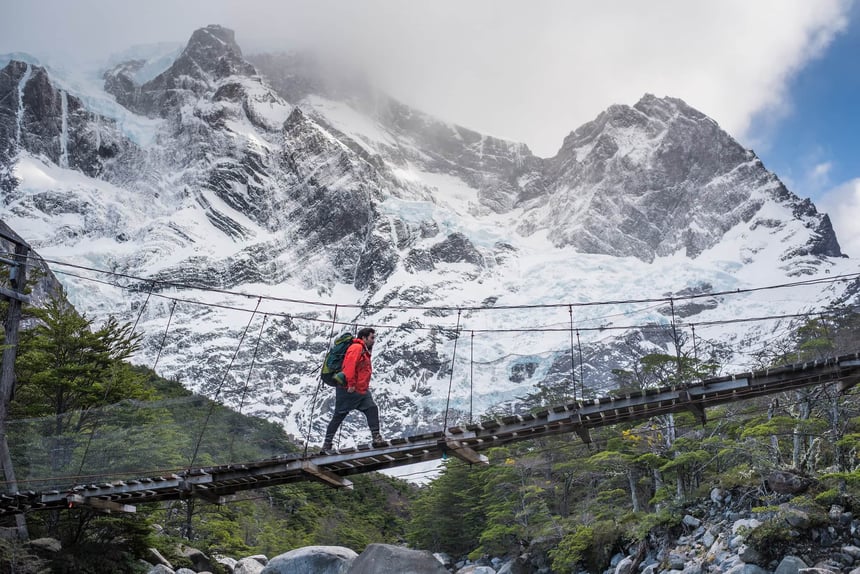
The highest point of the W Trek is the towers’ base viewpoint, at 850m.a.s.l (2788 ft). However, some days are long with lots of walking up, especially the French Valley and the Towers’ Base. Both these hikes require an 8-hour walk (round trip), so you should be used to hiking an entire day. Endurance and stamina matter a lot, even though it is easier than the full Torres del Paine Circuit (“O Trek”), designed for the most adventurous.
Read our post about training for the W Trek for the optimum preparation.
And don’t forget that the weather is a key aspect when it comes to the difficulty level of the W Trek, which is why you need to be prepared with the right gear.
Note: if you hike the W Trek with Cascada Expediciones you will be provided with much of the food and equipment that independent hikers must bring for themselves. If you’re an independent hiker, check out this post .
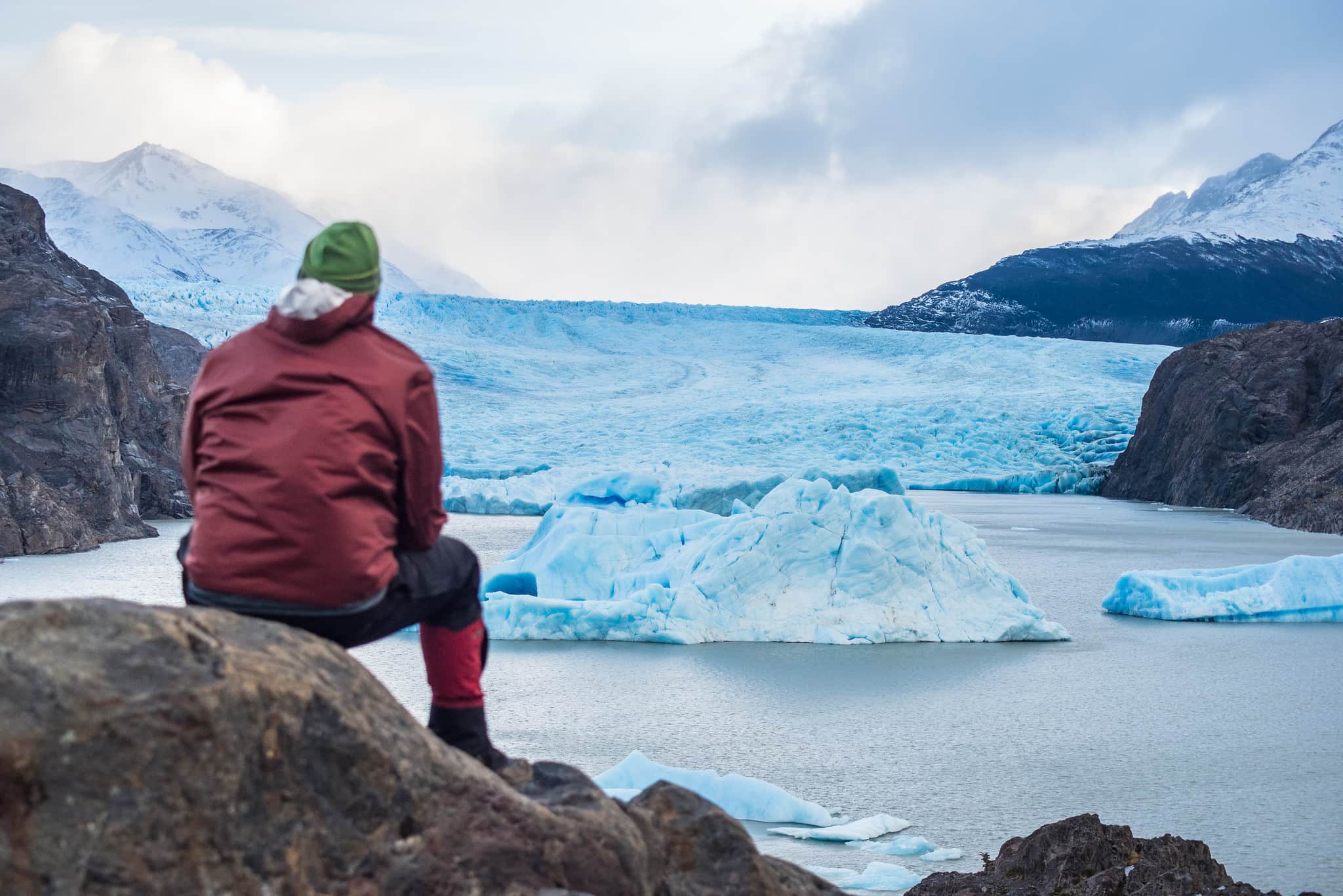
You should always follow the rule of the 3 layers . The weather is unpredictable so you must be able to remove or add a layer as quickly as the weather changes.
Base Layer: must keep you covered and ensure that perspiration is drawn away from the body.
Mid Layer: must retain the body heat you generate (also called insulating layer). A fleece jacket or medium weight sweater is ideal.
Outer Layer: must protect you from the elements, especially the wind and the rain. A lightweight waterproof layer is always a good idea.
It’s true you should “pack for four seasons”, but consider packing as light as possible. Do not overpack. Hiking poles are highly recommended to protect your knees, and so is sun protection (of at least 30SPF) as the sun can be incredibly powerful here in the south.
Bring a good backpack (between 50 to 80 liters), hopefully a waterproof one. And consider bringing at least one dry bag. Here, the cocktail “wind & rain” can have you soaked within minutes.
If you want to pack like a pro, check out our video below and read our post “What Gear Should You Bring to Patagonia”
6. How long does it take to hike the W Trek?
The full W Trek typically includes 5 days hiking with a total distance of 76km/47mi.
Our 7-Day W Trek includes 2 days of traveling to/from EcoCamp and 5 days hiking. This is the complete W Trek that also features one day of easy hiking and leisurely car journey towards Laguna Azul, on the eastern side of the park. It’s always great to consider an additional day to enjoy the panoramic views of the mountain range which you can’t get on the W Trek!
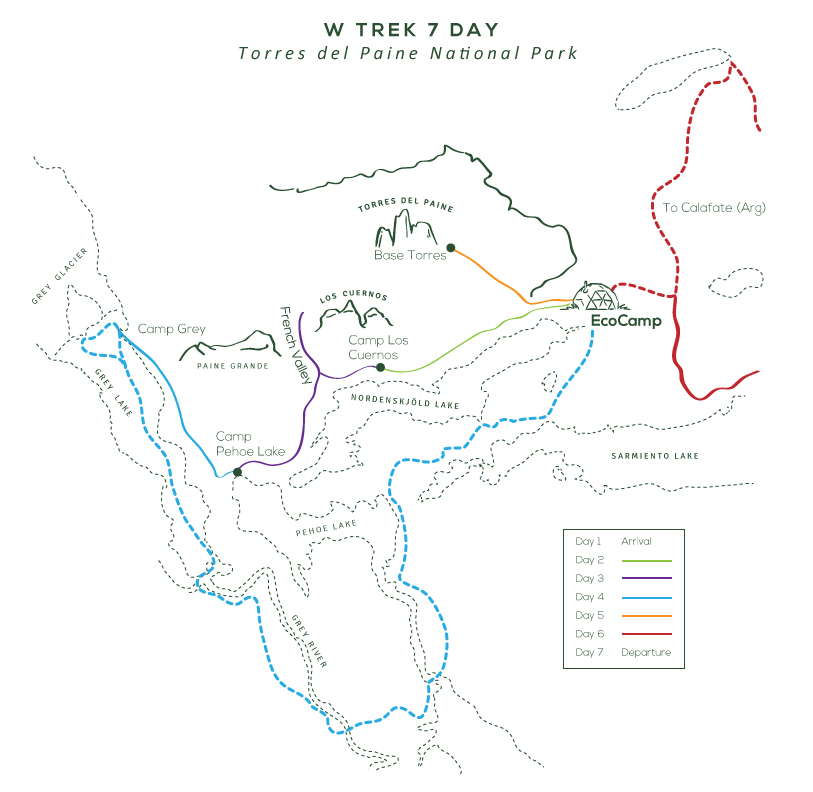
But the W Trek can also be completed within 3 full days hiking. We offer a shorter 5-Day W Trek that focuses on the highlights of the W (Grey Glacier/French Valley/Towers Base), with a distance of 60km/37mi.
Check out the differences between the 5-Day and the 7-Day W Trek .
EcoCamp Patagonia - Torres del Paine W Trek Comparison Chart
The W Trek takes hikers past some of the best sights in Chilean Patagonia. The most famous highlight is the towers’ base, a 22km/13mi demanding hike through a lush green valley with the most rewarding views of the three granite towers that gave the national park its name. But the other highlights are just as beautiful.
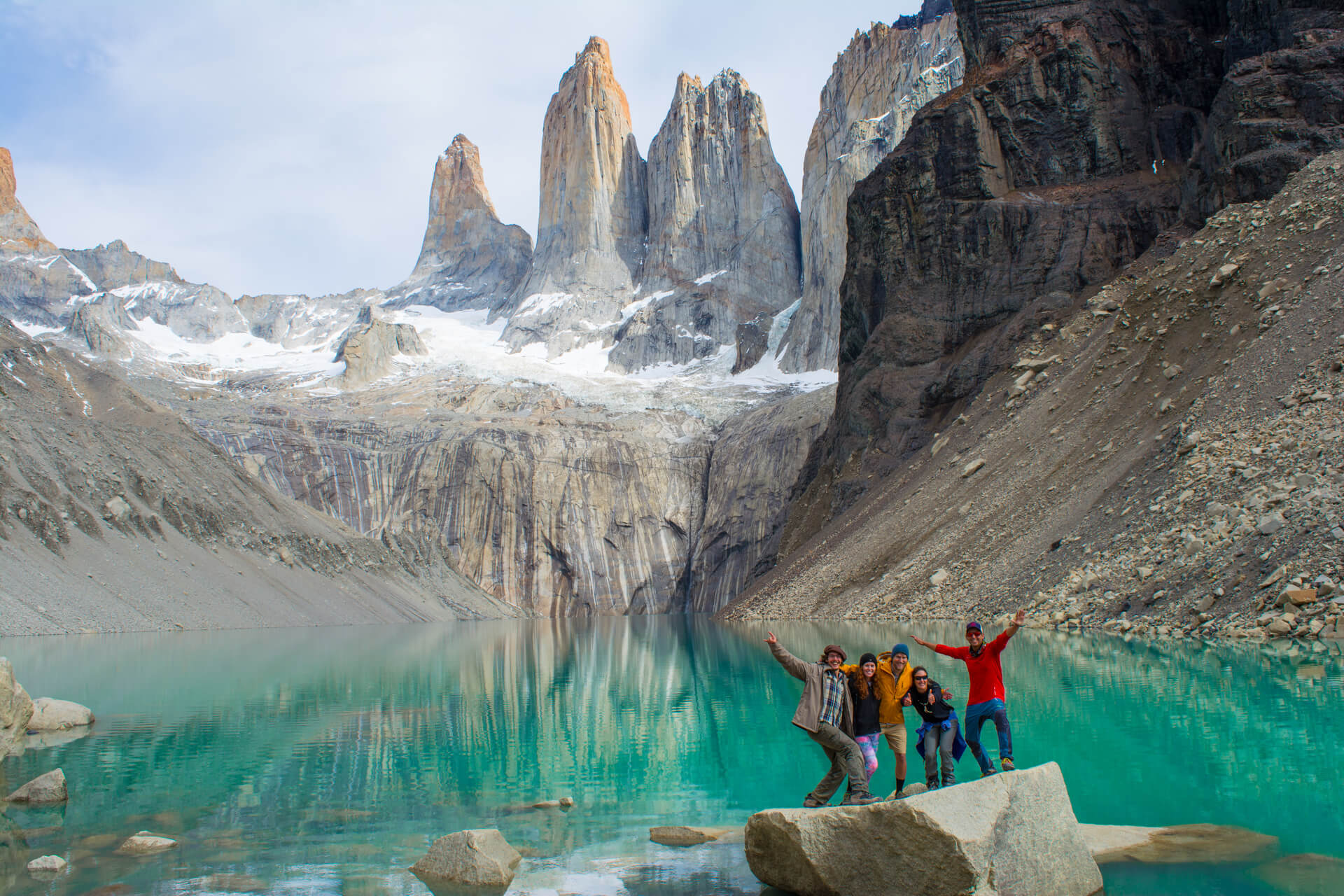
The hike through French Valley offers a stunning view of a hanging glacier that comes straight from Paine Grande, the highest peak in the region (3050m.a.s.l / 10.000ft). A cool spot to witness some tremendous avalanches. There are also some mesmerizing views of the Horns (“Los Cuernos”) on the way, the other impressive spires that made the park so famous.
Grey Glacier is another highlight. This fast retreating glacier is still massive enough to impress every traveler. A full-day hike will take you to a panoramic view of the glacier walls, but the best way to see Grey glacier is by boat, while opting for the navigation (this option is included in our programs). This 3-hour boat trip will take you to the 3 faces of the glacier, which is impossible by foot.
Finally, a stay at EcoCamp Patagonia is also a highlight, for a sustainable rest in a geodesic dome and the opportunity to have fun with fellow travelers in a gorgeous place.
While it is possible to opt for a self-guided W Trek, we highly recommend to book a guided tour. Though the W Trek is not a difficult trek, a guide will improve the experience while showing you some hidden gems of Torres del Paine. Whenever it has to do with geology, wildlife or history, Torres del Paine is a fantastic place to study and a guide will provide you with all this amazing information.
.jpg?width=2048&name=47105939174_b978efbfe1_k%20(1).jpg)
Also, a guided W Trek is more comfortable. A tour with Cascada means you’ll have to carry less weight (we’ll help you with some kilos), you won’t have to concern for the logistics, you’ll get some delicious food and you’ll get the security of an experienced guide.
Finally, booking a W Trek with Cascada will have you stay at least 3 nights in a cozy dome at EcoCamp and if you choose to stay in campsites, you won’t have to bother setting up your tent: we’ll do it for you!
You might not be familiar with the other famous trek in the national park, the Torres del Paine circuit – also called “O Trek”. The O Trek is a 360° of the Torres del Paine mountain range, with some epic views of the ice fields and landscapes that stay with you forever (see picture below). It actually includes the hikes of the W Trek.
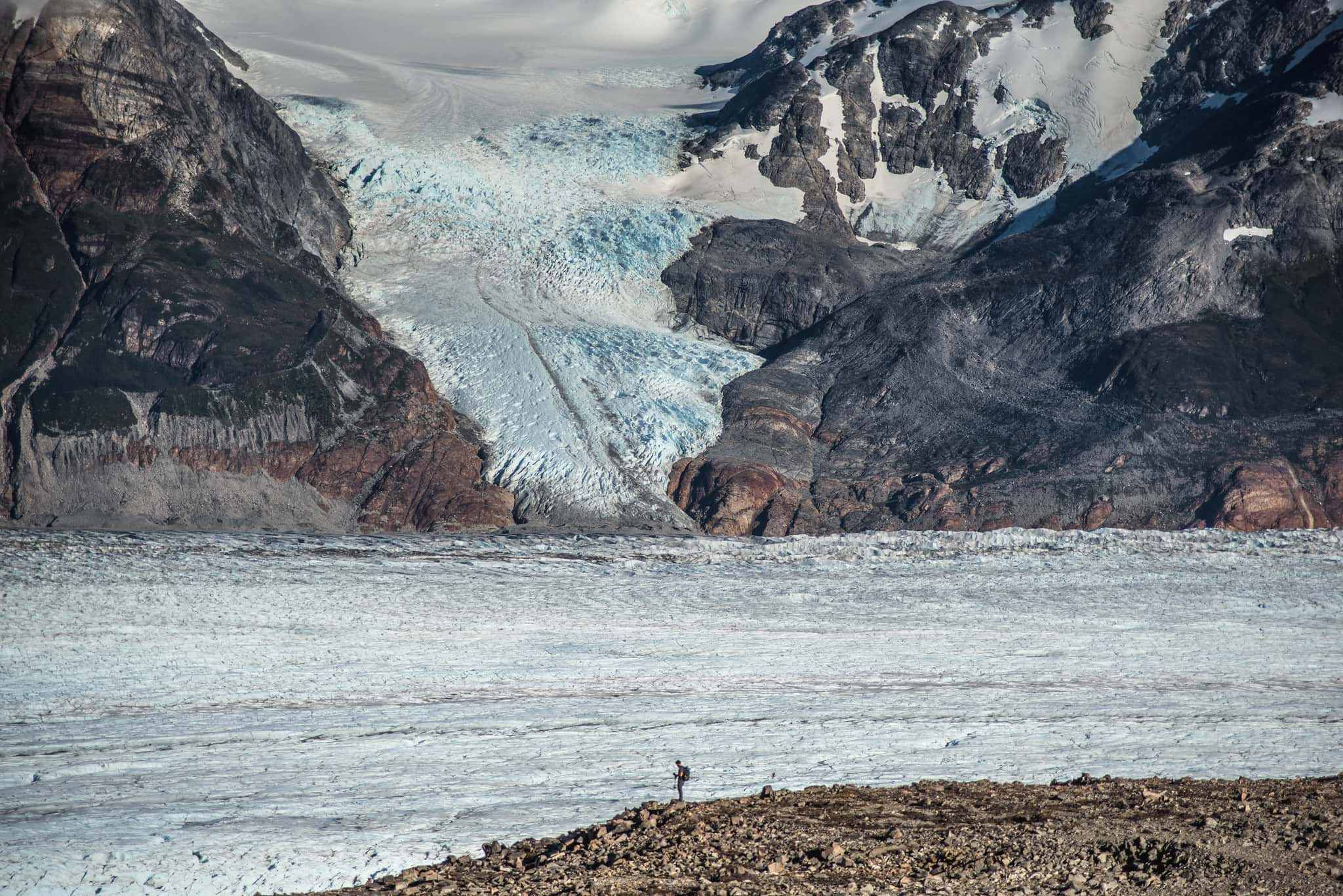
The main difference between both treks is the duration. The Paine Circuit is a 9-Day program (a 7-day hike) while the W Trek can be completed within 5 days. Also, the O Trek is more challenging than the W Trek.
Total distance is 140km/86mi for the O Trek VS 76km/47mi for the 7-Day W Trek.
The O Trek includes two days with up to 10 hours of demanding hiking whereas the most demanding hikes of the W Trek take no more than 8 hours. And while you will have no option but to stay in campsites on the O Trek, the W Trek offers the possibility to stay in a warm bed every night.
Conclusion: The O Trek is a good choice for the most experienced, adventurous hikers. The W Trek is the perfect alternative if you are not a pro hiker, with less time to spend in the park.
You can book your W Trek in Patagonia with Cascada through our homepage, while opting for the 5-Day or the 7-Day program.
You can also contact us so we can organize the W Trek you’re looking for!
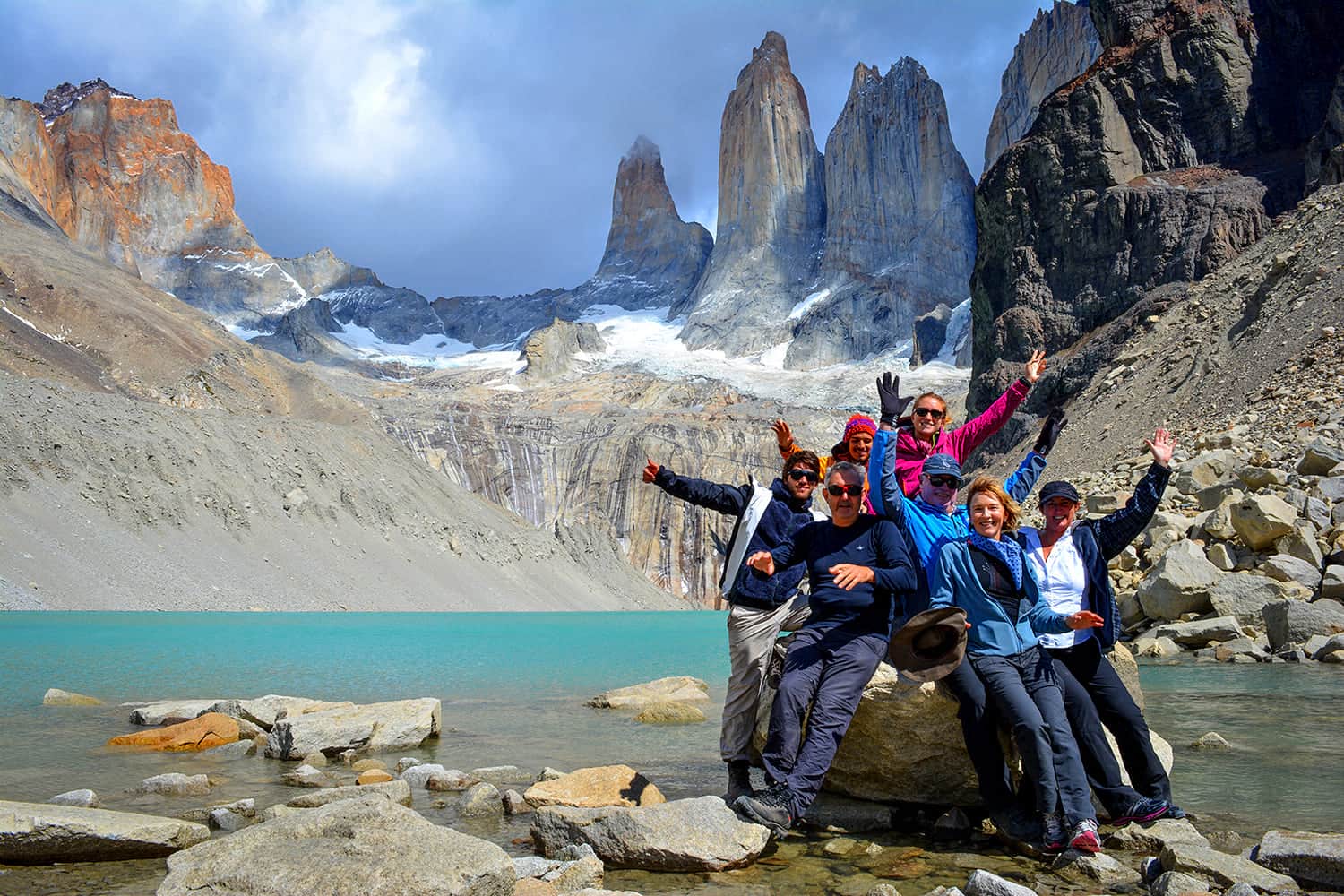
Subscribe to our Newsletter
Related posts.
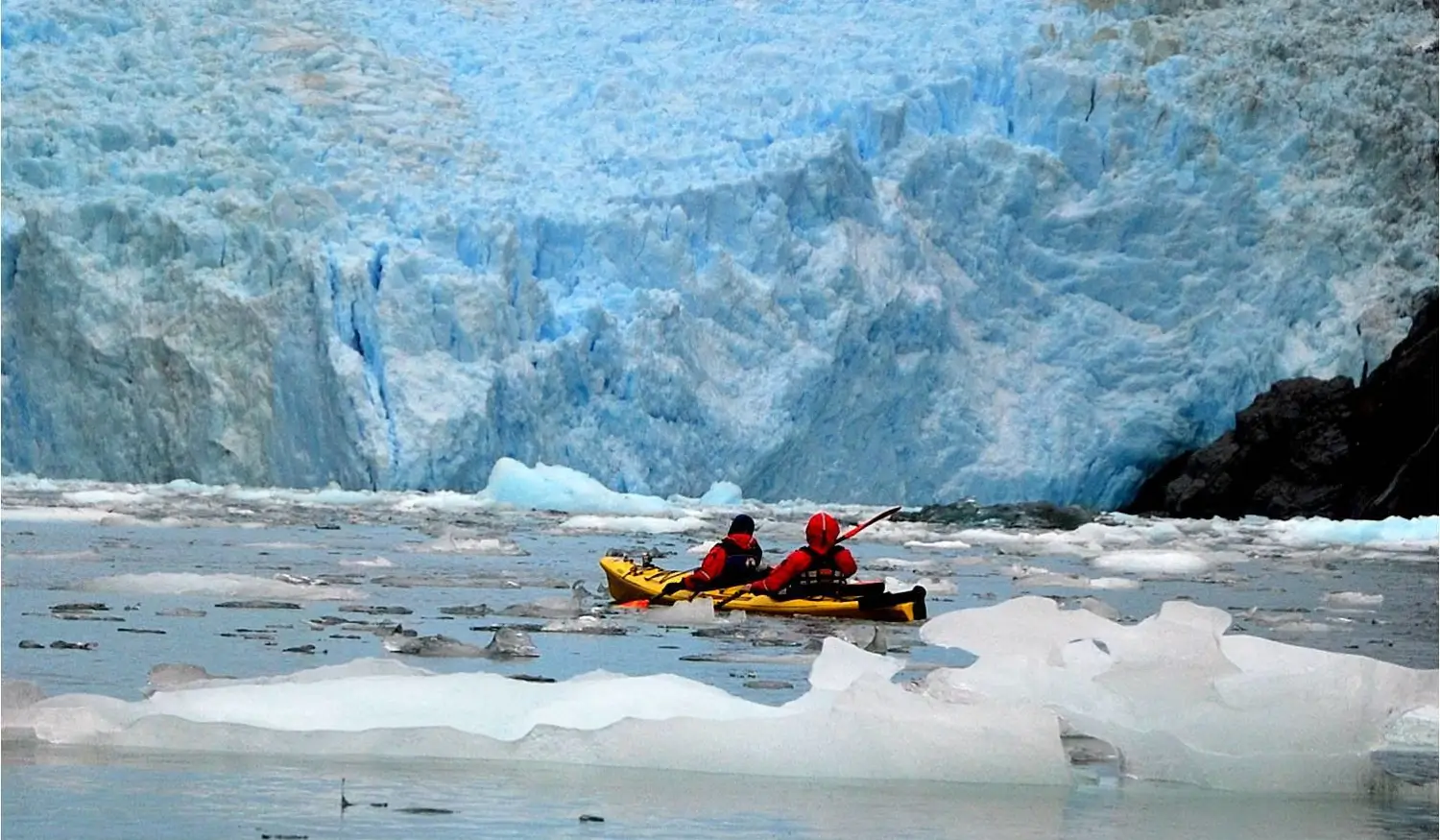
Patagonia's glaciers: worth a visit
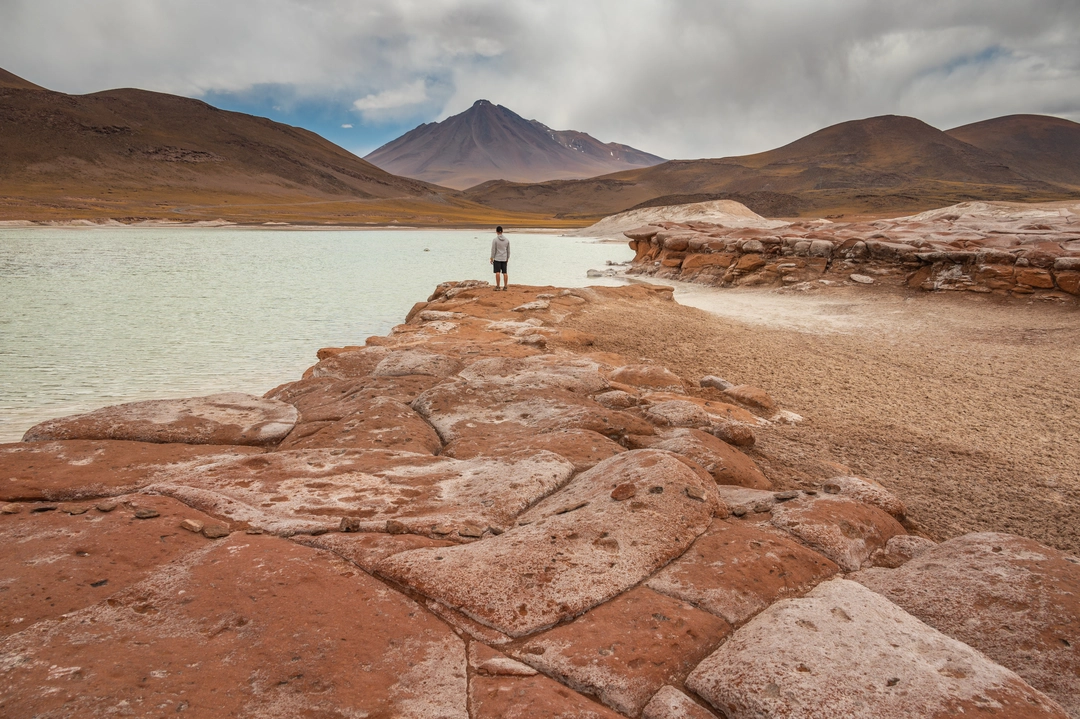
The Best Destinations in Chile for Adventure Travelers
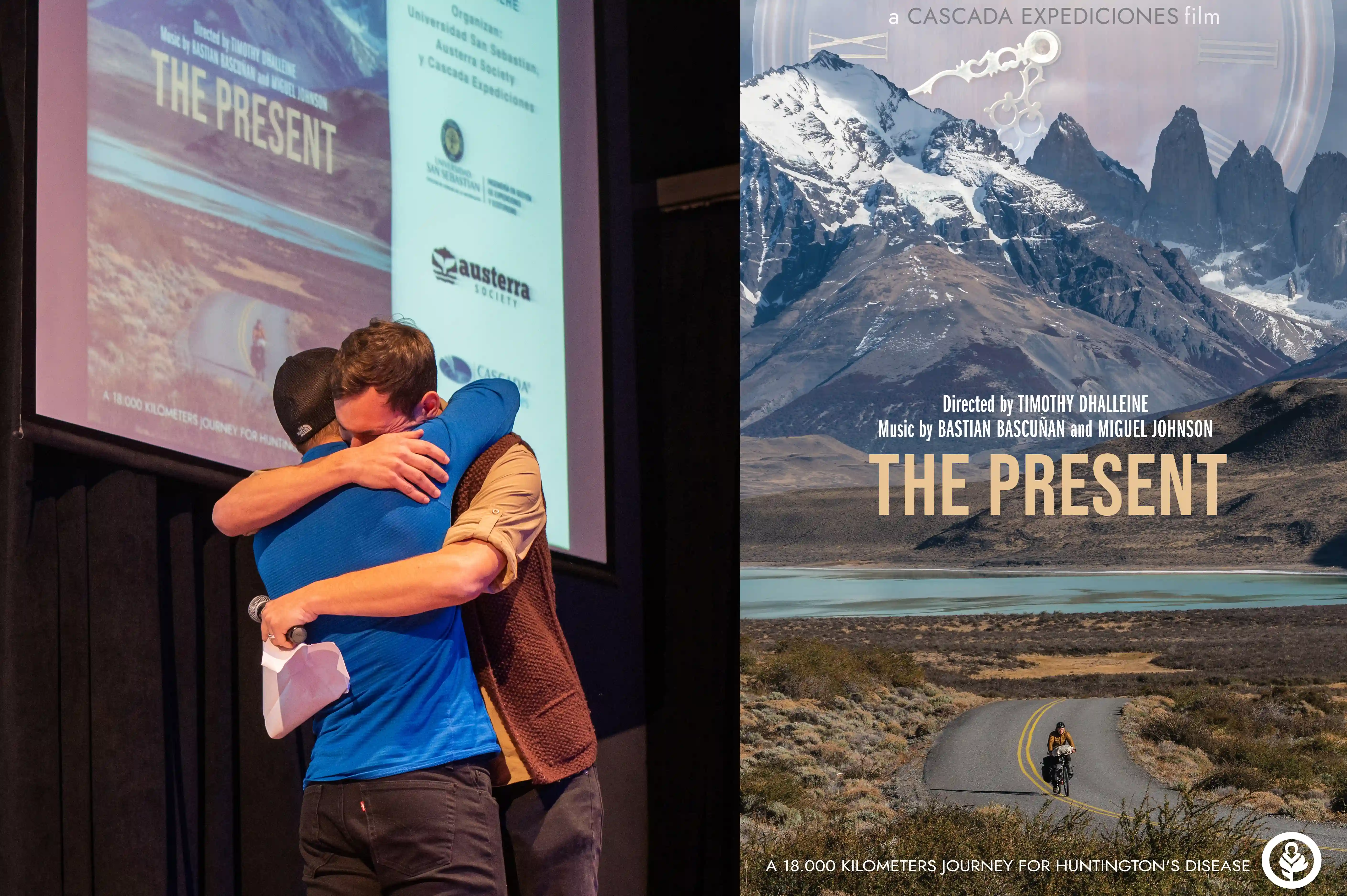
Incredible Sneak Preview of our Documentary "The Present"!

The Chilean Way
Want to learn more about the beautiful country of Chile? Download our insider’s guide to learn all the best travel tips and tricks.

- TERMS & CONDITIONS
- PRIVACY POLICY
Destination
- Multi Destination
- Salta Argentina
Experiences
- Multi-activity
- Exceptional Journeys
SOCIAL NETWORKS

Updated October 4th, 2022
Dear Traveler,
We are very happy to announce that there are currently no travel restrictions in Chile. Together with the above mentioned, it is mandatory to comply with the following requirements:
- You only have to present the vaccination certificate issued in your country when boarding to Chile. Those who do not have their vaccinations must present a negative result in a PCR test dated less than 48 hours from departure to enter Chile. Those who are under 18 years of age do not have any requirements to enter Chile
- A negative PCR upon arrival is not compulsory any more but diagnostic tests will be carried out randomly at the entry point to Chile. Confirmed cases shall be isolated according to the general health regulations.
- Medical insurance covering any expenses caused by COVID-19 is not compulsory any more
- The use of a face mask is voluntary
In case you have any questions, we will be happy to help you!
The Team at Cascada Expediciones & EcoCamp Patagonia
- Torres del Paine National Park
- Things to Do
- Restaurants
- Vacation Rentals
- Travel Stories
- Rental Cars
- Add a Place
- Travel Forum
- Travelers' Choice
- Help Center
The W Trek in 3 days - Torres del Paine National Park
- South America
- Chile
- Magallanes Region
- Torres del Paine National Park
- Torres del Paine National Park - Things to Do
The W Trek in 3 days
At the end of 2012 I went on a 3 weeks trip to South America. Trying to pack as much stuff in such a short time I spent many hours planning my W trek and it seemed that three days (7am departure from Puerto Natales, midnight arrival back in PN on the 3rd day) was doable. One driver for this hectic schedule was that I did not want to carry a tent (weight, weather etc) so I pushed to reach the next refugio, each day. The weather turned out to be fantastic, only one hour of rain in three days. This was a major bet which turned out well. The total hiking distance is about 40 miles (but I did not have GPS, and it was surprisingly hard to get precise non-conflicting distance information from the web). The altitude change must have been between 6000 and 8000 feet total - even the W base is far from flat. Anyway, here is my experience: Day 1: 7am bus from Puerto Natales to Laguna Amarga. The trip takes about 3 hours, but the morning bus is picking up all tourists from their hostels, loosing another one hour. At Laguna Amarga (11am) we had a short speech from a ranger, we got our permits and got on a smaller bus which left us at Refugio Torres, around noon. From there we started hiking towards Mirador Torres, with beautiful views all around us. We had a couple of short stops, including a longer one at Refugio Chileno. Food is generally very expensive so we were wise to buy canned meat from Puerto Natales. I had lots of energy bars from home, too (I live in US). They passed the severe Chilean inspection, with the exception of a dried apricots pack, which I had to throw away. The Mirador is gorgeous, but if you read this you probably have seen a bunch of pictures already. I and my buddy got there around 3.30pm. Our target was to sleep at Refugio Cuernos, so after about 1 hour spent there we had to turn around. There is a shortcut towards Cuernos, so you don't have to go back to Refugio Torres (from where another trail following the base of the W also goes to Cuernos). This shortcut (it saves maybe 2 miles) was easy to see going down (it has a clear sign) but we missed it going up. It's at a couple of hundreds of feet higher than the base level. We got to Cuernos around 9.30pm. Curiously we saw absolutely nobody for hours, even after merging on the main trail. We had bunk beds reserved. Everything basic but clean. Food expensive and definitely not enough (at breakfast the lady attending the table gave us a 2nd portion (>10USD in price) for free - that was very nice of her). 2nd day: We hiked up to Mirador Frances and then back down and on to Refugio Paine Grande. Gorgeous views all around. At the terminal point you are surrounded by 250Deg views of mountains with a narrow corridor looking back all the way down to the lakes. We saw a few beautiful birds - worth taking a good camera with you. When going up on the left side there is a mountain side packed with glaciers which were melting, resulting in avalanches - each ten minutes we heard one (like a big thunder). We managed to take pictures of a few of them. Waterfalls are everywhere - I might have seen 100 of them on the W, of various sizes. We took drinking water from the streams, from places with fast flow, and we had absolutely no problem (no purification needed). The sun is brutal, and strong sunscreen and good sunglasses are recommended. At Mirador Frances we stayed again about one hour (too little for the beauty of the place) and then we turned around to reach Refugio Paine Grande before nightfall. The days in December in Patagonia are very long - good sunlight from 5.30am to 10.30pm and even beyond that. One word of caution about the base of the W: the total elevation change is zero, but I estimate that the real elevation changes you need to overcome are of the order of 1000 feet from one refugio to another - it's not flat, there are tons of ups and downs! The base of the W is very burned down from a fire - looks beautiful still - but in a sad way. Back to the itinerary: we arrived at Refugio Paine Grande a bit before sunset. This refugio is big and slightly cheaper than Cuernos (easier to get stuff there because of the lake). They have a bar upstairs (accepts credit cards). Food was sligthly cheaper and more fulfilling compared to Cuernos. Just as at Cuernos we socialized with other hikers at the bar - everybody is very friendly and with interesting stories to tell. 3rd day: we woke up late, around 8am, and by 9am we were on our way to Mirador Grey. We did not encounter any wind (which was supposed to be brutal, according to other accounts). As a matter of fact in my six days of Patagonia hiking I faced a brutal, ice-cold wind only for one hour at the base of Fitz Roy - but none of that on the W trek. The hike to Mirador Grey is quite strenuous, which major ups and downs - it's along a steep mountain slope, on the right side of the Grey Lake and the side is very deeply cut by valleys. At Mirador Grey (a high point across from the glacier) I saw a condor for the first time, flying at maybe 100 feet from us. My 10x light binoculars proved very useful on this and other occasions. Again we stayed maybe one hour at Mirador Grey (you can continue from there another hour to get right next to the glacier, but I did not do that). We got back to Paine Grande one hour before the boat, which led us across the lake to a drop-off point where buses and cars were parked. From there our bus took us directly to Puerto Natales, where we arrived around mid-night.
long time getting there. Guide Francisco of Kipaventour Tours was great. The iceberg was very cool. Dress warm. It's damp and windy and weather changes quickly.
The park itself is magnificent, but... We had a bizarre and unpleasant experience with Turismo Laguna Azul's guide named Esteban. We booked a tour to Torres del Paine, and were boarded a small van that was to take us there. My girlfriend is, unfortunately, quite motion-sick, and she tried to lay low so as to make the (long) ride there bearable. At halfway point Esteban, the guide, boarded the van. He insisted that my girlfriend looks at him as he is talking to us, not caring about her motion sickness -- he could have just talked away and we'd have listened to him. He refused to give an english tour, and for the remainder of the day gave less than one tenth of the information he provided in Spanish. When confronted with the fact that he never bothered to ask what was going on with his passenger, and he never bothered to find out that she was motion-sick before going on his diatribe about people having to look at him in the face when talking to him, he said that that was "not his problem", and refused to talk to us for the rest of the way, keeping the unnecessarily confrontational attitude until the end. That behavior is unprofessional, bullying and outright rude. Even if we were in the wrong -- which I maintain we were not -- he should have been prepared to ammortize passenger grumpiness had he been a good guide. Frankly, I went away thinking not that he's a bad guide, but that the guy is an idiot, who may have had one too many the previous evening. We are not demanding people, nor we are difficult to please; yet he managed to fail us as a host, as a guide, as a professional and as a representative of his company. We didn't take the matter up with Turismo Laguna Azul as we thought there would be no actual reprecussions to the guide. Instead, we're doing the next best thing and letting the world know about what to expect with Turismo Laguna Azul. There are lots of agencies that offer the Torres del Paine tours, so when picking them, I recommend you stay away from Turismo Laguna Azul.
There was so much wildlife and beauty at every turn. The guide we had provided by the Singular was so knowledgable and thoughtful - made the experience even better as he seemed to know every nook & cranny of the park.
One of the highlights of our trip. We spent 2 days doing the first two legs of the W staying in Paine Mountain Lodge in between. It means covering about 50km in two days but it very achievable even for novice hikers such as ourselves. The scenery is breathtaking and varied. Just go!
If you have been everywhere, but not here, DO! It's an indescribable, gorgeous, serene place like no other. What a treasure.

5-Day W Trek Guide | Torres del Paine National Park
- South America
W Trek is one of the most popular multi-day treks in the world and gets its name from the shape of the trail. The beauty and ruggedness of Patagonia attracts visitors from all over the world. Due to its popularity, booking accommodations has become harder and harder.
5-Day W Trek in Torres del Paine can be hiked in East to West or West to East direction. It is a well-marked trail where a guide is not necessary but using a tour company to book the accommodations and all the meals may be worth the investment.
Where is Torres del Paine National Park?
Torres del Paine is a national park in Chile, Patagonia. It is accessible by bus or car from either Puerto Natales, Chile or El Calafate, Argentina.

To get to Puerto Natales you can either fly directly from Santiago or fly to Punta Arenas and take a 3-hour bus ride to Puerto Natales. The main reason to fly to Punta Arenas is there are more flight options from Santiago, and if you have an extra day to spare you can take an excursion out of Punta Arenas to see the penguins. From Santiago, there is only one flight to Puerto Natales at 5:55 am.
To get to El Calafate take a flight from Buenos Aires. From El Calafate, it is approximately a 3-hour drive to Torres del Paine.
There is public and private transportation from Puerto Natales to Torres del Paine. However, from El Calafate, all the transportation to the park is private and must be scheduled beforehand.
When to do W Trek In Torres del Paine National Park?
Torres del Paine National Park is open year-long. However, the refugios, their services, ferries, and other park services are only available from September to April.
Using a Tour Company Vs Booking Yourself
If you are a person who likes to plan and book a trip like this a year in advance and are ok with carrying your tent, sleeping bag, and backup food it is probably better and cheaper if you book everything yourself for the W Trek. The refugios are operated by two different companies Las Torres Patagonia (Fantastico Sur) and Vertices Travel .
If you are more like us and don’t plan too far in advance and like to minimize the number of things to carry with you, then using a tour company to book everything for you is probably a better choice. We used Chile Tour Patagonia . It worked well for us without any issues but some other people in the group had a few minor hiccups.
The Classic W Trek option with Chile Tour Patagonia offers accommodations the night before the trek and the night after with dinner on both nights. It follows the East to West trail, and it includes refugio accommodations every night, hot breakfast and dinner and boxed lunch for every day, and ferry and bus tickets.
With the tour, guides hike with you on the first day to the towers and after that, you hike at your own pace on your schedule. We had a large group with a large age span and it was fun to hang out together in the evenings and share our experiences of the day.

East to West vs. West to East
W Trek can be done either East to West or West to East. It really is a personal choice of how you’d like to do it.
Going East to West, the hardest day is on the first day, the hike to the towers. It is also the most iconic view of the hike.
Going West to East you start at Glacier Grey and the last day is the hardest day of the hike. I also felt, like going East to West you are hiking with the best views in front of you whereas the other way around those views would be behind you.

How hard is W Trek in Torres del Paine
I would consider W Trek as a moderate hike. It has some difficult parts but also very easy parts. The weather conditions play a big part here and can impact difficulty significantly, mainly high winds. But if you are in good condition and frequently hike W Trek would not be that difficult for you.
We have done a few different multi-day hikes around the world, TMB , Slakantay Trek , and Colca Canyon Trek , and all three of these were more difficult due to elevation, distance or altitude.
W Trek Day 1 – Hike to the Towers
The day starts with the shuttle transfer to the park. The drive is about 1.5 hours and you will most likely see Guanacos, Red Foxes, Ostriches, and other wildlife during this drive (same if using a public bus). You need to purchase a park entrance ticket online before the start of the trek and present the QR code at the park entrance. The park entrance is also where you can use bathroom facilities before starting the hike.
The trailhead is by the Las Torres Hotel, another location where they may allow you to use the restroom. We were able to leave our stuff in the shuttle and only carry a day pack on today’s hike.
After a short walk, the trail starts going uphill, with minimal tree coverage and on a sunny day it can get really hot. It takes about 3 miles to arrive at Chileno Refugio. At Chileno, you can take a break, grab a snack, refill the water, and use the restroom. From Chileno, the trail goes through the forest for approximately 2 miles. Once out of the forest, the hardest part starts.

It is a steep climb, with switchbacks and scrambling over the rocks all the way to the towers. The last part is over 1200 ft, elevation gain in less than a mile. Once on top, on a clear day, you will be rewarded with one of the most iconic views in the world. Expect crowds on this hike.

The way down is exactly the same.
OPTIONS: There are three accommodation options for this part of the hike. Las Torres Hotel and Refugio Torre Central are close to the trailhead, and you can leave your 5-day pack there and just carry your day bag with you to the base of the Tower. Or if staying at Refugio Chileno, you can leave your pack thereafter a 3-mile hike up.
TIP: From Chileno, the trail to the towers usually closes at 5 pm, but because we did this hike on Christmas Eve it closed at 2 pm and a lot of people got left out. I’d recommend checking in at the welcome center before starting the hike.
W Trek Day 1 Stats
Distance: 11.33 mi Elevation: 4015 ft Facilities: Park Entrance, Chileno Refugio and WC on the Trail Accommodations: Refugio Torre Central, Refugio Chileno, Hotel Las Torres

W Trek Day 2 – Cuernos Sector
Today is the first day you will carry your full pack with you, and it makes a difference.
From Refugio Torre Central the trail to the Torres and Cuernos sector starts together and after about a mile in it parts ways. Once on the Cuernos sector the crowds disappear and it becomes a much quieter walk.
It is an easy hike to the first pass where you get a first glimpse of Nordenskjöld Lake and snowcapped mountains in the distance. From this point on the views never stop.

Maybe because we had a cloudless day of hiking, this was the most scenic hike on the W Trek. The hike is mainly walking by the lake with breathtaking beauty all around you and views of Cuernos and Glacier Frances. Yes, the view of the Towers steals the best view but during the hike, there is not that much to see going up, on Day 2 the views never stop.

Be aware that Glacier Frances breaks off frequently which sounds like thunder.
We stayed at the Domos Frances.
W Trek Day 2 Stats
Distance: 10.76 mi Elevation: 1932 ft Facilities: Refugio Torre Central, Refugio Cuernos & Refugio Frances Accommodations: Refugio Cuernos, Domos Frances and Refugio Italiano and campsites
W Trek Day 3 – Paine Grande Sector
Day 3 hike can be as hard or as easy as you would like it to be. The main objective is to make your way to Paine Grande Refugio. You have the option to hike via viewpoint Frances and then Viewpoint Britanico while leaving your stuff at Refugio Italiano.
For us, the weather turned overnight. The clouds rolled in, it started raining and the wind picked up. We decided that we will go up to Frances viewpoint and then decide if we want to continue to Britanico. Left our stuff at Italiano and hiked up but the weather wasn’t cooperating, so we turned around a little after we passed Frances viewpoint.
By the time we returned to Italiano, the park ranger closed the trail to go to Frances or Britanico due to unfavorable conditions. The trail is steep and rocky and it got slick with the rain.
From Italiano it is 4.6 miles to Paine Grande. Luckily rain eventually stopped but the wind kept picking up. We spotted a few little tornados in the Skottsberg Lake while hiking next to it.
The only accommodations here are at Paine Grande, either the refugio or the campsite. This is where the Lago Pehoe ferry runs to and from to take you back to the bus stop.
PRO TIP: The Lago Pehoe ferry is a lot more reliable and operates in unfavorable conditions where the ferry on Lago Grey gets canceled more frequently. Which turned out to be the exact case when we were returning.
We stayed the night at the Paine Grande Refugio.
W Trek Day 3 Stats
Distance: 8.95 mi Elevation: 2615 ft Facilities: Frances, Italiano & Paine Grande Accommodations: Paine Grande Refugio and Campsites
Day 4 – Grey Sector
This is the windiest part of the hike and winds in Patagonia are no joke. The hike starts from Paine Grande valley up to the pass and then back down to Refugio Gray.
Coming across the pass we experienced extreme winds, rain, and hail. The weather conditions are what makes this hike hard. The hike from Paine Grande to Gray Refugio is approximately 7 miles with little over 2000 ft elevation gain. On paper, an easy hike. But add over 50 km/h winds and hail and it becomes a different ball game.
Once at Refugio Gray, you can call it a day or continue hiking to 2 nd hanging bridge (another 4 miles), go kayaking by the glacier, or ice trekking on the glacier. We took a short break and then hiked up to a 2 nd hanging bridge to get better views of the glacier.

Big Foot is an operator that organizes kayaking and ice trekking if interested.
If you are too tired for any of these activities or if the weather is not cooperating, you can do these activities the following day as the hike on Day 5 is hiking back to Paine Grande and taking the Lago Pehoe ferry.
TIP: Instead of walking back to Paine Grande, you can also take Grey Ferry and catch the bus to Puerto Natales. However, due to high winds, this ferry gets canceled very frequently but it is an option on a good day.
PRO TIP: If you are coming back to Paine Grande and taking the ferry Pehoe back, you have the option to leave your big pack here and only carry a day pack with you to Grey. It costs 3000 CLP.
W Trek Day 4 Stats
Distance: 11.4 mi (6.85 miles just to Grey) Elevation: 3400 ft (2080 ft just to Grey) Facilities: Paine Grande and Grey Refugio Accommodations: Refugio Grey and Campsite
W Trek Day 5 – Paine Grande Sector and Ferry
Today’s hike is the same as yesterday’s, it is walking back to Paine Grande. We didn’t think the winds could be worse than the day before, well we were wrong. I strongly recommend using hiking poles here, as they were the only reason helping me stay upright at times.
We started at 6 am to make it back to Paine Grande in time to catch the 9:35 am ferry. There are also 11:05, 17:00 and 18:35 ferries in December. Please look at the end of the post for the ferry schedule by month.
PRO TIP: Lake Pehoe ferry has a limited number of people it can take on (we were told 100) so if you are time-limited, make sure you queue up early enough as the 17:00 and 18:35 ferries get full quickly. The 9:35 am ferry was half empty.
Once on the other side of the lake, you can hop on the bus to Puerto Natales right away (make sure you buy a bus ticket ahead of time BusSur.com ) or you can take a short hike to the Mirador Salto Grande (viewpoint of the waterfalls) and viewpoint of Cuernos.

W Trek Day 5 Stats
Distance: 6.85 mi Elevation: 2080 ft Facilities: Grey and Paine Grande Refugio
Suggestions For the Best Experience On the W Trek
Patagonia is truly unpredictable, and you can experience four seasons in one day so come prepared.
It is important to invest in good quality waterproof clothing. A lot of people we hiked with thought they had waterproof boots or clothing and ended up soaking wet. At the refugios, there are only a few spots with a fire furnace where you can dry your stuff off.
Hiking poles are very helpful, especially during high winds to maintain your balance. If it wasn’t for them, I would have been knocked down a few times.
Sunscreen and bug spray are a must. On sunny days, the sun is intense in Patagonia and bugs are relentless. I left the bug spray behind, thinking no way the bugs are going to be a problem. Why carry the weight? I was wrong.
Torres del Paine National Park does not have any trashcans. Everything you pack in, you will need to pack out. Practice the same standards you do in the US National Parks with Leave No Trace.
All the refugios have water filling stations to refill water as needed.
It is a good practice to carry toilet paper with you, as not all toilets have toilet paper. And in Torres del Paine, and Patagonia in general, do not flush the toilet paper or any other paper products.
Food is not the greatest at the refugios. It’s usually just rice or mashed potatoes with overcooked protein for dinner. The Central Refugio had the best dinner, it was buffet style with a lot more options than other refugios. They do accommodate dietary restrictions and at times it looked like gluten-free options were better than regular food.
Wi-Fi at the refugios is available for purchase. It was 15,200 CLP for 10 hrs. You can share it with others but only one person can use it at a time.
Refugios book up quickly so plan early or have a little more flexibility with your dates and accommodations .
Refugios are not well stocked with products, it depends on their location and how accessible means of transportation are. Paine Grande and Grey Refugio Mini Markets were the best stocked with different food and drink options. Some refugios also offer to rent the towels or store your stuff for a price, usually around 3000 CLP.
There is a lot of flexibility when trekking the W Trek. You can shorten it down to 4 days if Grey Ferry is running, or you can stay at different parts of the park and do day hikes and cover most of the W that way. That’s the beauty of it, you can make it work for you.
This post contains affiliate links. If you use these links to buy something we may earn a small commission. Thanks !
The overall experience of hiking the W Trek is unforgettable and a dream come true for most hikers. We had all different kinds of weather. From a very overcast first day, that cleared up just as we hiked up to the towers, a really hot and cloudless second day, an overcast, cold, and rainy third day, and rainy and windy fourth and fifth day.
A lot of people were leaving the trail early due to the weather, but we wanted to finish it no matter what and still got to see a lot more of Torres del Paine’s beauty than expected.
Lago Pehoe Ferry Schedule
The ferry is operated by HipSur and the table with the schedule is below.
Other helpful posts…
Things to Do In and Around El Calafate W Trek Accommodations and The Cost 13-Day Itinerary in Chile 16-Days Itinerary in Argentina Things to Do in Bariloche
South America | Travel
0 comment(s), contact us:.
Email Address
RECENT Posts

Amazing Two Days of Hiking in Sedona
Last updated Apr 8, 2024 | Explore , North America , Travel
This itinerary is packed with two full days of hiking, close to 30 miles. In these two days of hiking in Sedona, we hit all the most popular trails.

How to Spend Two Days in Aoraki/Mt. Cook National Park
Last updated Apr 1, 2024 | Explore , Oceania , Travel
Spending two days in Aoraki/Mt. Cook National Park is best utilized taking a scenic drive into the park, embarking on one of the many trails or taking a flight.

Kayaking in Milford Sound
Last updated Feb 27, 2024 | Explore , Oceania , Travel
Kayaking in Milford Sound is one of the must-do things in New Zealand. It is a great way to explore the area and do something adventurous and fun.

All You Need to Know About Milford Sound | New Zealand
This post will walk you through all you need to know about Milford Sound whether you are a first-time or returning visitor. What to expect and how to prepare.

New Zealand Itinerary | Epic 15-Days in North and South Island
Last updated Feb 27, 2024 | Oceania , Travel
This New Zealand Itinerary is designed to spend 5 days in the North Island and 10 days in the South Island. Renting a car is crucial for this itinerary.

Tongariro Alpine Crossing | The Best Day Hike in New Zealand
Last updated Feb 24, 2024 | Oceania , Travel
Tongariro Alpine Crossing is a point-to-point 19.4 km (12 miles) trail in New Zealand. It is considered the best day hike in the country.
Submit a Comment Cancel reply
Your email address will not be published. Required fields are marked *
Save my name, email, and website in this browser for the next time I comment.
Submit Comment

IMAGES
VIDEO
COMMENTS
W Trek, 3 days Customer Reviews 3-Day W Trek. Prices, Departures and Inclusions Prices for the 2023/24 season are: 4-8 people: USD $1,695 per person 2 people: USD $2,295 per person-Book now to guarantee your place for the 2024-25 season. Prices for the 2024/25 season are from:
Day 1 - Torres del Paine W Trek start (Refugio Paine Grande) via bus, catamaran - Glacier Grey Views, Campamento Italiano. 5 to 6 hours* and 18.5 km, 11.8 miles (mostly with a day pack on easy trails) - to first Mirador. Today you'll do a round trip day hike from Refugio Paine Grande (RPG) as far as you can for a good view of Glacier Grey.
Booking Camping and Accommodation on the W Trail. Bus tickets to and from Torres del Paine. Packing for the W Trek. Our Self-guided itinerary for hiking the W Trail. Day 1 - Puerto Natales to Chileno via Las Torres. Day 2 - Chileno to Francés. Day 3 - Francés to Paine Grande via Francés Valley. Day 4 - Paine Grande to Grey.
The W trek is the most famous trek in Patagonia. If you are interested in doing the whole trek and seeing the most amazing views but you don't have much time, this is how to do it in 3 days. However, I must warn you - it is exhausting, difficult to plan and quite risky! In this post, I will describe
The days it takes to hike the W Trek in Patagonia will depend on your fitness level and if you want to take your time. We did this trek in 3 nights and 4 days. This is the shortest time I'd ever suggest, even if you're a fantastic hiker. My suggestion would be to do 4 nights and 5 days. This will give you ample time to relax at the ...
The green path shows the circuit trek - the red one is the 'W' part you are supposed to trek. 2) The W in 5 days, 4 nights (100 km, 139.800 CLP) This is the perfect schedule for a relaxed time in the park starting with a nice boat trip and the Glacier Grey, finishing with the sunrise at the Torres in the morning of the last day.
Day 3. Day three is normally dedicated to hiking French Valley which is the favorite part of hiking the W trek for many. Following streams and rivers much of the way north, the valley offers spectacular views of glaciers towards the lookout at Britanicos Camp, although it's uphill all the way.
The third day on the W Trek is the highlight for many, beginning with a hike into the remote Francés Valley, where enormous, snow-capped mountain peaks dominate the landscape on either side of the trail. ... Alternatives to the W Trek: 3 of the Best Hikes in Torres del Paine A suspension bridge looking on to Grey Glacier in Torres del Paine ...
W Trek, 3 days . 3 Days $ 1,695; Discover More Need help finding the right adventure? 1-855-369-7866 Make an enquiry [email protected] . Expert Impartial Advice And A Bespoke Service. Deep Roots in Patagonia. For The Ends Of The Earth ...
What is the W-trek? The Torres del Paine "W" Trek (3-7 days) is the half loop around the Cordillera del Paine. This, in contrast to the Haute Route, the W-Trek one set route with very few variations aside from which end you decide to start at. The W-Trek in its essence is: Location: Torres del Paine National Park, Chile. Distance: 49.7 miles ...
Food & Water for the W Trek. 5-Day Itinerary for Hiking the W Trek without a Guide. Day 1 (Puerto Natales -> Refugio Grey) Day 2 (Grey -> Paine Grande) Optional Add-On: Grey Glacier Ice Hike. Day 3 (Paine Grande -> Francés/Los Cuernos) Day 4 (Francés/Los Cuernos -> El Chileno/Central) Day 5 (El Chileno/Central -> Torres del Paine ...
W trek in Torres del Paine - a 4-day itinerary. If for some reason your time in Torres del Paine is limited you can walk the W trek in 4 days. Day 1. Paine Grande campsite - Grey campsite - Paine Grande campsite, 22 km/13,6 mi. Bus Puerto Natales Torres del Paine (Pudeto); ferry Pudeto - Paine Grande, 3-4 hours.
Time Required and Distance: To do the W Trek as day hikes you need at least 3 days to visit each arm of the W and see all the most iconic sites- Torres del Paine (the towers), Cuernos del Paine (the horns), the French Glacier, and Grey Glacier. The total distance for the three day hikes, as recorded by my GPS, was 62.1 km/38.6 mi.
Day 1 - Paine Grande to Grey Glacier Return. Let the trekking adventures begin! Today is a 22.4km return hike that will take around 6-8 hours.If trekking the Torres del Paine W Trek in a west-to-east direction, which is what we recommend, you'll catch the ferry to Paine Grande (more details on that here).Once you arrive at Paine Grande, go straight to reception to check in, set up your ...
Epic Patagonia W Trek (Departs Santiago): Tour Duration: 10 days. Cost: $3,950 USD. Departs from: Santiago. This tour will begin from Santiago where you will stay the first night at the tour's partner B&B before flying out of the Santiago airport the next day (airfare is included) to Torres del Paine National Park.
The 3-Day Guided W Trek in 3 Days is the perfect solution to those with big adventure dreams and limited time. This trekking tour in Chilean Patagonia incorporates the top highlights of the famous W Trek including the Three Towers, the French Valley and mighty Grey Glacier.
Distance: 13 kilometers (8 miles) plus 8 kilometers (5 miles) for the hike from the Centro de Bienvenida to Laguna Amarga) Duration: 6 hours hiking (add an extra 1.5-2 hours for the hike to Laguna Amarga) 4:30am Wake up and take a small bag (including warm clothes and a snack) to see the torres at dawn.
Day 3: Refugio Los Cuernos - Paine Grande and Puerto Natales Hiking time is 7 to 8 hours. Distance 16km/10Miles, Elevation Gain (400m Approximately) After a hot breakfast, we will start our trek to the French Valley Overlook. We will hike along Nordenskjöld Lake for about 30 minutes before we reach Camping Italiano where we will be dropping ...
The third and last day of the W Trek in 3 Days you will have to choose between one of the two treks proposed below. Being a reduced version of the W route, it is not possible to reach both viewpoints due to lack of time. Leaving from the Francés Sector, OPTION 1 will be the French Valley Trek to the British Viewpoint.
Lago Grey catamaran round trip, including glaciar (from 15:30 to 18:00) Sleep at Paine Grande. Day 2: Walk to Italiano, then to Britanico, then to Cuernos. Sleep at Cuernos. Day 3: Walk from Cuernos to Campsite Torres, then to Hosteria Torres. From Hosteria Torres take the 19:45 bus that goes to Puerto Natales.
The full W Trek typically includes 5 days hiking with a total distance of 76km/47mi. Our 7-Day W Trek includes 2 days of traveling to/from EcoCamp and 5 days hiking. This is the complete W Trek that also features one day of easy hiking and leisurely car journey towards Laguna Azul, on the eastern side of the park.
The W Trek in 3 days. Review of Torres del Paine National Park. Reviewed January 19, 2013 . At the end of 2012 I went on a 3 weeks trip to South America. Trying to pack as much stuff in such a short time I spent many hours planning my W trek and it seemed that three days (7am departure from Puerto Natales, midnight arrival back in PN on the 3rd ...
W Trek Day 3 Stats. Distance: 8.95 mi Elevation: 2615 ft Facilities: Frances, Italiano & Paine Grande Accommodations: Paine Grande Refugio and Campsites. Day 4 - Grey Sector. This is the windiest part of the hike and winds in Patagonia are no joke. The hike starts from Paine Grande valley up to the pass and then back down to Refugio Gray.
Here's everything we know about Season 3 of 'Star Trek: Strange New Worlds,' including cast, plot, renewal news and more! We'll add the release date, trailer, guest stars as soon as they're announced.